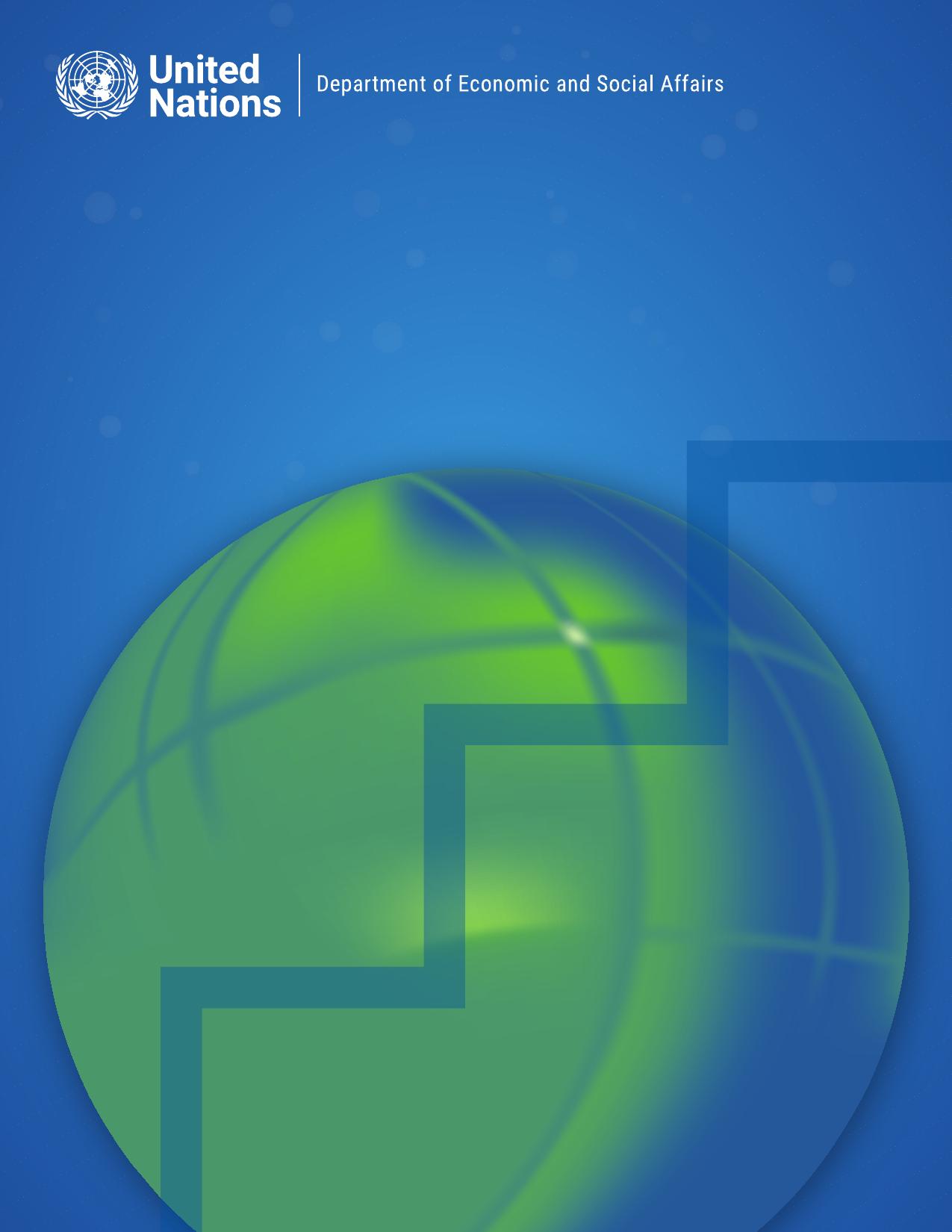WorldEconomicSituationandProspects2024WorldEconomicSituationandProspectsTheWorldEconomicSituationandProspects2024isareportproducedbytheUnitedNationsDepartmentofEconomicandSocialAffairs(UNDESA),inpartnershipwiththeUnitedNationsConferenceonTradeandDevelopment(UNCTAD)andthefiveUnitedNationsregionalcommissions:theEconomicCommissionforAfrica(ECA),EconomicCommissionforEurope(UNECE),EconomicCommissionforLatinAmericaandtheCaribbean(ECLAC),EconomicandSocialCommissionforAsiaandthePacific(ESCAP)andEconomicandSocialCommissionforWesternAsia(ESCWA).TheUnitedNationsOfficeoftheHighRepresentativefortheLeastDevelopedCountries,LandlockedDevelopingCountriesandSmallIslandDevelopingStates(UN-OHRLLS)andtheUnitedNationsWorldTourismOrganization(UNWTO)alsocontributedtothereport.Forfurtherinformation,visitECLAChttps://www.un.org/en/desaorcontact:JoséManuelSalazar-Xirinachs,ExecutiveSecretaryEconomicCommissionforLatinAmericaandtheCaribbeanUNDESAAv.DagHammarskjöld,3477LiJunhua,Under-Secretary-GeneralVitacuraDepartmentofEconomicandSocialAffairsSantiago,ChileRoomS-2922ChileUnitedNationsNewYork,NY10017+56-2-22102000USAsecepal@cepal.org+1-212-9635958ESCAPundesa@un.orgArmidaSalsiahAlisjahbana,ExecutiveSecretaryEconomicandSocialCommissionforAsiaandthePacificUNCTADUnitedNationsBuildingRebecaGrynspan,Secretary-GeneralRajadamnernNokAvenueUnitedNationsConferenceonTradeandDevelopmentBangkok10200RoomE-9042ThailandPalaisdeNations,8–141211Geneva10+66-2-2881234Switzerlandescap-scas@un.org+41-22-9175806ESCWAsgo@unctad.orgRolaDashti,ExecutiveSecretaryEconomicandSocialCommissionforWesternAsiaECAP.O.Box11-8575ClaverGatete,ExecutiveSecretaryRiadel-SolhSquare,BeirutUnitedNationsEconomicCommissionforAfricaLebanonMenelikIIAvenueP.O.Box3001+961-1-981301AddisAbabahttps://www.unescwa.org/contactEthiopiaISBN:978-92-1-002979-7+251-11-5511231PDFISBN:978-92-1-358644-0ecainfo@uneca.orgPrintISSN:1995-2074OnlineISSN:2411-8370UNECETatianaMolcean,ExecutiveSecretaryUnitedNationspublicationUnitedNationsEconomicCommissionforEuropeSalesNo.E.24.II.C.1PalaisdesNationsCH-1211Geneva10Copyright@UnitedNations,2024SwitzerlandAllrightsreserved+41-22-9174444unece_info@un.orgForewordThe2024editionoftheUnitedNations’WemustbuildontheprogressmadeintheWorldEconomicSituationandProspectsreportpastyeartowardsanSDGStimulusofatleastcomesamidstarkglobaleconomicinequalities$500billionperyearinaffordablelong-termandhighgeopoliticaltensions.financingforinvestmentsinsustainabledevelopmentandclimateaction.WhilericheconomieshavelargelybouncedbackfromtheCOVID-19pandemic,developingThatincludesincreasingthecapitalbaseeconomieshavelostground.ManyareofMultilateralDevelopmentBanksanddrowningindebt,withmorethanathirdatchangingtheirbusinessmodelstoleverageriskofcrisis.Investmentinclimateactionfarmoreprivatefinanceatreasonablecosttoandsustainabledevelopmentisfallingdevelopingcountries.woefullyshort.Hungerandpovertyareontherise.AndgrowingdivisionsbetweenItisalsotimeforaneffectivedebtworkoutcountriesandeconomiesarepreventinganmechanismtofreeupfiscalspaceforinvestmenteffectiveresponse.inhealth,education,socialprotection,decentjobs,digitalinfrastructureandrenewableenergy.Asthisreportmakesclear,2024isprojectedtobeanothertoughyear.SluggishglobalgrowthisTheSummitoftheFutureinSeptember2024projectedtoslowfurther.Investmentwillremainwillbeapivotalopportunitytoadvancereformsweak.Thedebtcrisiswillcontinuetospiral,oftoday’soutdated,dysfunctionalandunjustasdebtserviceobligationsreachnewheights.internationalfinancialsystem,providingaAnddevastatingconflictsandescalatingextremestrongerfoundationfortheglobaleconomy.weatherarebringinguncertaintyandrisktotheglobaleconomy.Theresult:developmentInequalityistearingourworldapart.In2024,delayedanddenied.wemustseizetheopportunitytocreateamoreinclusive,resilientglobaleconomythatworksfor2024mustbetheyearwhenwebreakouteveryone,everywhere.ofthisquagmire.AntónioGuterresByunlockingbig,boldinvestmentswecandriveUnitedNationssustainabledevelopmentandclimateaction,andputtheglobaleconomyonastrongergrowthSecretary-Generalpathforall.IIIExplanatorynotesSymbolsusedinthetablesGEPUGlobalEconomicPolicyUncertainty(Index)GNIgrossnationalincome...ThreedotsindicatethatdataarenotavailableorarenotGWPgrossworldproductseparatelyreported.G20GroupofTwentyHIPCHeavilyIndebtedPoorCountries(Initiative)–Adashindicatesthattheamountisnilornegligible.IDBInter-AmericanDevelopmentBank-Ahyphenindicatesthattheitemisnotapplicable.IEAInternationalEnergyAgency−Aminussignindicatesdeficitordecrease,exceptasindicated.IFCInternationalFinanceCorporation.Afullstopisusedtoindicatedecimals.ILOInternationalLabourOrganization/Aslashbetweenyearsindicatesacropyearorfinancialyear,IMFInternationalMonetaryFundIPCCIntergovernmentalPanelonClimateChangeforexample,2023/24.IRENAInternationalRenewableEnergyAgency–Useofahyphenbetweenyears,forexample,2023–2024,signifiesLDCsleastdevelopedcountriesLHSleft-handscalethefullperiodinvolved,includingthebeginningandendyears.LLDCslandlockeddevelopingcountriesMDBmultilateraldevelopmentbankReferencesandtermsMDRIMultilateralDebtReliefInitiativeMVIMultidimensionalVulnerabilityIndex§Referenceto“dollars”($)indicatesUnitedStatesdollars,NEETnotinemployment,educationortrainingunlessotherwisestated.OCHAUnitedNationsOfficefortheCoordinationofHumanitarianAffairs§Referenceto“billions”indicatesonethousandmillion.ODAofficialdevelopmentassistance§Referenceto“tons”indicatesmetrictons,unlessotherwiseOECDOrganisationforEconomicCo-operationandDevelopmentstated.OPECOrganizationofPetroleumExportingCountries§Annualratesofgrowthorchange,unlessotherwisestated,PMIPurchasingManagers’IndexPPPpurchasingpowerparityrefertoannualcompoundrates.QEquantitativeeasing§DetailsandpercentagesintablesdonotnecessarilyaddtoQTquantitativetighteningR&Dresearchanddevelopmenttotals,becauseofrounding.RHSright-handscale§Forcountryclassifications,seethestatisticalannex.SDGsSustainableDevelopmentGoals§DatapresentedinthispublicationincorporateinformationSDRsspecialdrawingrightsSIDSsmallislanddevelopingStatesavailableasat1December2023.UNDESAUnitedNationsDepartmentofEconomicandSocialAffairsUN-OHRLLSOfficeoftheHighRepresentativefortheLeastDevelopedAbbreviationsCountries,LandlockedDevelopingCountriesandSmallUNCTADIslandDevelopingStatesAfCFTAAfricanContinentalFreeTradeAreaUNDPUnitedNationsConferenceonTradeandDevelopmentAIartificialintelligenceUNECEUnitedNationsDevelopmentProgrammeAPPassetpurchaseprogrammeUNEPUnitedNationsEconomicCommissionforEuropeASEANAssociationofSoutheastAsianNationsUNESCOUnitedNationsEnvironmentProgrammeBISBankforInternationalSettlementsUnitedNationsEducational,ScientificandCulturalBoEBankofEnglandUNICEFOrganizationbpsbasispointsUNWTOUnitedNationsChildren’sFundCGEcomputablegeneralequilibrium(model)WEFUnitedNationsWorldTourismOrganizationCISCommonwealthofIndependentStatesWEFMWorldEconomicForumCOP28Twenty-eighthConferenceofthePartiestotheUnitedWFPWorldEconomicForecastingModelNationsFrameworkConventiononClimateChangeWTOWorldFoodProgrammeDACDevelopmentAssistanceCommitteeWorldTradeOrganizationEBRDEuropeanBankforReconstructionandDevelopmentECAEconomicCommissionforAfricaECBEuropeanCentralBankECLACEconomicCommissionforLatinAmericaandtheCaribbeanEMBIEmergingMarketsBondIndexESCAPEconomicandSocialCommissionforAsiaandthePacificESCWAEconomicandSocialCommissionforWesternAsiaFAOFoodandAgricultureOrganizationoftheUnitedNationsFDIforeigndirectinvestmentFedUnitedStatesFederalReserveGCCCooperationCouncilfortheArabStatesoftheGulfGDPgrossdomesticproductAcknowledgementsTheWorldEconomicSituationandProspects2024DanyiraPerez,IngoPitterle,KatarzynaRokosz,isareportproducedbytheUnitedNationsSebastianVergara,andYasuhisaYamamoto.DepartmentofEconomicandSocialAffairs(UNDESA),inpartnershipwiththeUnitedThefollowingcontributorstothereportareNationsConferenceonTradeandDevelopmentdulyacknowledged:(UNCTAD)andthefiveUnitedNationsregionalcommissions:theEconomicCommissionforHoiWaiJackieCheng,KennethIversen,Africa(ECA),EconomicCommissionforEuropePohLynnNg,andOliverSchwankfromUNDESA;(UNECE),EconomicCommissionforLatinTaroBoel,StefanCsordas,SofíaDomínguez,AmericaandtheCaribbean(ECLAC),EconomicClovisFreire,andthelateJanvierNkurunzizaandSocialCommissionforAsiaandthePacificfromUNCTAD;MedhatElhelepi,LeeEverts,(ESCAP)andEconomicandSocialCommissionChaoyiHu,HopestoneKayiskaChavula,forWesternAsia(ESCWA).TheUnitedNationsLeratoMaryLitsesane,andNadiaDeniseOfficeoftheHighRepresentativefortheLeastOuedraogofromECA;JoséPalacínLuciofromDevelopedCountries,LandlockedDevelopingUNECE;NixieAbarquez,ShuvojitBanerjee,CountriesandSmallIslandDevelopingStatesKiatkanidPongpanich,andVatcharin(UN-OHRLLS)andtheUnitedNationsWorldSirimaneethamfromESCAP;ArpyAtamian,TourismOrganization(UNWTO)alsocontributedJanGaska,MohamedElMoctarMohamedtothereport.TheforecastspresentedintheElHacene,AhmedMoummi,andSourayareportdrawontheWorldEconomicForecastingZeinfromESCWA;MinivaChibuyefromModelofUNDESAaswellasinputsfromtheUN-OHRLLS;andSandraCarvão,MichelJulian,UnitedNationsregionalcommissions.andJavierRuescasfromUNWTO.TheECLACcontributionisbasedontheEconomicSurveyUnderthegeneralguidanceofLiJunhua,ofLatinAmericaandtheCaribbean2023.Under-Secretary-GeneralforEconomicandSocialAffairs;NavidHanif,AssistantThereportbenefitedfromresearchbySecretary-GeneralforEconomicDevelopment;independentexpertsKrisGronewald,andShantanuMukherjee,DirectoroftheMingzeLi,YiliangLiandLudovicaTursini,EconomicAnalysisandPolicyDivision(EAPD)andfromdiscussionsatanexpertgroupmeetingofUNDESA,HamidRashid,ChiefoftheGlobalheldinNewYorkon20–21June2023.EconomicMonitoringBranchinEAPD,ledandcoordinatedthewritingofthereportwithacorePublicationsandadministrativesupportteamofauthorsfromtheBranch.TheycomprisedwereprovidedbyRachelBabruskinas,GrigorAgabekian,IanCox,BernaDogan,AndreaLeahC.Kennedy,SuzetteC.Limchoc,Dominovic,ZhenqianHuang,NellyRitaMuriuki,GerardFrancisReyes,andGabeSceltafromUNDESA.ThereportwaseditedbyTerriLore.VEndpovertyinallitsformsReduceinequalitywithineverywhereandamongcountriesEndhunger,achievefoodMakecitiesandhumansettlementssecurityandimprovedinclusive,safe,resilientandsustainablenutritionandpromotesustainableagricultureEnsuresustainableconsumptionandproductionpatternsEnsurehealthylivesandpromotewell-beingforallTakeurgentactiontocombatclimateatallageschangeanditsimpactsEnsureinclusiveandequitableConserveandsustainablyusetheoceans,qualityeducationandpromoteseasandmarineresourcesforsustainablelifelonglearningopportunitiesdevelopmentforallProtect,restoreandpromotesustainableuseAchievegenderequalityandofterrestrialecosystems,sustainablymanageempowerallwomenandgirlsforests,combatdesertification,andhaltandreverselanddegradationandhaltbiodiversitylossEnsureavailabilityandPromotepeacefulandinclusivesocietiesforsustainablemanagementofsustainabledevelopment,provideaccesstowaterandsanitationforalljusticeforallandbuildeffective,accountableandinclusiveinstitutionsatalllevelsEnsureaccesstoaffordable,Strengthenthemeansofimplementationreliable,sustainableandandrevitalizetheGlobalPartnershipmodernenergyforallforSustainableDevelopmentPromotesustained,inclusiveandsustainableeconomicgrowth,fullandproductiveemploymentanddecentworkforallBuildresilientinfrastructure,promoteinclusiveandsustainableindustrializationandfosterinnovationExecutiveSummaryAfragileresiliencemasksriskofgeopoliticalfragmentation,poseincreasingunderlyingrisksandriskstoglobaltradeandindustrialproduction.vulnerabilitiesAgainstthisbackdropoflingeringrisksandTheworldeconomyprovedmoreresilientthanuncertainties,globalGDPgrowthisprojectedexpectedin2023amidsignificantmonetarytoslowfromanestimated2.7percentin2023totighteningandlingeringpolicyuncertainties2.4percentin2024.Growthisforecasttoimproveworldwide,evenasmultipleshocksarisingfrommoderatelyto2.7percentin2025butwillremainconflictandclimatechangewroughthavoconbelowthepre-pandemictrendgrowthrateofthelivesandlivelihoodsofmillions,further3.0percent.Whiletheworldeconomyavoidedjeopardizingprogresstowardssustainabletheworst-casescenarioofarecessionin2023,development.Severallargedevelopedeconomiesaprotractedperiodoflowgrowthloomslarge.showedremarkableresilience,withrobustlabourGrowthprospectsformanydevelopingcountries,marketssupportingconsumerspendingdespiteespeciallyvulnerableandlow-incomecountries,sharpmonetarytightening.Atthesametime,haveremainedweak,makingafullrecoveryofinflationgraduallydeclinedinmostregionsonthepandemiclossesevermoreelusive.backoflowerenergyandfoodprices,allowingcentralbankstosloworpauseinterestratehikes.FurtherslowdowninthedevelopedeconomiesThisveneerofresilience,however,masksbothshort-termrisksandstructuralvulnerabilities.TheeconomyoftheUnitedStatesofAmerica–Underlyingpricepressuresarestillelevatedinthelargestintheworld–performedremarkablymanycountries.Afurtherescalationofconflictsinwellduringthepastyear,butgrowthisexpectedtheMiddleEastposestheriskofdisruptingenergytodeceleratefromanestimated2.5percentinmarketsandrenewinginflationarypressures2023to1.4percentin2024.Robustconsumerworldwide.Astheglobaleconomybracesforspendingonthebackofstronghouseholdbalancethelaggedeffectofsharpinterestrateincreases,sheetsandresilientlabourandhousingmarketsthemajordevelopedcountrycentralbankshavesupportedthebetter-than-expectedperformancesignalledtheirintentiontokeepinterestratesin2023.Despiteaggressivemonetarytighteninghigherforlonger.TheprospectsofaprolongedbytheFederalReserve,theunemploymentrateperiodofhigherborrowingcostsandtightercreditstoodatonly3.7percentinthethirdquarterofconditionspresentstrongheadwindsforaworld2023.Robusthousepricesboostedandsustainedeconomythatissaddledwithhighlevelsofdebtthenetworthofhomeowners,exertingastrongbutalsoinneedofincreasedinvestment,notonlywealtheffectandsupportinghighlevelsoftoresuscitategrowthbutalsotofightclimatehouseholdspending.Thismaychangequickly,changeandaccelerateprogresstowardstheespeciallyifhousingandassetpricesdropandSustainableDevelopmentGoals(SDGs).Moreover,effectivelyreducehouseholdnetworth.Amidtightfinancialconditions,coupledwithagrowingfallinghouseholdsavings,highinterestrates,andExecutivesummaryVIIagraduallysofteninglabourmarket,consumerheadwinds.Theeconomyturnedacornerduringspendingisexpectedtoweakenin2024andthesecondhalfof2023,withthegrowthrateinvestmentisprojectedtoremainsluggish.Whilereaching5.3percentfortheyear,anincreasefromthelikelihoodofahardlandinghasdeclined3.0percentin2022.Reducedpolicyandmortgageconsiderably,theUnitedStateseconomywillfaceratesandincreasedpublicsectorinvestmentsignificantdownsiderisksfromdeterioratingfinancedwithnewbondsboostedgrowth.labour,housingandfinancialmarkets.Whileconsumptionhasbeenamajordriverofgrowth,consumerconfidenceremainedtepidEuropefacesachallengingeconomicoutlookin2023.Acombinationofcontinuedweaknessamidstillelevatedinflationandhighinterestrates.inthepropertysectorandfalteringexternalIntheEuropeanUnion,GDPisprojectedtoexpanddemand–negativelyaffectingthegrowthofby1.2percentin2024,upfrom0.5percentin2023.fixedinvestment,industrialproductionandThemildrecoveryisexpectedtobedrivenbyaexports–willnudgegrowthdownmoderatelypick-upinconsumerspendingaspricepressuresto4.7percentin2024.ease,realwagesrise,andlabourmarketsremainrobust.ThecontinuedandlaggedeffectsoftightEconomicgrowthinAfricaisprojectedtoremainfinancialconditionsandthewithdrawaloffiscalweak,increasingfromanaverageof3.3percentinsupportmeasureswillpartlyoffsetthepositive2023to3.5percentin2024.Theglobaleconomiceffectsofthesekeydriversofgrowthin2024.slowdown,tightermonetaryandfiscalconditions,andhighdebtsustainabilityriskswillremainGrowthinJapanisprojectedtoslowfromadragontheregion’sgrowthprospects.The1.7percentin2023to1.2percentin2024despiteunfoldingclimatecrisisandextremeweatheraccommodativemonetaryandfiscalpolicyeventswillundermineagriculturaloutputstances.Risinginflationmaysignalanexitfromandtourism,whilegeopoliticalinstabilitywillthedeflationarytrendthatpersistedformorecontinuetoadverselyimpactseveralsubregionsthantwodecades.SlowinggrowthinChinaandinAfrica,especiallytheSahelandNorthAfrica.theUnitedStates–thecountry’smaintradingpartners–isexpectedtocurbnetexportsin2024.TheeconomiesofEastAsiaareprojectedtoexperienceamoderateslowdown,withgrowthIntheCommonwealthofIndependentStatesdecliningfrom4.9percentin2023to4.6percent(CIS),economicgrowthbeatearlierprojections,in2024.Inmosteconomies,privateconsumptionreflectinghigher-than-expectedgrowthinthegrowthisexpectedtoremainfirm,supportedbyRussianFederation,amoderatereboundineasinginflationarypressureandsteadyrecoveryUkraineafteradeepcontractionin2022,andinthelabourmarket.WhiletherecoveryofstrongperformanceintheCaucasusandCentralservicesexports–particularlytourism–hasbeenAsia.TheaggregateGDPoftheCISandGeorgiarobust,aslowdowninglobaldemandwilllikelyexpandedbyanestimated3.3percentin2023anddepressmerchandiseexports,whichhavebeenisprojectedtogrowby2.3percentin2024.Higherthemajordriverofgrowthformanycountriesinflationandtheresumptionofmonetarypolicyintheregion.tighteningintheRussianFederationareexpectedtoweighnegativelyontheregion’sgrowthin2024.GrossdomesticproductinSouthAsiagrewbyanestimated5.3percentin2023andisprojectedtoDevelopingcountriesincreaseby5.2percentin2024,drivenbyarobustfacedivergentnear-termexpansioninIndia,whichremainsthefastest-growthprospectsgrowinglargeeconomyintheworld.GrowthinIndiaisprojectedtoreach6.2percentin2024,InChina,theeconomicrecoveryfromCOVID-19-slightlylowerthanthe6.3percentestimateforrelatedlockdownshasbeenmoregradualthan2023,amidrobustdomesticdemandandstrongexpectedamiddomesticandinternationalgrowthinthemanufacturingandservicessectors.VIIIWORLDECONOMICSITUATIONANDPROSPECTS2024Growthinseveraleconomiesintheregionwillfaceprices,whichdirectlyaffectbothtourismflowsdownwardpressuresfromtighterfinancialandandconsumerprices.Economicgrowthinthefiscalconditions,balance-of-paymentschallenges,landlockeddevelopingcountries(LLDCs)andthereturnoftheElNiñoclimatephenomenon.isprojectedtoacceleratefrom4.4percentin2023to4.7percentin2024.SeveraleconomiesInWesternAsia,GDPisforecasttogrowbyarebenefitingfromstrongerinvestment,2.9percentin2024,upfrom1.7percentin2023.includingforeigndirectinvestment,especiallyHighpricesofessentialfoodimportscontinueininfrastructure.tocreateupwardpressureoninflation,whichisprojectedtodeclineonlygraduallyin2024.InUnevenlabourTürkiye,theauthoritiesaggressivelytightenedmarketrecoverymonetarypolicytoreinininflation,whichisexpectedtonegativelyimpactgrowthin2024.Thegloballabourmarkethasreboundedquicklysincethepandemic,outpacingtherecoveryafterTheoutlookforLatinAmericaandtheCaribbeanthe2008financialcrisis.By2023,unemploymentremainschallenging,withGDPgrowthexpectedratesinmanyeconomieshadfallenbelowtoslowfrom2.2percentin2023to1.6percentpre-pandemiclevels,reachingnear-historicin2024.GrowthperformanceexceededlowsintheUnitedStatesandseveralEuropeanexpectationsin2023amidresilientconsumptioneconomies.Thisrecoverywasuneven,however,andinvestment,robustcapitalinflows,andwiththedevelopingeconomiesinparticularsolidexternaldemand.Whileinflationhasbeenexperiencingdivergenttrends.Brazil,Chinareceding,itremainselevated,andstructuralandandTürkiyesawdecliningunemploymentrates,macroeconomicpolicychallengespersist.Inbutmanydevelopingcountries,especiallyin2024,tighterfinancialconditionswillundermineWesternAsiaandAfrica,struggledwithhighdomesticdemand,andslowergrowthinChinaunemployment.Inmosteconomies,wagegrowthandtheUnitedStateswillconstrainexports.failedtooffsettheimpactofinflationandexacerbatedthecost-of-livingcrisis.ThelabourTheleastdevelopedcountries(LDCs)aremarketinthedevelopingcountriescontinuedprojectedtogrowby5.0percentin2024,uptofacethepersistentchallengesofinformalfrom4.4percentin2023butstillwellbelowemployment,genderdisparities,andhighyouththe7.0percentgrowthtargetsetintheSDGs.unemployment.LabourmarketconditionsinInvestmentinLDCswillremainsubdued.Volatilemanydevelopingcountrieswilllikelydeterioratecommodityprices–especiallyformetals,oilandin2024amidweakerprospects,withthelaggedcotton–continuetounderminegrowthprospects,effectofmonetarytighteningtakingatollwith38ofthe46LDCsclassifiedascommodity-onemployment.dependenteconomies.Externaldebtserviceisestimatedtohaveincreasedfrom$46billioninGlobalinflationisebbing,2021toapproximately$60billionin2023(aboutbutfoodpriceinflationcan4percentofGDPfortheLDCs),furthersqueezingexacerbatefoodinsecurityfiscalspaceandconstrainingtheabilityofandpovertyGovernmentstostimulaterecoveryandgrowth.Aftersurgingfortwoyears,globalinflationeasedManysmallislanddevelopingStates(SIDS)in2023butremainedabovethe2010-2019average.benefitedfromastrongreboundintourismGlobalheadlineinflationfellfrom8.1percentininflowsin2023,andtheoutlookfor2024islargely2022,thehighestvalueinalmostthreedecades,positive.Onaverage,SIDSareprojectedtogrowby3.1percentin2024,upfrom2.3percentin2023.However,theeconomicprospectsforSIDSremainvulnerabletotheincreasingimpactsofclimatechangeandtofluctuationsinoilExecutivesummaryIXtoanestimated5.7percentin2023.AfurtherQuantitativetighteningdeclineto3.9percentin2024isprojectedduetoreplacesquantitativeeasingfurthermoderationininternationalcommoditypricesandtheweakeningofdemandamidInadditiontoraisinginterestrates,themajormonetarytightening.Developedeconomiesdevelopedcountrycentralbanks(withthehaveexperiencedapronounceddecelerationexceptionoftheBankofJapan)startedreducingininflation,thoughcoreinflationratesremaintheassetsontheirbalancesheets,aprocessrelativelyhigh,influencedbyrisingservicesectorknownasquantitativetightening(QT),in2022pricesandtightlabourmarkets.Inflationinandacceleratedthepacein2023toreduceexcessmostdevelopingcountriespeakedin2023andisliquidity.Fromtheglobalfinancialcrisisin2008projectedtomoderatefurtherin2024.onward,quantitativeeasing(QE)–thepurchaseoffinancialassetsbycentralbanks–remainedakeyDespitethesepromisingdevelopments,foodmonetarypolicytoolforboostinginvestmentandpricesshowedsignsofanuptickinthesecondgrowthandensuringfinancialstability.Duringhalfof2023,particularlyinAfrica,SouthAsiaandthepandemic,monetaryauthoritiesrevertedWesternAsia,duetolimitedpass-throughfromtoQEtoinjectliquidityandstabilizefinancialinternationalpricestolocalprices,weaklocalmarkets.Manydevelopingcountrycentralcurrencies,andclimate-relatedshocks.banksimplementedQEforthefirsttimeduringthepandemic.However,persistentinflationaryHighfoodpriceshavebeenasignificantdriverpressuresinthesecondhalfof2021requiredmostoffoodinsecurityindevelopingcountries,developedcountrycentralbankstoshrinktheirdisproportionatelyaffectingthepoorestbalancesheetswithaviewtoreducingliquidityhouseholds,whichspendalargershareoftheirandtaminginflationarypressures.incomeonfood.In2023,anestimated238millionpeopleexperiencedacutefoodinsecurity,anTheimplementationofQThasentailedsignificantincreaseof21.6millionpeoplefromthepreviouschallenges,includingfinancialinstabilityyear.Womenandchildrenareparticularlyrisksandfiscalconcerns.Thegovernmentvulnerable.TheinflationarytrendindevelopingbondmarketstressintheUnitedKingdomofcountrieshasalsoaggravatedpoverty,reversingGreatBritainandNorthernIrelandinSeptembersomeofthehard-wonprogressinpoverty2022andthebankingsectorturmoilinthereduction.Inlow-incomecountries–particularlyUnitedStatesinMarch2023respectivelyforcedthoseinAfricaandWesternAsia–povertyratestheBankofEnglandandtheFederalReserveremainedwellabovepre-pandemiclevels.torethinkandrecalibrateQTimplementationstrategies.AlthoughQThascontributedtotighterAsheadlineinflationhasstartedtosubside,financialconditions,theimpactonlong-termmonetarypolicystancesacrosstheworldbondyieldshasbeenlesspronouncedgiventhathavebeguntodiverge.Asmanyas28outofQTisbeingimplementedmoregraduallythan130centralbanksloweredpolicyinterestratesQE,whichhastypicallybeenrolledoutrelativelyduringthefirsttenmonthsof2023.However,thequicklytoavertfinancialcrises.globalmonetarypolicystanceremainslargelyrestrictive.TheFederalReserveandtheEuropeanHigherborrowingcostswillCentralBankcontinuedtoraiseinterestratesexacerbatedebtsustainabilityin2023,albeitataslowerpace,ascoreinflationrisksfordevelopingcountriesremainedabovethetarget.MajordevelopedcountrycentralbanksarelikelytokeeptheratesMonetarytightening(includingQT)bymajorhigherforlonger,asrisingnominalwagegrowthdevelopedcountrycentralbankswillhavehassignalledtheriskofsecond-roundeffects,significantspillovereffectsondevelopingandescalatinggeopoliticaltensionsmaycreaterenewedinflationarypressure.XWORLDECONOMICSITUATIONANDPROSPECTS2024countries.Althoughinternationalfinancial2011-2019.Bothdevelopedanddevelopingconditionsremainedmoderatelybenignamideconomiesexperiencedaslowdownininvestmentrisingequitypricesandlowvolatility,especiallygrowthevenbeforethepandemic.Ultra-looseinthefirsthalfof2023,manydevelopingmonetarypolicyadoptedintheaftermathofthecountriescontinuetofacehighborrowingcosts,globalfinancialcrisis(andtheexcessliquidityconstrainedaccesstointernationalcapitalgeneratedbyQE)wasnotassociatedwithmarkets,anddepreciatingexchangerates.Intheincreasinginvestment.ThecurrentenvironmentofsixmonthsaftertheFederalReservestoppedrisingborrowingcostsandeconomicuncertaintiesnetassetpurchasesinMarch2022,currencieswillfurtherweighoninvestmentgrowth.oftheemergingmarketeconomiescollectivelyResidentialinvestmentweakenedsignificantlydepreciatedbyabout9percentagainsttheinthedevelopedeconomies,particularlyintheUnitedStatesdollar.UnitedStates.Amongthedevelopingregions,Africa,WesternAsia,andLatinAmericaandRisingborrowingcostsandcurrencydepreciationstheCaribbeancontinuetostrugglewithhighhaveexacerbateddebtsustainabilityrisksborrowingcostsandotherchallengesthathinderinmanydevelopingcountries.Duringtheinvestmentgrowth.Investmentprospectsinpost-pandemicperiod,fiscalrevenuehasChinafaceheadwindsfromastrugglingpropertystagnatedorevenshrunkwhilethedebt-servicingsector,thoughgovernment-ledinfrastructureburdenhascontinuedtoincrease,especiallyinvestmentsarepartiallyoffsettingtheshortfallinindevelopingcountrieswithhigherlevelsofprivateinvestments.Incontrast,IndiaregisteredUnited-States-dollar-oreuro-denominatedstronginvestmentperformancein2023,drivendebt,inthefaceofrisinginterestrates.Thisisbygovernmentinfrastructureprojectsandparticularlyconcerningatatimewhendevelopingmultinationalinvestments.economiesneedadditionalexternalfinancingtostimulateinvestmentandgrowth,addressGlobalinvestmentintheenergysectorgrewfasterclimate-change-relatedrisks,andacceleratethantotalinvestmentin2023.Notably,investmentprogresstowardstheSDGs.incleanenergyroseforthethirdconsecutiveyearsincetheCOVID-19pandemic.Theseinvestments,TheLDCshaveexperiencedadeclineinhowever,havenotincreasedfastenoughforofficialdevelopmentassistance(ODA),furthercountriestomeetthenet-zero-emissionsgoalexacerbatingthefinancingsqueeze.ODAflowsby2050.AconsiderableinvestmentgapintoAfricafellbymorethan7percentin2022evenrenewablespersists,especiallyoutsideofthethoughglobalODAflowsreachedanall-timehigh.developedeconomiesandChina.Atthesametime,Thefinancialsupportprovidedbydevelopedinvestmentinfossilfuelshasrisen,surpassingcountriesforUkrainelargelyaccountedforthepre-pandemiclevelsin2022and2023.sharpincreaseinODAin2022.AfurtherreductioninODAflowstotheLDCswillriskreversingsomeInternationaltradeislosingofthedevelopmentgainsmadebythesecountriessteamasadriverofgrowthinrecentdecades.In2023,globaltradegrowthweakenedGlobalinvestmenttrendssignificantlytoanestimated0.6percent,asharpwillremainweakdeclinefrom5.7percentin2022.Itisexpectedtorecoverto2.4percentin2024,remainingbelowtheGlobalinvestmentgrowthislikelytoremainpre-pandemictrendof3.2percent.Thisslowdownsubdued.Realgrossfixedcapitalformationgrewisattributedtoaslumpinmerchandisetrade.byanestimated1.9percentin2023,downfromBycontrast,tradeinservices,particularlytourism3.3percentin2022andfarbelowtheaverageandtransport,continuedtorecover.Ashiftingrowthrateof4.0percentduringtheperiodExecutivesummaryXIconsumerspendingfromgoodstoservices,tostrengthentheirtechnicalandinstitutionalmonetarytightening,astrongUnitedStatesdollar,capacities–focusingonprioritiessuchastimelyandgeopoliticaltensionsimpededglobaltrade.economicandfinancialdatacollectionandExportsfromdevelopingeconomiessufferedstrengthenedsupervisorycapabilities–topreparesetbacks,withdemandfromdevelopedcountriesthemselvesforpolicyimplementation.Arangeofweakeningandfinancialconditionsrestrictingearlywarningindicatorsandcountryriskmodelstradefinancing.Onamorepositivenote,canhelpmonetaryauthoritiesspotdomesticandinternationaltourismshowedsignsofarobustexternalrisksandvulnerabilities.Inaddition,recovery,particularlyinEastAsiaandWesterntheimplementationoffiscalpolicies,includingAsia,andisexpectedtoreachpre-pandemiclevelstheadoptionofprudentfiscalmeasuresandtheby2024.Thereisanemergingtrendofrealignmentestablishmentofsovereignstabilizationfunds,canininternationaltraderelations,withcountriesactasashieldagainstexternaleconomicshocks.seekingtosecuresupplychainsclosertohomeorfrommoreresilientsources.WhileagrowingnumberofcentralbanksareexpectedtoshifttowardsmonetaryeasingtoCentralbanksmustnavigatesupportaggregatedemandin2024,theirpolicyadelicatebalancebetweenchoiceswilllargelydependontheactionsinflation,growthandfinancialtakenbytheFederalReserveandtheEuropeanstabilityCentralBank.CentralbanksneedtostrengtheninternationalmonetarypolicycooperationorCentralbanksworldwideareexpectedtocontinuecoordinationtominimizethespillovereffectsoffacingadelicatebalancingactanddifficulttrade-themajordevelopedcountrycentralbanks,evenoffsin2024astheystrivetomanageinflation,whensuchcooperationmayproveextremelyrevivegrowth,andensurefinancialstability.Policydifficult.Thereistheopportunitytoimproveuncertainties–particularlythosesurroundingthecommunicationandsignallingbetweenmonetarydirectionanddurationofthemonetarytighteningauthoritiesacrosstheworld,withdevelopedstanceoftheUnitedStatesFederalReserveandcountrycentralbanksadoptingclear,transparenttheEuropeanCentralBank–loomlargeforbothandrobustcommunicationstrategiesthattherealeconomyandthefinancialmarkets.Itreflectacross-borderview.Centralbanksalsoisworthnotingthatthefullimpactofmonetaryneedtostrengthencollaborationinmonitoringtightening,includingtheongoingQTundertaking,andmaintainingfinancialstability,includingisyettomaterializebecauseoflargeandvariableidentifyingandaddressingfinancialriskslagsinmonetarytransmission.Centralbanksinstemmingfromclimatechange.developingeconomieswillfacetheadditionalchallengesofgrowingbalance-of-paymentsFiscalspaceisshrinkingconcernsanddebtsustainabilityrisks.amidhigherinterestratesandtighterliquidityDevelopingcountrycentralbankswillneedtouseabroadrangeoftools–includingcapitalCountriesimplementedboldandtimelyfiscalflowmanagement,macroprudentialpolicies,andpolicymeasuresinresponsetothepandemicexchangeratemanagement–tominimizethecrisisandtostimulaterecovery.Governmentsadversespillovereffectsofmonetarytighteningaroundtheworldhavealsoreliedonfiscalbydevelopedeconomies.Precautionaryandpre-policytoconfronthigherfoodpricesandemptivedeploymentofthesepoliciescouldcreatefoodinsecurityrisksresultingfromthewarinabufferandincreaseflexibilityinmonetarypolicyUkraine.Sharpincreasesininterestratessinceresponsestoprioritizegrowthandemploymentthefirstquarterof2022andtighterliquidityoverfinancialstability.Developingcountriesneedconditionshaveadverselyaffectedfiscalbalances,XIIWORLDECONOMICSITUATIONANDPROSPECTS2024renewingconcernsaboutfiscaldeficitsanddebttransformed.Thisshiftisaimedatfixingmarketsustainability.Fiscalspaceremainsverylimited,failuresandaligninginnovationwithbroaderespeciallyindevelopingcountries;formanyofdevelopmentgoals.Innovationpoliciesarethesecountriesthelackoffiscalspacepresentsalsochanging,withmoreambitious,systemicspecialrisks,asitrestrictstheircapacitytoandstrategicapproachesbeingemployed.investinsustainabledevelopmentandrespondGovernmentsaredeployingspecifictargets,tonewshocks.In2022,morethan50developingincentivemeasuresandconditionalitiestoeconomiesspentmorethan10percentoftotalpromotesociallyandenvironmentallydesirablegovernmentrevenuesoninterestpayments,technologies.Essentially,innovationpoliciesareand25countriesspentmorethan20percent.exhibitinggreaterdirectionality.MarketexpectationsthatinterestratesinmajoreconomieswillremainhigherforlongerthanTheCOVID-19pandemicandgeopoliticalpreviouslyanticipatedhaveledtoafurtherrisetensionshaveunderscoredtheimportanceinsovereignbondyields,addingpressureonofdomesticresilience,leadingcountriesandfiscalbalances.Inthemediumterm,subduedregionssuchasChina,theUnitedStatesandgrowthprospects,togetherwiththeneedfortheEuropeanUniontoinvestheavilyintheincreasedinvestmentineducation,healthandhigh-techandgreenenergysectors.However,infrastructure,willputpressureongovernmentcircumstancesvaryfromonecountrytobudgetsandexacerbatefiscalvulnerabilities.another.DevelopedeconomiesandseverallargedevelopingeconomiessuchasChinaareIndevelopingcountrieswithlessvulnerablefiscalinvestingunprecedentedamountsinresearchandpositions,itwillbecrucialforGovernmentstodevelopmentandintargetedsectors,whilemanyavoidself-defeatingfiscalconsolidation.Manydevelopingeconomies,constrainedbylimitedoftheseeconomieswillneedtobolsterfiscalfiscalspaceandstructuraldifficulties,continuerevenuestoexpandtheirfiscalspace.Intheshorttostruggletofundindustrialandinnovationterm,theincreaseduseofdigitaltechnologiescanpolicies.Thisgrowingtechnologicaldividecouldhelpdevelopingcountriesreducetaxavoidancefurtherhindertheabilityofdevelopingcountriesandevasion.Inthemediumterm,GovernmentstostrengthentheirproductivecapacitieswillneedtoexpandrevenuesthroughmoreandmoveclosertorealizingtheSDGs.progressiveincome,wealthandgreentaxes.ManyeconomiesalsoneedtoimprovetheefficiencyofStrengtheningmultilateralismfiscalspendingandtheeffectivenessofsubsidieswillaccelerateSDGprogressandbettertargetsocialprotectionprogrammes.AtthemidpointoftheimplementationoftheLow-incomecountries,aswellasmiddle-income2030AgendaforSustainableDevelopment,thecountrieswithvulnerablefiscalsituations,willworldremainsvulnerabletodisruptiveshocks,needdebtreliefandrestructuringmeasurestoincludingarapidlyunfoldingclimatecrisisandavoiddevastatingdebtcrisesandprotractedescalatingconflicts.Theurgencyandimperativecyclesofweakinvestment,slowgrowth,ofachievingsustainabledevelopmentunderscoreandhighdebt-servicingburdens.thatstrongglobalcooperationisneedednowmorethanever.TheUnitedNationsremainsatIndustrialpolicyisbeingtheforefrontofeffortstoreinvigorateeffectivedeployedforsustainablemultilateralism.TheHigh-levelPoliticalForumdevelopmentonSustainableDevelopment,convenedundertheauspicesoftheGeneralAssemblyinSeptemberIndustrialpolicy,increasinglyseenascrucial2023,adoptedapoliticaldeclarationtoaccelerateforfosteringstructuralchangesandsupportingtheimplementationofthe2030Agendathroughagreentransition,isbeingrevivedandExecutivesummaryXIIIasetofactionsthatincludeadvancingtheyearinSDGinvestments.Atpresent,progressinSDGStimuluslaunchedbytheUnitedNationsfinancingsustainabledevelopmentremainsverySecretary-General;bridgingscience,technologyslowandfragmented.Withmanydevelopingandinnovationdivides;andenhancingthecountriesindebtdistress,urgentandmorecollectiveambitionforclimateaction.TheSummiteffectiveinternationalcooperationisneededoftheFuture,tobeheldinSeptember2024,willtorestructuredebtandaddressrefinancingofferaplatformforvariousstakeholderstodiscusschallenges.TheGlobalSovereignDebtnecessaryreformswithaviewtoformulatingRoundtable,establishedinFebruary2023,aims“multilateralsolutionsforabettertomorrow”.tofacilitatecollaborationbetweenstakeholdersandenablecoordination,information-sharingInthecontextofthepresentreport,someandtransparency.Effortsareunderwaytoofthecriticalprioritiesfortheinternationalimprovecontractualclausestopreventandcommunity–aimedatstimulatinggrowthbutmoreeffectivelyresolvedebtdistressandcrises.alsoacceleratingprogresstowardstheSDGs–Thereisaneedformorerobustandeffectiveincludereinvigoratingthemultilateraltradingmultilateralinitiativesthatprovideclaritysystem;reformingdevelopmentfinanceandregardingstepsandtimelinesforprocesses,thetheglobalfinancialarchitectureandaddressingprovisionofdebtstandstillsduringnegotiations,thedebtsustainabilitychallengesoflow-andandbetterwaystoensureadherencetothemiddle-incomecountries;andmassivelyscaling“comparabilityoftreatment”principleamongupclimatefinancing.differentcreditors.Theprotractedslowdowninglobaltrade–whichScalingupclimatefinanceiscrucialtoachievinginpartreflectsincreasedscepticismabouttheSDG13,whichurgescountriestocombatbenefitsofglobalizationinsomecountries–climatechangeanditsimpacts.Itisestimatedpointstotheneedforreformofthemultilateralthat$150trillionininvestmentwillbeneededtradingsystem.Asinternalgovernanceissuesby2050forenergytransitiontechnologiesremainunresolvedandnewexternalchallengesandinfrastructure,with$5.3trillionrequiredemerge,themultilateraltradingsystemunderannuallytotransformtheglobalenergysectortheauspicesoftheWorldTradeOrganizationalone.However,climatefinanceremainsfar(WTO)continuestofacesignificantchallenges.belowtherequiredlevelofgreeninvestmentMaintainingarules-based,inclusiveandtolimitthetemperatureriseto1.5°Cabovetransparenttradingsystemremainskeytopre-industriallevels,assetoutintheParisboostingglobaltradeandsupportingsustainableAgreementin2015.Thepledgebydevelopeddevelopment,includingtheenergytransition.countriestoprovide$100billioninclimateUrgentreformsareneededtoensurethatthefinanceannuallyby2020wasneverfullymet,WTOcanresolvedisagreementsamongmemberwithfundingtotallingonly$89.6billionin2021.countries,accelerateprogressonglobaltradeTheeffectiveoperationalizationoftheLossandagreements,andaddressnewchallenges,DamageFund,formallyadoptedatthetwenty-includingthegrowinguseoftraderestrictions.eighthConferenceofthePartiestotheUnitedNationsFrameworkConventiononClimateAddressinginternationalfinancinganddebtChange(COP28),andthescalingupoffinancingsustainabilityissuesiskeytoachievingthecommitmentsmadeinconnectionwiththisFundSDGs,easingfinancialconstraints,reducingdebtwillbecriticalforhelpingvulnerablecountriesdistress,andincreasingthevolumeoffinancingcopewiththeimpactsofclimatedisasters.flowstodevelopingeconomies.TheSDGStimulusReducingfossilfuelsubsidies,strengtheningtheinitiativelaunchedbytheSecretary-GeneralroleofmultilateraldevelopmentbanksinclimateoftheUnitedNationsoutlinesurgentlyneededfinance,andpromotingtechnologytransferarereformsintheinternationalfinancialsystemandvitalforstrengtheningclimateactionworldwide.callsforanincreaseofatleast$500billionperXIVWORLDECONOMICSITUATIONANDPROSPECTS2024TableofcontentsForeword......................................IIIMacroeconomicpolicychallenges...................31Explanatorynotes..............................IVMonetarypolicy................................31Acknowledgements.............................VFiscalpolicy...................................33SustainableDevelopmentGoals..................VIIndustrialpolicy................................36ExecutiveSummary.............................VIIInternationalcooperation........................39ChapterIChapterIIGlobalEconomicOutlook..........................5GlobalMonetaryTightening:RisksandChallenges....47Globaleconomicenvironmentandgrowthprospects...5Introduction......................................47Resilienceingrowthmasksunderlyingrisksandvulnerabilities..............................5Theglobalfinancialcrisisandquantitativeeasing.....48Growthisprojectedtomoderatein2024...........8AnunconventionalresponsetotheglobalAprotractedperiodoflowgrowthislooming.......10financialcrisis.................................48Theeffectsofquantitativeeasingontheeconomy..51Inflation,foodinsecurityandpoverty.................11QuantitativeeasingpreventedafinancialcatastropheInflationdeclinedinmostcountriesbutremainsbutalsohadlonger-termconsequences............53akeypolicychallenge...........................11Higherfoodpricesexacerbatefoodinsecurity......14LargespillovereffectsofquantitativeeasingElevatedinflationhamperspovertyreduction.......14ondevelopingeconomies..........................57Labourmarkettrendsandchallenges................15Transmissionchannelsandimpacts...............57Developedcountrylabourmarketsremainedstrong..15DevelopingcountrycentralbanksalsoturnedLabourmarketsindevelopingcountriesexhibittoquantitativeeasingduringthepandemic.........63mixedtrends...................................18QuantitativeeasingbenefitedthewealthyGendergapsandyouthunemploymentremainindevelopingeconomiesaswell..................64keypolicychallenges...........................18Fromquantitativeeasingtoquantitativetightening:Prospectsforglobalinvestmentandtrade............19challengesfordevelopedeconomies................65Globalinvestmentislikelytoremainsubdued.......19MassivegapsinrenewableenergyinvestmentAdifficultexitfromquantitativeeasing............65remain........................................21ThenewroundofquantitativetighteningamidGlobaltradeisfacingmultipleheadwinds..........22highinflation...................................65Internationalfinanceanddebtchallenges............27QuantitativetighteningposessignificantchallengesLargeshortfallsremaininfinancingsustainabletodevelopingeconomies...........................72development...................................27OfficialdevelopmentassistancefortheleastRisingfinancialrisksandfiscalchallengesdevelopedcountriesisdeclining..................28fordevelopingeconomies.......................72DebtburdensimpedeprogresstowardsWeakeningexportgrowthfordevelopingeconomies.73theSustainableDevelopmentGoals...............29Squeezingthemacroeconomicpolicyspaceofdevelopingeconomies........................75Developingcountrypolicyoptionsfornavigatingchallengingtimes.................................76Domesticpolicyoptions.........................76Internationalcooperation........................82Tableofcontents1CHAPTERIIIIII.1.3DepositsinforeigncurrencyasapercentageRegionalDevelopmentsandOutlook.................87oftotaldepositsinselectedCIScountries........101Developedeconomies.............................87III.1.4LoansinforeigncurrencyasapercentageNorthernAmerica..............................87oftotalloansinselectedCIScountries...........101EuropeanUnionandothereconomiesinEurope.....89DevelopedeconomiesinAsia....................94III.2.1Impactofone-month,two-monthandthree-monthwarscenariosonGDPandpovertyintheStateEconomiesintransition............................97ofPalestine...................................123CommonwealthofIndependentStatesandGeorgia.97South-EasternEurope...........................102III.3.1SixcountriesinCentralAmericaandtheCaribbean:meteorological,hydrologicalDevelopingeconomies.............................105andclimatologicaldisasters,bydecade..........130Africa.........................................105EastAsia......................................111III.3.2ImpactofintensificationofclimateshocksSouthAsia.....................................117onsixstructurallyvulnerablecountriesinWesternAsia..................................121LatinAmericaandtheCaribbean................131LatinAmericaandtheCaribbean..................127FiguresBoxesI.1Growthofeconomicoutput.....................5I.1WillartificialintelligencefurtherwidenincomeI.2Globalhigh-frequencyindicators.................7inequalities?................................16I.3Globalpolicyuncertaintyindex..................8I.4Grossdomesticproductgrowth,bydevelopingI.2SmallislanddevelopingStatesareenjoyingastrongrecoveryininternationaltourism........24region........................................8I.5Cumulativeoutputlossesrelativetopre-pandemicI.3DebtchallengesinsmallislanddevelopingStates.30I.4Theeconomiccostsofclimatechange..........44projections...................................11II.1Thebirthofquantitativeeasing................50I.6Globalandregionalinflation....................12II.2DevelopingcountrycentralbanksneedabroadI.7UNCTADcommoditypriceindices...............12I.8Headlineinflationandcomponents..............13rangeoftoolstomanagethespillovereffectsI.9Foodexpenditureasashareoftotalconsumerofglobalmonetarycycles.....................78III.1TheimpactofthewarinUkraineonbankingexpenditure,2022.............................14systemsintheCaucasusandCentralAsia.......100I.10EmploymentratesinselectedEuropeanIII.2ConflictinGaza:expectedsocioeconomicimpactsontheStateofPalestine..............123economiesandtheUnitedStates................15III.3UnparalleledandcontinuedinvestmentisneededI.11Changeinminimumwageversuschangetooffsetclimate-change-relatedeconomiclossesinLatinAmericaandtheCaribbean..............130inconsumerprice.............................16I.12DifferencesbetweenmaleandfemaleBoxesfiguresI.1.1Jobswithautomationandaugmentationpotential,employmentratesin2012and2022.............19I.13Globalinvestmenttrends.......................20bygender....................................17I.14AnnualinvestmentgrowthinselectedI.2.1Internationaltouristarrivalsinsmallislanddevelopedeconomies,byassettype.............21developingStates.............................24I.15Worldtotalenergyinvestment,byenergytype.....21I.2.2InternationaltourismrevenuesasapercentageI.16Globalinvestmentincleanenergy...............22I.17Worldmerchandisetradeinvolumeterms........22oftotalexportrevenuesforSIDS,2019...........25I.18Merchandiseimportsinadvancedeconomies,I.3.1Externaldebtstockinsmallislanddevelopingbyvolume....................................23States.......................................30I.19BreakdownofUnitedStatesimports,byorigin.....26III.1.1Non-performingloansasashareofgrossloansI.20Growthofglobaltradeandglobaloutput.........26I.21NominalyieldsonUnitedStatesTreasuries.......27intheCISregion...............................100I.22Ten-yeargovernmentbondyieldsinIII.1.2Non-residentdepositsasashareoftotalselectedeconomies...........................28depositsinselectedCIScountries...............100I.23Disbursementofofficialdevelopmentassistanceandin-donorrefugeecosts...........28I.24Generalgovernmentgrossdebt,bycountrygroupinganddevelopingregion.................292WORLDECONOMICSITUATIONANDPROSPECTS2024I.25Trendsinmonetarypolicystances...............32II.19EmergingMarketBondIndexglobalsovereignspreads,byregion.............................73I.26Centralbankpolicyratesinselectedlargeeconomies...................................32II.20Developingcountrypublicdebtinterestpayments,byregion.....................................74I.27Fiscalpolicystances...........................34II.21Totalcredittonon-bankborrowersinselectedI.28Governmentinterestexpendituresregions,bycurrencyofdenomination............74indevelopingcountries.........................35II.22InitialpolicyratehikesofdevelopingeconomiesI.29Industrialpoliciesatthegloballevel..............36duringtheCOVID-19pandemic..................75I.30Researchanddevelopmentinvestments..........37III.1Residentialinvestmentgrowthandnewhousingstarts,byquarter..............................88I.31ChangeinR&DinvestmentasapercentageofGDPbetween2015and2020versusGDPpercapita....39III.2UnitedStateshouseholdnetworthandHousePriceIndex.............................88I.32Newtraderestrictionsatthegloballevel..........40III.3EconomicactivityintheEuropeanUnion..........90II.1BalancesheetsofmajordevelopedcountryIII.4MeasuresofinflationintheEuropeanUnion......91centralbanks.................................51III.5ChangesintheeconomicinactivityrateinselectedII.2TransmissionmechanismsforquantitativecountriesinEurope(Q42019vs.Q22023)........92easingindevelopedeconomies.................52III.6PolicyinterestratesinselectedeconomiesII.3MonetarybaseandbroadmoneyinEurope.....................................93intheUnitedStatesandeuroarea...............54III.7InflationrateandhousingrentalpricegrowthintheII.4ExcessreservesofdepositoryinstitutionsdevelopedeconomiesinAsia...................95heldintheUnitedStatesFederalReserveIII.8NominalwagegrowthinthedevelopedeconomiesandEuropeanCentralBank.....................54inAsia.......................................95II.5GrowthoffixedcapitalformationinselectedIII.9RussianFederation:fossilfuelexportrevenuesdevelopedeconomiesandtheeuroarea..........55andcurrentaccountbalance....................98II.6GrowthoflabourproductivityinselectedIII.10ExchangeratesofselectedCISeconomiesdevelopedeconomiesandtheeuroarea..........55againsttheUnitedStatesdollar.................99II.7GeneralgovernmentgrossdebtIII.11InflationandpolicyratesinAlbaniaandSerbiainselecteddevelopedeconomies................56in2023.......................................103II.8MechanismsofinternationalspilloversofIII.12EconomicgrowthinAfrica,bysubregion..........105quantitativeeasingindevelopedeconomies......58III.13InternationaltradeinAfrica,bypartnerregion.....106III.14GeneralgovernmentgrossdebtinselectedII.9Broadmoney.................................59Africaneconomies............................107II.10CrisiseventsandEmergingMarketsBondIII.15AnnualgrowthofexportsinEastAsianeconomies,Indexglobalsovereignspreads..................59byquarter....................................111II.11Portfolionetinflowstodevelopingcountries,III.16Inflation,inflationtargetandpolicyratesbyquarter....................................60inselectedEastAsianeconomies...............113II.12EquitymarketindicesofemergingIII.17FinancialconditionsinEastAsia................114andfrontiermarketeconomies..................60III.18TradedynamicsinEastAsia....................115III.19EconomicgrowthinselectedSouthAsianII.13Outstandingdebtsecuritiesindevelopingeconomies...................................61economies...................................117III.20ExchangeratemovementsofselectedSouthII.14Netinflowsofforeigndirectinvestmenttodevelopingeconomies.......................62AsiancurrenciesagainsttheUnitedStatesdollar..118III.21GeneralgovernmentgrossdebtinSouthAsia.....119II.15TotalfactorproductivitygrowthinemergingIII.22EconomicgrowthinWesternAsia...............121marketsanddevelopingeconomies..............63III.23Oilspotprices,withaveragesfor2021-2023......122III.24InflationrateandpolicyinterestratemovementII.16CentralbankassetpurchasesduringMarch2020andMarch2021...............................64inTürkiyeandSaudiArabia,2022-2023...........124III.25UnemploymentinselectedeconomiesII.17TimelineofpolicyratehikesandquantitativetighteningpoliciesintheUnitedStates,theeuroinWesternAsia...............................125areaandtheUnitedKingdom...................66II.18GovernmentbondyieldsandyieldspreadsintheUnitedStates,theeuroareaandtheUnitedKingdom........................69Tableofcontents3III.26InflationinselectedeconomiesinLatinAmericaAnnexTables.....................................141andtheCaribbean.............................127A.1Developedeconomies:growthofrealGDP........141A.2Economiesintransition:growthofrealGDP.......143III.27PovertyratesinselectedcountriesA.3Developingeconomies:growthofrealGDP.......144inLatinAmericaandtheCaribbean..............129A.4GrowthofworldoutputandgrossdomesticproductbySDGregions........................149III.28InterestpaymentsonpublicdebtinselectedA.5Developedeconomies:consumerpriceinflation...150countriesinLatinAmericaandtheCaribbean.....129A.6Economiesintransition:consumerpriceinflation...152A.7Developingeconomies:consumerpriceinflation...153III.29Yieldsof10-yeargovernmentbondsinselectedA.8Selectedeconomies:realeffectiveexchangerates,countriesinLatinAmericaandtheCaribbean.....132broadmeasurement...........................158A.9Freemarketcommoditypriceindices............160TablesI.1GrowthofworldoutputandgrossdomesticA.10Worldoilsupplyanddemand...................161A.11Worldtrade:changesinthevolumeofexportsproduct,2022to2025..........................6II.1Selectedpolicyoptionsandconditionsandimports,bymajorcountrygroup.............162A.12Balanceofpaymentsoncurrentaccounts,fortheirapplication............................82bycountryorcountrygroup,summarytable.......163StatisticalAnnex..................................133A.13NetODAdisbursementsfrommajorsources,Countryclassifications............................133bytype.......................................164ADevelopedeconomies.........................135A.14TotalnetODAflowsfromOECDDevelopmentBEconomiesintransition........................135AssistanceCommitteecountries,bytype.........165CDevelopingeconomiesbyregion................136A.15CommitmentsandnetflowsoffinancialDFuel-exportingcountries........................137resources,selectedmultilateralinstitutions.......166EEconomiesbypercapitaGNI(asat1July2023)...137FLeastdevelopedcountries(asatNovember2023).138Bibliography.....................................167GSmallislanddevelopingStates..................138HLandlockeddevelopingcountries................139IHeavilyindebtedpoorcountries(asatJanuary2023)139JInternationalOrganizationforStandardizationofcountrycodes..............................1404WORLDECONOMICSITUATIONANDPROSPECTS2024CHAPTERIGlobalEconomicOutlookGlobaleconomicenvironmentprospectsformostdevelopingcountrieshaveandgrowthprospectsdeteriorated.Forecastsindicatethatmanylow-incomeandvulnerablecountriesarelikelytoseeResilienceingrowthmasksonlymodestgrowthinthecomingyears,makingaunderlyingrisksandvulnerabilitiesfullrecoveryofpandemiclossesevermoreelusive.TheworldeconomyprovedmoreresilientthanSeveralmacroeconomicandgeopoliticalrisksareexpectedin2023amidsignificantmonetaryshapingthegrowthoutlookfor2024.First,whiletighteningandlingeringpolicyuncertaintiesglobalinflationisprojectedtomoderatefurther,worldwide,evenasmultipleshocksarisingfromenergyandfoodpricescouldsurgeagainduetoconflictandclimatechangewroughthavoconescalatingconflictsandtheincreasinglikelihoodthelivesandlivelihoodsofmillions,furtherofclimateshocks.Inflationfellconsiderablyinjeopardizingprogresstowardssustainabledevelopment.EconomicgrowthgenerallyFigureI.1Projectionoutperformedexpectations,especiallyinseverallargedevelopedanddevelopingeconomies.GrowthofeconomicoutputDevelopingHowever,thisapparentresiliencemasksbotheconomiesshort-termrisksandstructuralvulnerabilities.PercentageAmidhighlevelsofdebt,risingborrowingcosts,8Worldpersistentlylowinvestment,weakglobaltrade,6andmountinggeopoliticalrisks,theglobal4Developedeconomyisexpectedtogrowatasubparpacein2economies2024and2025.Whileahardlandingoftheworld0economyseemsincreasinglyunlikely,accelerating-2progresstowardstheSustainableDevelopmentGoals(SDGs)duringaprotractedperiodof-4subduedgrowthwillremainadauntingchallenge.-6Globalgrowthisprojectedtoslowfroman201520162017201820192020202120222023e2024f2025festimated2.7percentin2023to2.4percentin2024(seefigureI.1andtableI.1).GrowthisSource:UNDESA,basedonestimatesandforecastsproducedwiththeforecasttoimprovemoderatelyto2.7percentinWorldEconomicForecastingModel.2025butwillremainbelowthepre-pandemictrendNote:e=estimates;f=forecasts.growthrateof3.0percent.Theshort-termgrowthChapterI.Globaleconomicoutlook5TableI.1Growthofworldoutputandgrossdomesticproduct,2022to2025ChangefromWorldEconomicSituationandProspectsasofmid-2023Annualpercentagechange20222023a2024b2025b20232024World3.02.72.42.7Developedeconomies2.61.61.31.60.4-0.1UnitedStatesofAmerica1.92.51.41.7Japan0.91.71.21.10.60.1EuropeanUnion3.40.51.21.63.40.61.11.51.40.4Euroarea4.30.50.41.0UnitedKingdomofGreatBritainandNorthernIreland3.11.41.41.90.50.2Otherdevelopedcountries-1.73.32.32.4Economiesintransition3.22.22.93.1-0.4-0.3South-EasternEurope-1.93.32.32.4CommonwealthofIndependentStatesandGeorgia-2.12.71.31.5-0.3-0.33.94.14.04.2RussianFederation3.53.33.54.20.6-0.7Developingeconomies2.93.43.24.2Africac5.45.05.55.90.10.03.02.53.13.7NorthAfricac3.93.63.84.12.70.1EastAfrica2.81.62.33.0CentralAfrica3.75.04.74.70.2-0.1WestAfrica3.24.94.64.5SouthernAfrica3.05.34.74.52.70.1EastandSouthAsiad6.35.35.25.7EastAsia7.76.36.26.63.3-0.16.51.72.93.7China3.82.21.62.30.0-0.2SouthAsiad,e3.91.41.02.32.93.11.62.3-0.1-0.1Indiae3.43.52.62.3WesternAsiaf4.73.32.42.7-0.1-0.3LatinAmericaandtheCaribbean3.44.45.05.54.52.33.13.20.00.6SouthAmerica4.14.44.74.8Brazil-1.0-0.5MexicoandCentralAmerica-0.2-0.1CaribbeangLeastdevelopedcountriesh-0.30.0SmallislanddevelopingStatesLandlockeddevelopingcountriesd0.30.1MemorandumitemsWorldtradei0.20.3Worldoutputgrowthwithpurchasingpowerparity(PPP)weightsj0.00.20.6-0.60.5-0.5-1.4-0.40.8-0.80.4-1.22.1-0.51.50.00.2-0.50.0-0.4-0.2-0.60.30.55.70.62.43.2-1.7-1.23.33.02.93.20.3-0.1Source:UNDESA,basedonestimatesandforecastsproducedwiththeWorldEconomicForecastingModel.Notes:aestimate;bforecast;cexcludesLibyaforthewholeperiodandSudanfortheperiod2023-2025;dexcludesAfghanistanfortheperiod2023-2025;egrowthratesareonacalendar-yearbasis;fexcludestheStateofPalestinefortheperiod2023-2025;gexcludesGuyanaforthewholeperiodastherapidexpansionofoilproductiondistortsGDPgrowth;hexcludesAfghanistanandSudanfortheperiod2023-2025;iincludesgoodsandservices;jbasedona2015benchmark.Estimatesandforecastsarebasedondataandinformationavailableupto1December2023.6WORLDECONOMICSITUATIONANDPROSPECTS2024almostallregionsin2023,mostlythankstolowerborrowingcostsandtightercreditconditionsinternationalenergyandfoodprices.However,corepresentstrongheadwindsforaglobaleconomyinflationrates,excludingfoodandenergyprices,thatissaddledwithdebtwhilealsoinneedofhaveremainedwellabovecentralbanktargetsinmoreinvestmenttoresuscitategrowth,respondmanydevelopedanddevelopingeconomies.WithtoclimatechangeandaccelerateprogresstowardsfurthereasingofcommoditypricesandsofteningtheSDGs.Higher-for-longerinterestrateswillaggregatedemand,globalinflationisexpectedtolikelyweighonaggregatedemandandpushupcontinuetrendingdownwardin2024.However,defaultratesandmayleadtoacorrectioninassetinalmostaquarterofalldevelopingcountriesprices,especiallyinthedevelopedeconomies,–hometoabout300millionpeoplelivinginfurtherweakeninggrowthmomentum.Tightextremepoverty–annualinflationisforecasttoglobalfinancialconditionswillalsoimpedeexceed10percent,furthererodingthepurchasingcapitalflowstothedevelopingcountriesorpowerofhouseholdsandunderminingpovertytriggercapitaloutflows,exacerbatingbalance-of-reductionefforts.1paymentspressuresanddebtsustainabilityrisks.Next,althoughinflationslowedconsiderablyFinally,globalmerchandisetradeandglobalin2023,majorcentralbanksaresignallingtheirindustrialproductionremainexceptionallyintentiontokeepinterestrates“higherforlonger”weakamidcyclicalandstructuralheadwindsasthedemand-dampeningeffectsofthefastest(seefigureI.2a).Inthethirdquarterof2023,theandmostsynchronizedmonetarytighteninginmanufacturingPurchasingManagers’Index–adecadesareyettomaterializeinmanycountries,leadingindicatorofeconomicactivity–wasincludingtheUnitedStatesofAmerica.Theincontractionterritoryinalloftheworld’sprospectsofaprolongedperiodofelevatedlargesteconomiesexceptIndia(seefigureI.2b).FigureI.2Globalhigh-frequencyindicatorsa)GlobalmanufacturingPurchasingManagers’Index,b)ManufacturingPurchasingManagers’IndexinselectedindustrialproductionandmerchandisetradeeconomiesGlobalmanufacturingPMI(LHS)UnitedStatesIndiaGrowthofindustrialproduction(RHS,YoY)EuropeChinaGrowthofmerchandisetrade(RHS,YoY)JapanIndexPercentageIndex702570652015606010505555004045-5-103040-1535-202020172018201920202021202220232020202120222023Source:UNDESA,basedondatafromJ.P.Morgan,CPBNetherlandsBureauforEconomicPolicyAnalysis,CEICandTradingEconomics.Note:Panela):LHS=left-handscale;RHS=right-handscale;YoY=year-over-year.1ThispovertyestimateisbasedonWorldBank(2023d)andnationalestimates.ChapterI.Globaleconomicoutlook7ThisweaknessispartlyattributabletotighterFigureI.4financialconditionsandacontinuedshifttowardsspendingonservices,butitalsoGrossdomesticproductgrowth,bydevelopingreflectsheightenedeconomicandtradepolicyregionuncertaintiesassociatedwithgeopoliticaltensionsandfragmentation(seefigureI.3).Global2011-201920222023e2024ftradeandindustrialproductionareprojectedtograduallyimprovein2024and2025,benefitingPercentagemanufacturing-export-orientedeconomies.8Therecoverywill,however,besubduedbyrecenthistoricalstandards.6Growthisprojectedtomoderate4in20242Globalgrowthin2023wasdrivenbybetter-than-expectedperformanceinseveralcountries.0Significantly,aresilientUnitedStateseconomydefiedtheexpectationsofaslowdown.TheAfricaEastSouthWesternLatinAmericarecoveryinChina,whileslightlyweakerthanexpected,alsoprovidedsupportforglobalAsiaAsiaAsiaandtheFigureI.3CaribbeanGlobalpolicyuncertaintyindexSource:UNDESA,basedonestimatesandforecastsproducedwiththeWorldEconomicForecastingModel.GlobalpolicyuncertaintyindexNotes:e=estimates;f=forecasts.RegionalgroupaggregatesGlobalpolicyuncertaintyindex(6-monthmovingaverage)excludeLibyaforthewholeperiodandexcludeAfghanistan,theStateofPalestineandSudanfortheperiod2023-2024.Index,January1997toDecember2015average=100500growth.Inbothcountries,economicgrowthisprojectedtomoderatein2024.Theeconomyin400Europeisforecasttoexperienceamildrecoveryaftersluggishperformancein2023.Subdued300growthintheworld’slargesteconomies,coupledwithtightfinancialconditions,geopolitical200tensionsandnarrowingfiscalspace,weighsontheshort-termgrowthprospectsofmany100developingandtransitioneconomies.Averagegrowthindevelopingcountriesisprojectedto0moderatefrom4.1percentin2023to4.0percentin2024,wellbelowthe2011–2019averageofJanJulJanJulJanJulJan4.9percent(seefigureI.4).2014201520172018202020212023TheUnitedStateseconomyisprojectedtogrowby1.4percentin2024,downfromanestimatedSource:UNDESA,basedondatafromEconomicPolicyUncertainty.2.5percentin2023.EconomicgrowthhasbeenNotes:Notes:PPP=purchasingpowerparity.TheGlobalEconomicPolicyfuelledbyrobustconsumerspendingonthebackUncertainty(GEPU)IndexisaGDP-weightedaverageofnationaleconomicofcontinuingstrengthinthelabourmarket,apolicyuncertainty(EPU)indicesfor21largedeveloped,developingandrobusthousingmarket,andbuoyanthouseholdtransitioncountries.EachnationalEPUindexreflectstherelativebalancesheets.Theunemploymentratestoodfrequencyofown-countrynewspaperarticlesthatcontainatriooftermsatonly3.7percentandnominalwagegrowthpertainingtotheeconomy(E),policy(P)anduncertainty(U).averaged5.4percentinthethirdquarterof2023(FederalReserveBankofAtlanta,2023).DespiteaggressivemonetarytighteningbytheFederalReserve,theHousePriceIndexincreasedbyabout11percentbetweenthefirstquarterof2022andthesecondquarterof2023,defyingprojectionsofasharpdecline(FederalHousing8WORLDECONOMICSITUATIONANDPROSPECTS2024FinanceAgency,2023).Highhouseprices,oftightfinancialconditionsandthewithdrawalalongwiththerisingvaluesofotherassets,offiscalsupportmeasureswillpartlyoffsettheboostedthenetworthofhomeownersandhadeffectsofthesekeydriversofgrowthinEurope.astrongwealtheffect,supportinghighlevelsofconsumptionexpenditure(seechapterIII).GrowthinJapanisprojectedtoslowfromStronggovernmentspendingprovidedadditional1.7percentin2023to1.2percentin2024despitesupporttogrowthin2023.Amidfallinghouseholdaccommodativemonetaryandfiscalpolicysavings,highinterestrates,andagraduallystances.Risinginflationmaysignalanexitfromsofteninglabourmarket,consumerspendingthedeflationarytrendthatpersistedformoreisexpectedtoweakenin2024,andinvestmentthantwodecades.SlowinggrowthinChinaandisprojectedtoremainsluggish.AhardlandingtheUnitedStates,thecountry’smaintradingappearsincreasinglyunlikely,buttheriskofpartners,isexpectedtoweighonexportsin2024.recessionremains.Thisisespeciallythecaseifinflationmakesacomeback,requiringthefurtherIntheCommonwealthofIndependentStatestighteningofmonetarypolicy,orifhigher-for-(CIS)region,economicgrowthin2023waslongerinterestratesexposefinancialweaknesses,strongerthananticipated,reflectinghigher-forexample,byincreasingcreditanddefaultthan-expectedgrowthintheRussianFederation,risksforborrowersandthedurationriskforamoderatereboundinUkraineafteradeepfinancialinstitutions,thusexacerbatingfinancialcontractionin2022,andstrongperformancestabilityrisks.intheCaucasusandCentralAsia.AggregateGDPfortheCISandGeorgiaexpandedbyanInChina,therecoveryfromCOVID-19-relatedestimated3.3percentin2023andisprojectedlockdownshasbeenmoregradualthanexpectedtogrowmoderatelyby2.3percentin2024.amiddomesticandinternationalheadwinds.HigherinflationandtheresumptionofmonetaryTheeconomyturnedacornerduringthesecondpolicytighteningintheRussianFederationarehalfof2023,withthegrowthratereachinganexpectedtoweighontheregion’sgrowthin2024.estimated5.3percentfortheyear,upfrom3.0percentin2022.AcombinationofpropertyEconomicgrowthinAfricaisprojectedtoremainsectorcorrectionandfalteringexternaldemand–modest,edgingupfromanestimated3.3percentweighingonthegrowthoffixedassetinvestment,in2023to3.5percentin2024astheregionisindustrialproductionandexports–isprojectedbuffetedbytheglobaleconomicslowdownandtopushgrowthdownmoderatelyto4.7percenttightermonetaryandfiscalconditions.Debtin2024.Whileconsumptionhasbeenamajorsustainabilityriskswillcontinuetounderminedriverofgrowth,consumerconfidenceremainsgrowthprospects.Theimpactsoftheclimatetepid.TheGovernmenthasimplementedvariouscrisisareagrowingchallengeforkeysectorspolicymeasures,includingreductionsinpolicysuchasagricultureandtourism.Geopoliticalratesandmortgagerates,andhasincreasedinstabilitywillcontinuetoadverselyimpactpublicsectorinvestments,financedwithnewseveralsubregionsinAfrica,notablytheSahelbonds,tostimulategrowth.andNorthAfrica.EuropefacesachallengingeconomicoutlookGrowthinEastAsiaisprojectedtomoderateamidstickyandelevatedinflation,highinterestfrom4.9percentin2023to4.6percentinratesandgeopoliticalconflicts.IntheEuropean2024.Inmostcountries,privateconsumptionUnion,grossdomesticproduct(GDP)isprojectedgrowthremainedfirm,supportedbyeasingtoexpandby1.2percentin2024,upfrominflationarypressureandsteadyrecoveryinthe0.5percentin2023.Themildrecoveryisexpectedlabourmarket.Whiletherecoveryinservicestobedrivenbyapick-upinconsumerspendingexports–particularlytourism–hasbeenrobust,aspricepressuresease,realwagesrise,andlabouraslowdowninglobaldemandhasheldbackmarketsremainrobust.Thecontinuedimpactmerchandiseexports,whichconstituteamajorengineofgrowthformanyeconomies.ChapterI.Globaleconomicoutlook9InSouthAsia,GDPexpandedbyanestimatedandvolatilecommodityprices–especiallyfor5.3percentin2023andisprojectedtogrowbymetals,oilandcotton–continuetoaffectgrowth5.2percentin2024,drivenbyastrongexpansionprospects,with38outof46economiesbeinginIndia,whichremainsthefastest-growingcommoditydependent.Externaldebtservicelargeeconomy.GrowthinIndiaisprojectedtoisestimatedtohaveincreasedfrom$46billionreach6.2percentin2024,slightlylowerthanin2021toapproximately$60billionin2023the6.3percentestimatedfor2023,supportedby(about4percentofcombinedGDPfortheLDCs),robustdomesticdemandandstronggrowthinthefurthersqueezingfiscalspace.manufacturingandservicessectors.TightfinancialconditionsandfiscalandexternalimbalancesSmallislanddevelopingStates(SIDS)benefitedcontinuetocastashadowovertheoutlookforfromastrongreboundintourisminflowsinseveraleconomiesinSouthAsia.Thereturnofthe2023andhavealargelypositiveoutlookforElNiñoclimatephenomenonposesasignificant2024.Averagegrowthisprojectedtoacceleraterisktotheregion’seconomicprospects.2from2.3percentin2023to3.1percentin2024.However,theeconomicprospectsforSIDSremainInWesternAsia,GDPgrowthisforecasttovulnerabletotheincreasingimpactsofclimateincreasefromanestimated1.7percentin2023changeandtofluctuationsinoilprices,whichto2.9percentin2024amidthegrowthrecoverydirectlyaffecttourismflowsandconsumerprices.inSaudiArabiaandtherobustexpansionofEconomicgrowthinlandlockeddevelopingnon-oilsectors.Highpricesofessentialfoodcountries(LLDCs)isprojectedtoacceleratefromimportscontinuetodriveupinflation,whichanestimated4.4percentin2023to4.7percentisprojectedtodeclineonlygraduallyin2024.in2024.SeveraleconomiesarebenefitingfromInTürkiye,theauthoritiesaggressivelytightenedstrongerinvestment,includingforeigndirectmonetarypolicytoreinininflation,whichisinvestment(FDI),especiallyinthecommodityandexpectedtodampengrowthin2024.infrastructuresectors.TheoutlookinLatinAmericaandtheCaribbeanAprotractedperiodoflowgrowthischallenging.Growthisslowing,inflationisisloomingrecedingbutremainselevated,andstructuralandmacroeconomicpolicychallengespersist.Theworldeconomyavoidedtheworst-caseIn2023,growthwasstrongerthananticipatedscenarioofarecessionin2023,butsignificantamidresilientconsumptionandinvestment,risksanduncertaintiespersist.Giventhesubparrobustcapitalinflows,andsolidexternaldemand.growthprospects,mostdevelopingcountrieswillRegionalGDPexpandedby2.2percent,slightlyfailtorecouptheoutputlostduringthepandemicabovethe2010–2019averageof1.7percent.andtherecentglobalandregionalshocks.AIn2024,regionalGDPgrowthisprojectedtoslowcomparisonofthelatestGDPestimatesfortheto1.6percentastighterfinancialconditionsperiod2020–2023withtheprojectionsmadeinimpactdomesticdemandandslowergrowthinJanuary2020forthisperiodrevealssignificanttheUnitedStatesandChinaconstrainsexports.andstillwideningoutputlossesinmostregionsaswellaslargedisparitiesbetweendevelopedandIntheleastdevelopedcountries(LDCs),GDPisdevelopingcountries(seefigureI.5).In2023,theprojectedtogrowby5.0percentin2024,upfromcumulativeoutputlosses–calculatedasthesumanestimated4.4percentin2023butstillwelloftheannualdifferencebetweenpre-pandemicbelowthe7.0percentgrowthtargetsetintheprojectionsofGDPandactualGDP–amountedSDGs.InvestmentintheLDCsremainssubdued,2ElNiño,anaturalclimatephenomenonmarkedbywarmer-than-averageseasurfacetemperaturesinthePacificOceanneartheequator,occursonaverageevery2–7years(NOAA,2023).Itsimpactismostsevereinthetropics,includingcountriesinAfrica,LatinAmerica,EastAsiaandSouthAsiathatdependonagricultureandfishing.Byincreasingtheincidenceofseveredroughtandflooding,ElNiñocausessignificanteconomiclossesandcontributestofoodinsecurityandmalnutrition(Hendrix,2023).10WORLDECONOMICSITUATIONANDPROSPECTS2024FigureI.5Cumulativeoutputlossesrelativetopre-pandemicprojections2020202120222023ea)Countrygroupingsb)DevelopingregionsPercentageof2019GDPLandlockedLeastSmallislandPercentageof2019GDPSouthWesternLatinAmericadevelopingdevelopeddevelopingAsiaAsiaandtheDevelopedcountriescountriesEast0economiesStates0AfricaAsiaCaribbean-5-5-10-15-10-20-25-15-30-35-20-40-45-25-30-35-40-45Source:UNDESA,basedonestimatesproducedwiththeWorldEconomicForecastingModel.Notes:e=estimates.Cumulativeoutputlossesarecalculatedasthesumoftheannualdifferencebetweenthepre-pandemicGDPprojectionsandthelatestGDPestimates.toabout40percentofthe2019GDPintheSIDSheadlineinflationfellfrom8.1percentin2022,andabout30percentintheLDCs.Incomparison,thehighestvalueinthreedecades,to5.7percentthedevelopedeconomiessawacumulativein2023.Afurtherdeclineto3.9percentin2024lossofonlyabout10percentofthe2019GDP.isprojectedasinternationalcommoditypricesAmongthedevelopingregions,AfricaandSouthmoderateandhigherinterestratescontinuetoAsiaexperiencedthelargestcumulativeoutputweighonglobaldemand(seefigureI.6).Althoughlossesin2023asconflicts,naturaldisasters,andmostcommoditypricesdeclinedtopre-Ukraine-economiccrisesimpededfullrecoveryinmanywarlevelsin2023,theyremainedconsiderablycountriesinthesetworegions.3higherthanbeforethepandemic.InternationalfoodpriceshavebeenonadownwardtrendsinceInflation,foodinsecuritymid-2022andcontinuedtodecreaseslightlyandpovertyduringthefirstthreequartersof2023,whilefuelpricesfellbelowpre-Ukraine-warlevelsInflationdeclinedinmostcountries(seefigureI.7).Afterconsiderablefluctuationbutremainsakeypolicychallengein2023,Brentoilpriceshoveredaround$80perbarrelinNovemberasexpectationsofsofteningAftersurgingfornearlytwoyears,globalinflationdemandoffsetrenewedconcernsabouttheworldeasedsignificantlyin2023butremainedabovetheoilsupplyamidOPEC+productioncutsand2010–2019averageandcentralbanktargets.GlobalconflictintheMiddleEast.43WhileeconomicgrowthinIndiareboundedin2022and2023,thecountrysufferedsignificantoutputlossesin2020and2021incomparisonwiththepre-crisistrend,implyinglargebase-leveleffects.4TheOPEC+coalitionincludestheOrganizationofPetroleumExportingCountriesand10oftheworld’smajornon-OPECexporters,includingtheRussianFederation.ChapterI.Globaleconomicoutlook11FigureI.6GlobalandregionalinflationAverage2010-201920222023e2024fPercentagechange(YoY)302520151050DevelopedEconomiesAfricaEastAsiaSouthAsiaWesternAsiaLatinAmericaWorldeconomiesintransitionandtheCaribbeanSource:UNDESA,basedonestimatesandforecastsproducedwiththeWorldEconomicForecastingModel.Notes:e=estimates;f=forecasts;YoY=year-over-year.RegionalandcountrygroupaveragesareGDP-weighted.Argentina,Lebanon,SudanandtheBolivarianRepublicofVenezuelaareexcludedforthewholeperiod;AfghanistanandtheStateofPalestineareexcludedfortheperiod2023-2024.Despitetherecenttrends,considerableinflationwhileintheUnitedKingdomheadlineinflationhasriskspersist,addingpressureoncentralbanksgraduallyeasedsinceApril2023.Amongthemajortokeepmonetarypolicytight.Newsupplydevelopedeconomies,headlineinflationin2024isshocksinglobalcommoditymarkets–arisingprojectedtorangefrom2.5percentintheUnitedfromtheongoingwarinUkraineortheconflictintheMiddleEast–couldpushupenergyandFigureI.7grainprices,whileadditionalexportrestrictionsbymajorproducerscouldlimitsupplyinglobalUNCTADcommoditypriceindicesmarkets.SincetheonsetofthewarinUkraine,exportrestrictionsonfoodandfertilizershaveAllgroupsAllfoodMinerals,oresandmetalsFuelsincreased.5Moreover,climate-relatedshocks,includingheatwaves,droughtsandfloods,threatenIndex,January2019=100toimpactcrops,addingpressureonfoodprices.300Indevelopedcountries,averageheadline250inflationdeceleratedfrom7.8percentin2022to4.8percentin2023andisprojectedtoslow200further,to2.8percent,in2024(seefigureI.6).IntheUnitedStates,headlineinflationisexpected150tomoderatefurtherafterfallingsharplyin2023againstthebackdropoftheaggressivetightening100cycleledbytheFederalReserveandtheeasingofsupplybottlenecks.IntheEuropeanUnion,average50inflationhasdeceleratedrapidlysinceearly2023,mainlyowingtolowerenergyandfoodprices,020192020202120222023Source:UNDESA,basedondatafromUNCTAD.Note:TheoriginalUNCTADindexuses2015asabaseyear.5Asat26October2023,19countrieshadimplementedfoodexportbansand8countrieshadimplementedexport-limitingmeasures(WorldBank,2023a).12WORLDECONOMICSITUATIONANDPROSPECTS2024Statesand2.7percentinJapanto3.1percentLatinAmericaandtheCaribbeanin2024butwillintheEuropeanUnionand3.6percentintheremainwellabovethe2010–2019average(seeUnitedKingdom–allabovethe2percenttargetoffigureI.6).BetweenJanuary2021andDecembercentralbanks.Coreinflationhasalsodeclinedbut2023,consumerpricesindevelopingeconomieshasprovedstickierthanexpected(seefigureI.8).areestimatedtohaveincreasedbyacumulativeThisreflectspersistentlyhighsheltercostsdue21.1percent,partlyerodingtheeconomicgainstorisingsupply-demandimbalancesinhousingfromtherecoveryaftertheCOVID-19crisis.Coremarketsandhighertransportationservicescostsinflationhasbeenmoderatingsinceearly2023,duetothedelayedpass-throughofenergypriceparticularlyinanumberofLatinAmericanandshocks.TighterlabourmarketsandacceleratingEastAsianeconomies,whilefoodinflationremainswagegrowthhavealsocontributedtoupwardelevated(seefigureI.8).ManyeconomiesinpressureonpricesbuthavehelpedworkersAfrica,SouthAsiaandWesternAsiawillcontinue(particularlyatthelowerendoftheincometoexperienceelevatedfoodpriceinflationduedistribution)regainsomeoftherealincomelosttolimitedpass-throughfrominternationaltoin2021and2022.Arecentdecompositionanalysislocalprices,weaklocalcurrencies,andclimate-showsthatintheearlyphaseofthepandemic,relatedshocks.ThereturnofElNiñocouldhavetheriseinpricesintheUnitedStatesandtheeurosignificantimpactsonclimatepatterns,increasingareawasstronglyassociatedwithhigherfirmthelikelihoodofexcessiveorinsufficientprofits,butsince2022higherlabourcostsexplainprecipitationinmanyregions.Droughtconditions,agrowingshareofthepriceincreases,particularlyforexample,wouldbemostlikelyinCentralintheUnitedStates(IMF,2023e).America,SouthAsia,South-EastAsia,SouthernAfricaandtheSahel,whilestormsandhurricanesIndevelopingcountries,averageheadlineinflationcouldoccurinthecentralPacificandrainscouldisprojectedtodeclinefromanestimated6.9peraffecttheequatorialcoastofSouthAmericacentin2023to5.6percentin2024.Inflationrates(WFP,2023).TheseconditionswouldlikelyimpactareexpectedtofallinAfrica,WesternAsia,andagriculturaloutput,especiallytheproductionofFigureI.8HeadlineinflationandcomponentsHeadlineinflationCoreinflationFoodinflationa)Developedeconomiesb)DevelopingeconomiesPercentagechange(YoY)Percentagechange(YoY)1818161614141212101088664422002019202020212022202320192020202120222023Source:UNDESA,basedondatafromCEICandHa,KoseandOhnsorge(2021).Notes:YoY=year-over-year.Countrygroupdataareanunweighted10percenttrimmedmean,excludingthe10percentlargestand10percentsmallestvaluesfromthesample.Coreinflationexcludesfoodandenergy.ChapterI.Globaleconomicoutlook13majorstaplecropssuchaswheat,riceandmaize,FigureI.9whichcouldincreasefoodpricesandexacerbatefoodinsecurity.Foodexpenditureasashareoftotalconsumerexpenditure,2022HigherfoodpricesexacerbatefoodinsecurityPercentage0510152025303540Higherfoodpricesoftenexacerbatefoodinsecurityforthepoor,thoughtheimpactdependsAfricaonlocalconditionsandexistingvulnerabilities.CountriesthatwerealreadygrapplingwithfoodSouthAsiacrisesbeforethepandemicandthewarinUkraineEconomieshavebeenhithardestbythehighfoodpricesofintransitionthepasttwoyears.Risingfoodexpenseshavedrivenupthecostoflivingforhouseholds,therebyEastAsiareducingrealincomes–especiallyindevelopingLatinAmericaandcountries,wheretheshareoftotalconsumerexpenditureallocatedtofoodishigherthanintheCaribbeandevelopedeconomies(seefigureI.9).WesternAsiaWithincountries,theimpactisgreatestontheDevelopedpooresthouseholds,whichspendthelargesteconomiesshareoftheirincomeonfood.Accordingtosomeestimates,21.6millionmorepeoplefacedhighSource:UNDESA,basedondatafromtheEconomicResearchServicelevelsofacutefoodinsecurityin2023thaninoftheUnitedStatesDepartmentofAgricultureandOurWorldinData.2022–bringingthetotalto238million–becauseNote:Alcoholicbeveragesandtobaccoarenotincluded.ofhigherfoodpricesdrivenbyeconomicshocks,conflicts,andextremeweatherevents(FSINandestimated27.2millionchildrenundertheageofGlobalNetworkAgainstFoodCrises,2023).5livingin21countriesexperiencingfoodcriseswereaffectedbywasting(lowweightforheight),HighfoodpricesalsohaveadisproportionatewithconsiderableincreasesrecordedinKenya,impactonwomenandchildren.ArecentreportMauritaniaandSudan(FSINandGlobalNetworkshowsthatwhilethegendergapinfoodinsecurityAgainstFoodCrises,2023).declinedby1.4percentagepointsin2022,27.8percentofwomenand25.4percentofmenElevatedinflationhampersworldwideexperiencedmoderateorseverefoodpovertyreductioninsecuritythatyear(Azconaandothers,2023).Intheabsenceofsignificantprogress,nearlyoneHigherinflationhasunderminedprogressininfourwomenandgirlswillbemoderatelyorpovertyreductionduringthepost-pandemicseverelyfoodinsecureby2030,leavingtheworldperiod.AccordingtoWorldBankestimates,thestillfarfromeradicatinghungerbythedeadlinecombinedeffectsofthepandemic,thewarinforachievingtheSDGs(FAOandothers,2023).Ukraine,andtheglobalenergyandfoodpriceElevatedfoodprices,coupledwithconflictsandshockpushedanadditional75millionto95milliontheclimatecrisis,continuetodriveupfoodandpeopleintoextremepovertyin2022relativetonutritioninsecurityamongchildren.In2023,anpre-pandemicbaselineforecasts(Mahlerandothers,2022).6Globally,691millionpeoplewereestimatedtobelivinginextremepovertyin2023–only13millionlessthanin2022.Whileglobalpovertymarginallydeclinedin2023,progresshasbeenhighlyuneven.Averagepovertyratesinupper-middle-income,high-incomeandlower-middle-incomecountriesmovedcloser6Thenumberofpeoplelivinginextremepovertyin2020exceededpre-pandemicestimatesby88millionto93million.EvenastheworldeconomyrecoveredfromtheCOVID-19crisisin2021and2022,povertyreductionwashamperedbythesuccessionofglobalshocks.14WORLDECONOMICSITUATIONANDPROSPECTS2024topre-pandemiclevels.Bycontrast,povertyratesFigureI.10werestillwellabovepre-pandemiclevelsinlow-incomecountries,particularlythoseinAfricaandEmploymentratesinselectedEuropeantheMiddleEast(Yonzan,MahlerandLakner,2023).economiesandtheUnitedStatesWithoutsignificantlyfastereconomicgrowthandtargetedmeasuresforsupportinglivelihoodsandAverage2014-2019Average2020-2022Q22023enhancingsocialprotection,povertyalleviationwillremainelusiveinmanylow-incomecountries.PercentageCzechiaGermanyGreeceSpainUnitedUnitedKingdomStatesLabourmarkettrends85andchallenges80Developedcountrylabourmarketsremainedstrong75Thereboundinthegloballabourmarketsince70thepandemichasbeenswifterthanitsrecoveryfromtheglobalfinancialcrisisof2008.Inmany65countries,unemploymentratesfellbelowpre-pandemiclevelsin2023(ILO,2023).However,60labourmarketrecoveriesdivergedconsiderablybetweendevelopedanddevelopingcountries,55whilelowerrealincomesremainedachallengeworldwideasnominalwagegrowthoftenlagged50behindinflation.In2024,slowingeconomicgrowthisexpectedtoweighonemploymentEuroprospectsinmanyregions.areaLabourmarketconditionsindevelopedeconomiesSource:UNDESA,basedondatafromtheFederalReserveEconomicremainedmostlyrobustin2023,despitetheData(FRED)databaseandEurostat.monetarytighteningimplementedinresponsetoelevatedinflation.Lowunemploymentandandthedepletionofpandemic-erasavings.highemploymentrateswereaccompaniedbyDespitesluggisheconomicgrowth,labourcontinuing,albeitmoderating,labourshortagesmarketsinEuroperemainedstrong,withhigh(seefigureI.10).Inmostcountries,inactivityrateslevelsofemploymentandlowunemployment.in2023werebelowpre-pandemiclevels.HighInOctober2023,theaverageunemploymentlevelsofemploymentpartlyreflectimprovedrateintheEuropeanUnionstoodat6.0percent,workingconditionsasfirmshaverespondedtodownfrom6.1percentayearearlier.SeveralemployeeconcernstomitigatelabourshortageEuropeancountriesthathadexperiencedhighchallenges(OECD,2023b).unemploymentratesinthepastdecade,includingGreece,ItalyandSpain,continuedtoseeIntheUnitedStates,theunemploymentrateimprovinglabourmarkets.averaged3.7percentinthethirdquarterof2023,remainingnearamulti-decadelow,whiletotalLabourmarketsindevelopedeconomiesareemploymentsurpassedits2019level.Thelabourcooling,however,afterthreeyearsofhighlabourforceparticipationratecontinuedtoincreaseturnoverandstructuralmismatchesbetweenaspreviouslyinactiveworkersreturnedowinglaboursupplyandlabourdemand.Therateoftoanumberoffactors,includingrisingwagesjobturnoverhaspersistentlydeclinedsincetheinitialmassresignationduringthepandemic.Vacancyratesarefallingevenasunemploymentratesremainloworcontinuetodrop.Althoughresignationratesarestillhighinsectorssuchashealthcare,hospitalityandretailtrade,labourshortagesaremostlydeclining.Inmanydevelopedeconomies,labourshortageshavedrivenupnominalwages,withhighernominalwagegrowthatthelowendoftheskillsdistribution.IntheUnitedStates,labourmarkettightnessduringthepost-pandemicperiodChapterI.Globaleconomicoutlook15FigureI.11thewagepremiumforcollege-educatedworkersdeclined,andwageinequality–whichhadbeenChangeinminimumwageversuschangeinwideningoverthepastfourdecades–narrowedconsumerpriceconsiderably.Inseveralcountries,however,officialminimumwageincreasesdidnotkeepChangeinminimumwagebetweenH12022andH12023pacewithrisingconsumerprices,leadingtorealChangeinconsumerpricebetweenJanuary2022andAugust2023incomelossesatthebottomofthedistributionPercentage(seefigureI.11).Labourmarketpoliciesmust35continuetosupportrealwagegrowth,especially30amonglow-wageearners,includingthrough25additionalminimum-wageincreasesandcost-of-20livingadjustments.1510Whilelabourmarketsindevelopedcountrieshave5sofarremainedresilient,acyclicaldownturnlinked0tothelaggedimpactofmonetarypolicytighteningposesrisksfor2024.TightercreditconditionswillSource:UNDESA,basedondatafromEurostat.likelyhaveanadverseeffectonemploymentinNote:H1=firsthalfoftheyear.manysectors.Theconstructionsector,forexample,whichhasthusfarheldupwell,couldseeasharpimprovedthebargainingpowerofworkers,declineingrowthandjobsifhighermortgageespeciallyinhigh-contactsectors,leadingtorapidratesfurtherdepresshousingdemandandrelativewagegrowthamonglow-wageearnershomebuilding.Inthemediumterm,thewidespread(Autor,DubeandMcGrew,2023).Consequently,adoptionofartificialintelligenceandincreasedHungaryautomationmayhaveanegativeimpactonmanyCzechiaroutineservice-sectorjobswhileboostingtheproductivityofhigh-skilledworkers(seeboxI.1).SerbiaCroatiaPolandBulgariaNetherlandsGermanyPortugalFranceGreeceLuxembourgSpainBelgiumUnitedStatesBoxI.1Willartificialintelligencefurtherwidenincomeinequalities?ThelaunchofChatGPTinNovember2022markedtheThereisstillconsiderableuncertaintysurroundingthebeginningofaneweraforartificialintelligence(AI).impactofAI,asitisstillinitsinfancy.ProductivitygainsSixmonthsafteritsintroduction,onethirdofthefirmscouldprovideasustainedboosttogrowth,especiallysurveyedacrosstheworldwereusinggenerativeAIaindevelopedeconomies.However,recentresearchregularlyforatleastonefunction,andabout40percentsuggeststhatwithoutadequatepolicyinterventions,AIplannedtoexpandtheirinvestmentinAI(McKinsey&couldworseninequalitieswithinandbetweencountriesCompany,2023).Withdecliningadoptioncosts,thisbyreducingdemandforsomelow-skilledworkerssignalsanacceleratedtransitionfromearlyadopterstoandadverselyaffectingalreadydisadvantagedandmassmarkets(OECD,2023b).WhileAI–similartopastvulnerablegroups(includingwomen)andlower-incometechnologicaladvancementssuchasthesteamengine,countriesdependentonlow-skill-intensiveeconomicelectricity,andtheInternet–willtransformlabouractivities(LassébieandQuintini,2022;Gmyrek,Bergmarketsandboostproductivity,itsgainsandlosseswillandBescond,2023).notbedistributedevenly.aGenerativeAIreferstoalgorithms(suchasChatGPT)whichcreatenewcontentbylearningfromexistingdata.Augmentationversusdisplacementworkers.AIwillthushaveasymmetriceffectsacrosstheskillspectrum,augmentingproductivityinrelativelyUnlikeprevioustechnologicaladvancements,high-skilledjobsbutautomatinganddisplacinglower-generativeAIcanalsoautomatesomehigh-skilledworkers–andintheprocess,increasingwageskilledtasks,raisingconsiderabledisplacementandincomeinequalityinthelabourmarket.Notably,concernsaround“whitecollar”clerical,technicaloverthemediumtolongterm,AI–aswithpriorphasesandservicejobs.However,arecentstudyreleasedofautomation–couldleadtothecreationofnewbytheOrganisationforEconomicCo-operationandtaskswherelabourhasacomparativeadvantage,Development(OECD)indicatesthatmanyhigh-skilledboostinglabourshareandlabourdemandthroughaprofessions,includingthoseinthelegal,education“reinstatementeffect”(AcemogluandRestrepo,2019).andmanagementfields,willremainshieldedfromAI-drivenjobdisplacementduetotheirrelianceonAIcouldalsodisproportionatelyaffectwomen,“bottleneckskills”involvingcomplexproblem-solving,potentiallywideninggenderemploymentandhigh-levelmanagement,andsocialinteraction,whichwagegaps,giventhatwomenareoverrepresentedlowersautomationrisks(LassébieandQuintini,inoccupationswithhigherrisksofautomation2022).GenerativeAIismorelikelytocomplement(seefigureI.1.1).IntheUnitedStates,forexample,andaugmenttheworkofhigh-skilledprofessions70percentofclericalworkandadministrationis(Gmyrek,BergandBescond,2023)andboostworkercarriedoutbywomen(UNESCO,OECDandIDB,2022).productivityandwages,especiallyforthosewithdigitalHowever,womenarealsomorefrequentlyemployedskills,reflectinganAI-drivenincreaseinskillpremiumsinjobsrequiringstronginterpersonalskills,whichare(GeorgieffandHyee,2021;FossenandSogner,2022).hardtoreplacewithAI.ThiscouldlimitthepotentialforAI-augmentedtechnologieswilllikelyacceleratejoblossesamongwomenandexpandopportunitiesinthesubstitutionofsomelower-skilledmanualjobs,sectorssuchasthecareeconomy.Oneareaofconcernautomatingcertainfunctionsintheconstruction,isthepersistentdigitalskillsgapbetweenwomenproduction,andtransportationsectors,forexampleandmen.ProgressinAIwillincreasethedemandfor(LassébieandQuintini,2022),portendinggreaterworkerswithdigitalandAI-specificskills.Giventhatdisplacementrisksformiddle-skilledandlow-skilledwomenaresignificantlyunderrepresentedinscience,FigureI.1.1Jobswithautomationandaugmentationpotential,bygenderMenWomena)Automationpotentialb)AugmentationpotentialPercentagePercentage25252021.520151515.714.413.712.611.714.112.9101010.311.06.35.45.23.3552.01.91.3AmericasArabStates0.60.80AmericasArabStatesAsiaandAfrica2.1AsiaandAfricaEuropeandthePacificthePacific0CentralAsiaEuropeandCentralAsiaSource:UNDESA,basedonanILOreportbyGmyrek,BergandBescond(2023).Notes:RegionalgroupingsarenotstrictlycomparabletothoseintheWorldEconomicSituationandProspects2024butillustrateregionaltendencies.TheestimatesbyGmyrek,BergandBescond(2023)consideraugmentationandautomationpotentialpurelyonthebasisofoccupationaldistributionswithinaregion,disregardingotherfactorssuchasinfrastructureconstraints.Theyrefertotheautomationoraugmentationpotentialwithineachgender’semployment.technology,engineeringandmathematics(STEM)boostinglobalgrowthandproductivityispossible,fieldsandthatonly22percentofAIprofessionalsthiswouldlikelybesharedunequallyacrosscountries,globallyarefemale(WEF,2022),rapidadoptionofAIleadingtogreaterincomedivergencebetweenthem.willclearlyplacewomenatadisadvantage.AIalsohasthepotentialtoreinforcegender-basedbiasesandEnhancinginternationalcooperationtoaddressdiscriminationinthejobmarketbecauseoftheinherenttheinequalityrisksattachedtoAIbiasesincodesandalgorithmsthatwilldriveAI-basedemploymentprocesses.Dataprivacyandprotection,theethicaluseofalgorithms,andnationalsecurityconcernshaveLow-incomedevelopingcountrieswillalsoencounterdominatedtheglobaldiscourseonAI.TherealsoacombinationofopportunitiesandrisksfromneedstobestrongerinternationalattentiongiventoAI.WorkersindevelopingcountriestendtofacehowAIwillreshapethelabourmarket,exacerbatelowerrisksofautomation,butthisalsoreflectstheinequalitieswithinandbetweencountries,andimpactsmallernumberofAI-enabledjobsinthesecountriestherealizationofSustainableDevelopmentGoal8(to(seefigureI.1.1).Asaresult,workersindevelopingpromotesustained,inclusiveandsustainableeconomiccountriesarelesslikelythantheirdevelopedcountrygrowth,fullandproductiveemploymentanddecentcounterpartstobenefitfromanAI-ledproductivityworkforall)andGoal10(toreduceinequalitywithinboost.Infrastructuregaps–includingaccesstodigitalandamongcountries).Withseveralmulti-stakeholdereducationandbroad-basedInternet–willpreventplatforms–includingtheUnitedNationsHigh-LeveldevelopingcountriesfromtakingfulladvantageoftheAdvisoryBoardonAI,theAIforGoodGlobalSummit,advancesinAI,whichwilllikelyaggravateproductivityandtheAISafetySummitintheUnitedKingdom–gapsandincomedisparitiesbetweencountries.AIwillbecomingcognizantofthepotentialroleofAIinfurtherincreasinglybeabletoautomatetasksin,forexample,entrenchingeconomicinequalities,concreteproposalsbusinessprocessoutsourcingsectorssuchascallmaybeofferedthatexplorewaystoleverageAItowardscentres.Thiscouldadverselyaffectcountriesandnarrowingsuchgapsratherthanwideningthem.employmenttiedtotheseservices.WhileasustainedAuthor:KrisGronewaldLabourmarketsindevelopingrateinChinafelltoatwo-yearlowin2023.countriesexhibitmixedtrendsTheGovernmentofficiallysetanunemploymenttargetofabout5.5percent,aimingtoaddaroundThelabourmarketsituationindeveloping12millionurbanjobsin2023.Theunemploymentcountriesismixed.SeverallargecountriesshowedratesinBrazilandTürkiyereachednine-yearpositivetrendsoverthepastyear,withfurtherlowsinthethirdquarterof2023,standingatimprovementsexpectedin2024.Insomeregions,7.7and9.2percent,respectively.IntheRussianhowever,keyemploymentindicatorshaveyettoFederation,theunemploymentratehitarecordreturntopre-pandemiclevels.InpartsofWesternlowof2.9percentinthesecondhalfof2023asAsiaandAfrica,forexample,unemploymentmilitaryconscriptionandoutwardmigrationratesstillexceeded2019levelsinmid-2023.causedmassiveworkershortages.Mostdevelopingcountriesalsosufferfromentrenchedstructurallabourmarketweaknesses,Gendergapsandyouthincludingpervasiveinformalemployment,largeunemploymentremainkeygendergaps,andhighyouthunemployment.policychallengesInmanylargedevelopingandtransitionWomenweremorevulnerablethanmentolaboureconomies,unemploymentratesdeclinedinmarketdisruptionsduringthepandemic.The2023.Forexample,theurbanunemploymentsituationhasimprovedduringtherecovery18WORLDECONOMICSITUATIONANDPROSPECTS2024FigureI.12HighunemploymentandlowlabourforceparticipationamongyouthremainamajorDifferencesbetweenmaleandfemalechallengeinmanydevelopingcountries.employmentratesin2012and2022AccordingtorecentILOestimates,over23.5percentofyoungpeopleaged15–24yearswerenot20122022inemployment,educationortraining(NEET)in2022(ElderandO’Higgins,2023).InSouthAfrica,Percentagepointstheyouthunemploymentrateexceeds60percent.50InmanyotherAfricancountries,therateislower45onlybecauseabout20percentofyouthareinthe40NEETcategory.Youthunemploymenthasdeclined35inmanyEastandSouthAsiancountriesinrecent30yearsbuthasincreasedinChinasinceearly2021.2520Prospectsforglobal15investmentandtrade105Globalinvestmentislikely0toremainsubduedIndiaTürkiyeInvestmentisexpectedtoremainsubduedglobally.RisingborrowingcostsandheightenedBrazileconomicandgeopoliticaluncertaintieswillGreececontinuetohaveanegativeimpactonbusinessandconsumerconfidenceandpromptprivateItalyfirmstoscalebacktheirinvestmentplans.ChileAtthesametime,highdebtburdens,risingJapaninterestexpensesanddwindlingfiscalspaceareSouthAfricaconstrainingpublicinvestment.GlobalinvestmentSpaingrowth,measuredastheannualgrowthinrealUnitedStatesgrossfixedcapitalformation,isestimatedtohaveGermanyslowedfrom3.3percentin2022toonly1.9perPortugalcentin2023.WhilemildimprovementisprojectedFinlandfor2024,globalinvestmentgrowthwillremainsignificantlybelowits2011–2019trendgrowthSource:UNDESA,basedonILOandOECDdata.rateof4percent(seefigureI.13a).TheregionalNote:DataforBrazilandIndiaarefrom2013ratherthan2012.trendsprojectedfortheperiod2023–2025willlikelyexacerbatethedivergenceinpercapitaperiodinmanydevelopedanddevelopinginvestmentobservedsince2015(seefigureI.13b).economies,butfemaleunemploymentratesandgenderemploymentgapsoftenremainTheslowdownininvestmentgrowthin2023mainlyhigh(seefigureI.12).Theglobaljobsgap–areflectedweaknessesindevelopedeconomies.newindicatoroflabourmarketconditionsResidentialinvestmentfellsignificantlyindevelopedbytheILO–stoodat12.3percentmosteconomiesamidrisinginterestratesandin2022,averaging14.5percentforwomenand9.8percentformen,inpartbecauseofchild-careresponsibilitiesandsocialbarrierstoemployment(Gomisandothers,2023).7Thegloballabourforceparticipationrateforfemalesaged15yearsandabovedeclinedfrom48.1percentin2013to47.2percentin2023.Genderpaygapsnotonlypersistbuthaveactuallywidenedoverthepasttwodecadesforthoseengagedincertainoccupations,includinginformationandcommunicationstechnologyprofessionalsandtechniciansandscienceandengineeringprofessionals(ElAchkar,2023).7Indeterminingthejobsgap,therequirementsofactivejobsearchandimmediateavailabilityforworkareremovedfromthedefinitionofanunemployedperson.Thisindicatorbetterreflectsbarriersinaccessingjobs,includinginformalwork.Forhigh-incomeandupper-middle-incomecountriesasagroup,thejobsgapratewasbelow5percentin2022,whilethecorrespondingrateforlow-incomecountrieswas21.5percent.ChapterI.Globaleconomicoutlook19FigureI.13Globalinvestmenttrendsa)Annualinvestmentgrowth,bycountrygroupb)Annualinvestmentpercapita,bydevelopingregionPercentageIndex,2015=100101608DevelopingeconomiesEastAsia62011-2019average:5.2%140SouthAsia41202Developedeconomies100AfricaWesternAsia02011-2019average:3.0%-2LatinAmerica80andtheCaribbean-4-6602011201320152017201920212023e20152017201920212023eSource:UNDESA,basedonestimatesandforecastsproducedwiththeWorldEconomicForecastingModel.Notes:e=estimates.Numbersfor2024areforecasts.Investmentismeasuredasgrossfixedcapitalformation.Panelb):Regionalaveragesarepopulationweighted.constructioncosts.TheUnitedStatessawademandandaglobalsemiconductordownturn.particularlyseveredecline,withresidentialfixedInvestmentprospectsinChinaarecurrentlyinvestmentinthefirstthreequartersof2023downcloudedbyastrugglingpropertymarket,but14percentincomparisonwiththesameperiodgovernment-ledinfrastructureprojectsarein2022.Incontrast,investmentinintellectualprovidingsomesupporttothesector.propertyremainedsteady(seefigureI.14).Lowinvestmenthasbeenalong-standingInvestmenthasbeenmoreresilientindevelopingchallengeinLatinAmericaandtheCaribbean.economiesthanindevelopedeconomies.AlthoughinvestmentintheregionbenefitedfromInvestmentinSouthAsia,particularlyinIndia,asurgeincommoditypricesin2021,thistrendremainedstrongin2023.Indiaisbenefitingfromquicklyreversedin2022and2023duetohighergrowinginterestfrommultinationals,whichseeborrowingcosts,lowercapitalflows,restrictedthecountryasakeyalternativemanufacturingcreditgrowth,andfiscalconsolidationpressures.baseinthecontextofdevelopedeconomies’InAfricaandWesternAsia,investmentgrowthsupplychaindiversificationstrategies(Jain,isexpectedtoremainsubdued.MostcountriesPasrichaandPatra,2022).In2022,FDIflowstoinAfricaaregrapplingwithhighborrowingIndiaroseby10percent,makingitthethirdcosts,volatilecommodityprices,andalong-largesthostcountryforannouncedgreenfieldtermslowdownintrade.Highlevelsofdebtlimitprojects(UNCTAD,2023c).Anotherdriveroffixedfiscalspace,makingitharderforGovernmentstocapitalformationinthecountryistheincreasedborrowandinvest.InWesternAsia,investmentgovernmentspendingonroads,railways,andgrowthslowedconsiderablyin2023ascutsrenewableenergyprojects,whichcanhaveainoilproductionandtightermonetarypolicycrowd-ineffectonprivatesectorinvestment.8limitednewcapitalinvestment.ViolenceandInEastAsia,severalcountrieshaveseenfixedarmedconflictsintheregionalsoundermineinvestmentweakenduetosluggishexternalinvestmentprospects.8FromApriltoSeptember2023,governmentcapitalexpenditureinIndiaincreasedby43.1percentyear-over-year(ReserveBankofIndia,2023).20WORLDECONOMICSITUATIONANDPROSPECTS2024FigureI.14Annualinvestmentgrowthinselecteddevelopedeconomies,byassettypeResidentialinvestmentNon-residentialconstructionMachineryandequipmentIntellectualpropertyproductsTotal(percentage)JapanPercentagepointsUnitedKingdomEuroareaUnitedStates1050-5-10-152010-2019average2020202120222023H12010-2019average2020202120222023H12010-2019average2020202120222023H12010-2019average2020202120222023H1Source:UNDESA,basedondatafromCEICandEurostat.Notes:H1=firsthalfoftheyear.Figuresareinconstantprices.DatafortheUnitedKingdom,euroareaandJapanaretotalinvestment;datafortheUnitedStatesareprivateinvestment.Massivegapsinrenewableenergyfuels.Investmentinfossilfuelssurpassedinvestmentremainpre-pandemiclevelsin2022and2023.GlobalcoalproductionsawaparticularlystrongincreaseAtthegloballevel,totalinvestmentinthesinceitismuchlesscapital-intensivethanoilenergysectorhasgrownfasterthantotalgrossandgasproduction(IEA,2023).fixedcapitalformation.In2023,worldenergyinvestmentisestimatedtohaveincreasedFigureI.15by7percenttoarecordlevelof$2.8trillion.InvestmentincleanenergyroseforthethirdWorldtotalenergyinvestment,byenergytypeconsecutiveyearsincetheCOVID-19pandemic,exceeding$1.7trillionin2023(seefigureI.15).Cleanenergy(LHS)Fossilfuels(LHS)Shareofcleanenergy(RHS)Investmentsinrenewablepowergeneration,gridsandbatterystorage,andenergyBillionsofconstant2022UnitedStatesdollarsPercentageefficiencyandotherend-useaccountformost3,000100oftheinvestmentsincleanenergysectors(seefigure1.16).Renewablepowergeneration2,50080alonemakesup38percentofallcleanenergy.2,000Theshareofcleanenergyintotalenergy60investmentroseonlymarginallyfrom60percentin2020to62percentin2022following1,500a15-percentage-pointincreasebetween2015and2020.Evenascleanenergyhasattracted40moreinvestmentinrecentyears,sohavefossil1,00050020020162017201820192020202120222023e02015Source:UNDESA,basedonIEA(2023).Note:e=estimates;LHS=left-handscale;RHS=right-handscale.ChapterI.Globaleconomicoutlook21FigureI.16(UNDESA,2023).Atthesametime,thecostsofenergyproductionfromrenewablessuchassolarGlobalinvestmentincleanenergyandwindare,onaverage,significantlylowerthanthosefromfossilfuelsandarecontinuingtoRenewablepowerGridsandstoragefall–anindicationthatincentivesforinvestmentNuclearpowerEnergyefficiencyandotherend-usemaybeimproving(IRENA,2023).10Low-carbonfuelsandCCUSElectricvehiclesGlobaltradeisfacingmultipleBillionsofconstant2022UnitedStatesdollars202120222023eheadwinds2,0001,800Growthinglobaltradewasveryweakin2023.1,600Internationaltradeingoodsandservicesis1,400estimatedtohaveincreasedbyonly0.6percent,1,200farbelowthe5.7percentgrowthrateachieved1,000in2022.Whiletradegrowthisprojectedtoaccelerateto2.4percentin2024,drivenbya800recoveryinmerchandisetrade,itwilllikely600remainbelowtheaveragepre-pandemicrateof4003.1percentregisteredfortheperiod2015–2019.200Theoverallweaknessinglobaltradein2023ismainlyduetotheslumpinmerchandisetrade.0Thegrowthoftradeingoodsisestimated201520162017201820192020tohaveremainedinnegativeterritoryformostoftheyear(seefigureI.17).Bycontrast,Source:UNDESA,basedonIEA(2023).tradeinservicescontinuedtorecoverfromNote:e=estimates;CCUS=carboncapture,utilizationandstorage.GlobalinvestmentinrenewablepowerFigureI.17generationalmostdoubledfrom$331billionin2015to$658billionin2023.However,developedWorldmerchandisetradeinvolumetermscountriesandChinaaccountedfor90percentofthisincrease.ChinaalonewasresponsibleforIndex,January2019=100Percentage41percentofglobalinvestmentinrenewable20energyin2023,whiletherestofthedeveloping1150countriesaccountedforonly16percent.Growthincleanandrenewableenergyinvestmenthas110Annualgrowthofbeensupportedbyimprovedcostcompetitivenessatatimeofhighandvolatilefossilfuelprices,worldmerchandiseenhancedpolicysupport(particularlyindevelopedeconomies),astrongalignmentoftrade(RHS)climateandenergysecuritygoals(especiallyinenergy-importingeconomies),andthe105transformationofindustrialpoliciesascountriesseektostrengthentheirfootholdintheemerging100cleanenergyeconomy(IEA,2023).9However,investmentincleanandrenewableenergyhas95Worldmerchandise-20notincreasedfastenoughforcountriestomeet90trade(LHS)thenet-zero-emissionsgoalby2050,anda85-40massiveinvestmentgapinrenewablespersists8020202021202220232019Source:UNDESA,basedondatafromCPBNetherlandsBureauforEconomicPolicyAnalysis.Note:LHS=left-handscale;RHS=right-handscale.9Foradetailedanalysisofrecenttrendsininvestmentintheenergytransition,seeUNDESA(2023).10In2022,theglobalweightedaveragelevelizedcostofelectricity(LCOE)fromsolarphotovoltaicwas29percentlowerthanthecheapestfossil-fuel-firedsolution,andthatfromonshorewindwas52percentlower(IRENA,2023).22WORLDECONOMICSITUATIONANDPROSPECTS2024thepandemic-induceddownturn,withtravelFigureI.18servicesdrivingthegrowth.11Merchandiseimportsinadvancedeconomies,Amidtherecoveryfromthepandemicandpent-upbyvolumedemand,consumerspendingincreasinglyshiftedfromgoodstoservices.Weakeningglobaldemand,Index,January2020=100,6-monthmovingaverageUnitedStatestightermonetaryconditions,thelaggedeffectofastrongerdollar(thepredominantcurrency120oftradeinvoicing),andashifttowardsservicesAdvancedAsiaexerteddownwardpressureonmerchandisetrade.excl.JapanMeanwhile,unresolvedtradetensions,increasingtrade-restrictivemeasures,andunexpected110conflictscreatedadditionaluncertainties,weighingontradeactivitiesaroundtheglobe.Japan100Developingcountriesfacedweakerdemandfrommajordevelopedeconomies(seefigureI.18),whileEuroareatighterglobalfinancialconditionsconstrained90tradefinancing(AsianDevelopmentBank,2023).WeakimportdemandinChinaweighedonexportsUnitedKingdomofitsEastAsianneighboursaswellascommodity-80exportingeconomies,includingcountriesinAfricaandLatinAmerica.ExportersinEastAsia2020202120222023werealsoaffectedbyadownturnintheglobalelectronicscycle.12Source:Source:UNDESA,basedondatafromCPBNetherlandsBureauforEconomicPolicyAnalysis.GlobaltradeinservicesprovedmoreresilientinNote:Regionalgroupingsarenotstrictlycomparabletothoseinthe2023.Internationaltourismandtransport–twoWorldEconomicSituationandProspects2024butillustrateregionalmajorcomponentsofservicestrade–continuedtendencies.torecover.Thereareindicationsthatinternationaltourismreboundedtoaround90percentofearly2023.TheMiddleEastsawinternationalpre-pandemiclevelsin2023(UNWTO,2023).touristarrivalsexceedpre-pandemiclevelsbyInternationaltouristarrivals(overnightvisitors)20percentduringtheperiodJanuary–Septemberareestimatedtohavereached1.3billion,athird2023.Internationaltourismisexpectedtofullymorethanin2022.Exportrevenuesfromtourismrecovertopre-pandemiclevelsin2024intermsofareestimatedat$1.6trillionfor2023,analmostbotharrivalsandrevenues.95percentrecoverycomparedtothe$1.7trillionrecordedin2019.TherevivaloftourismisThecontinuedrecoveryoftransportservicesparticularlyimportantforSIDS,whichdependisvisibleinanumberofareas.Internationalairheavilyonrevenuesfromthesector(seeboxI.2).traffichasalmostreturnedtopre-pandemiclevels,withpassengertrafficreboundingto95.7percentStrongpent-updemandandthecontinuedliftingofthe2019level.AccordingtotheInternationalAiroftravelrestrictionsdrovethetourismrecovery,TransportAssociation,globalrevenuepassengerparticularlyinAsiaandthePacific,wheremanykilometresincreased28.4percentyear-over-yeardestinationsreopenedtointernationaltravelininAugust2023(IATA,2023).Slowingglobaldemand,unresolvedtradetensionsbetweenthelargesttradingpartners,andgeopoliticalconflictsareaffectingtradeflowsintheshortterm.ThewarinUkraineandsanctionsimposedontheRussianFederationhavealsoshapedglobaltradepatterns.Crudeoil11Inthesecondquarterof2023,thevalueofworldservicesexportsincreasedby7.4percentyear-over-year,withtravelexportsrisingby36percent(UNCTAD,2023a).12Theglobalelectronicscyclereferstocyclicalfluctuationsintheelectronicsindustry,mostlydrivenbythesemiconductorindustry.RegionsAssetManagement(2019)providesabriefanalysisofthefactorscausingthecyclicality.Foradiscussionofthecurrentdownturn,seeSamp(2023).ChapterI.Globaleconomicoutlook23BoxI.2SmallislanddevelopingStatesareenjoyingastrongrecoveryininternationaltourismaAfterdecliningdramaticallyduringtheCOVID-19FigureI.2.1pandemic,internationaltourismrecoveredfasterinsmallislanddevelopingStates(SIDS)thanglobally,InternationaltouristarrivalsinsmallislandcontributingtoareboundinexportrevenuesanddevelopingStatesoveralleconomicoutput.SIDScomprise39Statesthatsharecommoncharacteristicssuchaslimited202020212022Jan-Sep2023resources,heavyrelianceoninternationaltradeand(inmanycases)tourism,fragileenvironments,andPercentagechangefrom2019oftenremoteness.Thismakesthemparticularlyvulnerabletoexternalshocks,naturaldisastersand0WorldSIDSSIDS(excl.Singapore)climate-change-relatedevents.-80-13Beforethepandemic,tourismaccountedforupto-20-1635percentofexportsinSIDS(whenexcludingSingapore,amajorexporterofmanufactures).Thepandemic-40-34-35causedanestimatedlossof$90billioninexportrevenuesfromtourismduringtheperiod2020–2022,-60-54almostoneandahalftimesthetourismrevenuesearnedbythesecountriesin2019.Thisresultedinmajorjob-72-69-70-71lossesandasharpdeclineinforeignexchangeandtaxrevenues,especiallyamongthemosttourism-dependent-80-76SIDS.Thecrisishadthemostseriousimpactonsmallandmedium-sizedenterprisesandinformalworkers.Source:UnitedNationsWorldTourismOrganization(UNWTO).Therevenuelossescurbedpublicspendingcapacity,Notes:SIDS=smallislanddevelopingStates,definedaccordingtothreatenedlargenumbersoflivelihoods,andsetbacktheUnitedNationsOfficeoftheRepresentativefortheLeastprogresstowardstheSustainableDevelopmentGoals.DevelopedCountries,LandlockedDevelopingCountriesandSmallIslandDevelopingStates.DataasatNovember2023.InternationaltouristarrivalsinSIDScouldreach93percentofpre-pandemiclevelsfor2023ofSIDSarrivalsbeforethepandemicandreopenedlatertointernationaltravel.Thefullyear2023couldAfterplungingby76percentin2020and70percentsee41millioninternationaltouristarrivalsinSIDS–in2021(incomparisonwith2019),international93percentofthepre-pandemiclevelandabovethetouristarrivalsinSIDSmorethandoubledin2022expectedglobalrecoveryofalmost90percent.butremained34percentbelowthe2019valueof44million.BetweenJanuaryandSeptember2023,WhiletherecoverywasstrongforSIDSasagroup,around30millioninternationaltouristsvisitedSIDS,theextentofthereboundvariedacrossindividualrepresentingarecoveryof92percentofpre-pandemiccountries,withsomehavingalreadyexceededpre-volumeandexceedingtheglobalrecoveryofpandemiclevelsin2023andothersstilllaggingbehind.84percentinthesameperiod(seefigureI.2.1).SomeislandsinAsiaandthePacificwereslowertorecoverduetotheirdependenceonoutboundtouristsThelevelofrecoverythroughSeptember2023jumpedfromChinaorJapan.TheCaribbeanSIDS,however,to100percent–excludingSingapore,alargerandexperiencedarelativelyrapidrecoverysincetheymorediversifiedeconomythataccountedforathirdreopenedearliertointernationalvisitorsandbenefitedfromstrongtraveldemandfromtheUnitedStates.ThesustainedreboundininternationaltourismrevenuessupportsexportrecoveryIn22outof39SIDS,internationaltourismaccountedfor30percentormoreoftotalexportsbeforetheaTheanalysisisbasedondatafromtheTourismMarketIntelligenceDatabase(UNWTOMarketIntelligenceandCompetitivenessDepartment)andTourismStatisticsDatabase(UNWTOStatisticsDepartment),drawnfromofficialcountrysources.FigureI.2.2InternationaltourismrevenuesasapercentageoftotalexportrevenuesforSIDS,2019Above50%PercentageBetween10%and50%PercentageLessthan10%PercentageTuvalu86Tonga49Guinea-Bissau6Maldives6Palau85Belize48TrinidadandTobago5SaintLucia3Bahamas84Mauritius39MarshallIslands3Vanuatu2AntiguaandBarbuda83SaintVincentandtheGrenadines38Singapore0CaboVerdeBarbados80DominicanRepublic36SurinameSaoTomeandPrincipeJamaica75SaintKittsandNevis33GuyanaSamoaDominica73Grenada33PapuaNewGuineaComorosFiji71Seychelles2964Timor-Leste2962Haiti2660Cuba2260SolomonIslands1458Bahrain1351Kiribati1051Sources:UNWTOandWTO.Note:TheFederatedStatesofMicronesia,NauruandNiuearenotincludedduetodataunavailability.pandemic,withratesofatleast80percentforfiverecoveryisclearlylinkedtothereboundininternationalSIDS(seefigureI.2.2).Theremainderwereprimarilytourism.Inothers,itismoretheresultofgrowthinexportersofcommoditiessuchasagriculturalproductsmerchandiseexports.orfuels,sotourismrepresentedalowershareofexports.Overall,tourismaccountedfor9percentofPositiveprospectsfor2024amidimportanttotalexportsintheSIDS.challengesTourismexportrevenuesinSIDSdeclinedby69percentinThetourismoutlookfor2024isgenerallypositive,2020and58percentin2021(relativetothe2019average)witharrivalsandreceiptsinSIDSexpectedtoreachbeforereboundingto75percentofpre-pandemiclevelsorexceedpre-pandemiclevels,thougheconomicin2022.Inlinewiththerobustrecoveryofarrivals,exportandgeopoliticalheadwindscoulddelayfullrecovery.revenuesfromtourisminSIDScouldamountto$60billionElevatedpricesforservicessuchasaccommodationfor2023,about95percentofthepre-pandemictotalandpassengertransportcouldaffecttourismspendingof$63billion,withsomedestinationshavingexceededin2024.TheremotenessofmanySIDSmakesthem2019levels.Inthefirstsixtosevenmonthsof2023,especiallydependentonairtravelandthereforemoreinternationaltourismreceipts(exportrevenuesexcludingvulnerabletohighoilpricesandtransportcosts.passengertransport)surpassedpre-pandemiclevelsinGrenada(+37percent),Mauritius(+34percent),SaintTheevolutionofthesituationintheMiddleEastcouldLucia(+23percent),Samoa(+7percent)andCaboVerdealsoaffecttraveltotheregionandhaveanegative(+6percent).Ofthe20SIDSreportingdataforthreeimpactontravellerconfidenceglobally.Uncertaintiesormoremonthsof2023,10exceededpre-pandemicsurroundingthewarinUkraineandothermountingreceiptsintheperiodassessed.geopoliticaltensionscontinuetoposeadditionaldownsiderisks.Finally,thevulnerabilityofSIDSThereboundininternationaltourismhassupportedtoclimatechangeandnaturaldisasterscreatestherecoveryofexportsandeconomicoutput,albeittoimportantchallengesforthesedestinationsandtheirvaryingdegreesdependingonthelevelofrelianceontourismsectors.tourism.In15SIDS(withavailabledata)wheretourismrepresents30percentormoreoftotalexports,exportAuthor:UnitedNationsWorldTourismOrganizationFigureI.19FigureI.20BreakdownofUnitedStatesimports,byoriginGrowthofglobaltradeandglobaloutputChinaEuropeanUnionMexicoGrowthofglobaltradeCanadaASEANcountriesRestoftheworldGrowthofglobaltrade(average)GrowthofglobaloutputPercentageGrowthofglobaloutput(average)100Percentage29%29%28%29%28%29%29%29%152001-201080101991-20007%7%7%7%11%10%10%10%52011-2023e14%13%14%14%6013%13%12%12%14%14%15%16%14%14%14%13%16%19%19%19%04018%15%13%13%-517%17%16%17%Q3Q4Q1Q220-102022202321%20%22%22%-15199119951999200320072011201520192023e0Q1Q2Q3Q42018Source:UNDESA,basedonestimatesproducedwiththeWorldEconomicForecastingModel.Source:UNDESA,basedondatafromtheIMFDirectionofTradeNote:e=estimates.Statistics.Notes:ASEAN=AssociationofSoutheastAsianNations.Thedatarefertothevalueofimportedgoodsonacost,insuranceandfreight(CIF)basis.exportsfromtheRussianFederation,forexample,tomoveproductionoutofratherthanintothehaveshiftedfromtheEuropeanUniontoChinaEuropeanUnion.IntheUnitedStates,importsfromandIndia,whichtogetheraccountedforclosetoChinahaveinrecentyearsbeenpartlyreplacedby75percentofthecountry’scrudeoilexportsintheimportsfromothertradepartners,notablyASEANfirstquarterof2023(Hilgenstock,Pavytskaandmembercountries,theEuropeanUnion,MexicoIvanchuk,2023).andCanada(seefigureI.19).Inthelongerrun,nationalandeconomicsecurityOverall,internationaltradehaslostsomeofitsconsiderationsaswellasgeostrategicrivalriesaredynamism,especiallysincetheglobalfinanciallikelytoreshapeglobalsupplyandvaluechains.crisisof2008.NotonlyhastradegrowthslowedAmongdevelopedeconomies,somereshoringandconsiderably,butthegrossincomeelasticityoffriend-shoringofmanufacturingandproductionglobaltrade–theratioofaveragetradegrowthfacilitiesarestartingtotakeplace.13ArecenttoaverageGDPgrowth–hasalsodeclined.InEuropeanCentralBanksurveyindicatedthatathe1990s,globaltradeingoodsandservicesgrowingnumberoflargefirmsoperatinginthegrewatanaverageannualrateof6.9percent–euroareaintendtorelocateoperationswithintheabout2.3timesasfastasthegrowthinglobalEuropeanUnion,citingnearshoring,friend-shoringoutput.Since2011,globaltradehasexpandedanddiversificationastherationale(Attinasiandby3.2percentperyear–onlyslightlyfasterothers,2023).However,movingproductionawaythanglobaloutput,whichhasgrownataratefromthemostefficientproducerwouldincreaseof2.7percent(seefigureI.20)–atrendpartlycostsinthenearterm,andthereisstillahigherexplainedbytheincreasingshareofnon-tradableproportionofeuroareacompaniesexpectinggoodsandservicesintotaloutput.Thistrendislikelytopersistinthecomingyears,with13Reshoringmeansmovingproductionbacktothecountryinwhichthegoodisconsumed,whereasfriend-shoringreferstothereroutingofsupplychainstocountriesperceivedaspoliticallyandeconomicallysafe(Ellerbeck,2023).26WORLDECONOMICSITUATIONANDPROSPECTS2024tradegrowthprojectedtoremainsubduedandFigureI.21export-ledgrowthstrategiesgivingwaytodomestic-demand-drivengrowthstrategies.NominalyieldsonUnitedStatesTreasuriesInternationalfinanceYieldtomaturity,percentageanddebtchallenges5.5Largeshortfallsremaininfinancing5.0sustainabledevelopment2October2023Despitesignificantmonetarytighteningduring4.52022and2023,internationalfinancialconditionsremainedmoderatelybenignamidrisingequity1December2023pricesandlowvolatility(IMF,2023b).Atthe4.0sametime,however,long-termborrowingcostscontinuedtoincreaseformostoftheyear–3.51June2023reachingthehighestlevelinoveradecadeinthe1235710UnitedStatesandEurope–amidhighercentral30bankpolicyrates,quantitativetightening,andTermtomaturity,yearsthelargeborrowingneedsofGovernments.Incontrast,bondyieldsremainedlowinChina,Source:UNDESA,basedonFederalReserveEconomicData(FRED).wherethecentralbankfurthereaseditsmonetaryNote:TheyieldcurvesarebasedontheinterestratespaidonUnitedstancetosupportcreditgrowth.ThepossibilityStatesTreasuriesforcommonmaturities.ofrenewedinflationarypressuresandfurthermonetarytighteningintheUnitedStatesandinFrance,GermanyandItalyinOctoberbeforeEuropecouldtriggerasharprepricingofrisksstartingtotrendlower.TheUnitedStatesdollarandsuddenspikesinfinancialvolatility.appreciatedvis-à-visothermajorcurrenciesinthethirdquarterof2023amidhigherrealyieldsandAgainstthebackdropofdeclininginflation,thecontinuedstrengthintheUnitedStateseconomyFederalReserveslowedthepaceofmonetarybutlostgroundtowardstheendoftheyearastighteningin2023whilesignallingthatitwouldexpectationsofanendtointerestratehikesbythekeeprateshigherforlonger.The10-yearTreasuryFederalReserveshapedmarketsentiment.yieldrosefrom3.6percentinearlyJune2023to4.9percentinearlyNovember,thehighestlevelHighlevelsofexternaldebtandstill-risinginterestsincetheglobalfinancialcrisis.Furthermore,ratesareconstrainingdevelopingcountryaccesstheentireUnitedStatesTreasuryyieldcurvetofinancingintheinternationalcapitalmarkets.fordifferentmaturitiesmovedupsignificantlyBetweenJulyandNovember2023,10-year(seefigureI.21)asfearofarecessionin2023sovereignbondyieldsincreasedincountriesdissipatedbutconcernsaboutfiscaldeficitssuchasBrazil,India,IndonesiaandMexico,increased.Amidcontinueddisinflation,bondresumingtheupwardtrendobservedinthefirstyieldspulledbackinlate2023,with10-yearhalfof2022(seefigureI.22).WithriskpremiaforTreasurybondsyielding4.3percentinearlymostinvestment-gradeemergingmarketbondsDecember.Thesovereignbondyieldsintheeuroremainingataveragehistoricallevels,theseareaalsoincreasedin2023,reachingdecadehighsmovementsreflectthechangingpreferenceofinvestorsforhigherrisk-adjustedreturns.Inlow-incomecountries,shrinkingfiscalspaceandrisingdollarshortagesarebeingcompoundedbythedeclineinofficialdevelopmentassistance(ODA)andFDIinrecentyears.14Furthermore,thespreadsbetween14TherecentcrisesdisproportionatelyaffectedFDIflowstoLDCs.Afterpeakingin2015,FDIflowstoLDCsamountedtoabout$23billionperyearduringtheperiod2016–2022,accountingforonly3percentoftotalFDItodevelopingcountries.TotalFDIflowstoLDCsareestimatedtohavedeclinedbyabout16.5percentin2022relativeto2021(UNCTAD,2023b).ChapterI.Globaleconomicoutlook27FigureI.22DevelopmentAssistanceCommitteecountries.ODAfromthesecountriesaveraged0.37percentTen-yeargovernmentbondyieldsinselectedofgrossnationalincome(GNI)–ahighershareeconomiesthanatanytimesincethe1980sbutstillfarbelowthe0.7percentcommitmenttargetformallyPercentageadoptedbytheUnitedNationsGeneralAssembly14inOctober1970.Whilebilateralaidgenerallyrose,muchoftherecentincreaseinODAwas12inresponsetothewarinUkraine.NetODAtoUkraineincreasedmorethantwelvefoldin2022.BrazilSpendingonrefugeesindonorcountriesalsorosesharply,increasingfrom$12.8billionin2021to10SouthAfrica$30.1billionin2022–closetototalODAflowstoAfrica,whichfellbymorethan7percentin2022Mexico(seefigureI.23).8OfficialdevelopmentassistancetotheLDCsdeclinedslightlyin2022,exacerbatingtheIndiafinancingsqueezeinmanyeconomies.OverIndonesiathepastdecade,ODAflowstoLDCsincreased6onaveragebyameagre0.1percentperyear,failingtomakeadentinthegrowingfinancing4UnitedStatesgap.Withthesubduedglobalgrowth,elevatedborrowingcosts,andfurthergeopoliticalChinafragmentation,thedevelopedcountriesmust202020202120222023Source:UNDESA,basedondatafromTradingEconomics.investment-gradeandfrontier-marketsovereignFigureI.23bondshaveremainedwideamidrepeatedcreditdowngradesinthewakeofthepandemic.AsatDisbursementofofficialdevelopmentassistanceJune2023,theshareofdevelopingeconomiesandin-donorrefugeecostswithsovereignbondspreadsabove1,000basispointswas25percent,comparedwithonlyBillionsofconstant2021UnitedStatesdollars7.0percentin2021(IMF,2023f).1540Aprolongedperiodofhighinterestrates35ODAtoAfrica,totalinthedevelopedeconomies,inparticulartheUnitedStates,couldtriggerafurther30reversalofcapitalflowsfromthedevelopingcountries(seechapterII),exacerbatingtheirfinancingconstraints.25ODAtoleastdevelopedcountriesOfficialdevelopmentassistance20fortheleastdevelopedcountriesisdeclining15In2022,globalODAdisbursementsreached10anall-timehighof$252billion,$206billionofwhichcamefromOrganisationforEconomicIn-donorrefugeecostsCo-operationandDevelopment(OECD)5020002003200620092012201520182021Source:UNDESA,basedondatafromOECD.StatandOECD(2023a).Note:Datafor2022arepreliminaryestimates.15SovereignbondspreadsarecalculatedasthedifferencebetweensovereignbondyieldsofaparticularcountryandthoseofAAA-ratedbondswiththesamematurity.28WORLDECONOMICSITUATIONANDPROSPECTS2024ensurethatincreasedspendingonrefugeesandGovernmentdebtasapercentageofGDPinotherassistancedoesnotcomeattheexpenseoftheLDCsremainselevated,standingatcloseODAtotheLDCs.AfurtherreductioninODAtoto60percentfor2023.WiththereboundinLDCsrisksreversingsomeofthedevelopmentinternationaltourism,SIDShaveseensomegainsmadeoverthepastseveraldecades.reductionintheaveragedebt-to-GDPratiooverthepastfewyears,buttheratiohasremainedDebtburdensimpedehigherthaninthepre-pandemicperiod.progresstowardstheSustainableManyeconomiescontinuetofaceseveredebtDevelopmentGoalschallenges,withtheaveragedebt-to-GDPratioremaining8.4percentagepointsabovetheIn2023,globalpublicdebtasapercentageofGDP2015–2019pre-pandemicaverage(seeboxI.3).stoodat92.6percent,morethan8percentagepointsabovethepre-pandemiclevelbutbelowTheaveragedebt-to-GDPratiointheLLDCstherecordlevelof99.2percentrecordedindecreasedslightlybetween2020and2023but2020.Therecentdeclinecanbeattributedtothewasstillabout8.5percentagepointshigherthanreboundineconomicactivityandhigher-than-beforethepandemic.MostLLDCsdependheavilyexpectedinflation,whichhelpedreducetheonprimarycommoditiesforexports,makingrealvalueofdebt.Thedropinglobaldebtwasthemvulnerabletothenegativeimpactsofdrivenbydevelopedeconomiesanddevelopingsluggishglobaleconomicgrowthandtrade.countriesinWesternAsiaandLatinAmericaandtheCaribbean.Bycontrast,publicdebtlevelsHighandgrowingdebt-serviceburdensasaoflow-incomecountriesreachedrecordlevelspercentageofgovernmentrevenuesarefurther(seefigureI.24).constrainingfiscalspace,exacerbatingdebtsustainabilityrisks,andlimitingtheabilityofmanydevelopingcountriestofinanceSDGFigureI.24Generalgovernmentgrossdebt,bycountrygroupinganddevelopingregion201520202023ea)Countrygroupingsb)DevelopingregionsPercentageofGDPPercentageofGDP100100808060604040202000DevelopedLeastLandlockedSmallislandLow-incomeAfricaEastSouthWesternLatinAmericaeconomiesdevelopeddevelopingdevelopingeconomiesAsiaAsiaAsiaandthecountriescountriesStatesCaribbeanSource:UNDESA,basedondatafromtheIMFWorldEconomicOutlookdatabase,October2023.Notes:e=estimates.Grossgovernmentdebtiscalculatedastheunweightedmeanintherespectivecountrygrouporregion.ChapterI.Globaleconomicoutlook29BoxI.3DebtchallengesinsmallislanddevelopingStatesTheconvergenceofglobalcrisesandshockshasledamajornaturaldisaster.Notably,privateexternaldebttoanalarmingriseinunsustainabledebtlevelsinsmallincreasedintheyearsoforaftermajordisastersinislanddevelopingStates(SIDS).ExternaldebtinthesemanySIDS,includingGuyana,theDominicanRepubliccountriessurgedtoanaverageof60percentofgrossandFiji.Thisreflectsthechangingcompositionandnationalincome(GNI)in2020–2021–aconcerningcomplexchallengesofmanagingexternaldebtamidshiftfromthe2010–2019rangeof43to54percentthegrowingreliancebySIDSoncommercialdebtto(seefigureI.3.1).Theupsurgeinforeigndebtincreasesmeetfinancinggaps.vulnerabilityanddiminisheseconomicresilience;atpresent,morethan40percentofSIDSarehoveringonConventionalincome-basedmetricsdonotfullythebrinkofdebtdistress.ItalsoconstrainsfiscalspacecapturethemultifacetedstructuralvulnerabilitiesandlimitsthescopeforcountercyclicalfiscalmeasuresfacedbySIDS.SIDSfrequentlylackaccesstoadequateandindustrialpolicies.In2020,mediandebtservicedevelopmentresources,includingconcessionalrepresentedabout30percentofgovernmentrevenuesfinanceormechanismsforeffectivedebtrelief,inSIDS,divertingpublicexpenditureandforeignbecausethemajorityaremiddle-incomecountries.currencyawayfrominvestmentintheSustainableThenewMultidimensionalVulnerabilityIndex(MVI)DevelopmentGoals(UnitedNations,2021).offersacomprehensiveapproachtocharacterizingandmeasuringvulnerabilities(UnitedNations,2023).aThecompoundingeffectsofclimatechangeTheMVIindicatesthat,onaverage,SIDS,LDCsandhaveescalateddisasterintensity,impactingSIDSLLDCsarethemostvulnerablegroups;70percentofdisproportionatelyandfurtherdeepeningtheirfiscalSIDS,63percentofLDCs,and50percentofLLDCschallenges.ForSIDS,individualdisasterscaninflictscoreabovethemedian,emphasizingtheirstructuraldamageamountingtomultiplesofgrossdomesticvulnerabilityandlackofresilienceacrossmultipleproduct(GDP),andtheincreasedvulnerabilitytoextremeweathereventsraisestheircommercialFigureI.3.1financingcosts(WorldBank,2023b).InseveralSIDS,thedamagecausedbydisastersasapercentageofExternaldebtstockinsmallislanddevelopingGDPincreasedbynearly90percentbetween2011Statesand2022(Bharadwajandothers,2023).SincemostSIDSareheavilydependentonfoodandenergyPercentageofGNIimports,higherglobalcommoditypriceshave65furtheraggravatedfiscalpressures.FoodandfuelimportsareequivalenttoaboutonesixthofGDPin60smallStates(manyofwhichareSIDS),accountingforasubstantiallyhighersharethaninother55developingeconomies.50SIDSurgentlyrequiremoreconcessionalresourcesandgrants,butthegrantcomponentofofficialdevelopment45assistance(ODA)hasdeclinedconsiderably,fallingfrom87percentin2015to71percentin202140(UnitedNations,2022).SIDSnowgrapplewithaveragedebttoprivatecreditorsequivalentto36percentof35GDP,whichfurtherconstrainstheirfiscalspaceascreditfromprivatesourcesistypicallymorecostlyand30hardertorenegotiateorrestructure,especiallyafter2010-20112012-20132014-20152016-20172018-20192020-2021Source:UNDESA,basedontheWorldBankWorldDevelopmentIndicatorsdatabase.Note:SeventeenSIDSareincludedinthisanalysisbasedondataavailability.aTheMVIwasdevelopedbytheHigh-levelPanelofExpertsonaMultidimensionalVulnerabilityIndex(MVI)forSmallIslandDevelopingStates.ThePanelisintheprocessofbuildingconsensusandbroadsupportfortheIndexandrecommendsthattheMVIframeworkbeadoptedbytheGeneralAssembly.sustainabledevelopmentdimensions.AsMVIscoresstakeholdersareneededtoprovidethenecessarydebtarenotcorrelatedwithincome,theIndexcanbeareliefandreshapedevelopmentassistancetrajectoriesusefulcomplementtocountryincomemeasuresforthesevulnerablecountries.RelevantactionsshouldsuchasGNIpercapitatodetermineeligibilityforincludetheuseofinnovativefinancialinstrumentsconcessionalfinancing.Thesefindingsunderlineandenhanceddebtreliefmechanisms,includingdebttheimportanceofmeasuringvulnerabilityevenforcancellation,suspensionorrescheduling,alongwithrelativelyhigh-incomedevelopingcountries,astheirotherformsofassistancesuchasthePan-SIDSdebtdevelopmentprospectsmaystillbeatrisk.sustainabilitysupportservice.ThesimmeringdebtdistressinSIDSpointstotheAuthor:MinivaChibuye,UnitedNationsOfficeoftheneedforimmediateandtargetedfinancialsupportHighRepresentativefortheLeastDevelopedCountries,toenhanceresilienceandpromotesustainableLandlockedDevelopingCountriesandSmallIslanddevelopment.ConcertedeffortsfrommajorDevelopingStatesinvestmentsandclimateaction.Asat31AugustMacroeconomicpolicy2023,abouthalfofthecountriescoveredbythechallengesIMF/WorldBankDebtSustainabilityFrameworkforlow-incomecountrieswereassessedasbeingMonetarypolicyathighriskofdebtdistressorindebtdistress–anincreaseofabout70percentfromthe2015Centralbanksmustmaintainadelicatelevel.Intotal,36developingeconomies–hometobalancingactinchallengingtimesaboutaquarteroftheworld’spopulationlivinginextremepoverty–areplaguedbyseveredebtCentralbanksworldwidewillcontinuetofaceproblemsandhighborrowingcosts.Amongtheseadelicatebalancingactanddifficulttrade-offseconomies,11areLLDCs,withLaoPeople’sin2024astheyendeavourtomanagetheriskstoDemocraticRepublic,Malawi,Zambiaandinflation,growthandemployment,andfinancialZimbabweclassifiedasbeingindebtdistressstability(seechapterII).PolicyuncertaintiesbytheIMFandtheWorldBank.–particularlythosesurroundingthemonetarystanceoftheUnitedStatesFederalReserveandAsmanydevelopingcountriesfaceincreasingtheEuropeanCentralBank–loomlargeforbothdebtsustainabilityrisks,theywillbeforcedtherealeconomiesandthefinancialmarkets.toadoptfiscalconsolidationmeasuresandcutCentralbanksindevelopingeconomieswillspendingonsocialprogrammes,whichwillhavealsobeconfrontedwithincreasingbalance-of-thegreatestimpactonvulnerablepopulationpaymentsconcernsanddebtsustainabilityrisks.groupssuchaswomenandchildren.AttheWhileagrowingnumberofcentralbanksaresametime,cascadingshocksandcrisesaddtoexpectedtoshifttowardsmonetaryeasingtocountries’risingfinancingneedsfortheSDGs.supportaggregatedemand,theirpolicychoicesInmanydevelopingcountries,mostnotablySIDS,willlargelybeconditionedbyactionsundertakennaturaldisastersassociatedwithclimatechangebytheFederalReserveandtheEuropeandeepenfiscalanddebtchallenges(seeboxI.3).CentralBank.Debtvulnerabilitiesarefurtheraggravatedbydomesticfactors,includinglimitedprogressinMonetarypolicytrendshaveslowlybeguntodomesticrevenuemobilization,inefficientanddivergeafterarapidandsynchronizedtighteningineffectiveuseofdebtfinancingtoenhanceduring2022andearly2023(seefigureI.25).productivecapacities,andinadequatesovereignInitially,onlyalimitednumberofcentralbanks,debtmanagement.includingthePeople’sBankofChinaandtheBankofJapan,defiedtheglobaltighteningtrendChapterI.Globaleconomicoutlook31FigureI.25(seefigureI.26).However,afterinflationbegantodeclineinthesecondhalfof2022,morecentralTrendsinmonetarypolicystancesbanksstartedtoeasemonetarypolicy.TheBankofBrazil,forexample,begantoreduceinterestDevelopedeconomiesEconomiesintransitionratesinAugust2023.BytheendofOctoberLatinAmericaandtheCaribbean2023,28outof130centralbanksworldwidehadAfricaAsiareducedpolicyrates.NumberofcentralbanksDespitethisgrowingdivergence,monetarypolicyatthegloballevelgenerallyremainedtightin20202021202220232023,primarilyduetothetighteningstanceoftheFederalReserveandtheEuropeanCentralBank.100Althoughthemaindevelopedcountrycentralbanksarelikelyatthepeakofthetightening80phase,itisunclearwhethertheywillbegintocutinterestratesin2024.Monetarypolicystances60willremainlargelyrestrictiveworldwidependinginterestratecutsbytheFederalReserveandthe40EuropeanCentralBank.20TheFederalReserve,theEuropeanCentralBankandothermajordevelopedcountrycentral0RatehikebankswillfacedifficultchoicesinrevisingtheirUnchangedmonetarypolicystances.Firstandforemost,exceptionallyresilientlabourmarketswillmakeRatecutithardforthecentralbankstocutrates.AyearRatehikeUnchangedRatecutRatehikeUnchangedRatecutRatehikeUnchangedRatecutSource:UNDESA,basedondatafromTradingEconomics.Notes:Thefigurereflectscoverageof130centralbanksbasedonavailabledata.Theinformationfor2023includesdataupto31October.AsiaincludesEastAsia,SouthAsiaandWesternAsia.FigureI.26Centralbankpolicyratesinselectedlargeeconomiesa)Developedeconomiesb)DevelopingeconomiesPercentagePercentage616514Brazil12Mexico4SouthAfrica10India3ChinaUnitedStates8261UnitedKingdom40Euroarea2Japan-102019202020212022202320192020202120222023Source:UNDESA,basedondatafromCEICandTradingEconomics.32WORLDECONOMICSITUATIONANDPROSPECTS2024andahalfintothemonetarytighteningphase,institutionscomeunderstress.GiventheseunemploymentratesintheUnitedStatesandthepolicychallenges,itremainsdifficulttopredictEuropeanUnionhaveremainednearmulti-decadethetrajectoriesofmonetarypolicyintheUnitedlows.RisingnominalwagegrowthhassignalledStatesandEuropeanddetermineaturningpointtheriskofsecond-roundeffectsandmorelastingintheglobalmonetarycycle.Untilinflationaryinflationarypressures,makingthecentralbankspressuresabatefurther,financingconditionsarereluctanttoendthetighteningcycleandturnprojectedtoremaintightinallbutasmallnumbertowardsmonetaryeasing.ofcountries,includingChina.TheslowpaceofdisinflationandconcernsFiscalpolicythatinflationexpectationsmayshiftupwardareposingadditionalchallenges.HeadlineFiscalspaceisshrinkingamidhigherinflationratesfellrapidlyin2023indevelopedinterestratesandtighterliquidityeconomies,mainlyduetodecliningenergycosts.Coreinflationrates,however,remainedCountriesimplementedboldandtimelyfiscalstubbornlyhigherthanthecentralbanktargetratepolicymeasurestostimulaterecoveryfromtheof2percent.Medium-term(three-year-ahead)pandemiccrisis.Governmentsalsoreliedonfiscalinflationexpectations,influencedbyrealeconomypolicytocopewithhigherfoodpricesandfoodandfinancialmarketprospects,edgedupeveninsecurityrisksresultingfromthewarinUkraine.astheylargelyremainwellanchored.ThesharpincreasesintheinterestratesinceThecurrentroundofmonetarytighteningthefirstquarterof2022andthetighterliquiditybytheFederalReserveandEuropeanCentralconditionshaveimpactedfiscalpositionsBankinvolvesquantitativetightening–theworldwide,renewingconcernsaboutfiscaldeficitswithdrawalofliquiditysupport–inadditiontoanddebtsustainability.Fiscalspaceremainsthepolicyratehikes,whichcantriggerliquidityverylimitedinmostcountries,restrictingtheconstraintsandforceinvestorstorebalancetheircapacityofGovernmentstorespondtonewportfolios(seechapterII).Theincreasingsupplyshocks,particularlyindevelopingcountries.ofgovernmentbondsinthemarket–astheMarketexpectationsthatinterestratesinFederalReserve,theEuropeanCentralBankandmajoreconomieswillremainhigherforlongertheBankofEnglandreducetheirbalancesheetsthanpreviouslyanticipatedhaveledtoarisebynotreinvestingmaturingbondsoractivelyinsovereignbondyields,addingpressureonsellingthem–hasmadefinancialmarketsjittery.fiscalbalances.Inthemediumterm,subduedConcernsaboutanoversupplyofgovernmentgrowthprospects,togetherwiththeneedforbondsandhigherinflationexpectationshaveincreasedinvestmentineducation,healthanddrivenupbondyieldsforbothshortandmediuminfrastructure,willputpressureongovernmentmaturities,butnotasmuchforlongmaturities.budgetsandexacerbatefiscalvulnerabilities.HigherbondyieldsandtheconsequentdeclineinbondpriceshaveincreaseddurationrisksandNotwithstandingalreadyhighfiscaldeficitsandadverselyimpactedthebalancesheetsoffinancialdebtsustainabilityconcerns,agrowingnumberinstitutions.ThisimpactwasevidentintheUnitedofcountrieseasedtheirfiscalpoliciesin2023KingdombySeptember2022andintheUnited(seefigureI.27),underscoringthatfiscalpolicyStatesbyMarch2023,compellingthecentralwillremainakeymacroeconomictoolforboostingbanksinthesecountriestopausequantitativedemandandstimulatinggrowthinthenearterm.tighteningandinjectliquiditytoeasefinancialAgainstthisbackdrop,thepaceofpublicdebtstress.Thissuggeststhepossibilityofanearlier-reductionslowedin2023–afterhavingpickedthan-expectedendtomonetarytighteningoraupin2021and2022duetotherecoveryofgrowthrelaxationofcertainmeasures–includingpausingandthewithdrawalofstimulusmeasures.Fiscalquantitativetightening–shouldmorefinancialdeficitsremainedelevatedinmosteconomies.InChapterI.Globaleconomicoutlook33FigureI.27remainedelevatedamidthecontinuedsuspensionoffiscalrulesandrisingdebt-servicingcosts.FiscalpolicystancesTheimplementationoffiscalconsolidationplanswilllikelygainmomentumin2024asGovernmentsLargeeasingSmalleasingSmalltighteningLargetighteninggraduallywithdrawenergyandinflationsupportmeasures,leadingtosignificantreductionsinNumberofcountriesprimaryfiscaldeficits.80InJapan,asupportivefiscalpolicyremainsin70place.In2024,fiscalpolicywillprioritizetheimprovementofproductivecapacities,public60sectorwageincreases,andmeasurestoalleviaterisinglivingcosts.50Developedcountriesarefacingmajorfiscal40challengesbeyondtheshortterm.Inthecomingdecade,fiscalspendingintheUnitedStatesis30projectedtoincreasefasterthanrevenues,atrenddrivenbyanageingpopulationandrisinghealth-20careandeducationcosts.Interestpaymentsarealsoprojectedtoincreaseduetohigherdebtlevels10andinterestrates.TheUnitedStatesCongressionalBudgetOffice(CBO)projectsthatthefiscal0deficitwillbeequivalentto6.9percentofGDP20132014201520162017201820192020202120222023in2033.16GiventheconservativeassumptionsregardinginterestratesandsomespendingitemsSource:UNDESA,basedondatafromtheIMFWorldEconomicOutlooksuchasdefence,theCBOestimatescouldbetoodatabase,October2023.optimistic(PetersonInstituteforInternationalNotes:Smalleasing/tighteningisdefinedasachangeinthestructuralEconomics,2023).fiscalbalanceoflessthan0.5percentofGDP;largeeasing/tighteningisachangeofmorethan0.5percentofGDP.Thesamplecovers37developedPublicbudgetsintheEuropeanUnionalsofaceeconomies,38developingeconomiesand8economiesintransition.Datamajorchallengesduetorisingpressuresfromfor2023aremissingfortheDominicanRepublic,LebanonandUkraine.pensionandhealth-caresystemsandexpandinginvestmentneedsfortheenergytransition.theUnitedStates,forexample,thefiscaldeficitEstimatesshowthatthelong-termincreasesinexpandedfrom3.7percentin2022toanestimatedprimaryfiscalbalancesnecessarytooffsethigher8.2percentin2023,drivenbyanincreaseinsocialdebt-servicingcostsrangebetween0.5and1.5spendingandrisingdebt-servicingcosts.InthepercentofGDPformosteconomies(Zettelmeyernearterm,thefiscaldeficitisprojectedtostayandothers,2023).ReformingtheStabilityandhighduetolargeinvestmentsininfrastructure,GrowthPactwillremaincriticalforanchoringinnovationandtheenergytransition.fiscalpolicyintheeuroareawhilealsogivingcountriessufficientflexibilityinreducingdeficitsInChina,theGovernmentmaintainedaproactiveanddebtlevels.Theimplementationofnumericalfiscalpolicystancein2023asrecoveryremainedbenchmarksandautomaticrulesgoverningdebttenuous.Government-ledinfrastructureprojectsreductionremainsapointofcontention,however,boostedinvestment,andtaxcutsanddirectreflectingthesharpdifferencesinperspectivesfundingsupportedharder-hitorstrategicallyimportantsectors.Whiletheburdenoflocalgovernmentdebtmayimposeconstraintsonpublicfinances,special-purposebondissuancescouldstillprovideanoff-budgetsourceforlocalgovernmentprojectsinthenearterm.Intheeuroarea,fiscalpolicybecametighterafterGovernmentsprovidedsignificantsupporttodealwiththepandemic,energy,andcost-of-livingcrises.In2023,fiscalexpenditures16Inmid-2023,theratingagencyFitchdowngradedtheUnitedStatessovereigndebtfromAAAtoAA+,citingtheprojectedweakeningofthefiscalsituationinthecomingyearsandthedeteriorationinstandardsofgovernance.34WORLDECONOMICSITUATIONANDPROSPECTS2024betweenmembercountries.ItiscriticalfortheFigureI.28economiesinEuropetointensifyeffortstoincreasetaxrevenuesandbalancerisingexpenditures.GovernmentinterestexpendituresindevelopingDomesticrevenuemobilizationcanbeenhancedcountriesbyclosingtaxloopholesandintroducingorraisingwealth,carbon,andfinancialtransactiontaxes.Numberofcountrieswithnetinterestpaymentsexceeding10%ofrevenue(LHS)Mediannetinterestpaymentsasapercentageofrevenue(RHS)FiscalpositionsarefragileinmanydevelopingeconomiesNumberofcountriesPercentage6010Thefiscalpositionsofmostdevelopingeconomiesarefragile.Inmanycases,higherdebtlevelsand9borrowingcostsareaccompaniedbysubduedgrowthprospectsandsubpardomesticresource508mobilization.Theongoingriseininterestpaymentsisincreasinglydivertingresources407awayfromspendingonhealth,education,socialprotection,andotherareasofsustainable6development(seefigureI.28).In2022,morethan50developingeconomiesspentover10percentof305totalgovernmentrevenuesoninterestpayments,and25countriesspentmorethan20percent.4InLatinAmericaandtheCaribbean,interestpaymentsincreasedsignificantly,representing20325percentormoreoffiscalrevenuesinBrazil,ColombiaandCostaRica.In2021,interest102paymentswereequivalenttoabout63percentofspendingoneducationand185percentof1publicinvestmentintheregion(ECLAC,2023).Inaddition,morefrequentandextremeweather00eventswillincreasinglystrikedevelopingeconomies,exacerbatingfiscalanddebtrisks20102011201220132014201520162017201820192020202120222023inthecomingyears.DevelopingeconomiesarefindingitincreasinglydifficulttoinvestinclimateSource:UNDESA,basedondatafromtheIMFWorldEconomicOutlookanddevelopmentgoalswhilealsomeetingtheirdatabase,October2023.debtservicingcommitments.AgrowingnumberNotes:LHS=left-handscale;RHS=right-handscale.NetinterestoftheseeconomieswillfacesevereconstraintsinpaymentsofthegeneralGovernmentequalthetotalamountofdomesticmaintainingcountercyclicalfiscalpolicystances,andexternalinterestexpensesincurredfromloansandotherformsofsupportingpublicinvestment,andprotectingborrowingminusanyinterestincomereceived.themostvulnerablegroups.avoidself-defeatingfiscalconsolidations(UnitedFiscalpolicychallengesaffectmostdevelopingNations,2023d).Manydevelopingeconomiescountriesbutvarywidelyamongdifferentwillneedtobolsterfiscalrevenues.Intheshortgroups.Inthosewithrelativelylessvulnerableterm,theincreaseduseofdigitaltechnologiescanfiscalframeworks,policymakersneedtostrikehelpdevelopingcountriesreducetaxavoidanceabalance,supportinggrowthandscalingandevasion(Yamen,CoskunandMersni,2022).upstrategicpublicinvestmentswhilealsoInthemediumterm,Governmentswillneedtomaintainingfiscalsustainabilityandrebuildingexpandrevenueswithmoreprogressiveincomefiscalbuffers.ItwillbecrucialforGovernmentstoandwealthtaxes.Manyeconomiesalsoneedtoimprovetheefficiencyoffiscalspendingbyenhancingtheeffectivenessofsubsidiesandbettertargetingsocialprotectionprogrammes.Countrieswithvulnerablefiscalframeworks–typicallymostlow-incomeandsomemiddle-incomeeconomies–requiredebtreliefandrestructuringmeasurestoavoiddevastatingdebtcrisesleadingtolong-lastingdevelopmentdistressandprotractedcyclesofweakinvestment,slowgrowth,andhighdebt-servicingburdens.Since2015,publicdebtasashareofGDPinlow-incomecountrieshasrisen14percentagepointsto69.1percent,amuchsharperrisethantheaverage10.7-percentage-pointincreasefortherestofthedevelopingcountries.IncontrasttothesituationindevelopedeconomiesandotherdevelopingChapterI.Globaleconomicoutlook35economies,publicdebtasapercentageofGDPcherry-pickingandpoliticalcapture.Againstthisinlow-incomecountrieswashigherin2023thanbackdrop,thedebatesonindustrialpolicyhavein2020owingtolargeprimarydeficits,highershiftedfrom“why”tomoreofafocuson“what”interestpayments,andslowrecoveriesfromtheand“how”(Chang,2010),withtheprevalenceandpandemiccrisis.scopeofindustrialpoliciesexpandingoverthepastdecadeorso(Vergara,2023)(seefigureI.29).Manylow-incomedevelopingcountriesarefacingextremefiscalpressuresthatareforcingthemtoSince2020,themultiplecrisesbatteringtheworldreducepublicinvestmentininfrastructureandeconomyhaverevitalizedinterestinindustrialmakingitdifficultforthemtocoverpublicsectorpolicies.TheCOVID-19pandemicandthewarsalariesandotherbasicrecurringexpendituresinUkraineuncoveredcriticalsupplychaininthehealthandeducationsectors.Tighteningweaknessesandproductivevulnerabilities,withfinancialconditionsandweakeningfiscaldomesticresilienceandnationalsecurityissuespositionsarefurthercompoundedbytherecenttakingprecedenceoverefficiencyconsiderations.declineinODA.Low-incomecountries,especiallyMountinggeopoliticalrivalriesarepromptinginAfrica,arefacingadditionalfiscalpressurestheUnitedStates,ChinaandtheEuropeanUnionandhigherinterestburdensfromtheincreasingtoexpandindustrialandinnovationpoliciestoimpactsofclimatechange.17maintainorstrengthencompetitiveadvantages.FosteringproductivecapabilitiesandinvestmentIndustrialpolicyinresearchanddevelopment(R&D)–acrucialinputforinnovation–hasbecomeapolicyIndustrialpolicyisdrivinginnovationandstructuraltransformationFigureI.29WithmonetaryandfiscalpoliciesfacingIndustrialpoliciesatthegloballevelconstraints,industrialpoliciesaregaininggreaterrelevance,becomingacentrepieceofmanyAveragenumberofindustrialpolicymeasures(LHS)governmentpolicyagendasworldwide.IndustrialAverageshareofindustrialpolicymeasuresintradepolicies(RHS)policiesareaimedatchangingthestructureorsectoralcompositionoftheeconomyinlinewithNumberofindustrialpolicymeasures2019-2021Percentagestrategicandmedium-termobjectivessuchas1,80050exportdiversification,technologyupgradingand1,60045industrialization.Industrialpoliciessupportinfant1,40040industries;science,technologyandinnovation;1,20035trade,FDIandintellectualpropertyrights;and1,00030publicprocurement.Theycanalsoshapethe25allocationoffinancialresources.Thereisagrowing80020recognitionthatindustrialpoliciescanhelp60015countriesaddressthepervasivenessofmarket40010failures(includingexternalities,appropriability2005problemsandinformationasymmetries)andbetter0managetrade-offsbetweeneconomicefficiency0andequityobjectives(Juhász,LaneandRodrik,2010-20122013-20152016-201820222023).ThereisalsoanincreasingawarenessoftheneedtoaddresschallengeslinkedtotheindustrialSource:UNDESA,basedonJuhász,LaneandRodrik(2023).policiesthemselves,includinggovernmentfailure,Notes:LHS=left-handscale;RHS=right-handscale.Thedatacorrespondtoaveragesforeachthree-yearperiod,exceptfor2022.TheshareofindustrialpoliciescorrespondstothenumberofindustrialpoliciesamongallinterventionsintheGlobalTradeAlert.17AccordingtoSongweandAdam(2023),manycountriesinAfricaarealreadyspendingbetween2and9percentoftheirfiscalbudgetstorespondtoextremeweatherevents.36WORLDECONOMICSITUATIONANDPROSPECTS2024priorityfortheseeconomiesandothers.InsomeInnovationpoliciesarealsoshifting,reflectingacases,geopoliticalconcernshavealsoencouragedmoreambitious,systemicandstrategicapproach.countriestoincreaseR&DinvestmentindefenceManyGovernmentsareestablishingmoredirectandreducingtechnologicalinterdependenciesinitiatives(forexample,financingprojectsthatthe(OECD,2023c).Therapidlyrisingimpactsoftheprivatesectorisnotwillingtoinvestinortargetingclimatecrisis,whichdisproportionatelyaffectspecificsectors),settingclearprioritiesandindevelopingeconomies,alsopointtotheneedforsomecasescommittingsignificantresources.strongerindustrialpolicysupporttoaccelerateInaddition,Governmentsaredeployingspecificthegreenenergytransition.targets,incentivemeasuresandconditionalitiestopromotesociallyandenvironmentallydesirableInlinewiththesepolicyobjectives,Governmentstechnologies(MazzucatoandRodrik,2023).areincreasinglypromotingdomesticR&DInnovationpoliciesareessentiallygaininggreateractivitiesandsubsidizingmanufacturingindirectionality,extendingbeyondthefixing-high-techsectorswhilealsosupportingcarbon-market-failuresviewandentailingmoreactivereducinginnovationsandpublicandprivateparticipationbytheStateincreatingandshapinginvestmentstoadvancetheenergytransition.productsandmarkets.PublicbudgetsforR&Dinvestmentsincreasedsignificantlybetween2015and2022intheResearchanddevelopmentinvestmentsdevelopedeconomies(OECD,2023c).GlobalR&Ddivergestronglyacrosscountriesinvestments(publicandprivate)reachedarecordhighof$2.5trillionin2022,mainlyduetoincreasesR&Dinvestmentremainedhighlyresilientduringineconomiesthatinvestmoreintensivelyinthepandemic;thismarkedthefirsttimeaglobalR&D,includingtheUnitedStates,China,Japan,recessiondidnotleadtoareductioninsuchGermanyandtheRepublicofKorea(R&Dinvestment(OECD,2023c).R&DinvestmentswereWorld,2022).ThesefiveeconomiesaccountforincreasingindevelopedeconomiesandChinamorethan70percentofglobalR&Dinvestments.evenbefore2020(seefigureI.30a).PublicbudgetsFigureI.30Researchanddevelopmentinvestments20152020orlatestavailablea)Developedeconomiesb)DevelopingeconomiesPercentageofGDPPercentageofGDP52.52.041.51.030.52010RepublicofKoreaSwedenUnitedStatesGermanyFranceNorwayUnitedKingdomPolandChinaBrazilIndiaSouthAfricaArgentinaCostaRicaChileMexicoColombiaEthiopiaSource:UNDESA,basedondatafromUNESCO.Note:Researchanddevelopment(R&D)investmentsincludecreativeandsystematicworkundertakenbyfirms,Governments,andhighereducationandnon-profitinstitutionstoincreasethestockofknowledgeandtodevisenewapplicationsofavailableknowledge.ChapterI.Globaleconomicoutlook37forR&DinvestmentsinOECDcountriesexpandedTheEuropeanUnionismovingforwardwithbyabout37percentbetween2015and2020,“HorizonEurope”,aseven-year,€95billionwithGermany,JapanandtheRepublicofKoreainnovationinitiativethatfocusesonfivethematicregisteringthegreatestincrease(OECD,2023c).missionareasandisaimedatsupportingThedevelopedeconomiesandChinaaretargetingtechnologicalcapabilities,R&Dinvestment,theirpoliciestosupportthedevelopmentofandgreenanddigitaltransitions.Australia,greenenergyandotheradvancedtechnologies.Finland,Germany,Japan,Sweden,andtheUnitedTheseinitiatives,whichtargetspecificsectorsKingdomhavealsorecentlyexpandedtheirandhavestrongfinancialandpoliticalbacking,policysupportforinnovation.focusoncrowdinginprivateinvestments,fosteringR&Dinvestment,andsupportingIndustrialpolicyeffortsinmostdevelopingdomesticmanufacturingcapacities.economiesaresmallerinscaleandscope,largelyduetothelimitedfiscalspace.EvenbeforeIntheUnitedStates,enormousfederalfundingthepandemiccrisis,industrialpolicieswereandinvestmentshavebeencommittedtogenerallylessprevalentindevelopingeconomiesstrengtheninginnovation,promotingdomestic(Juhász,LaneandRodrik,2023);itisprimarilyproductionandthegreentransition,andmiddle-incomedevelopingeconomiesthatmodernizingpublicinfrastructure.Theseutilizeindustrialpolicies.Innovationpolicies,policyobjectivesaresupportedbyrecentinparticular,areconstrainedinscope,remainlegislation,includingtheInflationReductionActsubordinatedtootherpoliciesandsocial($440billion),theCreatingHelpfulIncentivestopriorities,andlackadequatefinancialresourceProduceSemiconductors(CHIPS)andScienceActandmedium-termstrategysupport(Peres($280billion),andtheInfrastructureInvestmentandPrimi,2019).MostdevelopingcountriesandJobsAct($550billion).TheCHIPSandareholdingontotheirstaticcomparativeScienceActaimstopromoteinvestmentinadvantagesandarefailingtobuildproductivesemiconductorR&DandproductionandwillalsoandtechnologicalcapabilitiesanddevelopsupportR&Dinvestmentandcommercializationdynamiccomparativeadvantages.Well-designedintheareasofartificialintelligence,quantumandwell-fundedindustrialpoliciescancomputingandrobotics.18bethebridgebetweenstaticanddynamiccomparativeadvantages.Chinacontinuestoprioritizeinnovationasaprincipalcomponentofitsdevelopmentstrategy,InseveralLatinAmericanandCaribbeantargetingspecificindustries.R&Dinvestmentaseconomies,publicbudgetsforscience,apercentageofGDPincreasedfrom1.7percenttechnologyandinnovationareonlyslowlyin2010to2.6percentin2022.The14thFive-YearrecoveringfromthesubstantialcutstriggeredPlan19seekstoexpandR&Dfurtherbyincreasingbythepandemiccrisis.20Inmanycommodity-theavailabilityandscopeofdifferentpolicyexportingcountries,innovationbudgetshavemeasuresrelatingtoartificialintelligence,beendecliningsince2015.Againstthisbackdrop,quantumcomputing,andintegratedcircuits.R&DinvestmentasapercentageofGDPhasfallenThe“MadeinChina2025”initiativepromotesinmanydevelopingcountries(seefigureI.30b).domesticmanufacturingintheaerospace,OnlyafewEastAsianeconomieshavemanagedbiotech,informationtechnologyandelectrictoimplementstrategicinnovationpolicies,vehiclesectors.promotingexportdiversificationandimproving18Supporttotallingaround$220billionforthesemiconductorandcleantechnologyindustrieswasannouncedbetweenthetimetheInflationReductionActandtheCHIPSandScienceActweresignedintolawandmid-2023(Chu,RoederandIrwin-Hunt,2023).19Officiallyknownasthe14thFive-YearPlanforEconomicandSocialDevelopmentandLong-RangeObjectivesthroughtheYear2035ofthePeople’sRepublicofChina.20Science,technologyandinnovationpoliciesaregovernmentinitiativesdesignedtosupportbasicresearch,technologydevelopment,andinnovationcommercializationandadoption.38WORLDECONOMICSITUATIONANDPROSPECTS2024participationinglobalvaluechains.21FigureI.31Datafortheperiod2015–2020suggestthat,ingeneral,changesinR&DinvestmentwereChangeinR&DinvestmentasapercentageofGDPpositivelycorrelatedwithGDPpercapitabetween2015and2020versusGDPpercapita(seefigureI.31),withR&DinvestmentincreasingmoreinthedevelopedeconomiesthanintheChangeinR&D2015vs.2020,percentagepointsdevelopingeconomies.1.6MostGovernmentsindevelopingcountriesface1.2enormousfiscalconstraintsinimplementinginnovationpolicies.Thechallengesare0.8compoundedbystructuralfactors,includingweakinstitutionalcapabilitiesandthelackof0.4politicalcommitmenttosupportinnovation.Thesecountriestypicallyhavesmallscientific0communitiesandcomparativelyfewhigh-skilledworkers,andinnovationisconcentratedin-0.4low-techsectors.R&Dinvestmentsarelow,withlimitedprivatesectorparticipationandlittleto6.57.58.59.510.511.5nointeractionwithuniversities.PublicorprivateenterprisesthatareinvolvedininnovationLogGDPpercapitatendtooperateinisolation,rarelycreatingdownstreamorupstreamlinkages.Source:UNDESA,basedondatafromtheWorldEconomicForecastingModelandUNESCO.WiththerevitalizationofindustrialpolicyNotes:GDPpercapitavaluesarefor2020.Researchanddevelopmentindevelopedeconomiesandtheconstraintsinvestmentincludesprivateandpublicinvestments.developingeconomiesfaceinpursuingsimilarstrategies,thetechnologydividebetweenAmbitious,strategic,andwell-coordinateddevelopedanddevelopingcountriesislikelytoindustrialandinnovationpoliciescanreducethewiden.Thesubduedgrowthininternationaltradetechnologicaldivideandacceleratedevelopingwilleffectivelylimitopportunitiesfordevelopingcountries’progresstowardstheSDGs.countriestoacquireknowledgeassociatedwithcloserinteractionwithinternationalmarkets,Internationalcooperationfurtherexacerbatingthedivide(Vergara,2017).StrongermultilateralismcanItwillremaincriticalfordevelopingcountriesaccelerateprogressonthetoredoubletheireffortstobuildinstitutionalSustainableDevelopmentGoalscapacitiesandimplementwell-targetedindustrialandinnovationpolicies.StrengtheningAtthemidpointoftheimplementationoftheinnovationsystemsandabsorptivecapacities2030AgendaforSustainableDevelopment,willbecrucialforgeneratingnewandsustainabletheworldremainsvulnerabletodisruptivesourcesofgrowthandemployment,diversifyingshocks,includingarapidlyunfoldingclimateexportstructures,andacceleratingtheenergycrisisandescalatinggeopoliticalconflicts.Thetransition.Thisisparticularlyimportantbecauseurgencyandimperativeofachievingsustainablemanydevelopingeconomieshaveseenadeclinedevelopmentunderscorethatstrongerglobalinpotentialoutputgrowthinthepastdecade.cooperationisneedednowmorethanever.TheUnitedNationsremainsattheforefrontofeffortstostrengthenmultilateralismtosupportSDGprogress.TheHigh-levelPoliticalForumonSustainableDevelopment,convenedundertheauspicesoftheUnitedNationsGeneral21Currently,Indonesia,MalaysiaandThailandarerevampingtheirpolicysupporttowardsinnovationandR&Dinspecificsectors,includingsemiconductorsandelectronics.ChapterI.Globaleconomicoutlook39AssemblyinSeptember2023,adoptedapoliticalatahighlevelin2023.Subsidiesaccountfordeclarationtoacceleratetheimplementationthebulkofnewtradepolicyinterventionsofthe2030Agendathroughasetofactionsthat(seefigureI.32).WhilesubsidiesplayacriticalincludeadvancingtheSDGStimuluslaunchedroleinadvancinginnovation,drivingindustrialbytheSecretary-GeneraloftheUnitedNations,sectordevelopment,supportinginfantindustries,bridgingthescience,technologyandinnovationpromotingeconomicdiversification,anddivides,andenhancingambitionforclimateincreasingefficienciesinthelongertermthroughaction(UnitedNations,2023b).22TheSummitofmechanismssuchaslearningbydoingandtheFuture,tobeheldinSeptember2024,willoffereconomiesofscale,theymayalsoundermineaplatformforvariousstakeholderstodiscussthegoalofmaintainingalevelplayingfieldinnecessaryreformswithaviewtoformulatingglobaltrade.Subsidydisputesandcountervailing“multilateralsolutionsforabettertomorrow”.dutyinvestigationsconstitutedover20percentofalldisputesraisedattheWTOduringtheInthecontextofthemacroeconomicperiod1995–2022.23challengesidentifiedinthisreport,priorityareasforinternationalcooperationincludeAtpresent,theworld’slargesteconomiesarestrengtheningthemultilateraltradingsystem,massivelyrampingupsubsidies,especiallytoreformingdevelopmentfinanceandtheglobalboosttheirtechnologyandcleanenergysectors.financialarchitectureandaddressingtheThespectreofsubsidywarsisloominglargedebtsustainabilitychallengesoflow-and(VanHeuvelen,2023).Atthesametime,manymiddle-incomecountries,andmassivelyscalingupclimatefinancing.FigureI.32ReinvigoratingthemultilateralNewtraderestrictionsatthegloballeveltradingsystemSubsidies(excl.exportsubsidies)Withtheprotractedglobaltradeslowdown,Export-relatedmeasures(incl.exportsubsidies)increasedscepticismaboutthebenefitsofTariffmeasuresglobalizationinsomecountries,andtheContingenttrade-protectivemeasuresurgencybehindacceleratingglobalclimateOtheractionandnarrowingthetechnologicaldivide,reformingandstrengtheningtheinternationalNumberofharmfulcommercialpolicyinterventionstradesystemconstituteacriticalchallenge.As3,500internalgovernanceissuesremainunresolvedandnewexternalchallengesemerge,the3,000multilateraltradingsystemundertheauspicesoftheWorldTradeOrganization(WTO)remains2,500undersignificantstrain.2,000Oneindicatoroftheneedforchangeistheincreaseinthenumberofnewtradebarriers1,500imposedworldwide.Tradebarriersnearlytripledbetween2019and2022andremained1,000500020092011201320152017201920212023Source:UNDESA,basedonGlobalTradeAlert.Notes:Foreachyear,onlythepolicychangesimplementedanddocumentedbetween1Januaryand1Decemberaredisplayed.Thisensurescomparabilityacrossyears.Fordetails,seeGlobalTradeAlert.22SectionIIIofthepoliticaldeclarationoutlinesabroadrangeofactionsnecessarytoreversedeclinesandaccelerateprogresstoachievethe2030AgendaandimplementtheSDGs(seeparas.38(a)to38(t)).Theproposedactionsinclude,interalia,continuedandmultifacetedeffortstocombatpoverty,hunger,genderinequality,climatechangeandpollution,aswellaseffortstostrengtheneducationsystems,healthcare,economicdevelopment,digitalization,andenvironmentalsustainability–notablythroughkeyinstrumentssuchasmultilateralcooperation,sustainablefinanceandeffectivetaxation,science,technologyandinnovation,anddata-drivenpolicies.23TheWTOdisputesettlementsystemisintegratedinthesensethatseveralagreementscanbeatissueinthesamedispute.40WORLDECONOMICSITUATIONANDPROSPECTS2024developingcountriesarearguingforgreaterbeendysfunctionalsince2019–isamongthedomesticpolicyspace,callingfor“traderulestoppriorities.TheG20NewDelhiLeaders’topromoteindustrializationandtoaddressDeclarationaffirmssupportforthereformemergingchallenges,suchasclimatechange,process,recognizingtheWTOasbeingatthecoreconcentrationofproductionanddigitalof“arules-based,non-discriminatory,fair,open,industrialization”(WTO,2023a).inclusive,equitable,sustainableandtransparentmultilateraltradingsystem”andsupportingtheProgressaroundnewglobaltradeagreementsrestorationofthedisputesettlementsystembytakestime.AcaseinpointistheAgreement2024(GroupofTwenty,2023).Whilefar-reachingonFisheriesSubsidies;adoptedinJunereformoftheinternationaltradesystemcan2022,thisisthefirstWTOagreementthathelpaccelerateprogressonkeySDGs,itwillalsoputsanenvironmentalobjectiveatitscore.bemosteffectiveifcarriedoutwhilesupportTheAgreementcanonlyenterintoforcewhenforinternationaltradeandmultilateralismisatleasttwothirdsofthe164WTOmembersstillwidespread.(109countries)acceptit;byearlyDecember2023,only52membershaddoneso.AddressinginternationalfinancinganddebtchallengesTheenergytransitionisposinganothersetofchallengestotheinternationaltradearchitecture.Withthe2030Agendadeadlinefastapproaching,ReinschandBenson(2022)emphasizethatthestrongresolvewithintheinternationalunilateralapplicationofsubsidiesbyglobalcommunityisrequiredtoboostdevelopmentplayerstoaddressclimate-relatedchallengescanfinancingandaccelerateprogresstowardsthecreatesignificantrisksforinternationaltradeSDGs.TheSDGStimulusinitiativelaunchedbyandcouldmakesomegreentechnologiesmoretheSecretary-GeneraloftheUnitedNationsincostlyatatimewhentheyaremostneeded.2023outlinesurgentlyneededactionstoaddressHowever,recentexperiencewithrenewablesdevelopmentfinancingaccessandcostconcernshashighlightedtheroleofsubsidiesandmarket(UnitedNations,2023c).TheSDGStimulusgrowthindrivingdowncostsinthelongrun,callsforscalingupaffordablefinancingforthusmakingthesetechnologiesmoreaccessibledevelopmentbyatleast$500billionperyearand–providedlowercostsresultinlowerpricesforexpandingcontingencyfinancingforcountriesconsumers(Kavlak,McNerneyandTrancik,2018).inneed.ThecallforincreasedfinancinghasAtthetwenty-eighthmeetingoftheConferencebeenechoedbytheG20IndependentExpertofthePartiestotheUnitedNationsFrameworkGroup,whichestimatesthat$3trillionworthofConventiononClimateChange(COP28)inadditionalinvestmentisneededannuallyfortheDubai,theWTOlaunchedthe10-pointTradeachievementofSDGsindevelopingcountries,PolicyToolsforClimateAction,recommending$1trillionofwhichshouldcomefromexternalmeasuressuchascurbingfossilfuelsubsidies,financing(CenterforGlobalDevelopment,2023).loweringtariffsforrenewableenergyequipment,andcoordinatingclimate-relatedtaxation,Inadditiontotheseimmediatefinancingincludingcarbonpricing(WTO,2023b).measures,theSecretary-GeneraloftheUnitedNationshasproposedlonger-termstructuralAheadofthethirteenthWTOMinisterialreforms,outlinedinthepolicybriefonreformsConferenceinFebruary2024,WTOreformtotheinternationalfinancialarchitecture.24Thediscussionscontinue.Reformofthedisputepolicybriefidentifiesthefollowingsixprioritysettlementmechanism–whichdealswithareasforaction:globaleconomicgovernance;disputesbetweenWTOmembersandhasdebtreliefandthecostofsovereignborrowing;24SeeOurCommonAgendaPolicyBrief6:reformstotheinternationalfinancialarchitecture.ChapterI.Globaleconomicoutlook41internationalpublicfinance;theglobalfinancialofthe2021SDRallocations–arepledgingtosafetynet;policyandregulatoryframeworksthatchanneltheirunusedSDRstocountriesinneed.addressshort-termismincapitalmarkets,betterAsatJune2023,29countrieshadpledgedtolinkprivatesectorprofitabilitywithsustainablevoluntarilyreallocateapproximately$103billiondevelopmentandtheSDGs,andaddressfinancialworthofSDRstocountriesinneed,mainlyintegrity;andglobaltaxarchitectureforthroughtheIMFPovertyReductionandGrowthequitableandinclusivesustainabledevelopment.TrustandtheResilienceandSustainabilityTrust.ThesereformsareaimedatmobilizingstableTheSecretary-GeneraloftheUnitedNationshasandlong-termfinancingonthescaleneededtoalsocalledforrechannellinganadditional100addresstheclimatecrisisandachievetheSDGs.billionunusedSDRsthroughMDBs,allowingthemtoleverageadditionalprivatecapitalInthefaceofthepresentchallenges,progresstoprovideaffordablefinancetodevelopingtowardsensuringadequatefinancingforcountries(UnitedNations,2023c).ItisessentialsustainabledevelopmentremainsveryslowthatGovernmentsnotonlyaddressaccesstoandfragmented.Thelackoffollow-throughfinancingbutalsoensuretheproperutilizationoncommitmentsmadeininternationalforumsofavailablefinanceandtheprioritizationofhasbeenanobstacletomeaningfulprogress.SDG-alignedinvestments.ODAdisbursementsareoneareainwhichcountriescontinuetolagbehind.PreliminaryAlongwithincreasingtheflowofdevelopmentdatafromtheDevelopmentAssistanceCommitteefinance,addressingthecostofdebtfinanceindicatethatin2022,onlyfivecountries(Denmark,fordevelopingcountriesremainscritical.AsaGermany,Luxembourg,NorwayandSweden)metresponsetodwindlingdevelopmentassistanceorexceededtheUnitedNationstargetallocationofandconcessionalfinancing,countriesaretaking0.7percentofGNItodevelopmentaid.onmorenon-concessionaldebt.Statisticsfor2021indicatethatdevelopingcountriessourcedMultilateraldevelopmentbanks(MDBs)canplayapproximately62percentoftheirdebtfromacatalyticroleinaugmentingthevolumeandprivatecreditors,upfrom47percentin2010,flowoflong-termconcessionaryfinancingforandpaidmorethanthreetimestheaveragedevelopingcountries.InOctober2023,themajordevelopedcountryinterestrate(UNGlobalCrisisMDBscommittedtostrengtheningcollaborationResponseGroupandothers,2023).Ifnoturgentlytohelpaccelerateinclusivesocioeconomicaddressed,theexorbitantcostsofborrowingfordevelopment,includingthroughimproveddevelopingcountrieswillfurtherexacerbatedebtleveragingofprivatesectorcapital(EBRD,2023).sustainabilitychallengesandimpedeprogressThiscommitmentincludedcapitaladequacytowardstheSDGs.frameworkmeasuresthatcouldpotentiallyincreasetheircollectivelendingcapacitybySovereigndebthasgrownsubstantiallyoverthearound$300billionto$400billionoverthenextpastdecade,withdebtaccumulationrisingmuchdecade.However,intheabsenceofasignificantfasterindevelopingcountriesthanindevelopedscaling-upofresources,thesereformswillnotcountries.Heighteningdebtvulnerabilitiesaddbesufficienttoaddressthefinancingneedsurgencytoimprovingdebtcrisispreventionofdevelopingcountries.MDBswillrequireanandresolutionmechanisms.Debtreliefannualincrementof$260billioninlendingtoandrestructuringmeasuresandenhancedrespondtothemountingdevelopmentchallengesinternationalliquidityarecriticalforsecuring(CenterforGlobalDevelopment,2023).orrestoringthesustainabilityofpublicdebtandcreatingfiscalpolicyspace.WhilesomeprogressFollowingcallsforthereallocationofspecialhasbeenmade,muchremainstobedonebothdrawingrights(SDRs),developedcountriestocreateadditionalfiscalspaceforcountries–whichreceivedapproximately58percent42WORLDECONOMICSITUATIONANDPROSPECTS2024sufferingfromhighdebt-serviceburdensandtobuild-up.ThereportalsonotesrequestsfrommakerestructuringsmoreeffectiveandfairerforRoundtableparticipantsforfurtherdiscussionthosefacingdefault.Toaddresstheformer,theondebttransparencyandonclimateanddebtinternationalcommunityshouldstepupeffortsvulnerabilities.tostandardizedebtforclimateandSDGswapsthatallowcountriestoredirectdebt-serviceOtherproposalsareunderdiscussion,includingpaymentstowardsSDGinvestment.Withregardadvancinglegislationinkeyjurisdictionsthattothelatter,theincreasedcomplexityofthedebtgovernmostofthesovereignbondcontractslandscapeandtheresultingfragmentationinandimprovingcontractualclauses–suchasdebtrestructuringnegotiations(especiallytheState-contingentrepaymentclausesorcollectivelackofcoordinationbetweenpublicandprivateactionclauses–topreventandmoreeffectivelycreditors)haveconstitutedamajorimpedimentresolvedebtcrises.InJune2023,theWorldtoeffectiveandfairdebtresolution.AlthoughBankannouncedthatitwouldstartincludinginstitutionalinnovationssuchastheCommoninitslendingtoitsmostvulnerableclientsFrameworkhavebeencreatedtoaddressdebtdebtpauseclausesthatsuspenddebtinterestdistressandcrises,restructuringshaveremainedpaymentsduringtimesofcrisisordisastersandslowandshallow.Thisunderscorestheneedthatitintendstoworkwithallstakeholderstoforstrongerandmoreeffectivemultilateralexpandcoverage(WorldBank,2023e).Inhisinitiativesthatcanaddressrestructuringissuespolicybriefonfinancialarchitecturereform,thewithinandoutsidetheCommonFrameworkSecretary-GeneraloftheUnitedNationsproposes–initiativesthatcanofferclarityregardinggoingfurtherandcallsforadebtworkoutstepsandtimelinesfordebtrestructuringmechanismandsovereigndebtauthority.processes,theprovisionofdebtstandstillsduringnegotiations,andbetterwaystoensureScalingupclimatefinanceadherencetothe“comparabilityoftreatment”principleamongdifferentcreditors.ClimatefinanceiscriticaltotheachievementofSDG13,whichurgescountriestotakeactionTheGlobalSovereignDebtRoundtable,tocombatclimatechangeanditsimpactsestablishedinFebruary2023,aimstobring(seeboxI.4).Mitigatingtheimpactsofclimatetogetherofficialcreditors,borrowingcountries,changeisexpectedtorequireinvestmentofandrepresentativesoftheprivatesectorto$150trillioninenergytransitiontechnologiesbuildacommonunderstandingoftheissuesandinfrastructureby2050,whichworksoutsurroundingdebtsustainabilityanddebttoacommitmentof$5.3trillionperyeartorestructuring–bothwithinandoutsidethetransformtheglobalenergysector(IRENAandCommonFramework–andtoidentifywaysCPI,2023).Manydevelopingcountrieslackthetoaddressthem.Aprogressreportissuedinresources,technologyandcapacitytoreduceOctober2023highlightsthepositivemomentumtheiremissionsandadapttotheimpactsofachievedinresolvingdebtrestructuringcases,climatechange.Withouteffectiveinternationalwithmentionmadeof“somewhatshorterdevelopmentcooperation,developingcountriestimelinesandsomewhatsmootherprocesses”(especiallythosethatarepoorestandmost(IMF,2023c).Thereportnotesthatpriorityvulnerable)willnotbeabletoprotectthemselvesareasforworkgoingforwardincludedomesticfromtheunfoldingclimatecatastrophe.debtrestructuring,includingthetreatmentofState-ownedenterprisedebt;engagementwithAnnualadaptationcostsfordevelopingcountriescredit-ratingagencies;andanalysisofthedriversaloneareestimatedtorangefrom$215billiontoofdebtaccumulationandthepreventionofdebt$387billionperyearduringthepresentdecade,withprojectionsofasignificantincreaseby2050ChapterI.Globaleconomicoutlook43BoxI.4TheeconomiccostsofclimatechangeTheyear2023sawasurgeinextremeweathertocrops,thedestructionofproductivecapacitiesandeventsandthehottestsummersinceglobalrecordsinfrastructure,andthelossofphysicalassets–canwerefirstkeptin1880(NASA,2023).Extremeheat,beobservedandmeasured(OECD,2012;IPCC,2021).especiallybetweenJuneandSeptember,contributedHowever,thelonger-termandindirectimpactsoftotheoccurrenceofdevastatingwildfires,floodsprocessessuchasdesertification,massmigration,anddroughts,shatteringlivesandlivelihoodsaroundandthelossofvegetation,biodiversityandhabitatsontheworld.Whilethelinkbetweengreenhousegasmacroeconomicfundamentalsandlivingstandardsemissions,changesinclimatevariablessuchasalsoneedtobeconsidered–despitethecomplexityoftemperatureandprecipitation,andtheincreasedtransmissionchannelstoappropriatelyestimatethefrequencyofclimate-relatedhazardsiswell-costofclimatechange.established(Thomas,AlbertandHepburn,2014),estimatesofthecostofclimatechangefortheglobalLow-incomecountries,especiallySIDS,areeconomyvarywidely.disproportionatelyaffectednotonlybytheincreasedintensityofnaturaldisastersbutalsobythemoreManyofthegrowingnumberofstudiesthatattemptsubtleshiftsassociatedwithclimatechange.Burke,toestimatetherangeofglobaleconomiclossesdueHsiangandMiguel(2015)estimatethatproductivitytoclimatechangedonotadequatelycapturetailrisks,peaksatanannualaveragetemperatureof13°Candextremeweathereventsornon-linearities.aAtthemicrodeclinesatanacceleratingrateathighertemperatures.level,evidencesuggeststhatproductivefactors(suchLow-incomecountries,whichareoftenlocatedinaslaboursupply),naturalresources(suchascrops)andhotterclimates,arethusparticularlyhardhitbygloballabourproductivitydonotrespondlinearlytodailyorwarming(IMF,2017).CallahanandMankin(2022)hourlylocaltemperatures.However,thisnon-linearityisestimatethatthelossesinGDPpercapitaforregionsinoftenneglectedatthemacrolevel(Burke,HsiangandthebottomincomedecilearefourtimeshigherthantheMiguel,2015).Modelsthataccountforthesefactorslossesforregionsinthetopincomedecile.Apartfromproducesignificantlylargerestimatesofeconomicthedirecteffectsofanincreaseintemperature,low-lossesthanthosethatdonot.Newell,PrestandSextonincomecountriesfacegreaterindirectriskslinkedto(2021),forexample,estimatepredictedlossesofdeterioratingfinancialconditions.Mittnik,Semmlerandabout10percentofglobalGDPbytheyear2100whenHaider(2019)maintainthatlargetemporaryshocksconsideringeventssuchasthecollapseoftheGreenlandandcapitallossesassociatedwithdisastereventspushiceshelf.Accountingfornon-linearities,Burke,Hsiangupriskpremiaandborrowingcosts,furtherconstrainandMiguel(2015)estimatethataverageglobalincomesadaptationandmitigationcapacity,andincreasethewouldbe23percentlowerby2100inascenarioofnoriskofpovertytraps.Withincountries,theburdenfrommitigationofglobalwarming.TheIntergovernmentalclimate-change-relateddisastersfallsmostheavilyonPanelonClimateChange(IPCC,2021)estimatesthatvulnerablegroups,includingIndigenousPeopleswhoglobalGDPlosseswillrangebetween10and23percentdependontheenvironmentforsubsistence,aswellby2100duetotemperatureimpactsalone.aswomen,childrenandolderpersons(IPPC,2021).TheUnitedNationsChildren’sFund(UNICEF,2023)Thechallengesinestimatingeconomiclossesestimatesthatextremeweathereventssuchasthearelargelyrelatedtothreefactors:difficultiesinPakistanfloodsandtheHornofAfricadroughtin2022predictingthepaceandintensityofclimatechange;ledtothedisplacementof12millionchildren.IPCClimitationssurroundingtheuseofGDPorother(2021)estimatesthatthecostsforregionaladaptationmonetary-relatedmeasurestocapturethetotalityforAfricaalonecouldamountto$50billionyearlybyofeconomiclosses(Kenny,2022);anddifficultiesin2050ina1.5°Cscenario.Basedoncurrenttrends,producingcomprehensiveestimatesofthedirectandtheworldisontrackforatemperatureincreaseofindirecteconomiccostsofclimatechange.Direct2.6°Cormoreabovethepre-industriallevelby2100andshort-termeconomiceffects–suchasdamageaSeeStanton,AckermanandKartha(2009)andNewell,PrestandSexton(2021)forreviewsofmajorclimate-changemodelsandstudies.(McKayandothers,2022)–apaththatriskstriggeringadaptationwillremaincritical.Ashiftfromshort-term“tippingpoints”,withescalatingdamagesandcosts.tolong-termplanning,increasedpublicandprivateForinstance,projectionsindicatethatatanincreasefinancialflows,andenhancedaccesstomultilateralof2°C,between800millionand3billionpeoplewouldfundsareallpivotalelements.Thepathforwardmaylikelyexperiencewaterscarcity–thegreatestrisktonotseemsimple,butthemessageisthatthesoonerachievingglobalsustainabilitygoals(IPCC,2021).actionistaken,thelowerthecoststohumanwell-beingwillbe.Withclimateimpactsrapidlyintensifying,scalingupfundingandinvestmentforbothmitigationandAuthor:LudovicaTursini(UNEP,2023).25Songweandothers(2022)estimatecooperationandendangerthefutureofclimatethatdevelopingcountriesotherthanChinawillaction.AtCOP28inDecember2023,effortswereneedtospendaround$1trillionperyearby2025increasedtoensuredeliveryofthe$100billion(anaverageof4.1percentofGDP,comparedwithannualfundingcommitmentbydeveloped2.2percentofGDPin2019)andaround$2.4trillioncountriestosupportdevelopingcountries.peryearby2030(6.5percentofGDP)tomanagetheclimatecrisis.ThetotalamountcoversactionAkeyinitiativeforinternationalclimateactionisinfourcriticalareas,includingdevelopinghumantheLossandDamageFund,whichwasformallycapital,creatingandmaintainingsustainableapprovedandoperationalizedatCOP28.TheinfrastructureandacceleratingtheenergyFundaimstohelpvulnerablecountriescopetransition,facilitatingadaptationandresiliencewiththeimpactsofclimatedisasters.Uptothisbuilding,andrestoringnaturalcapitalthroughpoint,therehavebeenseveralfundsinvolvedsustainableagriculture,foodandlanduseininternationalclimatefinanceforinstancespractices,andbiodiversity.inwhichlossanddamageoccur,buttheyarenotsetuptomanageandmobilizemassiveClimatefinancehasincreasedoverthepastamountsoffundingandchannelresourceswheredecade.However,itremainsfarbelowthetheyareneededinacoherentandorganizedlevelofgreeninvestmentrequiredtolimitthemanner.TheaimofthisnewFundistomaketemperatureriseto1.5°Cabovepre-industrialmorehigh-quality,accessible,fit-for-purposelevels,assetoutintheParisAgreementin2015.financingavailableforvulnerabledevelopingThepledgemadebydevelopedcountriesin2009countries.InitialpledgestotheFundfromtoprovide$100billioninclimatefinanceperdevelopedcountriesandhigh-incomedevelopingyearby2020tosupportdevelopingcountriescountriesamounttoabout$700million.–apledgereiteratedin2015and2022–wasneverfullymet;climatefinancemobilizedbyMDBsarecriticalactorsinprovidingsufficientdevelopedeconomiestotalledonly$89.6billionandpredictableclimatefinancetodevelopingin2021(OECD,2023).Mountinguncertaintiescountries.MDBsprovidednearly$100billionandweakgrowthprospectshavehinderedtheforclimateactionin2022,upfrom$82billioninimplementationofnationalandinternational2021,with$61billiongoingtolow-andmiddle-pledgestosupportclimateaction.Theunfulfilledincomecountries(AfricanDevelopmentBankandcommitmentsunderminetrustininternationalothers,2023).Withtheirexpertiseindevelopment25Adaptationfinanceneedsvaryfromonecountrygroupingtoanother.Averagepercapitaannualadaptationfinanceneedsarearound$22billion(equivalentto3.09percentofGDP)forlow-incomecountries,$51billion(2.5percentofGDP)forlower-middle-incomecountries,and$81billion(1.43percentofGDP)forupper-middle-incomecountries.Thisindicatesthat,onaverage,richcountrieshavehigheradaptationfinanceneedsinabsoluteterms,buttheadaptationfinanceneedsinpoorcountriesaremuchlargerrelativetotheirGDP.AdaptationfinanceneedsinLDCsandSIDSarerespectivelyestimatedat2.67and3.39percentofGDP(UNEP,2023).ChapterI.Globaleconomicoutlook45cooperation,MDBshaveacomparativeThereneedstobeastrongerandbroaderadvantage,notjustasfinancialintermediariesinternationalcommitmenttoclimateactionandconduitsforconcessionalfinance,butasandcollaborationthatgoesbeyondclimatecatalystsformoreprivatesectorinvestmentfinance.TheClimateActionAccelerationAgendainclimateaction(UnitedNations,2023c).proposedbytheSecretary-GeneraloftheUnitedNationsurgesdevelopedcountriestoWithrisingdebtratiosandtheincreasingcostofreachnet-zeroemissionsascloseaspossibletoborrowing,debt-for-climateswapsanddebt-for-2040andforemergingeconomiestoachievethisnatureswapsareusefultoolsforstrengtheninggoalascloseaspossibleto2050(UnitedNations,internationalcooperationforclimateaction.262023b).ItalsocallsforimmediatestepstobeSuchswapsallowtheredirectionofdebt-servicetakenbyOECDmembercountriestodeveloppaymentstowardsgreeninvestment.Thesecredibleplansforphasingoutcoaluseby2030,debtinstrumentspresentspecialopportunitieswith2040proposedasthedeadlinefortherestforSIDS,whicharethecountriesmostseverelyoftheworld.Toachievenet-zeroemissionsitaffectedbyclimatechange.Seychellesiscriticaltoendfossilfuelsubsidies,whicharesuccessfullycompletedadebt-for-climateswapestimatedtohavereached$7trillion(or7.1perin2017;aimedatmarineconservation,theswapcentofglobalGDP)in2022(Blackandothers,allowed$21.6millionofthecountry’snational2023).Explicitsubsidies(directgovernmentdebttobewrittenoff.Debt-for-climateorexpendituresthatarelinkedtotheconsumptiondebt-for-natureswapswerealsoconcludedinandproductionoffossilfuelswiththeaimBelizeinNovember2021,BarbadosinSeptemberofartificiallyloweringtheirprices)doubled2022,andEcuadorinMay2023.Whilesuchbetween2021and2022,totalling$1.3trillion.swapspresentausefuloptionfordevelopingConsumersubsidiesfornaturalgasaccountedcountriesthatdonotyethaveunsustainabledebtforalmosthalfofallfossilfuelsubsidiesandburdensbuthavelimitedfiscalspace,significantwereprovidedtoprotectconsumersfromimplementationchallengesremain(Chamonandthefullimpactofsoaringnaturalgasprices.others,2022).27DismantlingtheexistingsubsidiesforfossilfuelsectorsorrepurposingthemtowardsrenewableThecurrentclimatefinancearchitectureisenergysourcesiscriticalforstrengtheningpredominantlyfocusedonmitigation,whichclimateaction.isonlyoneelementofbroaderclimateaction.SupportforadaptationeffortsaccountedforNon-financialcooperationwillalsobeimportantlessthan10percentofallclimatefinanceinforenhancinglong-termresilienceinthemost2020(Naranandothers,2022).AtCOP28,newclimate-vulnerablecountries.South-Southandadaptationfinancepledgesweremadewithatriangularcooperation,technicalassistance,andviewtodoublingadaptationfinanceby2025.technologytransferarecriticalforsupportingActualfundingisestimatedtohavereachedonlythedevelopingcountriestoensurethatclimate$21.3billionin2021,wellshortoftheamountadaptationcanbemainstreamedintheirrequiredtomeettheincreasingneedsofmanydevelopmentcooperationpoliciesandpracticesdevelopingcountries(UNEP,2022).(UNDESA,2021).26AsnotedbyJain,PalaciosandVerhoeven(2023),thereisaslightdifferencebetweendebt-for-climateswapsanddebt-for-natureswapsinthattheformerarrangementaidsclimateactionwhilethelatterprotectsnature.Thetermsare,however,oftenusedinterchangeably.27Theeconomiccasefordebt-for-climateswapsasameansofsecuringconditionaldebtreliefisgenerallylimitedinscope.Chamonandothers(2022)arguethatdebt-for-climateswapswillbeeconomicallydesirablewhenclimateadaptationisefficientandfiscalrisksarehighbutdebtisnotunsustainable.46WORLDECONOMICSITUATIONANDPROSPECTS2024CHAPTERIIGlobalMonetaryTightening:RisksandChallengesIntroductiontheassetsontheirbalancesheets,whichhadgrownexplosivelyduringpreviousepisodesTheworldeconomyhasexperiencedrapidofquantitativeeasing(QE).monetarytighteningsincemid-2022.Aquickturnaroundfromthedecade-longultra-looseWhileinflationappearstobegraduallymonetarypolicyinmajordevelopedcountriesmoderatingacrossmostoftheworld,thebecameunavoidableduetopersistentaggressivemonetarytightening–comprisinginflationarypressuresduringthesecondbothinterestratehikesandQT–iscreatinghalfof2021.Thoseweredriveninitiallybyasignificantpolicychallengesforbothdevelopedstronger-than-expectedrecoveryindemandinanddevelopingeconomies.Fordevelopedtheaftermathofthepandemic-inducedshockincountries,risksofovertighteningandathefaceofprolongedsupply-sideconstraints,recessionin2024remainapossibility.ThisandlaterbyheightenedenergyandfoodpricescouldcomplicatethepolicychoicesforthecausedbythewarinUkraine.Theinitialsurgemonetaryauthorities.Evenwithoutrecession,aininflationwasviewedastransitory;monetarymajorityofdevelopedeconomieswilllikelyfaceauthoritiesdidnotinterveneuntilconsumerweakergrowthprospectsin2024withtighterpriceinflationreachedabout8.5percentinthemonetaryconditionsconstrainingcreditgrowthUnitedStatesofAmericaandnearly9percentandinvestment.Forthedevelopingcountries,intheeuroarea.atighterglobalmonetaryenvironmentoveraprotractedperiodwouldlikelyrestrictfiscalTheresponsewasrapidandpersistent.Theandmonetarypolicyspace,exacerbatedebtUnitedStatesFederalReserveraisedthefederalsustainabilityrisks,andimpedemuch-neededfundsrate11timesbetweenMarch2022andinvestmentinclimateactionandthepursuitofJuly2023,fromnearzeroto5.25–5.50percent,totheSustainableDevelopmentGoals(SDGs).bringdowninflation.TheEuropeanCentralBankendeditseight-year-longnegativedepositfacilityTheunwindingofQEprogrammesthatinjectedrateandincreasedit10times,from-0.5percenttrillionsofdollarsofliquidityfromthe2008inJuly2022to4percentinSeptember2023.globalfinancialcrisis(GFC)onwardisprovingTheFederalReserve,theEuropeanCentralBankparticularlychallenging,especiallyasfinancialandotherdevelopedcountrycentralbanksalsomarketsalsogrewaccustomedtonear-zerobegantoreducemoneysupplyandliquidityandpolicyratesformorethanadecade.Whilestartedquantitativetightening(QT)byreducingsomeattemptsweremadetowindthesedownChapterII.Globalmonetarytightening:Risksandchallenges47priortothepandemic,monetaryauthoritiesglobalfinancialconditionsareincreasingindevelopedcountriesdoubleddownonQEborrowingcosts,triggeringcapitaloutflows,duringthepandemic–buyingstocksanddepreciatingexchangerates,reducingaccesstobondstotallingabout$11trillion–tostabilizeinternationalcapitalmarkets,andexacerbatingassetpricesandcalmthefinancialmarkets.debtsustainabilityrisks,evenaseconomicAlthougheconomicactivitiescamenearlytoaslowdownsinexportmarketsarealreadystandstillduringtheearlypandemicperiod,thethreateningeconomicgrowth.Atthesametime,marketcapitalizationoffirmsworldwiderosebypastexperiencesindicatethatunanticipated$14trillionbetweenMarch2020andMarch2021adverseimpacts–duetostressesinfinancial(BradleyandStumpner,2021),markingthesystems,forexample–canalsobesignificant.largestincreaseinfinancialassetpricesinaTheseareparticularlyconcerningatatimewhensingleyearinhistory.Marketcapitalizationofdevelopingeconomiesneedadditionalexternalthe25largestfirmsintheworldincreasedbyfinancingtostimulateinvestmentandgrowth,$5.8trillion,whileworldoutputshrankbymoreaddressclimaterisksandaccelerateprogressthan$3trillioninthesameperiod.DuringthetowardstheSDGs.Thelageffectsofmonetarypandemic,QEdidstabilizefinancialmarkets,buttightening,however,presentanopportunityitalsopumpedupassetpricestorecordlevels,formanydevelopingcountriestoundertakemakingitsunwindingevermoredifficultinthepre-emptivemeasures–suchasimprovingpost-pandemicperiod.ManydevelopingcountrycapitalaccountmanagementandstrengtheningcentralbanksalsobegantoimplementQE–albeitmacroprudentialregulations–tominimizetheonamuchsmallerscaleandwithamorelimitedadverseeffectsofmonetarytightening.scope–duringthepandemic.Againstthisbackdrop,thepresentchapterThetransitionfromQEtoQT,intandemwithwillprovideacomprehensivereviewofQEtheunprecedentedincreasesinshort-termprogrammesandtheirinternationalspilloverratestotameinflation,isarguablyweakeningeffects,analysethechallengesthatthetransitioneconomicactivityindevelopedeconomies.WhilefromQEtoQTposesforbothdevelopedandthesecountrieshavelargelyevadedarecessiondevelopingcountries,andexplorepolicyoptionsin2023,theriskofaprolongedslowdownstillfordevelopingcountriestominimizetheadverselooms.Thefullimpactofmonetarytighteningspillovereffectsofthemonetarytighteningisyettomaterialize,giventhelongandvariabletoacceleratefullrecoveryfromthepandemiclaginmonetarypolicytransmissiontotherealcrisisandboostlong-termeconomicgrowthandeconomy,whichcanrangefrom4to29monthssustainability.(Dupor,2023).Otherpolicyactions,suchasfiscaladjustments,debtmanagementandTheglobalfinancialcrisisforeignexchangeinteractions,caninteractandquantitativeeasingwithmonetarytighteningtoexpediteordelaytransmissiontotherealeconomy(Gruen,RomalisAnunconventionalresponseandChandra,1997).totheglobalfinancialcrisisThepivottoQT–especiallyduringaperiodCentralbankshavetypicallyreliedonofalreadyhighpolicyinterestrates–isalsoconventionalmonetarypolicytools–includingposingadditionalrisksandchallengesforapolicyinterestrate–tostimulateordampendevelopingcountries,manyofwhichareyetaggregatedemandintheeconomy.1However,tofullyrecoverfromthepandemic.Tighter1Inadditiontoapolicyinterestrate,conventionalmonetarypolicytoolsincludereserverequirements,directedlending,andopenmarketoperations,amongothers.48WORLDECONOMICSITUATIONANDPROSPECTS2024changingthepolicyratehaslittleeffectonheldtrillionsofdollarsofmortgage-backedrealeconomicactivitieswhenaneconomyissecurities(MBS)thatlostvalueasthecrisisconfrontedwithasystemicfinancialcrisis,unravelled.Thewrite-offoftheseassetswouldmarketliquiditydryingup,anddefaultriskshavedepletedtheirregulatorycapital,wipedthreateningsignificantportionsoftheeconomy,outliquidity,andtriggeredwidespreadpanicaswitnessedduringtheGFCin2008.Centralandbankruns.TheFederalReserverecognizedbanksalsofaceanaturalconstraint–theso-thatloweringpolicyinterestrates,thoughcalledzerolowerbound–inusingpolicyratesnecessary,wouldnotalonesolvethebalancetostimulatetheeconomy.Whileanegativesheetchallengesfacedbythebanksthatheldpolicyrateispossibleandhasbeenobservedinthesesecurities.Withrisingriskaversion,marketpractice,itisnotusuallydesirabletoacentralliquidityfroze,andtherewerenobuyersforthesebank,asnegativeinterestratescanreducethesecuritiesthatwererapidlylosingvalue.Thenetinterestmarginsofbanks,encouragecashsharplyfallingMBSpricespusheduplong-termhoarding,impaircreditchannels,anddiscourageinterestrates.TheFederalReservebeganbuyinginvestment(Gelos,2021).theseMBS–securitiesthatnomarketparticipantwantedtobuyandhold–tocleanupthebalanceWhenfacingthezerolowerbound,centralbankssheetsofthebanksandreducelong-terminterestcanturntoalternativeandunconventionalrates.Asthefinancialcontagionspread,othertools2toprovideliquidity,restoreconfidencedevelopedcountrycentralbanks–notablytheandstimulatetheeconomy.Onesuchtool–EuropeanCentralBankandtheBankofEnglandknownasQE–involvescentralbanksbuying–followedtheleadoftheFederalReserveandassetsfromthefinancialsector,particularlymovedforwardwithQEtosupporttheirfinancialasset-backedsecuritiesandgovernmentbonds,sectorsduringthecrisis.toinjectliquidityintothebankingsystem.In2001theBankofJapanbecamethefirstcentralEvenaftertheGFChadsubsidedandthebanktoimplementQEwhenitpurchasedimmediateobjectiveoffinancialstabilizationgovernmentbondsandotherfinancialassetshadbeenachieved,QEremainedthedominanttoinjectliquidityafterithadlowereditspolicymonetarypolicytoolfordevelopedcountryratetozeroinresponsetoaprolongedperiodofcentralbanks.3TheFederalReserveexpandedeconomicstagnationanddeflation(seeboxII.1).itsQEprogrammesin2010and2012tosupporteconomicstabilizationandrecovery.TheInSeptember2008,theUnitedStatesfederalEuropeanCentralBankimplementedQEtofundsratewasalreadyrelativelylowat2percent,respondtotheGreeksovereigndebtcrisishavingbeensteadilyreducedoverthepreviousduringtheperiod2010–2012andcontinuedtoyeartomitigatetheeffectsofacollapsingrealpurchasearangeofassetstosupportmonetaryestatebubble.Atthistime,LehmanBrothers–policyobjectivesandtoprovideadditionaloneofthelargestinvestmentbanks–failedtostimulusbetween2014and2019.TheBankofrolloveritsdebtandcollapsed.AsafinancialEnglandadoptedQEasaresponsetomarketcrisisbecameallbutinevitable,theFederaluncertaintyfollowingthevotebytheUnitedReserveslashedthepolicyratetozeroandrolledKingdomofGreatBritainandNorthernIrelandoutquantitativeeasingtoprovideliquiditytothetoleavetheEuropeanUnion(UnitedKingdom,financialsectorandrestorethebalancesheetsofHouseofLords,2021).BetweenSeptember2008thetoo-big-to-failbanks.Manyofthesebanks2Conventionalmonetarypolicyreliesoninterestratestoaffecteconomicactivitiesandfinancialconditions.Amongthemostcommonunconventionalpolicytoolsusedforthispurposeareassetpurchaseprogrammes(morecommonlyknownasQE),forwardguidance,andtargetedlong-termrefinancingoperations.3DuringoraftertheGFC,mostotherdevelopedcountrycentralbanks,includingtheReserveBankofAustralia,theBankofCanada,andtheReserveBankofNewZealand,adoptedassetpurchasingprogrammessimilartothoseoftheUnitedStatesFederalReserve,theEuropeanCentralBank,theBankofEnglandandtheBankofJapan.ChapterII.Globalmonetarytightening:Risksandchallenges49BoxII.1ThepurchaseandholdingsofJGBsaffectedtheyieldsofgovernmentbonds.ThebirthofquantitativeeasingResearchontheBankofJapanQEprogrammeoverInthe1980sandearly1990s,Japanexperiencedanthepasttwodecadesshowsmixedresults.Whileequitymarketandpropertypriceboom–onethatequitypricesrespondedpositivelytoQE(Barbonburstinthelate1990sandledtoafinancialcrisis.andGianinazzi,2019),theimpactonbankcreditwasIntheaftermathofthecrisis,Japanexperiencedalimited,asdemandforbankloansremainedweakafterperiodofeconomicstagnationanddeflation,whichtheGFC(Etsuro,2020).TheimpactontheexchangeledtheBankofJapantocutinterestratestozeroinrateseemstohavebeensignificantpriortotheGFC,February1999.InMarch2001,theBankannounceditsbutitwasmutedlaterasotherdevelopedcountrydecisiontopurchasegovernmentandprivatesectorcentralbanksalsoimplementedQE.AlthoughQEhadsecurities,aimingtoreducedeflationarypressuressomepositiveeffectsonaggregatedemand,itdidnotandincreaseliquidityinthefinancialmarket.TheBankcontributetosustainedlong-termeconomicgrowth.launchedfurtherroundsofquantitativeeasing(QE),Recurrentcrises,includingtheGFCin2008,theoilinitiallyinresponsetoeconomicweaknessfollowingpricedeclinein2014,andtheCOVID-19pandemicintheglobalfinancialcrisis(GFC),andmostrecentlyto2020and2021,continuedtounderminetheimpactssupporttheeconomyduringtheCOVID-19pandemicofQEandencouragedtheBankofJapantocontinue(Westelius,2020).itsQEprogramme(IwataandTakenaka,2012;Westelius,2020).TheBankofJapanexpandeditsbalancesheetnearlysixfoldbetween2008and2021,comparedwithTheBankofJapanstandsoutastheonlydevelopedincreasesofaroundfourfoldbytheUnitedStatescountrycentralbankthathasmaintainedanegativeFederalReserveandtheEuropeanCentralBank.Byinterestratewhiledecliningtoreduceitsbalancesheet.theendof2021,thetotalvalueoftheassetsheldbyWithinflationandcoreinflationinJapanhavingpassedtheBankofJapanwasequivalenttoover130percentthetargetof2percentsincethesecondquarterofofthecountry’sgrossdomesticproduct,whilethe2022,theBankhasinitiatedathoroughevaluationofcorrespondingproportionsfortheFederalReserve,itsultra-loosemonetarypolicies(Zhu,2023).ItisstillEuropeanCentralBankandBankofEnglandremainedunclearwhetherthiswillleadtoshiftinggearsfromaround40–60percent.WhiletheBankofJapan–likeQEtoQTorwhethertheBankofJapanwillremainanitscounterpartsintheUnitedStatesandEurope–outlieramongthedevelopedcountrycentralbanks.purchasedriskierprivate-labelsecurities,itprimarilyacquiredJapanesegovernmentbonds(JGBs).AsatAuthor:MingzeLiMarch2023,nearly80percentoftheassetsoftheBankofJapanwereJGBs,incontrastwithasovereignbondshareof60percentfortheFederalReserve.andDecember2019,thecombinedbalancesheetalsothemainsourceofliquidityforthefinancialofthefourmajordevelopedcountrycentralmarket.TheFederalReservetriedtoexitQEinbanksexpandedfrom$3.4trillionto$14trillion2013andwinddownitsbalancesheet,butthe(seefigureII.1a).financialmarketreactednegatively;theso-calledtapertantrumcompelledtheFederalReservetoTheultra-loosemonetarypolicy–acombinationcontinuewithQE.However,havinglearnedfromoflowinterestratesandhighliquidity–becamethisexperience,theFederalReservedidmanagethenewnormalindevelopedeconomies,makingtoinitiateagradualbalancesheetreductionintheunwindingofQEdifficult.Thecentralbanks2017andcontinuesafelyuntilSeptember2019,becamenotonlythelenderoflastresort,butwhenmarketstressesdevelopedasreserves50WORLDECONOMICSITUATIONANDPROSPECTS2024FigureII.1Balancesheetsofmajordevelopedcountrycentralbanksa)Totalassetsb)TotalassetsUnitedStatesFederalReserveEuropeanCentralBankUnitedStatesFederalReserve(LHS)EuropeanCentralBank(LHS)BankofJapanBankofEnglandBankofEngland(LHS)BankofJapan(RHS)TrillionsofUnitedStatesdollarsPercentageofGDPPercentageofGDP308014025701206010020508015406030104020520100002008201020122014201620182020202220082010201220142016201820202022Source:UNDESA,basedondatafromtheFederalReserve,EuropeanCentralBank,BankofEngland,BankofJapan,CEICandTradingEconomics.Notes:ThemostrecentdataobservationwasOctober2023.Panela):AllassetswereconvertedintoUnitedStatesdollarsusingtheexchangerateson31August2023.Panelb):LHS=left-handscale;RHS=right-handscale.withcommercialbanksdecreasedunexpectedlyfinancialstabilityandtoboostinvestmentbelowacceptablethresholds.Duringthisperiod,andeconomicgrowthbyloweringlong-termthebalancesheetoftheFederalReservewasborrowingcosts.QEinteractedwiththerealreducedfrom$4.46trillion(orabout22percenteconomythroughmultiplechannels.First,itofGDP)to$3.86trillion(or18percentofGDP).increasedmoneysupplyandliquiditywithaviewTheoutbreakofthepandemicinMarch2020toeasingfinancialmarketstressandpreventingandtheattendanteconomicshockdecisivelyliquidityshortages,particularlyduringthereversedtheunwindingprocess.BetweenMarchimmediatecrisisphase.Second,byloweringlong-2020andDecember2021,theFederalReserve,terminterestrates,QEchangedtherelativepricestheEuropeanCentralBankandtheBankofoffinancialassetsandencouragedinvestorstoEnglanddoubledornearlydoubledtheassetsonrebalancetheirportfoliosandholdlong-termtheirbalancesheets(seefigureII.1),collectivelyassets.Third,QEsignalledthecentralbanks’representingaboutaquarterofworldGDP.commitmenttostabilizingfinancialmarketsandsupportingtherealeconomy(seefigureII.2).TheeffectsofquantitativeeasingontheeconomyWiththeswappingofbankreservesforfinancialassetsonbankbalancesheets,QEinjectedDevelopedcountrycentralbanksimplementedliquidity,madeiteasiertomeetregulatorycapitalQEtopursuetwomajorobjectives–torestorerequirements,andstrengthenedtheabilityofbankstoresumelendingactivities.AttheonsetChapterII.Globalmonetarytightening:Risksandchallenges51FigureII.2TransmissionmechanismsforquantitativeeasingindevelopedeconomiesCentralbankquantitativeeasingprogrammesLiquiditychannelPortfolioSignallingrebalancingchannelchannelProvideliquidityforLowerbankBoostLowerBoostassetfinancialassetslendingcostsconfidenceyieldspricesIncreasehouseholdwealthShort-termimpactLong-termimpactFinancialEconomicLimitedimpactRisingEnvironmentalstabilitygrowthoneconomicgrowthinequalityimpactsSource:UNDESA.oftheGFC,marketparticipantsquicklylostMBS,followedlaterbyTreasuries(Kuttner,2018)confidenceinthevalueoftheleveragedassets–affectingthepricesoftheseassetsdirectly,and,byextension,inthesolvencyoftheiraswellassettingincentivesforprivatesectortradingcounterparts.Thissituationquicklyinvestorsandportfoliomanagersmorebroadly.ledtoliquidityspirals,firesalesandnegativefeedbackloopsasmoneymarketsdriedupandQEalsohelpedtoreducethecostofcapitaluncertaintyrose.WithQE,centralbankssteppedthroughtheportfoliorebalancingchannel.inasthemarketmakersoflastresort.ThisCentralbankspurchasedgovernmentbondshelpedtostabilizeassetprices,asQEprovidedandothersecuritiesfromtheprivatesector,liquiditybackstopsandreassuredinvestorspushinguptheirpricesandreducingthedefaultthattheywouldbeabletoselltheirassetsevenriskpremiumonriskyassets.Thisalsoenabledinadistressedfinancialmarket.Centralbankscommercialbanksandinvestorstobuyanddecidewhichassetsareeligibleforpurchase.holdotherassets,includingcorporatebondsForexample,duringthefirstQEprogramme,andequity.TheincreaseddemandpushedupbeginninginNovember2008,theFederalReservethepriceoftheseassetsandloweredyields.initiallyacquiredabout$1.25trillionworthofBecauseofportfoliorebalancing,yieldsfellnot52WORLDECONOMICSITUATIONANDPROSPECTS2024onlyonlong-termgovernmentbondsbutalsorateandinflation5relativetowhatwouldhaveonotherloans,includingmortgagesandbusinesshappenedintheabsenceofsuchpolicies.loans,reducingthecostofcapitalforboththepublicandprivatesectors.TherebalancingandTheQEprogrammesofothermajordevelopedconsequentreboundinassetpricesalsohadacountrycentralbankshadsimilarimpacts.wealtheffect,whichencouragedtheholdersTheEuropeanCentralBankprogrammeoftheseassetstoincreasespendingongoodsannouncementreducedlong-termyieldsbyaboutandservices.Furthermore,QEallowedthe70basispoints(DeSantis,2020).Loweryieldscentralbankstosignalthattheywouldkeepforgovernmentbondsalsohadconsiderabletheshort-termpolicyrateat(orcloseto)thespillovereffectsoncorporatebonds(Altavilla,effectivelowerboundforanextendedperiod.CarboniandMotto,2015).Arguably,QEservedAsexpectationsforfutureshort-terminterestasaninsuranceagainst“tailevents”andbroadlyratesshifteddownwards,long-terminterestreducedimmediatefinancialrisks(Brunnermeierratesalsotrendeddownward.andSannikov,2012;RoacheandRousset,2013).QuantitativeeasingpreventedaLittleevidencethatquantitativeeasingfinancialcatastrophebutalsohadstimulatedcapitalinvestmentlonger-termconsequencesWhileQEpreventedaprolongedfinancialcrisisQEhasprovedtobeaveryeffectivemonetaryandsupportedaggregatedemandatcrisisonsettoolintimesofcrisis.DuringboththeGFC(Feldkircher,HuberandPfarrhofer,2021),itsandtheCOVID-19pandemic,swiftandboldlong-termimpactoninvestmentandgrowthisquantitativeeasingmeasuresbydevelopedlessclear.ThecontinueduseofQEinthedecadecountrycentralbankspreventedfinancialfollowingtheGFChadalimitedimpact(ifany)meltdownsandstabilizedfinancialmarketsonadditionalinvestment.IntheUnitedStates,(UnitedNations,2022a).Empiricalevidenceforexample,grossfixedcapitalformationinshowsthat,asexpected,QEsupportedasset2013remainedbelow2006levelsinconstantprices,loweredriskpremiaandreduceddollartermsdespitethreeroundsofQEduringyields.IntheUnitedStates,theassetpurchasetheperiod2009–2012.OnemajorreasonisthatannouncementsbytheFederalReserveduringwhiletheacquisitionofassetsbycentralbankstheperiod2008–2010areestimatedtohaveincreaseddepositsandmoneysupply,itdidnotlowered10-yearTreasuryyieldsbyover50basisnecessarilyacceleratecreditcreation.Althoughpoints(Gagnonandothers,2011).4TheMBSthemonetarybasegrewsharply,broadmoneypurchases,inparticular,loweredmortgageratesgrewatamuchslowerpace(seefigureII.3),asbyabout100–150basispointsduringthesamecommercialbanksplacedanincreasingshareperiod(HancockandPassmore,2011).Accordingofdepositsasexcessreservesonthebalancetosomeestimates,thecumulativeimpactofQEsheetsofthecentralbanks.TotalexcessreservesintheUnitedStatesloweredtheyieldon10-yearheldintheFederalReserveincreasedfromTreasuriesby110basispointsbetween2008and$760billioninDecember2008to$3.2trillionin20202015(Fischer,2015)andalsoprovidedsignificant(seefigureII.4a).BeforetheGFC,excessreservesbenefitswithrespecttotheunemploymentintheFederalReservewerenearzero.AsimilartrendisobservedforthetotalexcessreservesheldintheEuropeanCentralBank(seefigureII.4b).4VariousresearchersestimatedthattheimpactofQEon10-yearTreasuryyieldsduringtheperiod2008–2010intheUnitedStateswaswithinarangeof20toslightlyabove100basispoints(KrishnamurthyandVissing-Jorgensen,2011;D’Amicoandothers,2012;D’AmicoandKing,2013).5Engen,LaubachandReifschneider(2015)estimated–basedonQEandforwardguidanceduringtheperiod2009–2013intheUnitedStates–thatunconventionalmonetarypoliciescouldhaveloweredunemploymentby1.25percentagepointsandinflationby0.5percentagepointsatpeakincomparisonwithascenariowithoutsuchpolicies.ChapterII.Globalmonetarytightening:Risksandchallenges53FigureII.3MonetarybaseandbroadmoneyintheUnitedStatesandeuroareaa)UnitedStatesb)EuroareaIndex,January2000=100Index,January2000=1001,3001,5001,100Monetarybase1,300Monetarybase900Broadmoney1,100Broadmoney700500900300700100500300100-100-1002000200520102015202020002005201020152020Source:UNDESA,basedondatafromtheUnitedStatesFederalReserveandEuropeanCentralBank.Note:BroadmoneyismeasuredbyM3inthisfigure,whichincludescurrencyincirculation,overnightdeposits,depositswithanagreedmaturityofuptotwoyears,depositsredeemableatnoticeofuptothreemonths,repurchaseagreements,moneymarketfundsharesorunits,anddebtsecuritiesuptotwoyears.FigureII.4ExcessreservesofdepositoryinstitutionsheldintheUnitedStatesFederalReserveandEuropeanCentralBanka)FederalReserveb)EuropeanCentralBankTrillionsofUnitedSatesdollarsTrillionsofeuros3.54.03.03.52.53.02.52.02.01.51.51.01.00.50.500200020042008201220162020200020042008201220162020Source:UNDESA,basedondatafromtheUnitedStatesFederalReserveandtheEuropeanCentralBankStatisticalDataWarehouse.Notes:Panela):ThedataserieswasdiscontinuedinAugust2020.Panelb):Theindicatorof“totalexcessreservesofcreditinstitutionssubjecttominimumreserverequirementsintheeuroarea”isused.ThehorizontalaxisendsatJuly2022,whentheEuropeanCentralBankdiscontinuedreinvestingmaturingsecuritiesundertheassetpurchaseprogrammeportfolio.54WORLDECONOMICSITUATIONANDPROSPECTS2024TheQE-inducedexcessliquiditydidnotincreasemajordevelopedeconomiesexperiencedacreditgrowth,asmostoftheexcessliquidityslowdownincapitalformationgrowthafterthewasturnedintoexcessreserves.ManybanksGFC(seefigureII.5),aswellasweakeningorpreferredtoretaintheirresourcesintheirreservestagnatingproductivitygrowth(seefigureII.6).accountsatthecentralbankratherthanlendingthemoutwithalowmargintofragilebusinessesQuantitativeeasingincreasedfinancialrisksduringuncertaineconomictimes(Sales,2015).IntheUnitedStates,thefactthattheFederalWhileQElargelyeasedfinancialstressduringtheReservepaysinterestonreservebalancesfurthercrisisphase,itscontinueduseforanextendedreducedtheincentivesofcommercialbankstoperiodledtothebuild-upofnewfinancialextendcredittotherealeconomy.risks.ThesearchforhigheryieldsinaperiodofprolongedlowinterestratesmayhavesteeredTheintroductionoftheDodd-FrankWallStreetinvestorstowardsunsafeandlessliquidhigh-yieldReformandConsumerProtectionActinthesecurities,leadingtoadeteriorationinthequalityUnitedStatesandtheacceleratedimplementationoftheirassetportfoliosand,whereinstitutionaloftheBaselIIIreformsaftertheGFCalsoplayerswereinvolved,increasedsystemicriskconstrainedcreditgrowth,asbanksfacedthe(Rajan,2005).Withtermpremiabeingcompressed,challengesofmeetingthenewregulatorycapitalstandardsourcesofbankprofitabilitywouldhaverequirements(Sales,2015).Additionally,whilealsocomeunderpressure.smallfirmscontinuedtofaceliquidityandcreditconstraints,bigfirmsoftenusedbankcreditsTheQE-supportedultra-lowinterestratetopurchasetheirownsharesratherthanmakeenvironmentwasalsoassociatedwithexpandednewinvestments(UnitedNations,2022a).Thisborrowingbyboththepublicandprivateboostedtheirstockpricesbutnotnecessarilysectors.Publicdebtinthedevelopedeconomiestheirinvestments.Againstthisbackdrop,rosesharplyaftertheFederalReservebegantoFigureII.5FigureII.6GrowthoffixedcapitalformationinselectedGrowthoflabourproductivityinselecteddevelopedeconomiesandtheeuroareadevelopedeconomiesandtheeuroarea1998-20072010-20191998-20072010-2019PercentagePercentage2.562.051.541.030.5201CanadaFranceGermanyItalyJapanUnitedUnitedEuroKingdomStatesarea0Source:UNDESA,basedonOECDdata.-1Note:Thefigureshowsaverageannualgrowthrates(usinggeometricaverage).-2CanadaFranceGermanyItalyJapanUnitedUnitedEuroKingdomStatesareaSource:UNDESA.Note:Thefigureshowsaverageannualgrowthrates(usinggeometricaverage).ChapterII.Globalmonetarytightening:Risksandchallenges55implementQEattheendof2008(seefigureII.7).FigureII.7PublicdebtintheUnitedStates,forexample,increasedfrom62.7percentofGDPin2007Generalgovernmentgrossdebtinselectedto105.9percentin2019androsefurther,todevelopedeconomies126percentofGDP,in2020.Privatedebtalsoincreasedintandem.TheongoingmonetaryPercentageofGDPPercentageofGDPtighteningandtheunwindingofQEpose160significantrisksfortheelevatedlevelsofpublic140Japan(RHS)250andprivatedebt,asrisinginterestratesandtighterliquidityconditionswillinevitablyincrease120UnitedStates(LHS)200debt-servicingcostsandamplifyfinancialdistress100anddefaults.Thenetinterestpaymentofthe80Euroarea(LHS)150UnitedStatesGovernment,forexample,increased60by35percentbetween2021and2022againstthe40100backdropofhigherlevelsofpublicdebtandrisinginterestrates(PeterG.PetersonFoundation,2023).UnitedKingdom(LHS)50Theaverageinterestrateonpublicdebtinthe20UnitedStatesincreasedfrom1.6percentin2021to2.1percentin2022(FiscalData,2023).00Quantitativeeasingcontributedtohigher20002003200620092012201520182021inequalitySource:UNDESA,basedondatafromtheIMFWorldEconomicThecircumscribeduseofQE(alongwithotherOutlookdatabase,October2023.policies)toimmediatelycounterasystem-wideNote:LHS=left-handscale;RHS=right-handscale.crisiswouldhavecausedlimitedeconomicdamage,particularlytothepoor,arguablyloansormortgageobligations),theirgainsfromtampingdownanyincreaseininequality.reducedborrowingcostswerelikelysignificantlyHowever,itscontinuanceforaprotractedperiodlowerthanthegainsofrichhouseholdsfromisbelievedtohavecontributedtorisingincometheassetpriceincrease.The2023Surveyofandwealthinequalityindevelopedcountries.ConsumerFinancesfromtheFederalReserveAsitishigher-incomehouseholdsthatholdconfirmsthewideninggapbetweentotalsignificantamountsofassets,theriseinassetassetsandnetworthforhigh-andlow-incomepricesfollowingQEwouldhavebenefitedthemhouseholdssincetheGFC.Between2007anddisproportionately.Higherassetpricesled2022,totalassetsofhouseholdsfallinginthetoptohigherrealizedcapitalgainsforthosewho10percentincomebracketincreasedbyoverheldthoseassets.IntheUnitedStates,realized54percent,whiletotalassetsheldbythebottomcapitalgainsasapercentageofGDPincreased20percentdeclinedby14percent.fromabout2–3percentduringtheGFCto8.7percentin2021(PearceandSinghal,2023).QEalsolikelybenefitedmenmorethanwomenSimilarly,dividendincome–mostlyflowingtointhedevelopedcountries.Onaverage,womenwealthierhouseholds–increasedbymorethanhavelessincometosaveandlessaccesstowealth-250percentbetween2007and2022.Wealthybuildingemployerbenefitssuchasretirementhouseholdsalsobenefitedfromstock-basedplans,healthinsuranceandstockoptions(Chang,compensationandwidespreadsharebuy-backs2010).Genderdifferencesinexpenditures,(UnitedNations,2022a).AlthoughQEalsofinancialknowledge,investmentrisktolerance,benefitedlower-incomehouseholds,astheyheldandinheritancealsocontributetothegendermoredebt(includingcreditcarddebt,studentwealthgap(Lee,2022).AsthewealtheffectsofQEareprimarilytransmittedviahigherassetprices,genderdisparitiesinincomeandwealthimplythatQEwaslessbeneficialforwomenthanformen.56WORLDECONOMICSITUATIONANDPROSPECTS2024ItisalsolikelythatQEcontributedtoincreasedCombatingclimatechangeandsupportingintergenerationalinequalitythroughthischannel.environmentalsustainabilityarenotamongtheOlderpersons(aged60andabove)usuallyownmandatesorprimarygoalsofcentralbanks.moreassetsandthusreceivemoreincapitalgainsHowever,thereisanincreasingacknowledgementandahigherreturnoninvestments.Youngerthatclimatechangeshouldfeatureintheworkers(belowage40)tendtorelymoreonobjectivesofcentralbanksgiventhatclimatelabourincome,bemorefinanciallyconstrained,riskscanunderminefinancialstability(Dafermos,andhavemoredebt,especiallymortgagedebtNikolaidiandGalanis,2018).Variousresearchandstudentloans(McKayandWolf,2023).InthesuggeststhatgreenQEcouldhavepositiveUnitedStates,themediannetworthoffamiliesimpactsonreducingemissions,thusenhancingbetweentheagesof65and74increasedbyjustfinancialstability(see,forexample,Ferrariandover$100,000between2019and2022,whereasNispiLandi,2022;Abiryandothers,2022).Arecentthatoffamiliesunder35yearsofagegrewbystudyanalysingthenewenvironmentalcriteriainaround$23,000duringthisperiod(Aladangadythe2021EuropeanCentralBankQEprogrammeandothers,2023).6ThesefiguressuggestthatQEshowsthatgreenQEdrivesupgreenbondprices,waslikelymorebeneficialforolderpeoplewithleadingtoloweryieldsongreeninvestments.Themoreassetsthanforyoungerpeoplewithmorelowercostofgreeninvestmentswouldmotivatedebt.Moreover,totheextentthatQEstabilizedincreasedparticipation,discouraginginvestmentstheeconomyandsupportedgrowth,itwouldalsoinnon-renewableenergyandreducingcarbonhavehelpedsecurepensionfundsandtherebyemissions.GreenQEcouldsimultaneouslycombatpreventedsharpdeclinesinthewell-beingofclimatechangewhilealsofacilitatingeconomicolderpeople.ThereareindicationsthatQEgrowth(Alouiandothers,2023).disadvantagedthoseontheyoungersideoftheagespectrum,passingthecostofthecrisisLargespillovereffectstotheyoungergenerations(Sales,2015).ofquantitativeeasingondevelopingeconomiesQuantitativeeasingmissedopportunitiestochannelfinancialresourcestowardsTransmissionchannelsandimpactsclimateactionUltra-loosemonetarypoliciesindevelopedAlthoughtherewerecallsfor“green”QE–thecountriesaffecteddevelopingcountriesthroughpurchasebymonetaryauthoritiesofeco-friendlymultiplechannels(seefigureII.8).Thepolicycorporatebonds–centralbanksrarelydecisionsoftheFederalReserve,inparticular,consideredclimatechangewhenpurchasinghadsignificantinternationalspillovereffects,assetsinthe2010s.Infact,afewcentralbanksgiventhedominantroleoftheUnitedStatespurchasedadisproportionateshareofassetsdollarasthereservecurrencyintheglobalfromcarbon-intensivecompanies(Martinez-Diazfinancialandtradingsystems.InaworldofandChristianson,2020;Matikainen,Campiglioincreasinglyintegratedfinancialmarkets,QEandZenghelis,2017).7Duringthepandemic,boostedgloballiquidity(financialchannel)andcarbon-intensivesectorscomprisedamajorityofreducedborrowingcosts,tendingtoincreasethecorporatebondspurchasedandheldbytheEuropeanCentralBankandtheBankofEngland.86Indeterminingthemediannetworthoffamilies,theagegroupisthatintowhichthehouseholdreferencepersonfalls.7Forinstance,duringtheGFC,theFederalReservedirectedfundstogiantautomobilecompaniessuchasGeneralMotorsandChryslertocushionthemfromtheeffectsoftheeconomicmeltdown.Theenvironmentalsustainabilityrecordsofthesecompaniescanbecalledintoquestion,butultimatelytheirstrategicimportancetotheUnitedStateseconomytrumpedanyconsequencetheirbailoutmighthavehadfortheenvironment.8AsatJuly2020,carbon-intensivesectorscomprised62.7percentofthevalueofoutstandingcorporatebondsheldbytheEuropeanCentralBank(Dafermosandothers,2020a).Likewise,asatJune2020,57percentofthevalueofallbondsintheBankofEnglandCorporateBondPurchaseSchemewasfromcarbon-intensivesectors(Dafermosandothers,2020b).ChapterII.Globalmonetarytightening:Risksandchallenges57FigureII.8MechanismsofinternationalspilloversofquantitativeeasingindevelopedeconomiesDevelopedeconomiesQuantitativeeasingbymajordevelopedcountrycentralbanksIncreaseddemandindevelopedeconomiesFinancialPortfolioTradeExchangechannelrebalancingchannelratechannelchannelDevelopingeconomiesLoweringHigherdemandIncreasingExchangerateborrowingcostsforassetsexternaldemandappreciationIncreasingliquidityIncreasingcapitalIncreasingpublicIncreasingIncreasinggoodsDecreasinginflowsandprivatedebtsassetpricesandservicesdemandexternaldemandWealtheffectExternalposition?Short-termimpactLong-termimpactFinancialEconomicNotallcountriesLimitedimpactRisingRisingstabilitygrowthbenefitingfromlowoneconomicfinancialdebtchallengesborrowingcostsgrowthrisksSource:UNDESA.externaldebtsforbothpublicandprivatesectorswithfullyconvertiblecurrencies,oftenleadinginamajorityofdevelopingcountries.Moreover,toexchangerateappreciationandreductionsinasQEreducedlong-termbondyieldsinexportcompetitiveness(exchangeratechannel).developedcountries,investorslookedforhigherrisk-adjustedreturnsandpurchasedassetsinQuantitativeeasingincreasedcapitalinflowsdevelopingcountries,whichinturnloweredtodevelopingcountriesyieldsindevelopingcountriesandpushedupassetprices(portfoliorebalancingchannel).ItQEsignificantlyincreasedgloballiquidity.isalsothecasethatQEaffectedtheexchangeBroadmoneyintheworld,whichstayedratesindevelopingcountries,especiallythoseatroughly90–100percentofglobalGDP58WORLDECONOMICSITUATIONANDPROSPECTS2024duringthe1990sandearly2000s,surgedfromFigureII.9100percentin2008to125percentin2019androsebyanother20percentagepointsduringBroadmoneythepandemic(seefigureII.9).Theincreasewasstarkerforthedevelopingcountries,asenhancedPercentageofglobalGDPgloballiquidityencouragedlargecapitalinflows.160Thislikelybenefiteddevelopingcountries,especiallyifthecrisisconstrainedtheiraccess150147totheinternationalcapitalmarket.Monetaryeasing,includingQE,supportedcapitalflows140144todevelopingcountries,improvingfinancialconditionsandbolsteringtheireconomies132(AliandIness,2020;Benigno,Converseand130Fornaro,2015;Aizenman,JinjarakandPark,2013).Byeasinggloballiquidityconstraints,QEalso125likelyloweredthesovereignspreadsofmany120developingcountriesintheaftermathofthecrises(seefigureII.10).WorldWhilebondyieldsfellinbothdevelopedand110developingcountries,yieldsinthelatter100100Developingeconomies908084706020002002200420062008201020122014201620182020Source:UNDESA,basedonWorldBankOpenData.Note:Thenumbershighlightedinthefigurereflectinformationfromtheyears2008,2019and2021.FigureII.10CrisiseventsandEmergingMarketsBondIndexglobalsovereignspreadsBasispointsDot-combubbleburstEuropeansovereignOnsetofOnsetof1,100debtcrisisCOVID-19warinpandemicUkraine1,000900Globalfinancialcrisis“Tapertantrum”Oilpricedecline800700600500400300200100200020022004200620082010201220142016201820202022Source:UNDESA,basedondatafromHaverAnalytics.Notes:TheEmergingMarketsBondIndex(EMBI)isaweightedfinancialbenchmarkthatmeasurestheinterestratespaideachdayonaselectedportfolioofgovernmentbondsfromemergingeconomies.ThesovereignspreadreflectsthedifferencebetweentheratesofreturnonthegovernmentbondsofemergingeconomiesandthoseofferedonUnitedStatesTreasurybills.ChapterII.Globalmonetarytightening:Risksandchallenges59FigureII.11FigureII.12Portfolionetinflowstodevelopingcountries,byEquitymarketindicesofemergingandfrontierquartermarketeconomiesBillionsofUnitedStatesdollarsIndex,January2008=100200140150120MSCIEmerging100MarketsIndex50100080-5060-1004020072009201120132015201720192021MSCIFrontierMarketsIndexSource:UNDESA,basedondatafromIMFBalanceofPaymentsandInternationalInvestmentPositionStatisticsdatasets.20Note:Thefigurecovers42developingeconomiesbasedonavailabledata.0remainedsubstantiallyhigher.Thesearchfor200720092011201320152017201920212023higheryieldsencouragedhighercapitalflowstodevelopingcountries,particularlythroughSource:UNDESA,basedondatafromMSCIInc.portfolioinvestments(seefigureII.11).EmpiricalNotes:MSCIindicestracktheperformanceofglobalequitymarkets.TheresearchshowsthatincreasesincapitalflowstoMSCIEmergingMarketsIndexcaptureslargeandmid-caprepresentationdevelopingcountryfinancialmarketsfollowingacross24emergingmarketeconomies;theMSCIFrontierMarketsIndextheQEshockweresubstantial(Bhattarai,captures28frontiermarketcountries.ThetwoverticallinesrepresentChatterjeeandPark,2018).thestartoftheimplementationofquantitativeeasingbytheFederalReserveduringtheglobalfinancialcrisisin2008andtheCOVID-19Onbalance,whileQEincreasedcapitalinflowspandemicin2020.andeasedcreditconstraintsindevelopingeconomies,continuedandprocyclicalcapital“risk-off”behaviourbymarketparticipants,inflowsintheensuingyearsoverheatedmanytriggeringhighervolatility,suddenshiftsoftheseeconomies,boostedconsumption,inassetvalues,andpotentiallysignificantincreasedinflationarypressures,andledtofinancialdisruptions(BrunoandShin,2015;exchangerateappreciation(seeKolasaandKalemli-Özcan,2019).Wesołowski,2018;AfricanDevelopmentBankGroup,2012).Moreover,largefluctuationsQuantitativeeasingboostedassetpricesincapitalflowsintodevelopingcountriesexacerbatedfinancialrisks.AhighdegreeofTheeffectsofQEonassetpricesweresimilarco-movementincapitalflows9contributedtoindevelopedanddevelopingcountries.Foraphenomenonsometimescalled“risk-on”andexample,bothgroupsexperiencedaboostinhousingandstockprices(seeAhearneandothers,2005;ChoandRhee,2013;Bhattarai,ChatterjeeandPark,2018).Stockpricesandmarketcapitalizationindevelopingcountriesrosesharplyinresponsetomajor9Co-movementincapitalflowsreferstothetendencyofdifferenttypesofcapitaltomoveinthesamedirectionorexhibitsimilarpatternsofbehaviourwithinfinancialmarketsoracrosscountries.Ascreditflowsobeyglobalfactors,developingcountriescouldfaceexcessiveinflowsinboomtimesandexcessiveretrenchmentinbadtimes,aswellasboomsandbustsinassetprices;seeRey(2013)andMiranda-AgrippinoandRey(2021).60WORLDECONOMICSITUATIONANDPROSPECTS2024FigureII.13Outstandingdebtsecuritiesindevelopingeconomiesa)Byissuerb)ByissuemarketGeneralgovernmentFinancialcorporationsNon-financialcorporationsDomesticmarkets(LHS)Internationalmarkets(RHS)TrillionsofUnitedStatesdollarsTrillionsofUnitedStatesdollarsTrillionsofUnitedStatesdollars35352.530302.0252520201.515151.010100.5550002000200320062009201220152018202120002003200620092012201520182021Source:UNDESA,basedondatafromtheBankforInternationalSettlementsdebtsecuritystatistics.Notes:Thefigurecovers17developingeconomiesbasedonavailabledata.Panelb):LHS=left-handscale;RHS=right-handscale.QEepisodesduringtheGFCandthepandemicthanthatreflectedintheincreaseof$628(seefigureII.12).Thewealtheffectofhigherbillionbetween1998and2007.10Thetotalassetprices(Lee,2020)encouragedhigherdebtofGovernments,financialcorporationslevelsofconsumptionindevelopingcountriesandnon-financialcorporationsincreased–disproportionatelyamongtherich–andthisfromlessthan$5trillionbeforethefinancialincreaseddemandwasoftenmetwithhighercrisistomorethan$23trillionin2019levelsofimports,worseningtradebalances.(seefigureII.13a).WhilemostoftheoutstandingdebtsofdevelopingcountrieswereissuedinQuantitativeeasingencouragedexcessivetheirdomesticmarkets,thoseissuedintheborrowinginternationalmarketsmorethanquadrupledinthedecadeaftertheGFC(seefigureII.13b).Intheaftermathoftheglobalfinancialcrisis,Thepost-GFCperiodalsomarkedtheGovernmentsandpublic-andprivate-sectorappearanceofcountriessuchasEthiopia,Kenya,entitiesindevelopingcountriesjoinedtheMozambique,Rwanda,Senegal,andZambia,bandwagonofborrowingfromtheinternationalamongothers,asfirst-timesovereignbondcapitalmarket,hopingtotakeadvantageissuersintheinternationalcapitalmarkets.oftheultra-lowinterestrates.Duringtheperiod2010–2019,thetotalexternaldebtQEdidnotreducetheborrowingcostsforallstockofdevelopingcountriesincreasedbydevelopingcountries.Recurrentshocksimpaired$3.8trillion–growingataratemuchhighertheabilityofsometorepaydebt.Somecountries10UNDESA,basedonWorldBankInternationalDebtStatisticsdata.Thecalculationisbasedondatafor97developingeconomies.ChapterII.Globalmonetarytightening:Risksandchallenges61continuedtopayhighandrisingriskpremiaIntheleastdevelopedcountries(LDCs),fixedduringQE,inpartduetolimitedandshrinkingcapitalformationincreasedfrom$278billionopportunities(relativetotheirneeds)toin2002to$433billionin2007inconstant2015borrowonconcessionaltermsfrommultilateraldollarterms.However,duringtheQEperiod,developmentbanks.Forinstance,in2007,fixedcapitalformationfellsteadilyto$249beforeQE,Ghanaissuedasovereignbondbillionby2015andthenslowlyincreasedtothatpaid8.5percentinterest,whilein2015$317billionby2019–afigure27percentloweritissuedabondintheinternationalcapitalthanthepre-financial-crisislevelinrealterms.marketthatpaid10.75percentinterest.11Netforeigndirectinvestment(FDI)inflowsOnaverage,theinterestrategapondebtfromtodevelopingcountries(low-andmiddle-officialcreditors(bilateralormultilateral)andincomeeconomies)alsotrendeddownwardprivatecreditorsincreasedfrom0.5–1.0percentduringtheQEperiod,fallingfromanaverageintheearly2000stoover5.0percentduringof3.7percentofGDPin2007to1.8percenttheperiod2011–2019forthecountriesinin2019(seefigureII.14).NetFDIinflowssub-SaharanAfrica(KielInstitute,2023),ascontinuedtodeclineduringthepost-pandemicmanypivotedtoborrowingintheinternationalperiod,limitingproductiveinvestmentsinthecapitalmarket.Consequently,forsub-Saharandevelopingcountries.Africa(excludinghigh-incomecountries),totaldebt-servicepaymentsonexternalUnsurprisingly,productivitygrowth–whichdebtincreasedfrom$18.8billionin2007istypicallydrivenbyproductiveinvestmentsto$83.7billionin2021.–alsodroppedsharplyinthedevelopingcountriesduringtheQEperiod.AverageannualFixedcapitalinvestmentfellandproductivitygrowthweakenedduringquantitativeeasingFigureII.14ExcessiveborrowingindevelopingcountriesNetinflowsofforeigndirectinvestmenttodidnotleadtohigherlevelsofinvestment.developingeconomiesItsupporteddomesticconsumptioninthesecountries,oftenleadingtoahighervolumePercentageofGDPofimportsandworseningtradebalances.4.0Deterioratingtradebalanceswouldhaveledtothedepreciationofexchangeratesand3.5wouldhaveboostedexportsfromdevelopingcountries.However,largeQE-inducedcapital3.0flowspreventedsuchadjustmentsandkepttheexchangeratesovervalued,whichalsoadversely2.5affectedtheirbalanceofpayments(KolasaandWesołowski,2018).2.0Whiledomesticconsumptionremainedstrong1.5inmanydevelopingcountries,investmentremainedweak.Theannualgrowthrateofgross1.0capitalformationfellfrom16.7percentduringtheperiod2000–2007to4.6percentduringthe0.5period2011–2019.Fixedinvestmentsdeclinedinabsolutetermsinmanydevelopingcountries.0200020022004200620082010201220142016201820202020Source:UNDESA,basedonWorldBankOpenData.Note:Low-andmiddle-incomecountriesareusedasaproxyfordevelopingeconomies.11TheincreaseinborrowingcostreflectedtheweakeningmacroeconomicandfinancialenvironmentinGhana.Inordertoboostconfidenceamonginvestors,theGovernmentsoughtandsecureda40percentpartialguaranteefromtheWorldBankin2015fora$1billionEurobondissuanceseriesduein2030.62WORLDECONOMICSITUATIONANDPROSPECTS2024labourproductivitygrowthdeclinedfromFigureII.154.3percentduringtheperiod2000–2007to3.8percentduringtheperiod2011–2019.TotalTotalfactorproductivitygrowthinemergingfactorproductivity(TFP)growth,akeymeasuremarketsanddevelopingeconomiesofeconomicefficiencyandproductivity,fellfrom1.6percentduringtheperiod2000–2007Averageannualgrowthfor2011-2019,percentageto0.2percentduringtheperiod2011–2019inthedevelopingeconomies.Whilemany7DevelopingAsianfactors–includingresearchanddevelopment6e(ecxocnluodminiegsChinaexpenditures,FDI,technologyspillovers,institutionaldynamics,andinternationalandIndia)trade–contributetoTFPgrowth,manyof5thesefactorsarealsoinfluencedbythepaceanddepthoffixedcapitalformation,which4didnotaccelerateduringthepost-GFCperiod.Insub-SaharanAfrica,TFPgrowthdeclinedby3Emergingmarketsanevenlargermargin,fallingfrom2.1percentduringtheperiod2000–2007to-0.2percentanddevelopingduringtheperiod2011–2019(TheConferenceBoard,2023)(seefigureII.15).2economiesCapitalinvestmentsininfrastructure,Indiatechnologyandhumancapitalarethekeydriversofproductivitygrowth,including1RussianTFPgrowth.However,lowdomesticsavingsratesinthedevelopingcountriesremainaMexicoTürkiyeChinaFederationbindingconstrainttoboostinginvestmentsandproductivitygrowth.Increasedcapital0Sub-Saharaninflowscanthusplayacriticalroleinbridgingthechronicinvestments/savingsgapsinmany-1MiddleEastLatinAmericaAfricaRussianFederation,developingcountries.FDI,inparticular,canCentralAsiaandstimulategrowthifdevelopingcountrieshaveandNorthAfricaSouthAfricaSoutheastEuropesufficientabsorptivecapacity–derivingfromqualityinstitutionsandasoundandpredictable-2Brazilregulatoryenvironment–tobenefitfromthetechnologytransferandproductivityspillover-301234567effects(LiandTanna,2019).12However,QEis-3-2-1Averageannualgrowthfor2000-2007,percentageassociatedwithhigherportfolioinvestmentinflows,whichhavenoclearcausalrelationshipSource:UNDESA,basedondatafromTheConferenceBoard(2023).withhighereconomicgrowthindevelopingNotes:Thedashedlineisat45degrees.Economiesbelowthedashedcountries(Aizenman,JinjarakandPark,lineexperiencedaslowdownintotalfactorproductivitygrowth.2013;AsamoahandAlagidede,2020).Hence,CountrygroupingsdifferfromtheWorldEconomicSituationanditcouldnothavebeenexpectedtoboostProspects2024groupings.FDIindevelopingcountries.DevelopingcountrycentralbanksalsoturnedtoquantitativeeasingduringthepandemicInthewakeoftheCOVID-19pandemic,manydevelopingcountrycentralbanksfollowedtheleadoftheirdevelopedcountrycounterpartsandimplementedassetpurchaseprogrammes–theirownversionofquantitativeeasing–forthefirsttime.Overthecourseof2020,26centralbanks13–10inAfrica,8inAsia,and8inLatinAmericaandtheCaribbean–announcedorimplementedassetpurchases.Unlikecentralbanksinthedevelopedcountries,mostdevelopingcountrycentralbanksstillhad12ManystudiesfindstrongevidencethatFDIcanhaveapositiveimpactongrowth,butthisislargelydependentonthelevelofhumancapital,thequalityofinstitutions,thedegreeoftrade/financialopenness,andotherrelevantfactorsinthehostcountries(see,forexample,Borensztein,DeGregorioandLee,1998;Slesman,BaharumshahandWohar,2015;CoorayDuttaandMallick,2017).13UNDESAcalculation,basedonFrattoandothers(2021).ChapterII.Globalmonetarytightening:Risksandchallenges63roomtocutinterestrateswhentheybegantocostsamidthecurrentenvironmentofrisingimplementassetpurchaseprogrammes.Theyinterestratesandhighpublicdebt.didsotoeasefinancialstressesandensurefinancialstabilityratherthantoreducelong-Quantitativeeasingbenefitedterminterestratesorinjectliquidityintothethewealthyindevelopingeconomiesmarket.Themeasuresweremainlyintroducedaswellinresponsetomarketturmoilintheearlystagesofthepandemic–whenpanicamonginvestors,TheQEpoliciesimplementedbydevelopedrisingriskpremiaandsubstantialcapitalcountrycentralbankshadadversedistributionaloutflowscausedasharpfallinbondpricesandimpactsindevelopingcountries,especiallyasignificantincreaseinbondyieldsaswellasthosewithahigherdegreeofcapitalaccountcurrencydepreciation(UnitedNations,2022a).liberalization.QEaugmentedgloballiquidityandsupportedaggregatedemandindevelopingTheassetpurchasesofcentralbanksindevelopingcountriesduringthecrises.Ithelpedminimizecountriesweremuchsmallerinscaleandshorterthedurationandseverityoftheeconomicshockindurationthanthoseindevelopedcountries.duringtheemergencyphaseandlikelypreventedThisislargelybecausemanydevelopingcountryasharpincreaseinunemploymentandpovertycentralbanksalreadyheldasignificantamountduringboththeGFCandthepandemic.However,ofpublicdebtontheirbalancesheets.BetweenQE-inducedcapitalinflowsintodevelopingMarch2020andMarch2021,themajorityofcountriesalsotriggeredassetpricesbubbles–theassetpurchaseprogrammesindevelopingsimilartotheexperienceofdevelopedeconomies.countriesrangedinsizebetween0.5and9percentMarketcapitalizationofthelistedcompaniesinofGDP,whereastheFederalReserveandthelow-andmiddle-incomedevelopingcountriesBankofEnglandassetpurchaseprogrammesincreasedfromabout45percentofGDPin2013respectivelyrepresentedabout16and17percenttoover78percentofGDPin2020.ofGDP(seefigureII.16)(Adrianandothers,2021).SeveraldevelopingcountrycentralbanksThesharpriseinassetpricesincreasedreturnsconductedone-offpurchasesatvarioustimesonfinancialassetsviahigherdividendincomebetweenMarchandMay2020.CentralbanksinGhana,India,thePhilippines,andafewotherFigureII.16countriesconductedassetpurchasesnotonlyinthesecondarymarketbutalsointheprimaryCentralbankassetpurchasesduringMarch2020market(Adrianandothers,2021;Zoleta,2023).andMarch2021AsassetpurchaseprogrammesmanagedtoPercentageofGDPstabilizethefinancialmarketsduringthepandemic,developingcountrycentralbankswill05101520likelyimplementassetpurchaseprogrammestocomplementconventionalmonetarypolicytoolsUnitedKingdominfutureepisodesofmarketturbulence(Zoleta,2023).ThesecentralbanksarenowatthestageofUnitedStatesmovingtounwindtheirversionsofQEandshrinktheirbalancesheets.WhilemostofthemhavePhilippinesnotcommunicatedtheirexitstrategies,severalChilehavestoppedassetpurchasesandarewaitingfortheirassetstomature(Ferrero,2023).TheyIndonesiawillneedtocarefullydesignandcommunicateGhanatheirpoliciestoavoidtriggeringfinancialmarketIndiainstabilityorpushingupgovernmentborrowingTürkiyeThailandColombiaMalaysiaSouthAfricaSource:UNDESA,basedonAdrianandothers(2021).64WORLDECONOMICSITUATIONANDPROSPECTS2024andhighercapitalgains.Theincomesharesofbankshrinksitsbalancesheetbysellingassetsthetop10percentincreasedinanumberoflargetothepublic.CentralbankscanpursueactiveQTdevelopingcountriesthatreceivedsubstantialbysellingsecuritiesbeforetheirmaturitydates,capitalinflows,includingSouthAfricaandpassiveQTbylettingassetsrunoffthebalanceIndia.WhileitisdifficulttoestablishadirectsheetupontheirmaturityandnotreinvestingthecausalrelationshipbetweenQEandincomeproceeds,oranycombinationofthetwo(Sheard,andwealthinequality,thecorrelationbetween2014).Themajorcentralbanks,startingwiththehigherassetpricesandhigherincomefortheFederalReserveinOctober2017,havefollowedtopincomequintileordecileofthepopulationdifferentpathsinimplementingQTintheirisratherstraightforward,ashigher-incomecountries(seefigureII.17).householdstypicallyownandholdthoseassets.Atthesametime,substantialinflowsofcapitalInpractice,implementinganeffectiveQEexitalsodisproportionatelyraisedentrepreneurstrategyhasbeenchallengingfordevelopedincome(Liu,SpiegelandZhang,2023)andcountrycentralbanks,partlybecauseofthealteredtherelativebargainingpowerforfirmssheervolumeofassetsacquiredduringQEandandworkers,leadingtoadeclineinthelabourpartlybecauseofanunwillingnesstotakerisksinshareofincome(EklouandFoster,2023)andtheunchartedterritoryofQT.ApoorlydesignedpotentiallyexacerbatingincomeinequalityintransitionfromQEtoQTcouldadverselyimpactdevelopingcountries.financialstability,economicgrowthandevenpricestability,withthepotentialforbroaderFromquantitativeeasingspilloversacrosscountries.Country-orregion-toquantitativetightening:specificfactors–suchasfragmentationinchallengesfordevelopedeuroareabondmarketsorthecompositionofeconomiesacentralbank’sQEportfolio–couldalsoposespecificchallenges.AdifficultexitfromquantitativeeasingSustainedinflationsince2021necessitatedareversalofaccommodativemonetarypolicy,Intheory,acentralbankcanexitfromQEoncebutthetimingandpaceofQTremainedhardtheeconomyrebounds,interestratesriseawaytodetermine.WiththelargesizeoftheQEfromthezerolowerbound,andinflationaryprogrammes,sellingassetstooquicklyandexpectationsarewellanchoredinlinewithabruptlycouldthreatenfinancialstability.pricestabilityobjectives.Model-basedresearchHowever,delayingorslowingtheprocessfortooondifferentexitstrategypossibilitiesalsolongwouldentrenchtheimbalancesinfinancialsuggeststhatbycontinuouslyholdinglong-markets,distortincentivesandmaketheeventualtermdebtontheirbalancesheets,centralexitevenharder.bankscanunderminetheefficacyofaQEpolicy(Harrison,2017).UndertakingQTalsoThenewroundofquantitativeallowscentralbankstobuildbackcapacitytotighteningamidhighinflationimplementQEshoulditberequiredduringafuturecrisis.LearningfromearlierattemptsatquantitativetighteningTheprocessofacentralbankunwindingQEisconceptuallystraightforward.CentralbanksThefirstattemptatimplementingQTtookplaceimplementQEbyacquiringassetsfinancedin2013astheFederalReserveindicatedthatitwithbankreservesandexpandingtheirbalancewouldreduceitsbondpurchases.Thistriggeredsheets.Unwindingreversesthisprocess;acentralthetapertantrum,withsharpdropsinequityandgovernmentbondprices.Withinaboutamonth,theStandardandPoor’s(S&P)500stockChapterII.Globalmonetarytightening:Risksandchallenges65FigureII.17TimelineofpolicyratehikesandquantitativetighteningpoliciesintheUnitedStates,theeuroareaandtheUnitedKingdoma)Policyratehikesandquantitativetighteningduringtheperiod2015-2020FEDERALRESERVEEUROPEANCENTRALBANKBANKOFENGLANDPolicyrateaQuantitativetighteningPolicyrateaQuantitativetighteningPolicyrateaQuantitativetighteningDEC2015StartedratehikesJAN2016+25bpsbFEB2016MAR2016+25bpsIssuedbalancesheetAPR2016+25bpsnormalizationplanMAY2016+25bpsJUN2016AnnouncedstartofbalanceJUL2016sheetnormalizationinOctoberStartedratehikesAUG2016Beganbalancesheet+25bpsSEP2016normalizationOCT2016NOV2016DEC2016JAN2017FEB2017MAR2017APR2017MAY2017JUN2017JUL2017AUG2017SEP2017OCT2017NOV2017NDEOCV2017+25bpsIntendedtostartquantitativeJAN2018+25bpstighteningwhenpolicyrateFEB2018+25bpsreached1.5%MAR2018+25bpsAPR2018+25bps+25bpsMAY2018JUN2018StartedratecutsJUL2018AUG2018Disruptioninthemoneymarkets,withovernightmoneySEP2018marketratesspikedOCT2018NOV2018DEC2018JAN2019FEB2019MAR2019APR2019MAY2019JUN2019JUL2019AUG2019SEP2019OCT2019RestartedquantitativeeasingNOV2019DEC2019JAN2020FEB2020MAR2020StartedratecutsCOVID-19PANDEMIC-RELATEDLOCKDOWNSSTARTEDFigureII.17TimelineofpolicyratehikesandquantitativetighteningpoliciesintheUnitedStates,theeuroareaandtheUnitedKingdom(continued)b)PolicyratehikesandquantitativetighteningsincetheCOVID-19pandemicFEDERALRESERVEEUROPEANCENTRALBANKBANKOFENGLANDPolicyrateaQuantitativetighteningPolicyrateaQuantitativetighteningPolicyrateaQuantitativetighteningNOV2021StartedtoreducethepaceofPEPPportfoliocnetassetpurchasesAnnouncedplanstodiscontinuenetassetDEC2021purchasesattheendofMarchStartedratehikesStoppedbuyingbonds2022andtoreinvestprincipal+15bpsJAN2022IssuedguidelinestoreducepaymentsfrommaturingStoppedreinvestingtheFEB2022thesizeofthebalancesheetsecuritiesuntilatleastend-2024+25bpsproceedsfrommaturingbondsMAR2022+25bpsStartedratehikesStoppednetassetpurchase;APR2022+25bpsindicatedstartofreductioninassetholdingsMAY2022+50bpsIssuedplanstoreducethesizeAPPportfoliod+25bpsJUN2022+75bpsofthebalancesheetAnnouncedplansto+25bpsdiscontinuenetassetStartedbalancesheetreduction,purchasesasof1July2022,+50bpsreinvestingprincipalpaymentsbuttocontinuereinvestingifexceedingmonthlycapstheprincipalpaymentsfrommaturingsecuritiesStartedratehikesJUL2022+75bps+50bpsAUG2022AgreedtostartsellingbondsinSEP2022+75bps+75bps+50bpsSeptembertoreducethestockOCT2022ofgovernmentbondpurchasesby£80billionin12monthsDisruptioninthegiltmarketDelayedstartofbondsellingNOV2022+75bps+75bps+75bpsBeganactivelysellingbondsDEC2022+50bps+50bps+50bpsJAN2023APPportfolioAnnouncedplanstoreduceitsassetholdingsFEB2023+25bps+50bps+50bps+50bps+25bpsMAR2023+25bpsAPPportfolioAPR2023+25bps+25bpsNonetpurchasesandonly+25bpsMAY2023+25bpspartialreinvestmentsof+50bpsJUN2023redemptionsfromMarch2023toJune2023APPportfolioAnnouncedplanstodiscontinuereinvestmentsasofJuly2023JUL2023+25bpsAPPportfolioDiscontinuedreinvestmentsAUG2023+25bps+25bpsSEP2023+25bpsAgreedtoreducethestockofOCT2023governmentbondpurchasesby£100billioninthenext12monthsSource:UNDESA,basedoninformationfromtheUnitedStatesFederalReserve,EuropeanCentralBankandBankofEngland.NotesaPolicyratesrefertotheFederalReservefederalfundseffectiverate,theEuropeanCentralBankdepositfacilityrate,andtheBankofEnglandofficialbankrate.bbps=basispoints.cPEPPportfolioreferstothepandemicemergencypurchaseprogrammeportfoliooftheEuropeanCentralBank.dAPPportfolioreferstotheassetpurchaseprogrammeportfoliooftheEuropeanCentralBank.priceindexdroppedbyover5percent,14whilenormalization,plummetedbyabout$120billiontheyieldon10-yearUnitedStatesgovernmentovertwobusinessdays.Tostabilizemoneybondsshotupbyover50basispoints.15Themarkets,theFederalReserverestartedtheimpactwasalsoquicklyfeltbydevelopingpurchaseofTreasurysecuritiesandextendedcountries,inparticularthosewithlargeritsovernightandtermrepooperations(Anbil,externalfinancingneedsandmacroeconomicAndersonandSenyuz,2020;Wang,2022).imbalances,suchasBrazil,India,Indonesia,TürkiyeandSouthAfrica.Onaverage,theAnewroundofquantitativetighteningsovereignbondyieldsinthesecountriesroseamidhighinflationby2.5percentagepoints,equitymarketsfellby13.8percent,exchangeratesdepreciatedTheFederalReserveannouncedthenewroundby13.5percent,andreservesdeclinedbyofQTinJanuary2022andincreasedpolicyrates4.1percentbetweenMayandAugust2013inMarchtocurbpersistentinflation.Whenthe(Mishraandothers,2014).FederalReservekickedoffQTin2017,itstotalbalancesheetwasaround$4.5trillion.WiththeLearningfromthetapertantrum,theFederalquickexpansionduringthepandemic,however,Reservetookamoremeasuredapproachinithadabalancesheetofover$8.9trillionwhenprovidingforwardguidanceonitssubsequentQTwasinitiatedin2022.Thistimearound,theQTinthefallof2017.ThistookplacenearlytwoFederalReserveannounceditsintentiontocutyearsafteritsfirstpost-GFCratehike–oneabout$95billionfromitsholdingseverymonth,thathadmarkedthebeginningoftheupwardsplitbetween$60billionofTreasuriesandmovementofitspolicyratefromthezerolower$35billionofMBS–almostdoublethe$50billionbound.Whentheratereached1–1.25percentmonthlymaximumsetfortheperiod2017–2019.inthesecondhalfof2017,theFederalReserveIftheFederalReservemetthisnewmonthlybegantoletitsbalancesheet“runoff”.Duringthetarget,itcouldshrinkthebalancesheetbymoreperiod2017–2019,itimplementedQTinagradualthan$1.1trillionwithinayear,surpassingtheandpassivemannerwithaviewtoavoidingatotalreductionachievedfortheentire2017–2019repeatofthetapertantrum.ItalloweduptoQTcycle.IthashelpedthattheFederalReserve$50billionworthofsecuritiesfromitsholdingsportfolioofgovernmentbondshasbeenshortertomatureeachmonth,including$30billionofinmaturityinthepresentQTcyclethanitwasgovernmentbondsand$20billionofMBS.Theinthepreviouscycle,16asthecentralbankFederalReserveendedtheQTinSeptember2019madesubstantialpurchasesofTreasurybillstoafteritsshrinkingbalancesheettriggeredacrisishelprestoremarketstabilityattheonsetoftheinovernightlendingmarkets.pandemic.ThishasalsosupportedtheprospectofanacceleratedQTprocess,asTreasurybillsInmid-September2019,overnightmoneytypicallymatureinayearorless.Ontheground,marketratesexperiencedaspikeandincreasedhowever,theimplementationofQThasthusfarvolatilityamidalargedropinreservesinthebeenbumpyandslow.bankingsystemintheUnitedStates.ThetimingcoincidedwithfirmsmakingtaxpaymentsandTheBankofEnglandandtheEuropeanCentraldealerssettlingsubstantialamountsofTreasuryBankbeganimplementingQTforthefirsttimeissuancesintherepurchaseagreement(repo)inNovember2022andMarch2023,respectively.market.Reservesinthebankingsystem,whichIn2018,theBankofEnglandintendedtostartwerealreadydecliningduetothebalancesheetQTafteritspolicyratehit1.5percent,butitdid14BasedondatafromHaverAnalytics.15Basedondatafrominvesting.com.16Aback-of-the-envelopecalculationbasedondatafromtheFederalReservesuggeststhattheaveragematurityoftheFederalReserveholdingsofdomesticsecuritieswasabout7.6yearsasatMarch2022,comparedwith8.0yearsasatOctober2017.68WORLDECONOMICSITUATIONANDPROSPECTS2024notreachthisthresholduntil2022.BothcentralTheimpactofQTondurationrisks,termpremia,bankswaitedtoimplementQTuntiltheirpolicyandinvestorexpectationsregardingthefutureratesreached3percent.pathofpolicyratescouldallberathercomplex.ResearchbytheFederalReserveonthe2017–2019AsymmetriesbetweenquantitativeeasingQTcycleindicatesthat,unlikeQE,QThadnoandquantitativetighteningsignificantimpactoncumulativeincreasesinlong-termyieldsongovernmentbonds,MBSAsQEinjectedliquidityintotheeconomyandratesorEurodollarfuturesrates(SmithandreducedtheavailabilityofgovernmentsecuritiesValcarcel,2022).17ForthisroundofQT,thoughitforprivateinvestors,itencouragedthemtoisstilltooearlytoassesstheimpact,existingdatarebalancetheirportfoliostowardsriskierassets.suggestasimilarpattern:QTcouldhaveamoreAsaconsequence,thepricesofthoseassetsprominenteffectonshort-terminterestratesbutincreased.OnemightexpectQTtohavetheleavethelong-termraterelativelyunchanged.oppositeeffect–areversalofQE.However,AsfigureII.18shows,afterQTwasimplementedthelimitedexperienceofQTshowsthattheintheUnitedStates,theeuroareaandtheUnitedeffectsofmonetarylooseningandtighteningKingdom,yieldsofshort-termgovernmentbondsarenotnecessarilysymmetric.Researchontheincreasedmorethanthoseoflong-termbonds,FederalReservebalancesheetreductionduringleadingtoaninvertedyieldcurve.18theperiod2017–2019suggeststhatQTindeedtightenedfinancialconditions,butmainlyTherearemanypossiblereasonswhytheimpactthroughreducedliquidity,theeffectofwhichwasofQTonlong-termyieldsislesspronouncedmorepronouncedincountrieswithhighlevelsofthanthatofQE.First,thepaceofQTismoredebt,suchasItaly(ECB,2023).gradualthanthepaceofQE(D’AmicoandFigureII.18GovernmentbondyieldsandyieldspreadsintheUnitedStates,theeuroareaandtheUnitedKingdom10-yeargovernmentbondyield2-yeargovernmentbondyieldYieldspreads(percentagepoints)a)UnitedStatesb)Euroareac)UnitedKingdomPercentagePercentagePercentage6465354432321210100-1-1-1-2-2-2202020212022202320202021202220232020202120222023Source:UNDESA,basedondatafromHaverAnalytics.17SmithandValcarcel(2022)contendthatwhiletheannouncementofQEeventscouldleadtoacumulative1.49percentagepointdecreasein10-yeargovernmentbondyields,QTcouldonlyincreasetheyieldsby0.28percentagepoints–aneffectthatisnotstatisticallysignificant.TheimpactonMBSyieldsandEurodollarfuturesratesissimilar.18FactorsotherthanQTthathavesimultaneouslydrivenshort-andlong-termyieldsincludepolicyinterestratehikes,highinflationinthenearterm,andexpectationssurroundingfutureeconomicperformance.ChapterII.Globalmonetarytightening:Risksandchallenges69King,2013).InthesixmonthsaftertheFederalQuantitativetighteninginpracticeReserveandEuropeanCentralBankbeganimplementingthecurrentroundofQT,theirThemajordevelopedcountrycentralbanks,balancesheetsshrankby$330billionandwiththeexceptionoftheBankofJapan,have€744billion,respectively.However,ittookstartedquantitativetightening.TherearetheFederalReservelessthanamonthandthesomecommonalitiesintheirQTapproaches.EuropeanCentralBanktwomonthstoincreaseAllofthesecentralbankssignalledthestartoftheirbalancesheetsbythesamevolumeinQTandannouncedtheirQTplansmonthsintheQEepisodeduringthepandemic.advance.Intheirannouncements,thecentralbanksemphasizedthatQTwouldbepredictable,Second,QTappearstolackthesignallinggradualandorderly,andtheywouldmaintaineffectassociatedwithQE.SmithandValcarceldiscretionoveradjustingtheirQTplansbasedon(2022)findalimitedresponseofgovernmentfinancialandeconomicconditions(IMF,2023a).bondyieldstoFederalReserveannouncementsrelatedtoQT.ThisislikelybecauseQThasnotAsmightbeexpected,therearealsodifferencesbeenentirelyunexpected.WhencentralbanksinthewaysthesecentralbanksareimplementingintroducedQE,theyalsosignalledthatassetQT(seefigureII.17).TheFederalReserveisstillpurchaseswouldunwindinthefuture(see,forpartiallyreinvestingmaturingprincipals,whereasexample,Bernanke,2008;C-SPAN,2020;Bailey,theEuropeanCentralBankceasedreinvesting2020).UnlikeQE,QTdoesnotprovidemuchunderitsassetpurchaseprogrammeinJulyinformationaboutthefuturepathofshort-term2023.TheBankofEnglandhaschosentheactiveinterestratesoncethepolicyinterestrateisnoassetsalesroute.Thereareafewkeypolicylongernearzero(ECB,2023).Ingeneral,QTisobjectivesthecentralbankshaveconsidered,implementedinimprovedfinancialmarketincludingthoserelatingtothealignmentofallconditions(D’AmicoandKing,2013),whilepolicyinstrumentsinthesamedirection,theQEisundertakenwhenthefinancialmarketisindegreeoftighteningdesired,thedesiredsizeofdistress,aswasthecaseduringtheGFCandthethebalancesheet,thepacerequiredtoregainpandemic.Marketparticipantshavemoreroommarginsofpolicymanoeuvreforlater,andthetomanoeuvreandadjusttoQT.Atthesametime,needtoreinforcetheimpactofpolicyratehikesgiventheexperienceofthetapertantrumandontheyieldcurve.the2017–2019QTcycle,theFederalReservehasbeenmorecautiousaboutmanagingtheadverseCentralbanksengagedinactivesalesofassetseffectsofapolicyshiftandprovidedadequatecanperfectlycontrolthepaceofbalancesheetforwardguidancetomarketparticipants.reduction,withastrongermonetarytighteningeffect.However,activeQTcouldentailmoreThird,thecompositionofcentralbankbalancesignificantfinancialstabilityrisks.Forcentralsheetsandthetypesofassetstheyaresellingbanksfullyengagedinpassivelyunwindingcanaffectyieldsofdifferentmaturity.Asthepurchasedassets,financialriskscouldbelowerFederalReserve,forexample,aimedtohavethanthoseassociatedwithactiveQT,andtheitsportfoliocomposedprimarilyofTreasurytimingofredemptionswouldbewellknownsecurities(FederalReserve,2022),thesell-offofbymarketparticipants.However,thepaceofMBSraisedtheyieldsofshort-termTreasuriesbalancesheetreductioncouldbeirregular,whilekeepinglong-termTreasuryyieldsdependingonthelevelofmonthlyredemptions.relativelyunchanged.Highershort-termForcentralbankspartiallyorfullyreinvestinginflationexpectations,withtheFederalReservematuringassets,financialstabilityriskscouldbegraduallyapproachingitsinflationtarget,haslargelyabsent,butbalancesheetnormalizationmadeitharderforQTtoraiselong-termrates.wouldbeveryslowandthemonetarytighteningeffectcouldbemuchsmallerthan70WORLDECONOMICSITUATIONANDPROSPECTS2024thatoftheothertwopathsmentionedabovescenariocouldbeespeciallydisquietingin(EuropeanParliament,2023).conditionssuchasthoseintheUnitedStates,where,despiteinterestratehikes,totalhouseholdTheeffectsoffinancialandfiscaldominancedebtincreasedsharplyinthelatterpartandonthepaceandsizeofquantitativeaftermathofthepandemic,risingfrom$16trilliontighteninginthesecondquarterof2022tomorethan$17trillionduringthesameperiodin2023.IntheIntheaftermathoftheGFC,centralbanksweresecondquarterof2023,creditcarddebttotalledconfrontedwithweakdemandandtherisingrisk$1.03trillion,surpassing$1trillioninnominaloffinancialinstability.Thatisnotthecasefor2023termsforthefirsttimeinhistory(FederalReserveor2024.GiventhecurrenthighbutmoderatingBankofNewYork,2023).Atthesametime,creditinflationaryenvironment,centralbanksarefacingcarddelinquencyrateshaveincreasedandhaveadifficultbalancingactbetweentaminginflation,returnedtopre-pandemictrendsafterastretchsupportinggrowth,andensuringfinancialofunusuallylowdelinquencyratesduringthestability.Whilemaintainingpricestabilityandpandemic,whenforbearance,policybooststosupportingeconomicgrowthremainapriorityforincome,andlimitedconsumptionopportunitiesthecentralbanks,financialdominance–whenmeantborrowerswerebetterpositionedtorepaymonetarypolicyisconstrainedduetoconcernstheirdebts(Haughwoutandothers,2023).aboutfinancialstability(Brunnermeier,2023)–willlikelydeterminethepaceandintensityofFiscalconcernswouldalsolikelyhinderthemonetarytightening,includingQToperations.fullimplementationofQTintheUnitedStates.DuringtheGFCandtheCOVID-19pandemic,FinancialinstabilityriskshavehinderedQTdevelopedcountrycentralbanksmovedcloserimplementationoverthepasttwoyears.Thetoadvocatingfiscaldominance,supportingrapidcollapseoftheSiliconValleyBankintheUnitedfiscalexpansionandmonetizinggovernmentStatesinMarch2023,forinstance,exposeddebt.Withelevatedlevelsofpublicdebtandsignificantdurationrisksinthefinancialsector.risingdebt-servicingcosts,centralbanksRisingshort-termratesarereducingthepricecouldfacepoliticalpressuretocontrolyieldoflong-termbondsheldbybanksandothercurvesonlong-termgovernmentbondsandinvestors.Thisisleadingtobalancesheetlosseskeeppublicfinancingcostsundercontrolandtriggeringfinancialstress,especiallywhen(Brunnermeier,2023).financialintermediariesareforcedtoselltheirlong-termbondholdingstominimizelosses.MonetarypolicyfacinglimitsTheUnitedKingdomhasalsoexperiencedfinancialdistresstosomedegree.Asharpsell-offAnotherriskdevelopedcountrycentralbanksinthegilt19marketinSeptember2022requiredfaceintighteningtheirmonetarypolicystancetheBankofEnglandtointervenerepeatedlytorelatestotheeffectivenessofthepolicy.InrestoremarketfunctioningandpreventpensiontheUnitedStates,forexample,thecentralfundsfromcollapsing.Consequently,theBankbankraisedpolicyratesfromnearzerotosuspendeditsplannedgiltsalesandtemporarily5.5–5.75percentinalittleoverayear.Whilebeganbuyinglong-termbonds.theincreaseinthepolicyratemanagedtobringdowninflation,itdidnotreducepersonalFinancialvulnerabilitycanemergefromtheconsumptionexpenditureorincreasehouseholdhouseholdsectoraswell.IfQTtriggersabruptsavings.Thehouseholdsavingsrateactuallyfellassetpricecorrections,itcouldleadtohouseholdwiththerisinginterestrate.Thissuggeststhatdefaultsandincreasefinancialrisks.Suchatherecentboutofhighinflationinthedeveloped19GiltsaregovernmentbondsintheUnitedKingdom,IndiaandCommonwealthcountriesthataresimilartoUnitedStatesTreasurysecurities.ChapterII.Globalmonetarytightening:Risksandchallenges71countrieswaslargelycausedbysupply-sidecapitalinflows,totallingabout$60billioninfactors,includingsupplychaindisruptionsthethirdquarterof2013(Kalemli-Özcan,2021).duringthepandemicandthewarinUkraine.Monetarypolicytools–especiallypolicyrateRecognizingthespillovereffectsofitsincreases–maynotconstitutethemosteffectivedecisionsondevelopingcountriesin2013approachtoaddressingsupply-sideshocksandthevulnerabilitiescreated,theFederalthathavedivergenteconomicimpactswithinaReservepublishedanAddendumtothePolicyrelativeshortperiodoftimeduetolageffectsNormalizationPrinciplesandPlanssetting(UnitedNations,2023d).outhowQTwouldbeimplementedin2017.WhiletheFederalReservedidnotsetaspecificQuantitativetighteningposestargetforthesizeofthebalancesheet,itsaidsignificantchallengestothe“normal”levelwouldreflectthebankingdevelopingeconomiessystem’sdemandforreservebalances(Riley,2022),andthatthislevelwouldchangeovertimeRisingfinancialrisksandfiscalandbasedoncircumstances.WiththerelativelychallengesfordevelopingeconomiesmoretransparentcommunicationbytheFederalReserveandthefactthatothermajorcentralSynchronizedmonetarytightening–includingbanksweremaintainingorexpandingthesizeofinterestratehikesandQT–inthemajortheirbalancesheets,globalfinancialconditionsdevelopedcountriesisexpectedtoreducetightenedonlymodestlyin2017(SmithandgloballiquidityandincreaseglobalriskValcarcel,2022),andglobalfinancialmarketsdidaversion,leadingtocapitaloutflows,currencynotexperiencearepeatofthetapertantrum.Fordepreciations,increasedriskpremia,wideningdevelopingcountries,theimpactofthepresentsovereignspread,andheighteneddebtroundofQTwilllikelybemorepronouncedthansustainabilityrisks.thatofthe2017–2019QTepisode–bothbecauseofthescaleofthecurrenttighteningeffortsandItisunlikelythatQTwillbetheonlyfactorbecausethisrepresentsajointundertakingbyatplayhere;itwillcertainlyplayakeyrole,themajordevelopedcountrycentralbanks.however,alongwithotherfactorssuchasdomesticandexternalimbalancesanddebtMonetarytighteningsignificantlyexacerbatedsustainabilityrisks.The2013tapertantrumglobalfinancialconditionsin2022and2023,offerssomevaluablelessons,thougheconomicincreasingborrowingcostsfordevelopingconditionsindevelopingcountriestodayarecountries.Forinstance,theyieldofBrazil10-yearverydifferentfromwhattheywereadecadeago.TreasurybondsincreasedfromjustbelowOn22May2013,theinitialhintsoftaperingby11percentinJanuary2022to13.7percentformerFederalReserveChairmanBenBernankeinJune2022.20TheyieldofKenya10-yearsurprisedmarketparticipants.Thechangesingovernmentbondsrosefrom12.9percentinpolicyexpectationsreducedtheirtoleranceforJanuary2022toover16percentinOctober2023.21riskandtriggeredareassessmentoftherisk-Tightenedfinancialconditionsalsowidenedadjustedreturnsfrominvestmentsindevelopingcreditspreadsinmanydevelopingcountries,countries.Withtheabruptriseingloballong-particularlyinAfricaandLatinAmerica(seeterminterestrates,manydevelopingcountriesfigureII.19).InthesixmonthsaftertheFederalexperiencedasharpwithdrawalofprivateReservestoppedQEinMarch2022,emergingmarketcurrenciescollectivelydepreciatedbyabout9percentagainsttheUnitedStatesdollar.2220DatafromHaverAnalytics.21Datafrominvesting.com.22DatafromtheFederalReserveEconomicData(FRED)database.72WORLDECONOMICSITUATIONANDPROSPECTS2024FigureII.19EmergingMarketBondIndexglobalsovereignspreads,byregionAfricaAsiaEuropeLatinAmericaMiddleEastBasispointsTapertantrumin2013FedQTinCurrent1,2002017-2019FedQTundertaking1,00080060040020002005200720092011201320152017201920212023Source:UNDESA,basedondatafromHaverAnalytics.Notes:QT=quantitativetightening;Fed=UnitedStatesFederalReserve.CountrygroupingsdifferfromtheWorldEconomicSituationandProspects2024groupings.TheEmergingMarketsBondIndex(EMBI)isaweightedfinancialbenchmarkthatmeasurestheinterestratespaideachdayonaselectedportfolioofgovernmentbondsfromemergingcountries.ThesovereignbondspreadsreflectthedifferencebetweenthereturnratespaidonemergingcountrygovernmentbondsandthoseofferedonUnitedStatesTreasurybills.Thecurrenciesofafewdevelopingcountriesparticularlythosewithhighlevelsofdollar-or–includingArgentina,theBolivarianRepubliceuro-dominatedpublicdebt(seefigureII.21).ofVenezuela,Colombia,Egypt,Ghana,LaoTheLDCsareespeciallyvulnerable;asatAugustPeople’sDemocraticRepublic,Malawi,Pakistan,2023,36ofthe69countriescoveredbytheDebtSouthAfricaandTürkiye–depreciatedbySustainabilityFrameworkforLow-Incomeover20percent.Countries–including23LDCs–wereindebtdistressorathighriskofexperiencingdebtRisinginterestratespreadsandcurrencydistress(IMF,2023d).depreciationshavealsoexacerbateddebtsustainabilityrisksformanydevelopingWeakeningexportgrowthforcountries.Countriesthathaveyettofullyrecoverdevelopingeconomiesfromthepandemiccrisis–includingmanyLDCs–areparticularlyvulnerabletodebtdefaultrisks.MonetarytighteningisexpectedtohaveaAsfigureII.20shows,whilefiscalrevenueincontractionaryimpactondemandinbothdevelopingcountriesstagnatedorevenshrank,developedanddevelopingeconomiesthroughtheirdebt-servicingburdenasapercentageoftheliquiditychannel.AsinterestratehikesgovernmentrevenuecontinuedtoriseduringtheandQTaremeanttowithdrawexcessliquiditypost-pandemicperiod.Higherinterestratesinfromthemarketandtriggercapitaloutflowsdevelopedcountrieswillcontinuetoincreasethefromdevelopingcountries,theyweakendebt-servicingburdenofdevelopingcountries,ChapterII.Globalmonetarytightening:Risksandchallenges73FigureII.20economicactivitybyreducingcreditgrowth.Inahigh-interest-rateenvironment,households,Developingcountrypublicdebtinterestpayments,investorsandfinancialinstitutionsareforcedtobyregionreduceborrowingandspending,leadingtolessconsumptionandinvestment.Manydeveloping2015-20192020202120222023ecountrieshavealreadybeenexperiencingslowdownsinconsumptionandinvestmentPercentageofgeneralgovernmentrevenuegrowthoverthecourseof2022and2023.21Thedeclineincreditandinvestmentdueto18interestratehikesandQTwilllikelytriggersharpadjustmentsinassetpricesindeveloping15countries.Recentstudieshaveshownthatrising10-yearTreasuryyieldsintheUnitedStates12canleadtocurrencydepreciation,risingcreditspreads,risinglocalcurrencybondyields,and9decliningequitypricesindevelopingcountries(Hoek,YoldasandKamin,2021).Changesin6monetarypoliciesaftertheCOVID-19pandemiccouldalsofurtherreducenetFDIinflowsinto3developingeconomies(KarahanandBayır,2022),withhigherrelativeratesofreturnon0Sub-SaharanEmergingEmergingandMiddleinvestmentsinthedevelopedeconomies.LatinAmericaEastandCaldara,FerranteandQueralto(2022)estimateAfricaanddevelopingdevelopingCentralAsiaandtheAsiaEuropeCaribbeanSource:UNDESA,basedondatafromtheIMFWorldEconomicOutlookdatabase,October2023.Notes:e=estimates.CountrygroupingsdifferfromtheWorldEconomicSituationandProspects2024groupings.Interestpaymentsarecalculatedbytakingthedifferenceofgeneralgovernmentnetlendingorborrowingandprimarybalance.FigureII.21Totalcredittonon-bankborrowersinselectedregions,bycurrencyofdenominationDevelopingAfricaDevelopingAsiaDevelopingDevelopingLatinAmericaEmergingmarketandandMiddleEastandthePacificEuropeandtheCaribbeandevelopingeconomiesa)UnitedStatesdollarb)EuroIndex,Q12008=100Index,Q12008=1004504504004003503503003002502502002001501501001005050002008201020122014201620182020202220082010201220142016201820202022Source:UNDESA,basedondatafromtheBankforInternationalSettlements.Note:CountrygroupingsdifferfromtheWorldEconomicSituationandProspects2024groupings.74WORLDECONOMICSITUATIONANDPROSPECTS2024thata100-basis-pointriseintheUnitedStatesFigureII.22federalfundsrate–affectingexchangeratesandfinancialandtradeflows–couldcausetheInitialpolicyratehikesofdevelopingeconomiesrest-of-the-worldGDPtofallby0.15–0.3percent.duringtheCOVID-19pandemicItislikelythatinterestratehikesandQTwouldalsonegativelyaffectexternaldemandforNumberofeconomiesFedraisedinterestrateexportsfromdevelopingcountries.Asmonetary10inMarch2022tighteningisexpectedtoweakendemandindevelopedcountries,itwouldlikelyleadtoa9reductioninimportsfromdevelopingcountries(Mendoza,PasténandSaravia,2018;Ca’Zorzi8andothers,2020;Degasperi,HongandRicco,2021).However,ifthecurrenciesofdeveloping7ECBraisedcountriesdepreciateagainsttheUnitedStatesinterestratedollarbecauseofincreasingcapitaloutflow6inJuly2022pressures,theirexportscouldbecomecheaperandmorecompetitive.23Thus,theneteffects5BoEraisedindevelopingcountrieswilllargelydependoninterestrateinthechangeinnetexportsrelativetoexchange4December2021ratemovementsinbothdevelopedanddevelopingeconomies.Thenagain,empirical3analysisexploringmonetarycontractionintheUnitedStatessuggeststhatreducedaggregate2demandindevelopedeconomiescouldplayamoredominantrole(Degasperi,HongandRicco,12021)andadverselyaffectexportsfromthedevelopingcountries.0SqueezingthemacroeconomicpolicyFebAugFebAugFebAugFebspaceofdevelopingeconomies2020202120222023DevelopingcountrycentralbanksfacetheadditionalchallengeofshrinkingpolicySource:UNDESA,basedonCEICdata.spacefordiscretionarypolicyadjustmentsNotes:Thefigurecovers41developingcountrycentralbanks.Duringwhentheirdevelopedcountrycounterpartsthetimeperiodhighlighted,threedevelopingcountrycentralbanksdidimplementrapidmonetarytightening.Slowingnotraisepolicyrates.BoE=BankofEngland;ECB=EuropeanCentraleconomicactivities,tighteningglobalfinancialBank;Fed=UnitedStatesFederalReserve.conditions,deterioratingexternalbalances,fallinginternationalreserves,andtheriskWhendevelopingcountrycentralbanksdesignofsuddencapitaloutflowsoftenconstraintheirmonetarypolicyinterventions,theytheabilityofcentralbanksindevelopingfrequentlytrytointernalizethecross-bordereconomiestoimplementgrowth-enhancingspilloversofmonetarytighteningintheorgrowth-stabilizingmonetarypolicy.developedcountries.Quiteoften,theyfollowtheleadoftheirdevelopedcountrycentralbankcounterpartsandtightentheirownmonetarypolicystances.AnumberofdevelopingcountrycentralbanksbeganraisinginterestratesaheadoftheFederalReserveortheEuropeanCentralBank(seefigureII.22),initiatinghikesthatweremoreaggressivethanthoseinthedevelopedcountries(UnitedNations,EconomicandSocialCouncil,2023).Thereisanegativemultipliereffectontheglobaleconomywhenalargenumberofcentralbankssimultaneouslyengageinmonetarytightening.Caldara,FerranteandQueralto(2022)constructedascenarioinwhichtheUnitedStatesaggressivelyraisesinterestratestooffset23ItshouldalsobenotedthatgiventheroleoftheUnitedStatesdollarasamajorinvoicingcurrency,itsappreciationmaynotmeanthatforeigngoodswillimmediatelybecomecheaperforconsumersindevelopedcountries,particularlytheUnitedStates.ChapterII.Globalmonetarytightening:Risksandchallenges75inflationdrivenbysupplyshocksandtriggersandprudentialmeasuresnecessarytoprotectaggressivemonetarytighteningbytherestoftheireconomiesagainstvolatilecapitalflows.theworld’scentralbanks.WhilesimultaneousAsdevelopedeconomiesshiftfromQEtoQT,tighteningbythelatterwouldreduceinflationtheneedforeffectivecapitalandfinancialpressures,theimpactontheirGDPcouldbeasaccountmanagementisgreaterthaneverforlargeas4percentlowerthanthebaselinewheremanydevelopingcountries.Atthesametime,ittherestofthecentralbanksavoidsignificantseemsinevitablethathitherto“unconventional”monetarytightening.monetarypolicymeasureswillbecomepartofthestandardtoolkitofcentralbanks,Lowerlevelsofeconomicactivityacrosstheparticularlyindevelopedcountries,makingitdevelopingcountriescanspillbacktotheallthemoreimportantforothercountriestobedevelopedcountries,withnon-trivialeffects.abletorespondasneeded(Bernanke,2020).Breitenlechner,GeorgiadisandSchumann(2022)findthatthespillbackslinkedtointerestrateMostdevelopingcountrycentralbanksrelyonhikesintheUnitedStatesmaterializethroughconventionalmonetarypolicytools,includingdepressingforeignsalesandthevaluationofpolicyinterestratesandreserverequirementsUnitedStatesfirms,whichcanleadtofirms–notonlytostimulategrowthandemploymentcuttingbackoninvestmentsandhouseholdsandensurepricestability,butalsotomanagereducingconsumptionbecauseofnegativecapitalflowsandexchangeratemovements.wealtheffects.Yang,TangandCheng(2023)Thesetoolsarenotmeanttomanagevolatileshow–basedonanalysisofQEepisodesincapitalflowsorensurefinancialstability.theUnitedStatesduringtheperiod2009–2019–thatunconventionalmonetarypolicieshaveDevelopingcountrycentralbanksoftenfacesignificantspillbackeffectsoneconomicconstraintsinadjustingtheirpolicyrates.Whenactivityandinflation24throughexchangerate,developedcountrycentralbanksraisepolicyequitymarketpriceandcashflowchannels.rates,developingcountrycentralbankscanSimultaneousmonetarytighteningcanleadrespondbyincreasingordecreasingtheirratestosimultaneousslowdownsindevelopedandiftheircurrenciesarenotpeggedtotheUniteddevelopingeconomies.Statesdollar.Moreoftenthannot,however,theyincreasetheirpolicyratestominimizeDevelopingcountrypolicyfluctuationsincapitalflowsandexchangeoptionsfornavigatingrates.25Evenwhenadevelopingcountrycentralchallengingtimesbankchoosestoloweritspolicyratetostimulateeconomicactivity,borrowersandinvestorsmayDomesticpolicyoptionsstillfaceincreasingborrowingcostsbecauseshort-termmarketratesareoftendisconnectedDevelopingcountriesareexposedtotherisksfromthepolicyratetoreflectrisingriskpremiaanduncertaintiesofglobalmonetarypolicy(Kalemli-Özcan,2023),andalsobecauseofthecycles.Whiletheyembracedcapitalaccountweaktransmissionchannelforitspolicyratetoandfinancialmarketliberalizationfollowinginfluencethemarketrate.theWashingtonConsensus,manydidnotputinplacetheregulatoryframeworksandmacroDevelopingcountrycentralbanksmustadoptarangeofpolicymeasures–utilizingbothconventionalandunconventionalmonetary24Yang,TangandCheng(2023)estimatethatthemaximumeffectsofthelarge-scaleassetpurchasesbytheFederalReserveondomesticindustrialproductionandtheconsumerpriceindexare0.595and0.722percent,respectively.Incontrast,foracounterfactualinwhichspilloverstoothercountriesarenil,therespectivemaximumeffectsare0.334and0.413percent.25Thisisaphenomenonknownas“fearoffloating”,wherebycentralbankswithflexibleexchangerateregimesarereluctanttolettheexchangeratefluctuate.76WORLDECONOMICSITUATIONANDPROSPECTS2024policytools–toinsulatetheireconomiesagainstmeasurestobeeffective.First,theremustbetheebbsandtidesofcapitalflows,wildswingsaclearunderstandingoftheobjectivesoftheinexchangeratesandotherexogenousshocksintervention,underpinnedbyappropriateasmonetaryconditionstightenindevelopedcommunication.Second,thesemeasureseconomies.Afewdevelopingcountriesmustbeconsistentwithotherpolicies.havepursuedsomelessconventionalpolicyThethirdrequirementissolidexecution,approachestoweatherpasteconomicandwhichnecessitatesasoundunderstandingfinancialcrises(seeboxII.2).ofthemarketmicrostructure(BIS,2022).ForcountrieswithhigherlevelsofcapitalExchangeratemanagementmobility,thecombinationofforeignexchangeinterventionandsomecapitalcontrolscanDevelopingcountrieshaveastrongincentivetoincreasetheeffectivenessoftheformermaintainastableexchangerateenvironment,(AdlerandTovar,2014).asthisisanimportantfactorforsupportingtrade,attractingcapitalflows(particularlyFDI),Foreignexchangeinterventionisnopanacea,andpromotingsustainedeconomicgrowth.however.ItsimpacttendstoberelativelyshortDevelopingcountriescandirectlyinterveneterm.TobalandRenato(2016)estimate,forintheforeignexchangemarket,manageexample,thattheeffectofinterventionsonthecapitalflowsandcreditspillovers,reduceexchangeratelevelwilllastabouttwomonthsforeignexchangespeculationandstrengtheninMexicoandonemonthinBrazil.Echavarría,externalcompetitiveness,amongotheractionsMeloandVillamizar(2014)findthattheeffects(Fratzscherandothers,2019;PatelandCavallino,inColombiaarelikelytolastupto25days.If2019).Duringthepandemic,suchinterventionscentralbankswishtohavealonger-termimpact,wereamongthemeanscentralbanksusedtotheyneedtointervenerepeatedly(PatelandaddressmarketdysfunctionandmoderateCavallino,2019).However,repeatedinterventionexcessivelystrongcapitalflowsinperiodsofcouldincreasedifficultiesinbalancingthevolatility(BIS,2022).However,manycentralorderlyfunctioningoflocalforeignexchangebanksarereluctanttosellforeignexchangemarketsandmaintainingopennesstoreservestostabilizetheexchangerate,fearingforeigninvestors.thedepletionoftheforeignreservestheyhold(AizenmanandSun,2012).Instead,theyrelyonCapitalflowmanagementraisingpolicyratestostemcapitaloutflows,whichcanbecounterproductive,especiallyGiventheglobalfinancialcycles,shockswhenaggregatedemandisweak.Whilesuchemanatingfrommajordevelopedcountriesmeasuresmaypreventordiscouragecapital(particularlytheUnitedStates)cantriggeroutflows,theytypicallyreduceinvestmentlargeandvolatileinternationalcapitalflowsandgrowthandadverselyaffectthelong-termandpreventtheconductofindependentpotentialgrowthoftheeconomy.monetarypolicyforcountrieswithopencapitalmarkets,eveniftheyhaveflexibleexchangeWhileforeignexchangeinterventioncanratearrangements(Rey,2013).Capitalflowbeeffectiveinmovingtherealexchangemanagementmeasures(CFMs)canlimitcapitalrateinthedesireddirection,irrespectiveflowsandreducesystemicfinancialrisksofthesaleorpurchaseofforeignexchangestemmingfromsuchflows.TheuseofCFMsis(Daude,LevyYeyatiandNagengast,2014),therelativelysparseindevelopingcountries.Duringimpactsonmanagingexchangeratelevelsandtheperiod1996–2019,among56emergingmarketreducingexchangeratevolatilityvaryacrosseconomies,aboutathirdimplementedCFMscountries(Chamonandothers,2019).Theretomanagecapitalinflows,andasimilarshareareseveralpreconditionsforrelevantpolicyusedthemtomanageoutflows(Das,GopinathChapterII.Globalmonetarytightening:Risksandchallenges77BoxII.2DevelopingcountrycentralbanksneedabroadrangeoftoolstomanagethespillovereffectsofglobalmonetarycyclesTheunconventionalmonetarypolicymeasuresofDuringthepandemic,inMarch2020,portfolioinflowsdevelopedcountrycentralbankshaverequiredthedeclined,withthereductioninnetcapitalflowsinmonetaryauthoritiesindevelopingcountriestodeploythatmonthalonecomparabletothereductionthatvarioustoolstomanagevolatilecapitalflowsandoccurredoverfourmonthsofthetapertantruminstabilizeexchangerates.Theexperiencesofemerging2013.However,insteadoflimitingcapitaloutflows,economycentralbanksofferimportantlessonstothemonetaryauthorityfocusedonincreasingotherdevelopingcountrymonetaryauthoritiesfacingcapital,easingdomesticfinancialconditions,andsimilarchallenges.relaxingcontrolsonforeignportfolioinvestment(PatnaikandPrasad,2020).CapitalflowandexchangeratemanagementThePeople’sBankofChina–thecountry’scentralbankTheCentralBankofBrazilhasbeenactively–hasutilizedarangeofexchangeratemanagementimplementingcapitalflowmanagementmeasurestoolstoensurethestabilityoftherenminbi,including(CFMs)sincetheglobalfinancialcrisis.InOctoberdirectinterventioninthespotandforwardmarketsas2008,Brazilreducedthetaxonfixed-incomewellasindirectmeasuressuchaschangingthesupplyinvestmentstozero,whichsuccessfullyslowedofoffshorerenminbi.In2015and2016,whenthedowncapitaloutflows(Noy,ZhengandJinjarak,renminbifacedpronounceddepreciationpressures,2012).Inordertolimittheinfluxofforeigncapitalforinstance,thecentralbankactivelyintervenedinamidquantitativeeasingintheUnitedStates,Brazilthespotmarket,whichledtoanotabledeclineinthereintroducedtaxesonfixed-incomeandequityinflows.foreignexchangereserves–by$0.35trillionin2015Thesepolicieseffectivelyincreasedthevalueofand$0.44trillionin2016(ChenandChow,2019).Indomesticassetsandinsulatedthefinancialmarketrecentyears,themonetaryauthorityhasreduceddirectinBrazilfromglobalfluctuations(Alfaro,ChariandmarketinterventionsbuthascontinuedtousemoreKanczuk,2017).However,thesemeasuresentailedindirecttools–adjustingtheriskreserverequirementsomecostsaswell.Theyconstrainedaccesstoforeignofforeignexchangeforwardpositionsorusingthefinanceandpossiblycontributedtolowinvestmentand“countercyclical”adjustmentfactor–tomanagegrowthperformanceduringtheQEperiod(Chamonandmarketexpectationsaboutthecurrency.aGarcia,2014).MacroprudentialpoliciesTheReserveBankofIndiahasbeencautiousaboutopeningthecountry’sfinancialmarketsandhasbeenTheBankofKoreahasusedmacroprudentialpoliciesimplementingappropriateriskmanagementsystemstoaddressfinancialrisksinforeignexchangemarkets.(KohliandBelaisch,2012).InIndia,CFMusehasbeenWithQEimplementedintheUnitedStatesandthebasedonthenatureofthecrisesthathavearisen.InEuropeanUnion,capitalinflows–particularlybank2013,Indiacameundersignificantmarketpressureflows–resumedquicklyaftertheglobalfinancialafterthetapertantrum;capitaloutflowsacceleratedcrisis.Tolimitexposuretoliquidityrisksandreducethroughtheportfoliodebtandequitychannelsandcurrencyandmaturitymismatcheslinkedtoshort-therupeedepreciatedby15percentwithinjustthreetermforeignexchangeborrowing,themonetarymonths(LounganiandBatini,2020).Thecentralbankauthorityimposedleveragecapsonforeignexchangeadoptedaseriesofpolicymeasures–imposinglimitsderivativespositions,astabilitylevyonnon-coreoncross-borderoutflowsforindividuals,restrictingforeignexchangeliabilitiesofbanks,andataxonoutwardforeigndirectinvestment,andsubsidizingbondinvestmentbyforeigners.Thesemeasuresforeignexchangeswapstoattractinflowsfromnon-contributedtoextendingthematuritystructureofresidentIndians–tostabilizetheexchangerate.banks’foreignliabilities.Between2010and2012,aInMay2017,thecentralbankofChinaintroducedacountercyclicaladjustment(CCA)factorintoitsformulaforfixingthedailymidpointfortheonshorerenminbi-dollarexchangerate.ThedetailsoftheCCAwerenotdisclosed.Itwasabandonedin2020whentherenminbirosesharplyandrevivedin2022amidtheweakeningoftherenminbi(Reuters,2022).forinstance,foreignbankbranchesreducedtheshareinApril2012to18.5randstothedollarinApril2020,ofshort-termborrowingsintotalexternalborrowingsmarkingnotonlyaverylargedepreciationbutalsofrom93to58percent(Kim,2013).extremevolatilityintheexchangerate.AbsentanykindofCFMrestrictions,netportfolioinvestmentsComparedwithmanyofitsdevelopingcountryintoSouthAfricafellfrom$20.9billionin2017topeers,SouthAfricastandsoutaslessreliant-$27.8billionin2021.bThisunderscorestheneedonmacroprudentialmeasures.MostoftheforbothCFMandmacroprudentialmeasurestomacroprudentialtoolsadoptedinthecountryreflectstabilizefinancialflowsandpreventasuddensurgetheintroductionofBaselIIImeasures,withafocusinoutflowsthatcanbedevastatingforinvestmentonthebankingsector.Whilethebankingsectorhasandeconomicgrowth.remainedstable,thevalueoftherand–thecurrencyofSouthAfrica–fellfromabout8randstothedollarAuthors:YiliangLiandZhenqianHuangbDatasource:IMF,BalanceofPaymentsandInternationalInvestmentPositionstatistics.andKalemli-Özcan,2022).Duringthepandemic,managementpracticesthatoftenaccompanyahandfulofdevelopingcountriesdeployedFDI(IMF,2018),andcatchupwiththedevelopedCFMs;China,IndiaandPerueasedexistingworld.Thisargument,however,doesnotcapitalaccountlimitsoninflows,whileAruba,sufficientlydistinguishbetweendifferentArgentina,Bahamas,SriLanka,Türkiyeandkindsofcapitalflows.WhileFDIcanbelargelyTurkmenistandeployedCFMstorestrictcapitalbeneficialforadevelopingeconomy,thesameoutflows(Batini,2020).cannotbesaidofportfolioinvestments,whichcanbehighlyvolatileandunpredictable.AsMultiplestudies–includingthosecarriedoutmentionedearlier,capitalflowstodevelopingbyOstryandothers(2012)andDavisandPresnocountriesaftertheGFCweremostlythrough(2017)–suggestthatcountercyclicalCFMsportfolioinvestmentchannelsandnotinthecanhelpstabilizedomesticfinancialmarketsformofFDI–amoveinvolvingsignificantrisks.andpreservemonetarypolicyautonomyinCFMsshouldbepartofthestandardtoolboxdevelopingcountries.Benignoandothers(2016)ofdevelopingcountries–especiallythoseinsuggestthatifexchangeratepolicyiscostly,crisisornear-crisissituations–toallowthemcapitalcontrolscanbecomepartoftheoptimaltomanagetherisksofdisruptivecapitalflowspolicymix,particularlyintimesofcrisis.amidglobalmonetarytightening.ItisimportantthattheIMF–withtheprovisionofguidanceWithastrongargumentandsolidevidenceoncapitalaccountmanagementandexchangefavouringCFMs,theIMFhasbecomemoreratestability–appropriatelyadjustitsstanceopentodevelopingcountriesapplyingthesetoencouragecountriestousecapitalaccounttools(IMF,2022).However,theIMFmaintainsmanagementtodealwithvolatilecapitalflows.thatcapitalcontrolsshouldbeusedonlywhenacountryfacesasurgeininflows–andevenMacroprudentialpoliciesthen,onlyasameasureoflastresort(Korinek,LounganiandOstry,2022).ThisisbecauseMacroprudentialpolicymeasures(MPMs)–theIMFbelievesthatcapitalflowscanbringincludingcountercyclicalcapitalbuffersandsignificantbenefitstodevelopingcountries,dynamicprovisioning–canbeacriticallyhelpingthemsmoothconsumption,financeimportanttoolfordevelopingcountrycentralinvestment,pickupnewtechnologyandChapterII.Globalmonetarytightening:Risksandchallenges79bankstoensurethestabilityofthefinancialthatcanunderminetheeffectivenessofsystemwhilepreventingdisruptionsincredit.macroprudentialaction.ThescopeforSimilartoCFMs,MPMscanlimitcapitalflowsharnessingpositiveexternalitiesandandreducesystemicfinancialrisksstemmingminimizingnegativeexternalitiesunderscoresfromsuchflows.26Thatsaid,incomparisonwiththepotentialusefulnessofcross-borderCFMs,theuseofMPMsisrelativelywidespread,coordinationofmacroprudentialpolicieswithmorethan80percentofthecentralbanks(IMF,FSBandBIS,2016).in56emergingeconomieshavingimplementeddomesticallyorientedprudentialmeasuresFiscalpoliciesduringtheperiod1996–2019(Das,GopinathandKalemli-Özcan,2022).QEarguablyblurredthedistinctionbetweenmonetaryandfiscalpolicyinterventions,atCentralbanksalsodeployedMPMsextensivelyleastinthedevelopedeconomies.Fiscalpolicyduringthepandemic.Regulationsonliquidity–withQEmonetizingpublicdebt–managedandloanclassificationwereadjustedtoallowtoboostaggregatedemandandacceleratecommercialbankstobettersupporttherealrecoveryduringboththeGFCandthepandemic.sector.China,ColombiaandTürkiye,amongFiscalpolicyisanequallyimportanttoolintheothers,loosenedcertainmacroprudentialdevelopingcountries,notonlyforboostingrestrictionsonlendingandborrowingaggregatedemand,butalsoformanagingtosupporthouseholdsandfirmshithardcapitalflowsandattractingstableinvestments.bytheCOVID-19crisis(Batini,2020).Byfine-tuninggovernmentspendingandtaxation,developingcountriescaninfluenceMPMscancomplementandreinforcetheirdomesticinterestrates.Suchchangesmicroprudentialregulationandsupervisionasoftenprecipitatesuddencapitalmovementswellasmonetaryandfiscalpolicymeasuresindevelopingcountries,andawell-calibratedtominimizesystemicrisks.Theinteractionsfiscalpolicycanactasacounterbalance,betweenpoliciesarecomplex,however,ensuringstability.andcangiverisetobothcomplementaritiesandtensions.Forinstance,lowpolicyratesInmostdevelopingcountries,macroeconomiccantriggerexcessivecreditgrowthandthepolicies–particularlyfiscalpolicies–tendtobuild-upofassetbubbles,thoughlowpolicybeprocyclical,reinforcingthebusinesscycleratescouldbeconsistentwithlowinflation.andleadingtoscenariosinwhichcountriesWhilemicroprudentialsupervisionshouldworkborrowmoreduringgoodtimesandrepayhandinglovewithMPMs,microprudentialduringbadtimes,aligningwiththecapitalregulatorsmayaskbankstobuildupbuffersflowcycle(Kaminsky,ReinhartandVégh,whenMPMssupportarelaxationofregulatory2004).Appropriatelydesignedfiscalpolicyrequirementstoprovidecredittotheeconomymeasuressuchastheprovisionoftaxbreaks(IMF,2013).Policymakersneedtoassesstheforlong-terminvestments,intandemwitheffectsofdifferentpolicyinteractionstoensuresoundindustrialpolicies(seechapterI),cantheappropriatepolicymix.blunttheprocyclicalityandattractFDIthatremainslargelyimpervioustobusinessorPolicymakerswillalsoneedtoconsiderthecapitalflowcycles.DevelopingcountriescanpotentialinternationalspillovereffectsofalsousefiscalpolicyasashieldagainstexternalMPMs,includingtheimpositionofpositiveeconomicshocksandcreateopportunitiesandnegativeexternalitiesonothercountries,forlargercountercyclicalfiscalinterventions.aswellasunintendedpolicyconsequences26Macroprudentialpolicyandcapitalflowmanagementmeasureshavedifferentobjectivesbutcanpotentiallyoverlap.Somearguethatmacroprudentialregulationscouldbemoreeffectivethancapitalcontrolsinimprovingmostmeasuresoffinancialstability(Forbes,FratzscherandStraub,2015).80WORLDECONOMICSITUATIONANDPROSPECTS2024Fiscalbufferssuchassovereignwealthfundscountriesalsoneedtodiversifytheireconomiesorstabilizationfundscanenabledevelopingtobroadentheirsourcesofrevenue,createjobs,countriestosetasidesurplusrevenuesandenhanceresilience.duringperiodsofeconomicprosperityandsavethemforrainydays.ThesesurplusesResearchshowsthatpre-emptiveandcanbeusedduringeconomicdownturns,precautionarydeploymentofthesepoliciesespeciallythosetriggeredbymonetarypolicyindevelopingcountriescouldcreatebuffers,shiftsinmajorglobaleconomies.insulatingthemfromtheadversespillovereffectsofmonetarypolicyshiftsintheLastly,fiscalpoliciescandirectlyaffectdevelopedeconomies(Ostryandothers,2012).exchangerates.BycurbingfiscaldeficitsandDevelopingcountriesneedtostrengthenadoptingprudentfiscalmeasures,countriescantheirtechnicalandinstitutionalcapacitiesalleviateunduepressuresontheircurrencies.throughtimelyeconomicandfinancialdataAstablecurrencynotonlyinstilsconfidencecollection,improvedeconomicconditions,andinforeigninvestorsbutalsoservesasastrengthenedsupervisorycapacitytopreparebulwarkagainstvolatilecapitalflowsthatcanthemselvesforpolicyadoption(RubioandbetriggeredbymonetarypolicychangesinUnsal,2017).Whenthesepoliciesaredeployedlargereconomies(JehanandHamid,2017).pre-emptively,developingcountriescanpreventThroughthejudiciousandstrategicuseoffiscalthebuild-upofexcessiveexternaldebtandmeasures,developingcountriescancreateanminimizetherisksofsuddenstopsandfinancialeconomiclandscapethatremainsrobustandcrises(Basuandothers,2020).Empiricalanalysisresilientagainstunpredictablemonetarypolicyshowsthatthepre-emptiveuseofforeigndecisionsfromdevelopedcountries.exchangeinterventions,CFMsandMPMsduringthe2013tapertantrumandCOVID-19pandemicMinimizingspilloversofdevelopedcountryreducedfundingcostsandexchangeratemonetarytighteningvolatilityindevelopingcountriesandensuredtheircontinuedaccesstointernationalcapitalInthecurrentglobalmonetarytighteningmarketsduringtroubledtimes(Das,Gopinathenvironment,developingcountriescanconsiderandKalemli-Özcan,2022).Pre-emptivemeasuresarangeofavailablepolicyoptionstominimizecanfreethehandsofmonetarypolicymeasurestheimpactofexternalshocks.TableII.1toprioritizegrowthandemploymentoversummarizesthetoolsavailabletodevelopingfinancialstability.countriesthatcanbetailoredtofittheirspecificeconomiccontexts.DevelopingcountriescanalsoutilizearangeofearlywarningindicatorsandcountryriskEmpiricalestimatesfrompreviouscrisismodelstoidentifydomesticandexternalrisksepisodesshowthatmonetarytighteningandvulnerabilities.Suchexercisesmaynotindevelopedcountriescouldhavemoresuccessfullypredictthetimingofcrises,butadverseeffectsoncountrieswithex-antetheycangaugethepotentialforupheavalssovulnerabilities(Ostry,2023;Mishraandothers,thatcountriescanimplementmitigationpolicies2014).Developingcountriesneedtomaintainorputcontingencyplansinplaceinadvance.strongeconomicfundamentalstominimizetheirSincetheGFCin2008,theIMFandtheFinancialvulnerabilitytoexternalshocks.StrengtheningStabilityBoardhavebeencompilingalistofeconomicfundamentalstypicallyinvolvesaearlywarningindicatorsthatcoverspotentialbroadrangeofreforms,includingscalinguprisksstemmingfromtheexternalsector,fiscalinvestmentsinhumancapital,upgradingthedevelopments,thecorporatesector,assetqualityofinstitutions,improvingfinancialprices,andfinancialmarketriskappetite,asinstitutionsandmarkets,andaddressingwellascross-borderdatatoassesscontagionclimaterisks.Leastdevelopedandresource-richChapterII.Globalmonetarytightening:Risksandchallenges81TableII.1SelectedpolicyoptionsandconditionsfortheirapplicationPolicycategorySpecificpolicytoolWhenandhowtoapplyCapitalflowCapitalcontrolsmanagementLimitorrestrictinflows/outflowsbasedonthecountry’scapitalneedsMacroprudentialTaxonshort-termandvulnerabilities.policiesborrowingCountercyclicalcapitalImplementtopreventthebuild-upofexcessiveshort-termdebtanddiscourageExchangeratebufferspeculativeportfolioinvestmentflows.managementLoan-to-valueratiosIncreasethebufferduringgoodtimestoabsorblossesduringbadtimes.FiscalpoliciesDebt-to-incomeratiosAdjustcapitalrequirementsbasedonthecreditcycle.Source:UNDESA.SectoralriskweightsAdjustbasedonhousingmarketconditionsandthesizeoftherealestatebubble.Reduceduringoverheatedmarkets.Foreigncurrencylending/borrowingrestrictionsSetlimitstoensureborrowersdonottakeonexcessivedebtrelativeManagedfloatregimetotheirincome.Adjustbasedonhouseholddebtlevels.CurrencypegorbandIncreaseriskweightsforsectorsseenasriskieroroverheated,suchasrealestate.ForeignexchangeinterventionUseifthereisahighlevelofdollar-denominatedorotherforeign-currency-denominateddebt.HedginginstrumentsInterveneinforeignexchangemarketstosmoothoutexcessivevolatility,takingCountercyclicalfiscalintoaccountthesizeanddirectionofexchangeratemovementsandforeignpolicyexchangereserveadequacy.SovereignwealthfundsStabilizetheexchangeratebypeggingtoamajorcurrencyorkeepingwithinPublicdebtmanagementaband.Choosebasedontradepartnersandstabilityneeds.Buy/selldomesticcurrencytoinfluencetheexchangerate,takingintoaccountthesizeanddirectionofexchangeratemovementsandforeignexchangereserveadequacy.Promotetheuseofcurrencyswaps,forwardsandinsuranceamongfirmswithhighforeigncurrencyexposure.Increasespendingorcuttaxesduringdownturns.Reducespendingorraisetaxesduringbooms.Savewindfallrevenues(fromnaturalresources,forexample)andinvestabroadtoreducedomesticdemandpressures.Shiftthecompositionofdebt(increasingrelianceonlongermaturitiesordomesticcurrency,forexample)toreducerolloverandcurrencyrisks.andglobalspillover.CountriescanalsodevelopInternationalcooperationvariouscrisis-relatedmodelstoquantifytheiroverallvulnerabilitytocrises(suchasabruptTheincreasingfrequencyandintensityofreversalsofinternationalcapitalflowsorfiscalglobalcriseshavepromptedbothdevelopedorfinancialcrises),forecastthepossiblesizeanddevelopingcountriestoundertakeofeconomicoutcomes(suchasGDPloss),andunprecedentedmonetaryandfiscalmeasuresassessthedurationofandprobabilityofexitatthenationallevel.Measuresundertakenfromacrisis(IMF,2010).duringrecentcrisespreventedcatastrophic82WORLDECONOMICSITUATIONANDPROSPECTS2024outcomesbutwereaccompaniedbysignificantintheeurozone.Thesevaryingmandatesoftennegativespilloversfortherestoftheworld–requirecentralbankstotimeandsequencetheirimpactsthatwereparticularlysevereformanyinterventionsdifferentlyandacceptdifferentdevelopingcountries.Asthechapterhasshown,policytrade-offs.Second,evenifallcentraltheinternationalspillovereffectsofQEandbanksshareaparticularmandate(suchaspriceQTimplementedinthedevelopedeconomiesstability),itisnotpossibleforthemtotakeintohavebeenlargeandsignificant,affectingtheaccounttherestoftheworld’sprices,inflationexternalbalances,capitalflows,exchangerates,expectationsandnaturalinterestratesintheirassetpricesandoutputofdevelopingcountriesdecision-makingmodels.Thisisbecausesome(OstryandGhosh,2016).Thesevariableshaveoftherelevantinformationisunavailable,directlyandindirectlyimpactedtheabilityofunobservableorknownwithtimelags,anddevelopingcountriestoinvestintheSDGs.centralbanksmaynotagreeoneachother’seconomicsituationoronthesizeoreffectsofthePursuingstrongerinternationalmonetaryinternationalspilloversoftheirpolicychoices.policycooperationorcoordination27seemsThird,negotiatingacoordinatedmonetaryalogicalmovetomitigateorminimizetheresponsecantaketoolongtobetimelyandspillovereffectsofthemonetarypolicyofcannegativelyaffecttheoveralldynamic.developedcountries.InspiteofthepotentialCooperatingandinternalizingcross-borderbenefits,monetarypolicycooperationremainsdemandspilloverscouldreducethecredibilityofscant,ifitexistsatall.Sincethecollapseoftheanti-inflationarystancetakenbymonetarytheBrettonWoodssystemhalfacenturyago,authorities.Eachcentralbankwouldbetemptedmajorcentralbanksrarely,ifever,28enterintotofreerideonthe(costly)measuresundertaken(atleastpublicly)bindingcommitmentstobytheothers(CorsettiandTrezzi,2023).Therepursueformalcooperativepolicies(Clarida,aredifferenteconomicmodelsusedbycentral2021).CentralbankscontinuetoplaytheirbanksshowingthatthegainsfrominternationalNashequilibriumstrategy–choosingapolicymonetarypolicycooperationarerathermodestoptionthatmaximizesgainsatthedomesticrelativetothestatusquoandnotenoughtolevelwhiletakingasagiventhatothercentraloffsettherelatedcost(OstryandGhosh,2016;bankswilldomuchthesamewithrespecttoClarida,2021).Thesemodel-basedcost-benefittheirowndomesticcontexts(Taylor,2013;estimatestendtooverlookorunderestimatetheOstryandGhosh,2016).Thisleadstothenegativespillovereffectsontherestoftheworldsimultaneousovertighteningorover-looseningeconomy.Thereisalsoaviewthatinternationalofglobalmonetaryconditionsandmorecooperationonmonetarypolicymeasureswillpronouncedmonetarycycles.underminetheindependenceandcredibilityofindividualcentralbanks.ThereareafewreasonswhyinternationalmonetarypolicycooperationisparticularlyNotwithstandingtheseconstraints,centraldifficult.First,themandatesofcentralbanksbankscouldstillcoordinatetominimizethearenotnecessarilythesame.Forinstance,thenegativespillovereffectsonothereconomiesFederalReserveismandatedtopursuepolicies–especiallydevelopingeconomies,whichthatachieve“maximumemploymentandpriceareoftenonthereceivingend.Forexample,stability”.FortheEuropeanCentralBank,themonetaryauthoritiescouldsetupaneutralprimaryobjectiveistomaintainpricestabilitythird-party“assessor”toscrutinizecountry27Monetarypolicycooperationreferstoasituationinwhichsovereigncentralbanksincorporatespilloversfromothercentralbanks’policiesintotheirownmandates,whereasmonetarypolicycoordinationcanalsoincludethesharingofinformationandanalysisamongcentralbanks.28Therehavebeenrareoccasionswhencentralbankshavecoordinatedmonetarypolicy.Inthemid-1980s,intheaftermathoftheUnitedStatesclampdownoninflation,themajordevelopedcountriesagreedtoacttogethertocorrecttheoverappreciationoftheUnitedStatesdollar(CorsettiandTrezzi,2023).Whenadoptingtheeuro,Europeancountrycentralbankshadtomakeabindingcommitmenttocooperativemonetarypolicy(Clarida,2021).ChapterII.Globalmonetarytightening:Risksandchallenges83assessmentsofinwardandoutwardspilloversCentralbanksalsoneedtocollaboratetoandassessalternativepolicypackagesormonitorandmaintainfinancialstability.Serioustrade-offsthatwouldbeacceptabletotheeffortshavebeenmadetofosterinternationalcentralbanks(OstryandGhosh,2016).cooperationinthisdirection,includingtheExistinginternationalfinancialinstitutionsestablishmentoftheFinancialStabilityBoardorframeworkssuchastheIMForFinancialintheaftermathoftheGFC,theimplementationStabilityBoardcouldserveasanobjectiveoftheBaselbankingregulationsand,moreplatformtofacilitatesuchassessmentsoftrade-recently,theestablishmentoftheNetworkforoffsandspillovereffects.TheassessorwouldnotGreeningtheFinancialSystemtomonitorandnecessarilyproposepolicypackages;itwouldmitigateclimate-relatedfinancialrisks.assesspolicyspillovers,identifytrade-offs,andpresentitsassessmentsforscrutinybyallDevelopingcountrieswillneedtodeployallparties.Itsrolewouldbetobridgedifferencesthetoolsattheirdisposal–includingenhancedacrosstheassessmentsandoutlooksofcentralcommunicationwithothercentralbanks–tobanksusingaframeworkdesignedtobeweathertheimpactsofmonetarytightening.moreobjectivethantheframeworksusedbyManydevelopingcountriesarealreadyfacingaindividualcentralbanks.Suchamechanismliquiditycrunch,balance-of-paymentchallengeswouldalsoenableparticularcentralbanksorandsignificantdebtdistress,constrainingtheirgroupsofcentralbankstoconsiderandacceptabilitytoinvestinclimateactionandtheSDGs.reasonablequidproquosandincreasetheStrongercollectiveactionisrequiredbythelikelihoodofcoordinatingpolicymeasures.internationalcommunity(alsoseechapterI).Forinstance,agreatershareofspecialdrawingInaworldinwhichex-anteinternationalrightsneedstobeallocatedtothemostmonetarypolicycooperationentailshugevulnerablecountries.Developedcountrycentralpracticaldifficulties,aninitialstepmightbebanks,whichhavesetupstandingmutualswaptoimprovecommunicationandsignallingfacilities,canexploresimilararrangementsbetweenmonetaryauthoritiesaroundthewithotherdevelopingcountries.Developingglobe.Tostartwith,developedcountrycentralcountriescanalsolookintooptionsforregionalbankscouldadoptclear,transparentandfinancialarrangements,suchastheChiangMairobustcommunicationstrategiestoreflectaInitiativeinAsia.In2021theUnitedNationscross-borderview.WhiletheymightnotalwaysEconomicCommissionforAfrica,inpartnershipdisclosepolicydirectionsordetailsexante,withtheAfricanExport-ImportBank,thereisscopetoimproveformalandinformalestablishedtheLiquidityandSustainabilitycommunicationwithdevelopingcountrycentralFundtoboostliquidityforAfricansovereignbanksatinternationalforumssuchasthedebtandleverageprivatesectorparticipationbimonthlymeetingsofcentralbankgovernorsinSDG-alignedinvestmentopportunitiesonheldbytheBankforInternationalSettlementsthecontinent.(MohanandKapur,2014).DevelopingcountrycentralbanksalsoneedtostrengthentheirGlobalmonetaryandfinancialconditionswillcommunicationstrategies,particularlywithlikelyremainconstrainedforyearstocome.ThetheirkeytradingandinvestmentpartnerfullimpactofQTisyettomaterializebecausecountries.Asanexample,inMarch2023,theofthelonglaginmonetarytransmissiontothecentralbankgovernorsoftheAssociationofrealeconomywithinandacrossborders.ThisSoutheastAsianNations(ASEAN)countrieslagpresentsanopportunityfordevelopingdecidedtostrengthencooperationtorespondcountrycentralbankstostrengthentheirtoglobalcrises,agreeingtofocusoncontrollingcapacitiesforcapitalflowmanagement,inflationandcoreinflation(Sulaiman,2023).improvemacroprudentialandmicroprudentialregulations,andenhanceexchangerateand84WORLDECONOMICSITUATIONANDPROSPECTS2024reservemanagement.Thereareanumberofchallengesduringthistighteningcycle,developingcountrycentralbanksthathavetherearesufficienttoolsinthetoolboxesofmanagedcapitalinflowswellduringQE.developingcountrycentralbankstomeettheOtherdevelopingcountriescanlearnfromthetripleobjectivesofstimulatinggrowthandexperiencesofthesecentralbanksandputemployment,ensuringpricestability,andappropriatesafeguardsinplacetonavigatethemaintainingfinancialstability.TheymustusechallengesposedbythecurrentroundofQT.allavailabletoolstoreducesystemicrisksandWhilethereisnosilverbulletforaddressingsteertheireconomiestowardsastableandthecurrentandupcomingmonetarypolicysustainablegrowthpath.ChapterII.Globalmonetarytightening:Risksandchallenges85DEVELOPEDECONOMIESGDPgrowth5.55.42.32.61.81.61.31.62.01.42.21.31.21.5-4.0Total-4.2Percapita201820192020202120222023e2024f2025fUnemploymentratesinselecteddevelopedGDPpercapitaeconomies2023PercentageoflabourforceWorld$11,4091614Developedeconomies12$45,806Economies$7,50610intransition$5,779$1,1808EuropeanUnionDeveloping$10,841economies$1,8946Leastdeveloped4UnitedKingdomcountriesUnitedStatesSmallisland2Japandeveloping0JanOctJulAprJanOctJulStates2019201920202021202220222023LandlockeddevelopingSource:UNDESA,basedondatafromOECD.countriesNotes:TheboundariesandnamesshownandthedesignationsusedonthismapdonotimplyofficialendorsementoracceptancebytheUnitedNations.Themaprepresentscountriesand/orterritoriesorpartsthereofforwhichdataareavailableand/oranalysedintheWorldEconomicSituationandProspects2024.Theshadedareasthereforedonotnecessarilyoverlapentirelywiththedelimitationoftheirfrontiersorboundaries.AggregatedataforleastdevelopedcountriesexcludeAfghanistanandSudan,andthoseforlandlockeddevelopingcountriesexcludeAfghanistan.e=2023estimates;f=2024-2025forecasts.CHAPTERIIIRegionalDevelopmentsandOutlookDevelopedeconomiesappeartoremainwellanchored,theycouldstillbeentrenchedwellabovethetargetinflationrate.NorthernAmericaNotwithstandingthestickyinflationandtheUnitedStatesofAmericanearly5.5-percentage-pointincreaseinthepolicyrateinalittleoverayear,householdspendingTheeconomyoftheUnitedStatesofAmericaremainedunusuallystrong,boostingtheaggregateoutperformedexpectations,withgrowthingrossGDPfigurefor2023.Personalconsumptiondomesticproduct(GDP)estimatedat2.5percentexpenditures,accountingfornearly70percentfor2023.Theworld’slargesteconomygrewbyanofGDP,grewbyanaverageannualizedrateofannualizedrateof4.9percentinthethirdquarter,2.9percentduringthefirstthreequartersofdefyingexpectationsthattheaggressiveinteresttheyear,comparedwithanaverageincreaseratehikesbytheFederalReservewouldleadtoof1.2percentin2022.Evenmoresurprisingasharpcontraction.Thegrowthrateisprojectedisthathigherinterestratesdidnotuniformlytomoderateto1.4percentin2024.depressinvestments.Privateinvestmentgrewby8.4percentinthethirdquarteraftercontractingTheFederalReserveraiseditstargetpolicyratesby9percentinthefirstquarter,leadingtonet11timesbetweenMarch2022andJuly2023,positivegrowthfortheyear.Governmentspendingandpersonalconsumptionexpenditure(PCE)registeredrobustgrowth,averaging4.2percentinflation–itskeyinflationindicator–fellfromduringthefirstthreequartersof2023.Netexportsnearly7.0percentto3.3percentduringthesametotalled-$1.1trillioninthefirstquarterof2022butperiod.SinceJuly,PCEinflationhasremainedstoodat-$784billionbythethirdquarterof2023.stickyataround3.4percent,wellabovethe2percentinflationtarget.Onamonth-to-monthTheunexpectedresilienceoftheUnitedStatesbasis,PCEinflationfellto0.1percentinMayeconomyderivesinpartfromstronglabourbeforeclimbingto0.2percentinJuneandJulymarketperformanceandsteadyhouseholdand0.4percentinAugustandSeptember.Coreincome.Thankstoatightlabourmarket–withPCEinflation(thepriceindexexcludingfoodandunemploymentremainingbelow4percent–realenergy),consideredamorereliableindicatorofaveragehourlywagesincreased0.5percentunderlyingtrends,remainedat3.7percentinbetweenSeptember2022andSeptember2023.September,underscoringthatthetaskoftamingTherewas,however,a0.6percentdeclineintheinflationremaineddifficultfortheFederalReserve.numberofhoursworkedperweekonaverage.EvenPCEinflationforservicesstoodat4.8percentasUnitedStateshouseholdssustainedhighlevelsinthesamemonth.Whileinflationexpectationsofspending,residentialinvestmentscontractedChapterIII.Regionaldevelopmentsandoutlook87eachquarterafterthesecondquarterof2021,tighthousingmarket,withpricessurgingduringdecliningbyasmuchas26.4percentinthethirdthepandemicandremainingveryhigh.TheHousequarterof2022(seefigureIII.1).NewhousingstartsPriceIndexrosebynearly50percentbetweenfellfrom1.7millionunitsinthefirstquarterofthefirstquarterof2020andthesecondquarter2022to1.3millionunitsinthethirdquarterof2023.of2023.SustainedhighhousingpricestranslatedHigherinterestrates,leadingtohighermortgageintoanearly40percentincreaseinnetworthforrates,clearlydampenedhomepurchases,whichUnitedStateshouseholdsduringthisperiod(seeinturnpusheduphousingcoststhroughseveralfigureIII.2).HouseholdsintheUnitedStatesnowchannels,includingincreaseddemandforrentedhavenearly$41trillionmoreinnetassetsrelativeaccommodation.Giventhathousingaccountstonetassetsatthestartofthepandemic,withfornearly40percentofthecorePCEinflationstronghousehold-levelbalancesheetstendingindex,higherinterestratesaremakingithardertoencouragefurtherconsumptionexpenditure.fortheFederalReservetobringinflationdowntoWhiletheexactreasonsforthebetter-than-itslong-termtarget.ThecostofhousingisaboutexpectedperformanceoftheUnitedStates15percenthighernowthanitwasinMarch2020.economyatatimeofrisinginterestratesareyettobedetermined,itislikelythatincreasinglabourWhilehigherinterestratesdampenedthedemandincomes,thedrawingdownoftheremnantsofforhomepurchases,thepredominanceofvery-pandemic-erasavingsandthreeroundsofstimuluslow-interestfixed-ratemortgagestakenoutpriorpayments,fiscalexpansion,andrisinghouseholdtothepandemicmeantthatmosthouseholdsdidnetworthallcontributedtoboostingprivatenotseetheirmortgagepaymentsincreaseand,consumptionoverthepastyear.withtheriseinaveragelabourincome,couldcontinuetoincreaseconsumption.Therearesignificantdownsideriskstothenear-termoutlook,especiallyifinflationremainsThefailureofnewhousingsupplytokeeppaceresilientandtheFederalReservecontinuestoraisewiththegrowthindemandcreatedanextremelyinterestratesin2024tobringinflationdownintothetargetrange.TheFederalReserve,asperitsFigureIII.1forecastreleasedinSeptember2023,expectsPCEResidentialinvestmentgrowthandnewhousingFigureIII.2starts,byquarterUnitedStateshouseholdnetworthandHouseAnnualgrowthofresidentialinvestment(LHS)PriceIndexNewhousingstarts(RHS)PercentageThousandsofunitsTrillionsofUnitedStatesdollarsIndex,1990=100802,0001604501404001,800350601,600120401,4003001001,200HousePriceIndex(RHS)25080201,00020080060150040Householdnetworth(LHS)1006004002050-2000200199019931996199920022005200820112014201720202023-4002011201320152017201920212023Source:UNDESA,basedondatafromtheFederalReserveBoardandSource:UNDESA,basedondatafromtheBureauofEconomicAnalysistheFederalHousingFinanceAgency.(UnitedStatesDepartmentofCommerce)andtheFederalReserve.Notes:LHS=left-handscale;RHS=right-handscale.TheHousePriceNote:LHS=left-handscale;RHS=right-handscale.Indexincludesalltransactionsandisbasedonquarterly(notseasonallyadjusted)salespricesandappraisaldata.88WORLDECONOMICSITUATIONANDPROSPECTS2024inflationtotrenddownwardto2.5percentin2024the1.2percentgrowthrateestimatedfor2023,and2.2percentin2025beforereachingthe2.0beforeincreasingto1.6percentin2025.Thepercenttargetin2026.ThereisaclearindicationslowingeconomicgrowthmainlyreflectsweakfromtheFederalReservethattheinterestratewillresidentialinvestmentandmoderationintheremain“higherforlonger”,withatleastoneofthepaceofgrowthinconsumerspendingduetoFederalReserveGovernorsfavouringadditionaltighterfinancialconditionsandasofteninglabourratehikesinthecomingmonths.Furtherincreasesmarket.Theunprecedentedwildfireseasonin2023intheinterestratearelikelytoleadtohigherledtolossesinagriculture,tourism,andminingunemploymentandasharpdeclineinrealwageandquarrying,aswellasworseningairqualitygrowth,negativelyaffectinghouseholdfinancesandsignificantlyincreasingcarbonemissions.andreducingconsumptionexpendituresandGDPApreliminarystudysuggeststhatthewildfiresmaygrowthin2024.HigherunemploymentratesmayhavecutGDPgrowthinthethirdquarterof2023alsobelinkedtomortgagedefaultsandhousingby0.3–0.6percentagepoints(Stillo,2023).foreclosures,leadingtoasharpcorrectioninhousingpricesandadownwardadjustmentinTheBankofCanadapolicyratestoodata22-yearhouseholdnetworth.ThenegativewealtheffectofhighinNovember2023after10ratehikesbetweendecliningnetworthwillfurtherimpedehouseholdMarch2022andJuly2023.Suchaggressiveinterestconsumptionspendingandmayputtheeconomyratehikeshavecooledthehousingmarketandonadownwardspiral.TheFederalReservewillledtohouseholddeleveraging.Householddebtneedtostrikeacarefulbalancebetweenworkingdecreasedfromapeakof113percentofGDPintomeettheinflationtargetandmaintainingthefourthquarterof2020to103percentinthecredibilityagainsttheriskofasharper-than-secondquarterof2023.Thefulleffectsofthisexpectedslowdownintheeconomyin2024.deleveragingarestillunfolding.Despitemonetarytightening,inflationrateshavepersistentlyThefiscalpolicyintheUnitedStatesremainedexceededthe2percenttargetsetbytheBanklargelyaccommodativein2023,withdeficitsasaofCanada.RentinflationremainedthekeypercentageofGDPincreasingfrom5.5percentdriver,remainingnotablyhighat7.3percentinin2022to5.8percentin2023.However,primarySeptember2023,whiletheoverallinflationratedeficits(excludinginterestexpenses)remainedatwas3.8percent.Amidslowinggrowth,thelabour3.3percentinboth2022and2023,underscoringthemarkethasstartedtosoften.Theunemploymentrisingdebt-servicingburdenoftheUnitedStatesrateroseto5.7percentinOctober2023,upfromGovernment.Totalgovernmentdebtheldbytheamulti-decadelowof4.9percentinJuly2022.publicincreasedslightly,risingfrom96.9percentWiththelabourmarketlosingmomentumandofGDPin2022to98.2percentin2023,andisincomegrowthweakening,anincreasingnumberprojectedtoreach118.2percentofGDPin2033.Inofhouseholdsmaystruggletomanagetheirdebt,June,theUnitedStatesCongresspassedtheFiscalwhichinturncouldreduceconsumerspending.ResponsibilityActwithaviewtoreducingpublicExportgrowthisprojectedtoremainsubduedindebtbyabout4percentofGDPby2033.Whilethe2024asweakexternaldemandfornon-commodityfiscalstanceremainedsupportivein2023,concernsexportswilloffsetariseincrudeoilexports.aboutpoliticalstalematesonbudgetmattersandthethreatsofagovernmentshutdownrepeatedlyEuropeanUnionandjarredthefinancialmarketandincreasedtheothereconomiesinEuropevolatilityofUnitedStatesTreasurybondsduringthesecondhalfoftheyear.Europefacesachallengingeconomicoutlookamidhighinterestrates,still-elevatedinflation,Canadaandescalatinggeopoliticaltensions.Economicgrowthslowedsharplyin2023astheregionInCanada,economicgrowthisexpectedtocontinuedtosuffertheeffectsoftheenergycrisisdecelerateto0.6percentin2024,downfromChapterIII.Regionaldevelopmentsandoutlook89andtightermonetarypolicy.Whileshort-termagain,negativelyaffecthouseholdpurchasinggrowthprospectsremainsubdued,amildrecoverypowerandproductioncostsforfirms,andforceisprojectedduringtheforecastperiod.Consumercentralbankstomaintainatightmonetarypolicyspendingisexpectedtopickupgraduallyonthestanceforlongerthanexpected.backofeasingpricepressures,realwagegains,andresilientlabourmarkets.Atthesametime,exportShort-termindicatorspointtoweakgrowthdemandisforecasttorecoverslowlyfollowingprospectsfortheeconomyinEuropeheadingweaker-than-expectedperformancein2023.into2024asinterestratehikesfeedthroughtoThesegrowthimpulseswillbepartlyoffsetbythetherealeconomy.Theprovisionofbankcreditcontinuedimpactoftightfinancialconditionsandtotheprivatesectorslowedsharplyin2023asthewithdrawaloffiscalsupportmeasures.bankstightenedcreditstandardsandloandemandfromfirmsandhouseholdsdeclined(ECB,2023c).IntheEuropeanUnion,GDPisprojectedtoConsumerandbusinessconfidenceremainedexpandby1.2percentin2024and1.6percentininnegativeterritoryinthethirdquarterof2023.2025followingestimatedgrowthof0.5percentAlthoughsupplybottleneckshaveeased,thein2023.IntheUnitedKingdomofGreatBritainindustrialsectorinEuropeismiredinaprolongedandNorthernIreland,GDPgrowthisestimatedatslumpamidashiftinconsumerspendingtowards0.5percentfor2023andisprojectedtomoderateservices,thedecliningcompetitivenessofenergy-to0.4percentin2024beforestrengtheningtointensiveindustries,shortagesofskilledlabour,1.0percentin2025.Risinggeopoliticaltensionsandgeopoliticaluncertainties.Theservicesector,posesignificantdownsideriskstotheregion’safterastrongstartin2023,lostsomemomentumeconomicoutlook.Arenewedsharpincreaseininthesecondhalfoftheyeardespiteongoingenergyandfoodpriceswouldpushinflationuprecoveryintourism(seefigureIII.3a).FigureIII.3b)Demand-sidecontributiontoGDPgrowthEconomicactivityintheEuropeanUnionPrivateconsumptionNettradeGovernmentconsumptionChangeininventoriesa)Short-termindicatorsGrossfixedcapitalformationGDPgrowth(percentage)RetailtradePercentagepointsServiceproduction3.0ManufacturingIndex,January2020=1001202.51102.01001.51.0900.5800-0.570-1.0-1.560Q1Q2Q3Q4Q1Q2Q3Q4Q1Q2Q32020202120222023202120222023Source:UNDESA,basedondatafromEurostat.Notes:Panela):Retailtradereferstothesaleofgoodsorservicestoconsumersforpersonalorhouseholduse,excludingmotorvehiclesandmotorcycles.Serviceproductionreferstothevolumeofservicesproducedinthebusinesseconomy,excludingservicesintradeandfinancialandinsuranceactivities.Panelb):GDP=grossdomesticproduct.Thecontributionofchangeininventoriesisderivedasresidualandincludesacquisitionslessdisposalsofvaluablesandthestatisticaldiscrepancy.90WORLDECONOMICSITUATIONANDPROSPECTS2024MostcentralbanksinEuropehavelikelyendedRisinglabourcostsareexpectedtobeakeytheirratehikecyclesbutareexpectedtomaintaindriverofinflationin2024asnominalwagegrowthrestrictivemonetarypolicyuntilfurthereasingofremainshighamidatightlabourmarketandinflationarypressuresisachieved.Tightfinancialminimumwageincreases(ECB,2023b;OECD,conditions,coupledwithweakbusinesssentiment,2023b).Intheeuroarea,negotiatedwagesrosebywillcontinuetoweighoninvestmentinthecoming4.4percentinthefirsthalfof2023,upfrom2.9perquarters(seefigureIII.3b).However,exportcentin2022.IntheUnitedKingdom,annualgrowthperformanceinEuropeisexpectedtoimproveinemployees’averagetotalpay(includingbonuses)amidanupturninglobaltradeandgainsinstoodat8.0percentduringtheperiodJuly–competitivenessresultingfromthenormalizationSeptember2023.Energyinflationwilltemporarilyofenergyprices.riseagain,mainlyduetotheunwindingoffiscalsupportmeasuressuchascapsonretailEconomicprospectsremainmorefavourableinenergypricesandreducedtaxrates.Againstthistheregion’sservice-orientedeconomies,suchbackdrop,year-on-yearinflationisprojectedtoasGreece,PortugalandSpain,thanincountrieseaseonlyslowly,remainingabovethe2percentwithalargermanufacturingbase,suchasAustria,targetofcentralbanksuntil2025.FinlandandGermany.Amongtheregion’slargeeconomies,GermanyhasbeenhitparticularlyhardTheinflationoutlookremainssubjecttosignificantbysoaringenergyprices,monetarytightening,uncertainties.Furtherescalationofgeopoliticalandtheweaker-than-expectedreboundindemandconflictsandextremeweathereventsassociatedfromChina.Deep-rootedstructuralchallenges,withtheclimatecrisiscouldpushenergyandfoodincludingthelackofinvestment,labourshortages,pricesupagainandtriggerinflation.Moreover,andrelianceonenergy-intensiveindustries,whileinflationexpectationsappeartobewell-areexpectedtoconstrainrecoveryduringtheanchored–three-year-aheadexpectationsforecastperiod.Aftercontractingbyanestimatedintheeuroareastoodat2.4percentinJuly0.1percentin2023,GDPinGermanyisforecast2023–unexpectedlystrongincreasesinwagestogrowby0.7percentin2024.TheeconomiesofFrance,ItalyandtheUnitedKingdomprovedmoreFigureIII.4resilientthanexpectedtodeterioratingeconomicandfinancialconditionsin2023,butgrowthMeasuresofinflationintheEuropeanUnionmomentumstillweakened.Inallthreecountries,growthisprojectedtobebelow1percentin2024HeadlineinflationHeadlineinflation(excludingenergy)asrestrictivemonetaryandfiscalpoliciescontinueCoreinflationFoodinflationtoweighondomesticdemand.PercentageJanMaySepJanMaySepJanMaySepInflationinEuropeisexpectedtofurthermoderate20202120222023duringtheforecastperiodastheindirecteffects18oftheenergypriceshockcontinuetofade,food16pricesease,andtightermonetarypolicydampens14demand.Averageannualconsumerpriceinflation12isforecasttodeclinefrom5.9percentin202310to3.1percentin2024intheEuropeanUnion8andfrom7.4percentin2023to3.6percentin20246intheUnitedKingdom.Whileheadlineinflation4hasfallenconsiderablyoverthepastyear,mainly2duetofavourablebaseeffectsfromenergyand0foodprices,coreinflation–whichexcludesthevolatilepricesofenergyandfood–hasJanMaySepremainedstickier(seefigureIII.4).2020Source:UNDESA,basedondatafromEurostat.Notes:AllmeasuresofinflationarebasedontheHarmonisedIndexofConsumerPrices(HICP).TheEurostatmeasureofcoreinflationexcludesenergy,food,alcoholandtobaccoprices.ChapterIII.Regionaldevelopmentsandoutlook91orprofitmarginscoulddriveinflationhigherFigureIII.5overthemediumterm(ECB,2023a).ChangesintheeconomicinactivityrateinselectedAfterprovingremarkablyresilienttohighercountriesinEurope(Q42019vs.Q22023)interestratesandadeterioratingeconomicenvironment,labourmarketsinEuropeareMaleFemaleprojectedtosoftenin2024.Inmostcountries,signsofcoolinghaveemergedinrecentquarters.PercentagepointsEmploymentgrowthhasslowed,jobvacancyrateshavefallen,andfirms’employmentexpectations-6-5-4-3-2-101havedeteriorated.Nonetheless,labourmarketsareexpectedtoremaintightbyhistoricalstandards.SwitzerlandAslabourshortagespersistinbothhigh-skilledandlow-skilledoccupationsinsectorssuchasUnitedKingdominformationandcommunicationstechnology,healthcare,construction,andhospitality,firmsItalywillremainreluctanttoletworkersgointhefaceofslowingdemand(EuropeanCommission,2023a).SpainTheaverageunemploymentrateisforecasttoedgeupfrom5.9percentin2023to6.0percentin2024FranceintheEuropeanUnionandfrom4.1to4.4percentintheUnitedKingdom.AmidfallinginflationGermanyandrobustnominalwagegrowth,realwagesareprojectedtoincreasein2024and2025,helpingNetherlandshouseholdsrecoupsomeofthepurchasingpowerlostoverthepasttwoyears.1PolandIntheaftermathoftheCOVID-19crisis,labourSource:UNDESA,basedonOECDdata.forceparticipationandemploymentlevelshaveNotes:ThechangeintheinactivityrateformalesinSpainandforfemaleshitrecordhighsinEurope.EconomicinactivityintheUnitedKingdomisnearzero.Theinactivityrateistheproportionrateshavedeclinedconsiderablyasmorepeople,ofpeoplenotworkingorlookingforajobinthetotalpopulation.especiallywomen,havejoinedthelabourforce(seefigureIII.5).Thegendergapinemploymentgrowthhaslostmomentumamidweakeningnarrowedto10.3percentagepoints–downfromdomesticdemandandheighteneduncertainties.In11.2percentagepointsbeforethepandemic–asaddition,thespeedandscopeofthetransmissiontheexpansionofflexibleworkingarrangementsofmonetarypolicytotherealeconomy–alreadyandofmeasurestopromotemoreequitablesharingknowntooccurwithatimelag–arenowofparentalandcareresponsibilitiesboostedsomewhatuncertainduetotheunprecedentedwomen’slabourmarketparticipation(EuropeanpaceofthecurrenttighteningcycleandtheCommission,2023b).ongoingeffectsofrecentshocks(ECB,2023e).PolicymakersneedtoguardcarefullyagainstThemajorcentralbanksinEuropefaceadifficultpolicyerrorsineitherdirection–nottighteningbalancingactastheyneartheendoftheratehiketoomuchandinflictingunnecessaryeconomiccycles.Underlyinginflationarypressuresarestillpainbutatthesametimenottighteningtoolittleelevated,withtightlabourmarketsdrivingupandtherebyunanchoringinflationexpectations,nominalwagegrowth.Atthesametime,economicallowinghigherinflationtobecomeentrenched,andcausinglong-termeconomicdamage.Againstthisbackdrop,theEuropeanCentralBank,theBankofEnglandandothercentralbanksrecentlysignalledthatpolicyrateswereclosetotheirpeakvalues(seefigureIII.6).However,theauthoritiesalsostressedtheneedtokeepmonetarypolicyinrestrictiveterritorylongenoughtobringinflationdowntothe2percent1Betweenthefirstquarterof2022andthefirstquarterof2023,realhourlywagesfellbyanestimated15.6percentinHungary,7.3percentinItaly,3.3percentinGermanyand1.8percentinFrance(OECD,2023b).92WORLDECONOMICSITUATIONANDPROSPECTS2024targetinthemediumterm.2MajorcentralbanksinFigureIII.6Europehavesteppedupthepaceofquantitativetightening,withtheBankofEnglandactivelyPolicyinterestratesinselectedeconomiesinsellingbondsandtheEuropeanCentralBanknoEuropelongerreinvestingtheprincipalfrommaturingsecuritiesunderitsassetpurchaseprogramme.3PolandUnitedKingdomEuroareaSwedenSwitzerlandGiventherisksassociatedwithaprematureeasing,thecentralbanksinEuropeareexpectedtokeepPercentageJanJulJanJulJanJulJanJulmonetarypolicytightduringtheearlypartofthe82020202120222023forecastperiod.76Europeisfacingachallengingfiscaloutlook5amidweakgrowthprospects,risinggovernment4borrowingcosts,andhighpublicinvestment3needs.TheCOVID-19pandemicandtheenergy2shocktriggeredbythewarinUkraineincreased1longer-termfiscalpressuresandledtoafurther0wideningofdifferencesinthefiscalspaceacross-1Europeancountries(Zettelmeyerandothers,2023).-2JanJulIntheeuroarea,theaveragefiscaldeficitisprojectedtonarrowfromanestimated3.2percent2019ofGDPin2023to2.8percentin2024.AveragegeneralgrossgovernmentdebtisforecasttoSource:UNDESA,basedondatafromTradingEconomics.declineslightly,to88.6percentofGDP,in2024–about5percentagepointshigherthanbeforetheinterestbills,commitmentstoincreasemilitarypandemic(ECB,2023b).IntheUnitedKingdom,spending,andescalatingpensionandhealth-caredebtinterestpaymentsweighheavilyonthecosts.Thepaceoffiscaladjustmentanddebtshort-termfiscaloutlook.Whilethefiscalreductionisexpectedtovaryconsiderablyacrossdeficitisprojectedtodeclinefromanestimatedcountries.WhileGermanyismiredinaprolonged4.5percentofGDPin2023to3.7percentin2024,economicslumpandhasamoderatedebt-to-GDPthegovernmentdebt-to-GDPratioisexpectedratioof66percent,theGovernmentplanstotoincreasefurther,toabout106percentofre-implementitsdebtbrakerulein2024,limitingGDP,in2024.TheseprojectionsaresubjectthecentralGovernment’sstructuralbudgettosubstantialdownsiderisksastheplanneddeficitto0.35percentofGDP.The2024draftfiscaltighteningcouldfurtherdepressalreadyfederalbudgetforeseesasignificantreductionsluggishgrowth,resultinginlower-than-expectedintotalexpenditures,withspendingcutsinmostgovernmentrevenues.non-defencedepartments,includingeducation,childcareanddevelopmentassistance.Bycontrast,In2024,fiscalpolicyisexpectedtobecomemorethebudgetplansinFranceandItalyassumeaslowrestrictiveasGovernmentscontinuetoscalebackfiscalconsolidationpath.energyandinflationsupportmeasuresandembarkongradualfiscalconsolidation.Inmanycountries,Againstthebackdropofdivergingfiscalpositions,fiscalroomtomanoeuvreisconstrainedbyhighertheEuropeanUnionhasbeenworkingtowardsareformofitsfiscalframework,theStabilityandGrowthPact,beforetheendof2023.MemberStatesreachedconsensusonabandoningtheone-size-fits-allapproachofthepastandmovingtowardsmulti-annualcountry-tailoredplans,2Monetarypolicyisconsideredrestrictivewhenpolicyratesareabovetheunobservableneutralrate.TheEuropeanCentralBankrecentlyestimatedtherateintheeuroareatobearound2percent(ECB,2023d).3TheEuropeanCentralBankplanstocontinuereinvestingtheprincipalpaymentsfrommaturingsecuritiesacquiredunderthepandemicemergencypurchaseprogramme(PEPP)untilatleastDecember2024.IsabelSchnabelprovidesanoverviewoftherationaleandmarketimpactofquantitativetighteningintheeuroarea(ECB,2023).ChapterIII.Regionaldevelopmentsandoutlook93butasatNovember2023disagreementsonnewin2022to1.4percentin2023,largelyduetotherulesandbenchmarkswereyettoberesolved.slowdowninprivateconsumption,butisexpectedWhilecountrieswithhighdebtburdenshavebeentoaccelerateto2.4percentin2024.Theslowdownemphasizingtheneedforgreaterflexibilityininprivateconsumptionreflectsadeclineinreachingdebtreductions,moreausterity-mindedrealwagesduetopersistentlyhighinflation.countriesarepushingfortheinclusionofcommonDespitemonetarytighteningmeasuresandrisingnumericalsafeguardsandbenchmarks.Inthefinancingcosts,privateinvestmentsrecoveredabsenceofanewframework,thepreviousrules–modestlyin2023,contributingtohighergrowthwhichhavebeensuspendedsincethepandemicexpectationsfor2024.–wouldlikelybere-activated.4RealGDPgrowthinAustraliaisestimatedtoDevelopedeconomiesinAsiahaveslowedto1.9percentin2023,downfrom3.7percentin2022,andisforecasttodecelerateThedevelopedeconomiesinAsia,includingfurther,to1.5percent,in2024.InNewZealand,Australia,Japan,NewZealandandtheRepublicrealGDPgrowthisestimatedat1.0percentofKorea,arefacingstrongheadwinds.Externalfor2023,downfrom2.7percentin2022,andisdemandfrommajortradingpartners(includingexpectedtoedgeupto1.1percentin2024.InboththeUnitedStatesandChina)hasweakened,whileeconomies,externaldemandforkeycommoditymonetarytighteninginAustralia,NewZealandandexportsisprojectedtoweaken.DomesticdemandtheRepublicofKoreahasconstraineddomesticgrowthinprivateconsumptionandinvestmentsdemandgrowth.Growingfiscalconsolidationalsofellrapidlyin2023andisforecasttoremaineffortsfollowinglargefiscalexpansionsduringweakthroughout2024duetothepersistentlytheCOVID-19pandemicarefurtherdepressinghighinflationandtightmonetarystance.domesticdemand.WhiletheGovernmentshaveimplementedpolicymeasurestohelptheircitizensAverageconsumerpriceinflationisestimatedcopewiththecost-of-livingcrisisoverthepastat5.5percentinAustralia,4.7percentinNewtwoyears,theimpactofthesemeasureshasZealand,3.3percentinJapan,and3.8percentbeenlargelyneutralorweakintermsofaffectingintheRepublicofKoreafor2023,remainingwelleconomicexpansion.abovethe2.0percentinflationtargetsofthecentralbanks.InAustraliaandNewZealand,InJapan,realGDPgrowthisestimatedat1.7perinflationisprojectedtoremainrelativelyhighincentfor2023,upfrom0.9percentin2022,butis2024duetotheaccelerationinrentalpricesdrivenforecasttodropto1.2percentin2024.Theliftingbyhousingsupplyshortages(seefigureIII.7);ofCOVID-19-relatedrestrictionsreleasedpent-upinJapanandtheRepublicofKorea,inflationindemand,particularlyfordurablegoodsandrentalpricesremainsweak(belowtheaverageofservices.Moderatebutstableinvestmentgrowthallotheritems).InJapan,thedriversofinflationininformationtechnologyanditslabour-savinghaveshiftedfromfoodandenergypricestotheapplicationscontinues.However,astheimpactofcorecomponentsoftheconsumptionpriceindexpent-updemanddiminishesandaweakergrowthin2023.InSeptember2023,whileheadlineinflationprospectforexternaldemandlooms,GDPgrowthstoodat3.0percent,theinflationrateexcludingisprojectedtodeceleratein2024.foodandenergy5(thecore-coreinflationrate)wasat4.2percent,suggestingthatJapanmayfinallyIntheRepublicofKorea,realGDPgrowthisbeexitingthedeflationaryenvironmentthatestimatedtohavedeceleratedfrom2.6percentpersistedformorethantwodecades.4TheStabilityandGrowthPactcomprisesacomplexsetofguidelinesthatseektoensuresoundandsustainablepublicfinances,centredaroundtworeferencevalues:apublicdeficitlimitequalto3percentofGDPandmaximumpublicdebtequalto60percentofGDP.Foranoverview,seeAngerer(2019).5InJapan,theterm“coreinflation”isusedfortheconsumptionpriceindex(CPI)excludingfreshfood.TheCPIexcludingfreshfoodandenergyistermed“core-coreinflation”,whichismorecomparabletothedefinitionofcoreinflationinothercountries.94WORLDECONOMICSITUATIONANDPROSPECTS2024FigureIII.7FigureIII.8InflationrateandhousingrentalpricegrowthinNominalwagegrowthinthedevelopedthedevelopedeconomiesinAsiaeconomiesinAsiaInflationHousingrentalpriceNewZealandRepublicPercentageJapanNewZealandRepublicJapanofKoreaAustraliaofKoreaPercentageAustralia887766554433221100Q1Q2Q3Q4Q1Q2Q3Q1Q2Q3Q4Q1Q2Q3Q1Q2Q3Q4Q1Q2Q3Q1Q2Q3Q4Q1Q2Q3Q1Q2Q3Q4Q1Q2Q1Q2Q3Q4Q1Q2Q1Q2Q3Q4Q1Q2Q1Q2Q3Q4Q1Q22022202320222023202220232022202320222023202220232022202320222023Sources:UNDESA,basedondatafromtheAustralianBureauofSources:UNDESA,basedondatafromtheAustralianBureauofStatistics,Statistics,theMinistryofInternalAffairsandCommunicationsinJapan,theMinistryofHealth,LabourandWelfareinJapan,StatisticsNewZealand,StatisticsNewZealand,andtheBankofKorea.andtheMinistryofEmploymentandLaborintheRepublicofKorea.Labourmarketshavebeentightandareexpectedbeginmonetaryeasingasinflationarypressurestoremainsothrough2024.InSeptember2023,thestarttosubside.TheBankofJapanhasbeenunemploymentratewas3.6percentinAustralia,reluctanttotightenitspolicystancedespite3.9percentinNewZealand,2.6percentinJapan,surginginflation,citingweakwagegrowth.and2.6percentintheRepublicofKorea.TightThecentralbankis,however,signallingtheendlabourmarketconditionsledtorapidwageofexistingunconventionalmonetarypolicygrowth(seefigureIII.8),whichcontinuedevenmeasures–quantitativeandqualitativemonetaryaftertheheadlineinflationratepeakedin2022,easingwithyieldcurvecontrol–andmovingparticularlyinAustraliaandNewZealand.Whiletowardsthenormalizationofitsmonetarypolicynominalwagegrowthhasbeendrivingcurrentinthenearfuture.inflation,theconsequentnegativerealwagegrowthhaserodedhouseholdpurchasingpower.ThemajordownsiderisksforthedevelopedeconomiesinAsiaincludediminishingexternalMonetarypolicystancesinAustralia,Newdemandamidweaker-than-expectedgrowthinZealandandtheRepublicofKorearemainedtightChinaandtheUnitedStatesin2024,aresurgencethroughout2023.TheReserveBankofAustralia,ofinflationarypressuresleadingtofurtherhavingpausedpolicyrateadjustmentsinJuneerosionofhouseholdpurchasingpower,and2023,raiseditspolicyrateinearlyNovemberweakerinvestmentgrowthduetotightmonetaryafterinflationbouncedbackto5.6percentinstances.LingeringgeopoliticaltensionsandSeptember.TheReserveBankofAustraliaandtheuncertaintiesatthegloballevel–includingtheReserveBankofNewZealandremaincautiousescalationofconflicts–couldexacerbatetheagainstanearlymonetaryeasingin2024.Indownsiderisksfortheregion’soutlookduetoitscontrast,theBankofKoreaappearsreadytohighdependenceoninternationaltrade.ChapterIII.Regionaldevelopmentsandoutlook95ECONOMIESINTRANSITIONGDPgrowth5.55.54.03.13.32.32.42.61.82.02.82.3-0.7-1.7Total-2.7Percapita-2.9201820192020202120222023e2024f2025fExportstotheRussianFederationfrom2023GDPpercapitaselectedeconomiesintransitionWorld$11,409MillionsofUnitedStatesdollars16,00014,000Developed$45,806economies$7,50612,000$5,779Economies10,000intransition8,000Developingeconomies6,000Africa$2,0034,000EastAsia$9,8532,000SouthAsia$2,281020182019202020212022Source:UNDESA,basedondatafromCISSTATandTradingEconomics.WesternAsia$12,889Note:ThedataincludeexportsfromArmenia,Azerbaijan,Georgia,Kazakhstan,$8,549KyrgyzstanandTajikistan.LatinAmericaandtheCaribbeanNotes:TheboundariesandnamesshownandthedesignationsusedonthismapdonotimplyofficialendorsementoracceptancebytheUnitedNations.Themaprepresentscountriesand/orterritoriesorpartsthereofforwhichdataareavailableand/oranalysedintheWorldEconomicSituationandProspects2024.Theshadedareasthereforedonotnecessarilyoverlapentirelywiththedelimitationoftheirfrontiersorboundaries.AggregatedataforAfricaexcludeLibyaandSudan,thoseforSouthAsiaexcludeAfghanistan,andthoseforWesternAsiaexcludetheStateofPalestine.e=2023estimates;f=2024-2025forecasts.EconomiesintransitionpreviouslydeclaredtheirintentiontoleavetheRussianFederation–continuedtooperateatCommonwealthofIndependentleastpartially,seekingtoavoidthehighexitStatesandGeorgiacostsimposedbytheGovernment.Investmentincreasedbyaround6percentin2023,inpartTheongoingwarinUkraine,ragingforalmosttwothankstotheconstructionsector.Subsidizedyears,continuestoaffecteconomicactivitiesinmortgageprogrammeshelpedexpandtheoveralltheCommonwealthofIndependentStates(CIS)mortgagemarketportfoliobyaround22percentarea.TheregionhasadaptedtothenewcontextduringtheperiodJanuary–October.7,8andtheeconomicsanctionsimposedagainsttheRussianFederation,reorientingtrade,financialTheeconomyoftheRussianFederationis,andremittanceflows.Newvaluechainshavehowever,increasinglyfeelingthenegativeimpactemergedsince2022,especiallywithintheEurasianofsanctionsanddecliningexportrevenuesEconomicUnion.6Better-than-anticipated(seefigureIII.9a).WhilethecountryhaslargelyeconomicperformanceintheRussianFederationinmanagedtoevadethe$60perbarreloilprice2023droveuptheaggregateregionalgrowthfigure,capimposedbytheGroupofSevencountriesgiventhecountry’slargeshareintotalregional(byutilizingafleetoftankersnotcoveredbyoutput.ThecombinedGDPoftheCISandGeorgiatraditionalWesterninsurers),9ithashadtoofferexpandedbyanestimated3.3percentin2023steepdiscountsonthesaleofcrudetomajorfollowinga1.9percentcontractionin2022andiscustomerssuchasChinaandIndia.10projectedtogrowbyamoremoderate2.3percentin2024.Theanticipatedslowdownin2024reflectsNaturalgasoutputandexportshaveshrunktheweakeningofgrowthintheRussianFederationsignificantlybecauseofthesharpreductioninanddissipatingeffectsoftherelocationandpipelinedeliveriestotheEuropeanUnion.Alongreorientationofregionaleconomicactivities.withapartialrecoveryinimports,lowerexportrevenueshaveledtoadramaticshrinkageoftheTheeconomyoftheRussianFederationgrewpreviouslyrecord-highcurrentaccountsurplusbynearly3.0percentin2023followinga(seefigureIII.9b).Moreover,significantdifficultiescontractionby2.1percentin2022.Increasinganddelaysintransferringthedollar-denominatedimportsubstitutionandagrowingshareofpublicexportrevenuestothefinancialsysteminthespendinginGDPlargelyexplaintherebound.RussianFederationcontributedtotheprecipitousMilitaryspending–asignificantcomponentofdepreciationofthecountry’scurrencyinthepublicexpenditure–skyrocketedin2023,withsecondhalfof2023.Alongwiththesharplysharpincreasesintheproductionofmilitaryrisinglabourcosts,weakercurrencyreignitedhardwaredrivingupindustrialoutput.Agriculturalinflationarypressures,causingasharpreversaloutputreachedclosetorecordlevels.Rapidinthemonetarystancetoatighteningmodeandnominalwagegrowthagainstthebackgroundofatemporaryre-impositionofcapitalcontrolsforatightlabourmarket,alongwithincreasedsocialexporters11startinginOctober2023.transfers,boostedprivateconsumptioninthefirsthalfof2023.There-emergenceofinflationaryStrongfiscalspendingwillcontinuetosupportpressures,however,erodedrealincomeslatertheeconomyoftheRussianFederationintheintheyear.Manyforeigncompanies–havingoutlookperiod;budgetexpendituresareexpected6ComprisingArmenia,Belarus,Kazakhstan,KyrgyzstanandtheRussianFederation.7Over50percentofmortgagesintheRussianFederationaresupportedbythepreferentialprogramme.8SeeBankofRussia(n.d.).9See,forexample,O’Tooleandothers(2023)andSheppardandothers(2023).10TheEuropeanUnionhasmaintainedanembargoonRussianseaborneoilsinceDecember2022.11InOctober2023,theGovernmentannouncedthat43majorexporterswouldbeobligedtodepositatleast80percentoftheirforeigncurrencyearningswithRussianFederationbanksandafterwardssellatleast90percentofthoseproceedsonthedomesticmarket.Inaddition,capitalcontrolsonWesterncompaniesexitingtheRussianmarkethavebeentightened.ChapterIII.Regionaldevelopmentsandoutlook97FigureIII.9RussianFederation:fossilfuelexportrevenuesandcurrentaccountbalancea)Fossilfuelexportrevenuesb)CurrentaccountbalanceMillionsofUnitedStatesdollarsperdayBillionsofUnitedStatesdollars1,400801,300701,200601,1001,000509004080030700Average202015Q1to2020Q4600Q4Q1Q2Q32023500104000JanAprJulOctJanAprJulOctQ1Q2Q3Q4Q1Q2Q32022202320212022Sources:Panela):UNDESA,basedondatafromtheCentreforResearchonEnergyandCleanAir.Panelb):UNDESA,basedondatafromTradingEconomics.Note:Fossilfuelscomprisecoal,crudeoil,liquefiednaturalgas,liquefiedpetroleumgas,oilproductsandpipelinenaturalgas.toincreasebyover25percentin2024,withantheongoingwar,particularlywithrespecttoemphasisondefencespending.Althoughpublicelectricitysupply.Privateconsumptionpickeddebtrosefromaround16.4percentofGDPin2021up,andcapitalexpendituresforreconstructiontoanestimated21percentofGDPin2023,12itincreased.Agriculturaloutputislowerthanitwasremainsrelativelylowandmanageable.However,priortothewar,andtheshipmentofgrainfromprivateconsumptionisexpectedtoweaken;realBlackSeaportsremainsproblematicfollowingincomesarestagnating,andconsumerlendingisthewithdrawaloftheRussianFederationfromsettodeclineduetohigherinterestratesaswelltheBlackSeaGrainInitiative.Thealternativeasthesharpincreaseincreditrationingsincelateexportroutesarefraughtwithlogisticaldifficulties2023.13EconomicgrowthislikelytoincreasebybecauseofthedamagedonetoDanubeRiverports.slightlymorethan1percentin2024andremainTemporaryrestrictionsimposedbytheEuropeanonasimilartrajectoryinthenearterm.ContinuedUnionduringthesummerongrainimportsfromsanctionsonthetransferofadvancedtechnologyUkraineintofiveoftheregion’scountries,followed–leadingtolowerproductivity,ashrinkinglabourbyindividualsetsofrestrictionsimposedbyforceandworkershortages–willundermineHungary,PolandandSlovakia,havealsoaffectedgrowthprospects.shipmentbyrailandroad.InUkraine,theeconomydemonstratedamarginalTherelocationofresidentsandbusinessesfromrecoveryin2023fromtheearlier29.1percenttheRussianFederationcontinuedtobenefitmanycontraction,growingbyanestimated4.6percenteconomiesintheCaucasusandCentralAsiaandexhibitingsomeresiliencetotheeffectsofregion,boostingthefinancialsectorinparticular12SeeIMFWorldEconomicOutlookdatabase,October2023edition.13Bankshadtocomplywithnewregulationsonlendingtoalreadyindebtedclients.98WORLDECONOMICSITUATIONANDPROSPECTS2024FigureIII.10ExchangeratesofselectedCISeconomiesagainsttheUnitedStatesdollarRussianFederationArmeniaGeorgiaKazakhstanTajikistana)In2022b)In2023Index,2January2022=100Index,2January2023=10020013018012016014011012010010090806080JanMarMayJulSepNovJanMarMayJulSepNovSource:UNDESA,basedondatafromnationalcentralbanks.Note:AnincreaseintheindexmeansdepreciationofcurrencyagainsttheUnitedStatesdollar.(seeboxIII.1).GrowingexportstotheRussiancurrenciesmovedinparallelin2022,asignificantFederationmarket,includingre-exports,helpeddecouplingwasobservedin2023(seefigureIII.10).manyoftheseeconomies,thoughthecurrentmomentumcouldprovetobeshort-lived.TourismMostoftheothereconomiesintheregionfromtheRussianFederationalsoprovidedaexperiencedaconsistentdeclineininflation,sourceofrevenues,astheflowoftraditionaldrivenbymoderatingfoodandenergypricestouriststothesecountriesincreased.Remittances(albeitwithsignificantdifferences),promptingfromtheRussianFederationremainedanagenerallycautiousreactionbymonetaryimportantsourceoffinancingformanyCISauthorities.However,coreinflationhascountries,thoughthedepreciatedRussianroubleremainedstickier.affectedthepurchasingpoweroftheremittanceflowstotheseeconomies.LabourmarketconditionsremainfavourableacrosstheCIS.IntheRussianFederation,theInflationarypressuresintheCISareamostlytotalemploymentfigureexceededpre-pandemicweakenedin2023.However,inflationroseagainlevelsin2023amidagrowingactivityrate,intheRussianFederationduringthesecondhalfwhileunemploymentdeclinedtoarecordlowoftheyearamidaweakeningcurrencyandstrongof2.9percentinOctoberandisunlikelytodomesticdemand.Thelaggedeffectofcurrencyincreasemarkedlyin2024.Thenegativeimpactdepreciationandfiscalpressureinearly2024willofmobilizationandthemassiveoutwardcontinuetoaddtoinflationpressures.TheRussianmigrationhasledtoashortageofabout1.5millionroubledepreciatednotonlyagainstthehardworkers.InUkraine,thelabourmarketimprovedcurrenciesbutalsoagainsttheothercurrenciessomewhat,withincreasingnumbersofjoboffersintheregion,particularlythoseofArmenialeadingtoadeclineinunemployment,whichandGeorgia,wherecapitalinflowsboostedstillremainselevated.Despitethereturnofsometheexchangerates.AlthoughmostoftheCISresidentsfromabroad,thecontinuingwarisweighingonthelaboursupply.ChapterIII.Regionaldevelopmentsandoutlook99BoxIII.1TheimpactofthewarinUkraineonbankingsystemsintheCaucasusandCentralAsiaThewarinUkraineishavingaprofoundeffectontheworkingabroad,paymentstoresidentsoftheRussianeconomiesoftheregionthroughmultiplechannels.FederationwhohaverelocatedtoothercountriesTrade,financialandmigratoryflowsarebeingreshapedandaccompanyingcapitalmovements.BanksintheasaresultoftheimpactofthesanctionsontheCISregionhaveofferedsettlementalternativestoRussianFederationandBelarusandthechangingoffsetthedisruptionoffinancialtransactionscreatedincentivesandpolicies.Banksarerespondingbythesanctions.totheseevolvingcircumstances.Thistrend,illustratedinfigureIII.1.2,hasbeenThewarhasnotderailedthepost-COVIDrecoveryinparticularlymarkedinArmeniaandGeorgia,wheremanymembercountriesoftheCommonwealthofpersonalremittancesandinflowsremainedhighIndependentStates(CIS)buthasbeenaccompaniedthroughout2023.InGeorgia,theshareofnon-residentbystrongeconomicgrowththathassupportedbankdepositsroseto18.1percentinJune2023,upfromperformance.Theflowofpeopleandcapitalhashad14.5percentinMay2022.InArmenia,thesharepeakedapositiveimpactonthebankingsectorsinArmenia,at29.5percentinOctober2022,upfrom20.7percentGeorgia,Kazakhstan,Uzbekistanand,toalesserextent,inMarch2022.InUzbekistan,theincreaseofnon-Azerbaijan.Overall,theperiodaftertheoutbreakoftheresidentdepositsisbelievedtohaveaccountedforwarhasbeencharacterizedbydeclinesintheshare17.5percentofthegrowthinoveralldepositsin2022.ofnon-performingloansinmostofthosecountriesCurrencydepositsbynon-residentsalsosoaredin(seefigureIII.1.1),whichhaveexperiencedenhancedKyrgyzstan,reachingmorethanfourtimesthepre-warlendingcapacityandincreasedprofitability.levelinnationalcurrencytermsbyJune2023,thoughnetremittanceinflowsdeclinedin2022andremainedManycountrieshaveexperiencedasharpincreaseinsubduedin2023.InKazakhstan,balance-of-paymentsnon-residentdepositsdrivenbylargeinflowscomingfiguresshowasharpincreaseincurrencyanddepositsfromtheRussianFederation,explainedbythesharpasliabilitiesofdeposit-takingcorporations,withinflowsincreaseinpersonaltransfersfromearly2022onwardthatremainedatunusuallyhighlevelsinearly2023.thathaveincluded,alongwithremittancesfromcitizensFigureIII.1.1FigureIII.1.2Non-performingloansasashareofgrossloansNon-residentdepositsasashareoftotalintheCISregiondepositsinselectedCIScountriesQ12022Q22023Percentage35Percentage30141225Armenia10208Georgia615Kyrgyzstan104520GeorgiaKazakhstanKyrgyzstanUzbekistan0JanMaySepJanMaySepAzerbaijanJanMaySep202220232021Source:UNECE,basedondatafromtheIMFFinancialSoundnessSource:UNECE,basedondatafromnationalcentralbanks.Indicatorsdatabase.FigureIII.1.3FigureIII.1.4DepositsinforeigncurrencyasapercentageofLoansinforeigncurrencyasapercentageoftotaldepositsinselectedCIScountriestotalloansinselectedCIScountriesPercentagePercentage706065Armenia50GeorgiaGeorgia60Kyrgyzstan4055JanMaySepArmenia2023503045Kyrgyzstan2040103530JanMaySep0JanMaySepJanMaySep2022JanMaySep20222023JanMaySep20212021Source:UNECE,basedondatafromnationalcentralbanks.Source:UNECE,basedondatafromnationalcentralbanks.StatisticsontheclaimsandliabilitiesofbanksreportingThewarhasalsohadanindirecteffectonbankingsectortotheBankforInternationalSettlements(BIS)onaconcentrationintheregion.InKazakhstan,theexitoflocationalbasisshowthatthestartofthewarwassubsidiariesofRussianFederationbanks,whichwerefollowedbyareductionintheexposureoftheseaffectedbythesanctions,tookplacethroughmarket-institutionstobanksintheregion.Thisdropvariedbasedsolutionsthatbenefitedfromregulatorysupport.acrosstheregionandwasmorethanfullyreversedlaterThesebanksaccountedforaround14percentoftotalinArmeniaandGeorgia.Atthesametime,banksintheseassets–thelargestshareintheregion.Bankingsectortwocountries,inadditiontothoseinKyrgyzstanandconcentration,whichwasalreadyhigh,increasedasaTajikistan,inparticular,sharplyincreasedtheirclaimsresultofthesedevelopments.vis-à-visBIS-reportingbanks.Whiletheincreaseinnon-residentdepositscreatesHighlevelsofdollarizationareastructuralfeatureofvulnerabilities,thepotentialforlarge-scalereversalsbankingsystemsintheregion.Theincreaseinnon-islimitedintheabsenceofclearalternativesfortheresidentdeposits,whicharemainlydenominatedinplacementofthesefunds,giventhecomplianceforeigncurrency,haveboosteddepositdollarizationrequirementsinotherjurisdictions.However,asor,asinGeorgia,havesloweddownongoingsomedepositsarelinkedtotherelocationofRussiande-dollarization(seefigureIII.1.3).However,thishasFederationcitizensandothersseekingtoavoidthenotbeenaccompaniedbytheincreaseddollarizationconflict,thereversalofthesemigratoryflowsortheoflending(seefigureIII.1.4).InArmeniaandGeorgia,exittothirdcountrieswouldhaveanegativeimpactonlendingde-dollarizationhasbeensupportedbythedeposits.Withcautiousmanagement,includingtheappreciationofthenationalcurrency,whichhasplacementoffundsabroad,therisksappearcontained.contributedtolowercurrencyrisks.Whilefurthersignificantinflowsareunlikely,givenrecenttrendsinremittances,thecontinuationofstrongDepositinflowsfromnon-residentshaveboostedeconomicperformanceunderpinsthestabilityofnotonlythefundingbaseofthebanksbutalsotheirbankingsectorsintheregion,whichisfurthersupportedprofitability,aresultofforeigncurrencyconversionandbyrecentincreasesinbankingsectorprofits.However,theplacementoffundsabroad.Non-interestincomehasgivenexistingsourcesoffragility,includingcurrencyincreased,reflectingcurrencyconversiontransactionsvolatility,carefulmonitoringwillremainnecessary.andmoneytransferfees.InKyrgyzstan,non-interestincomeasashareofgrossbankincomeaveraged62perAuthor:JoséPalacín,UnitedNationsEconomiccentoveraone-yearperiod(April2022toMarch2023).CommissionforEuropeMonetarypolicyintheRussianFederationchallengeofdeepeningregionaltradetieswhilewasabruptlytightenedinthethirdquarterofcomplyingwithinternationalsanctionsimposed2023tocontainrisinginflationarypressuresontheeconomyoftheRussianFederation.andstrengthentheexchangerate.ThecentralInsufficientdiversificationand,insomecases,bankincrementallyincreasedpolicyrates,anddependenceonremittancesremainpersistentforeigncurrencypurchases,mirroringthebudgetvulnerabilityfactors.rule,14weresuspendeduntiltheendoftheyear.AsinflationaryexpectationsarebecomingSouth-EasternEuropeentrenched,anyrelaxationofmonetarypolicyin2024islikelytobeverygradual,especiallyiffiscalTheeconomiesofSouth-EasternEuropepolicyremainsaccommodative.InUkraine,largeexperiencedasignificantslowdownin2023inofficialfinancingandanimprovingcurrentaccountlinewiththeeconomicslowdownregisteredbalanceraisedforeignexchangereserves,exertingbytheirmaintradingandinvestmentpartner,appreciationpressuresontheexchangerate.ThetheEuropeanUnion–especiallyGermany.NationalBankofUkrainereducedthepolicyrate,Manufacturingwasthesectormostaffectedintheabandonedthepegtothedollarintroducedatregion,whileservicesremainedcomparativelythestartofthewar,andbegantransitioningtoaresilient.Despitethoseexternalheadwinds,managedexchangerateflexibilityregime.Amongremittances,foreigndirectinvestmenttheregion’sothercountries,Armenia,Belarus,(FDI)inflowsand,inthecaseofAlbaniaandGeorgia,Kazakhstan,Moldovaand(afteraseriesMontenegro,strongtourismflowssupportedofearlierrateincreases)Azerbaijanmovedtoandomesticdemand.Increasesinpublicsectoreasingcycle.Theprospectofdisinflationwilllikelyspendingandinminimumwagespartiallyoffsetencouragefurtherinterestratecutsin2024.theerodingeffectofhighinflationonincomesandconsumption,anddespitetighterfinancingInUkraine,thebudgetdeficitwilllikelyexceedconditions,infrastructureinvestmentincreased.20percentofGDP;militaryspendinghasTheregion’saggregateGDPgrewbyonlyincreasedsharplysincethebeginningofthewar,2.2percentin2023aftera3.2percentexpansionashaveexpendituresforreconstructionefforts,in2022.Amodestaccelerationto2.9percentwhiletaxrevenuehascollapsed.Asthecountrygrowthisexpectedin2024.hasnoaccesstointernationalcapitalmarkets,externalassistanceandlocalbondsalesprovidedInflationisdeceleratingintheregionagainstthethebulkofdeficitfinancingin2023.TheratioofbackdropofastrongerexchangerateinAlbania,publicdebttoGDPjumpedfrom49percentin2021weakdomesticdemandinBosniaandHerzegovina,to78percentin2022andwillcontinuetoclimb,andthereintroductionofsomepricecapsinNorthaslargegeneralgovernmentdeficitsareexpectedMacedonia.However,inflationremainselevated,topersist.TheEuropeanUnionisplanningtoespeciallyinSerbia,wheretheremovalofpreviousallocate€50billioninaidtoUkraineduringthepricecapsandenergypricehikesboostedpriceperiod2024–2027,offeringsomepredictabilityinpressures.Monetarytighteningcontinuedinthefutureinternationalfunding.Ukrainehassecuredcountrieswithflexibleexchangeratesin2023(seepermissiontodeferforeign-debtpaymentsonitsfigureIII.11),andareductioninpolicyratesisexternalbondsuntil2024;thesedeferralsarelikelyunlikelyuntilthesecondhalfof2024.tobeextendedfurther.Despitetheeconomicslowdown,unemploymentGeopoliticalriskscontinuetodarkentheeconomicratesintheregionareexpectedtodecline,thoughoutlookoftheregion.Manycountriesfacethe14Accordingtothebudgetrule,oilandgasexportrevenuesbelowthethresholdpricegotothebudget,andthoseaboveitgototheNationalWealthFund(NWF).Therule,basedonacut-offoilpriceof$44.20perbarrel,wassuspendedaftertheoutbreakofthewarinUkrainein2022butwasrestoredinJanuary2023withsomemodifications.Inreality,theMinistryofFinancesoldforeigncurrencyfromtheNWFtocompensatefortheexportrevenueshortfalluntilAugust,whenitswitchedtodailyforeigncurrencypurchases.102WORLDECONOMICSITUATIONANDPROSPECTS2024FigureIII.11theywillremainprecariouslyhigh.Theactivityrateislowandinsomecasesisevenfalling.AmidInflationandpolicyratesinAlbaniaandSerbiapersistentmigratoryoutflows,suchdynamicsin2023haveledtoskillshortages.ThesestructuralchallengesinthelabourmarketscontinuetoInflationratePolicyinterestrateunderminetheregion’sgrowthpotential.PercentageAlbaniaSerbiaTheexpectedaccelerationofregionalgrowth18hingesonimprovedeconomicconditionsintheEuropeanUnionandfurthermoderationof16inflation.Ahigherinterestrateenvironmentposesparticularchallengesfortheregion,inparticular14forAlbaniaandMontenegro,giventheirrelianceonexternalfinancing.Asthescopeforfuturefiscal12expansionremainsconstrained,structuralreformswouldbekeytoliftinggrowthoverthemedium10term,buildingontheprospectofaccessiontotheEuropeanUnion.TheEuropeanUnionenvisages8a€6billiongrowthplanfortheregion,aimingtodoubletheeconomyofSouth-EasternEurope6overthenexttenyears–includingbygrantingpartialaccesstotheEuropeansinglemarketand4deepeningtheregionalmarket.20JanFebMarAprMayJunJulAugSepJanFebMarAprMayJunJulAugSepSource:UNDESA,basedondatafromnationalsources.ChapterIII.Regionaldevelopmentsandoutlook103AFRICAGDPgrowth4.83.54.23.23.53.33.02.30.70.51.81.10.91.2-2.0Total-4.4Percapita201820192020202120222023e2024f2025fShareofintra-Africanmerchandisetrade2023GDPpercapitainthefirsthalfof2023World$11,409ExportsImportsDeveloped$45,806Percentageeconomies$7,50635$5,779Economies30intransition25Developingeconomies20Africa$2,0031510EastAsia$9,8535SouthAsia$2,2810EastWestCentralSouthernWesternAsia$12,889NorthAfricaAfricaAfricaAfrica$8,549AfricaLatinAmericaandtheSource:UNDESA,basedondatafromtheIMFDirectionofTradeStatistics.CaribbeanNotes:TheboundariesandnamesshownandthedesignationsusedonthismapdonotimplyofficialendorsementoracceptancebytheUnitedNations.Themaprepresentscountriesand/orterritoriesorpartsthereofforwhichdataareavailableand/oranalysedintheWorldEconomicSituationandProspects2024.Theshadedareasthereforedonotnecessarilyoverlapentirelywiththedelimitationoftheirfrontiersorboundaries.AggregatedataforAfricaexcludeLibyaforthewholeperiodandSudanfortheperiod2023-2025,thoseforSouthAsiaexcludeAfghanistan,andthoseforWesternAsiaexcludetheStateofPalestine.e=2023estimates;f=2024-2025forecasts.DevelopingeconomiesFigureIII.12AfricaEconomicgrowthinAfrica,bysubregionEconomicgrowthinAfricaisestimatedto20222023e2024fhavedeceleratedfrom3.5percentin2022to3.3percentin2023.MostcountriesintheregionPercentageexperiencedasignificanteconomicslowdown,6includingmajoreconomiessuchasEgypt,Nigeria,Kenya,GhanaandSouthAfrica.Thesecountries5influencegrowthtrendsintheirrespectivesubregions–North,West,EastandSouthern4Africa(seefigureIII.12).Thepositiveeconomicimpactoftheresumptionofinternational3tourismaftertheCOVID-19pandemic,oneofthedriversofhighergrowthin2022,wanedin22023.Commodity-exportingeconomiescouldnotsustaintherecentboomascommodityprices1(exceptforafewpreciousmetals)generallystabilizedaftertemporaryspikesattheonsetof0NorthEastCentralWestSouthernthewarinUkraine.Moreover,externaldemandAfricaAfricaAfricaAfricaAfricaAfricagrowthfromChinaandtheEuropeanUnioneconomies,themajorexportdestinationsoftheSource:UNDESA,basedonestimatesandforecastsproducedwiththeAfricancountries,remainsubdued.WorldEconomicForecastingModel.Notes:e=estimates;f=forecasts.AfricaandNorthAfricaexcludedataTightfinancingconditionsininternationalforLibyaforthewholeperiodandSudanfor2023-2024.capitalmarkets–derivingfromthemonetarypolicystancesoftheUnitedStatesFederalfortheAfricaneconomiesduetoaweakglobalReserveandtheEuropeanCentralBank–limiteconomicoutlookandlimitedexternalfinancingexternalfinancingandrefinancingopportunitiesopportunities.However,arecoveryindomesticforAfricaneconomies.Consequently,demandisprojectedforthosecountriesthatAfricancurrencies–withtheexceptionofexperiencedeconomicshocksstemmingfromtheinstitutionallypeggedCFAFranc–facedcurrencydepreciations,electricityshortagesordepreciationpressuresduetoweakexportarmedconflict.earningsandlimitedexternalfinancinginflows.WhilethesedeterioratingexternalconditionsAmongthecontinent’smajoreconomies,limitedthescopeforeconomicexpansion,factorsEgyptisexpectedtoseegrowthslowfromsuchasarmedconflicts,politicalinstabilities,4.2percentin2023to3.4percentin202415dueextremeclimateevents,andinfrastructuretoseverebalance-of-paymentsconstraints,bottlenecksalsodepresseddomesticwithasignificantshortageofforeignexchangedemandgrowth.forimportsconstrainingdomesticdemandgrowth.TheeconomicoutlookforSouthAfricaGDPgrowthinAfricaneconomiesisforecastisbleakatpresentduetothecountry’songoingtoregistermoderateimprovementin2024,electricitycrisis,exacerbatedbyunderinvestmentincreasingto3.5percentonaverage.Externalinrenewableenergy.Theeconomyisestimatedtoconditionsareprojectedtoremainunfavourablehavegrownbyonly0.5percentin2023,andthislacklustergrowthisspillingoveracrosstheregion.15Onafiscalyearbasis.105ChapterIII.RegionaldevelopmentsandoutlookFigureIII.13InternationaltradeinAfrica,bypartnerregion20192020202120222023H1a)Exportdestinationshareb)ImportoriginsharePercentagePercentage40504535403530302525201520105151050AsiaEuropeNorthLatinAmericaEconomies0AfricaAsiaEuropeNorthLatinAmericaEconomiesAfricaAmericaandtheintransitionAmericaandtheintransitionCaribbeanCaribbeanSource:UNDESA,basedondatafromtheIMFDirectionofTradeStatisticsdatabase.Note:H1=thefirsthalfoftheyear.PolicyreformsenactedbytheGovernmentcorrespondingtoalmost30percentoftheseofNigeriain2023,especiallyinthehydrocarbonsubregions’overallexports(seetheregionalsector,havecontributedtoamoderatesnapshotfigureonpage104).Effortstopromoteimprovementinthecountry’sgrowthstrongerintraregionaltradeinAfrica,embeddedprospectsfor2024,withGDPgrowthforecastmostnotablyintheongoingimplementationat3.1percent.However,ballooningpublicdebt,oftheAfricanContinentalFreeTradeAreapersistentinflationandarisingcostofliving,(AfCFTA),areyettobearfruit.Africanexportstogetherwithaweakbusinessenvironment,haveincreasinglybeendirectedtoEurope,whilewillposeadownwardrisktogrowthprospects.AsiahasbeenstrengtheningitsleadasthekeyEffortstoincreasein-countryoilrefiningsupplierofimportsintoAfrica(seefigures13acapacitywouldlikelyreducedomesticfueland13b).Policymakersandexpertsalikecostsin2024andbeyond.emphasizethepotentialofintraregionaltradetostrengthenvalueadditionandtheInternationaltraderemainedsubduedacrossdevelopmentofregionalvaluechainsacrosstheglobein2023,withAfricarepresentingparttheAfricanmarkets.ofthistrend.Therewasvirtuallynoyear-on-yeargrowthinmerchandisetradevolumeinTheeffectsofclimatechangecontinuetoposeAfricain2023.Intra-Africantradecontinuessignificantdownwardrisksfortheeconomyintoaccountforlessthan15percentoftotalAfrica.Ofthe68climatevulnerablecountriestradeonaverage;EastandSouthernAfricaarethatmakeuptheVulnerableTwentyGroup,16notableexceptions,withIntra-Africanexports28areAfrican.Thecontinentisunabletofully16TheVulnerableTwentyGroup(2023)isacooperationinitiativecomprising68countriesthataresystemicallyvulnerabletoclimatechange.Thegroupsteershigh-levelpolicydialogueandactionstotackleclimatechange.106WORLDECONOMICSITUATIONANDPROSPECTS2024developitseconomicpotentialduetotherisingimportsandincreasedinflationarypressures.frequencyandworseningimpactsofclimate-Moreover,highfuelpricesresultedinhigherrelatedphenomena(PearceandAndrijevic,transportcosts,whichwerepassedonto2022).RecentoccurrencessuchasdroughtconsumersintheformofhigherlocalpricesintheHornofAfrica,17cyclonesinSouthernforessentialitemssuchasfood.FoodinflationAfrica,18andincreasedfloodinginpartsofremainedelevated(above30percent)forsomeWestandCentralAfrica19havehaddevastatingofthelargereconomies,includingNigeria,Egyptsocioeconomicconsequences.AlthoughseveralandGhana.ThemembercountriesoftheCentralcountrieshavebecomeincreasinglyactiveBankofWestAfricanStatesandtheBankofininvestinginthegreentransition,climateCentralAfricanStates,however,managedtofinanceflowingtowardsAfricafallsfarshortofkeeptheirinflationratessubstantiallyloweritsneeds;theestimatedannualfinancinggapisthanthoseofotherAfricaneconomies.about$120billion,andthecontinentreceivesonly2percentofglobalcleanenergyfinanceCentralbanksinAfrica–otherthanthoseflows.Inadditiontolong-standingstructuralinAngola,UgandaandZimbabwe–wereinchallenges,themostvulnerablecountriesinamonetarytighteningphasein2023.AtightAfrica–particularlysmallislanddevelopingmonetarystanceremainednecessarytocurbStates,leastdevelopedcountriesandlandlockedinflationpressuresandstabilizeexchangerates.developingcountries–faceenormousfinancinggapsthatmustbeaddressedtoenablethemFigureIII.14toadapttochangingclimatepatternsandtheaccompanyingimpactstotheirsocioeconomicGeneralgovernmentgrossdebtinselectedandenvironmentalstructures.AfricaneconomiesActiononthepronouncementsattheAfrica201020202023eClimateSummitinSeptember2023,includingtheproposalforaglobalcarbontaxregimePercentageofGDPandcommitmentstostrengthencarboncredit160markets,couldincreasefinancingforclimatemitigationandadaptationonthecontinent.140EffectiveoperationalizationoftheLossandDamageFund,formallyapprovedinNovember1202023atCOP28inDubai,20andthescalingupoffinancingcommitmentsmadetowardsthe100FundwillalsosupportclimatesustainabilityeffortsinAfrica.80Africaneconomiesfacedsignificantinflationary60pressuresin2023,resultinginaninflationratehigherthantherecentaverage.Theexchange-40ratepass-throughfromsubstantialcurrencydepreciationsraisedthedomesticpricesof200CameroonEgyptEthiopiaGhanaKenyaNamibiaNigeriaSouthAfricaZambiaSource:UNDESA,basedondatafromtheIMFWorldEconomicOutlookdatabase,October2023.Note:e=estimates.17TheWorldFoodProgrammeestimatedthatmorethan23millionpeopleintheHornofAfricafacedseverehungerin2023asaresultofthreeyearsofdrought,withapproximately$810millionneededtoaddressthehumanitariansituationandinvestinlong-termresilience(AbbonizioandSymington,2023).18CycloneFreddyinducedeconomiclossesofaround$655million(Aon,2023),withMalawi(registeringgrowthofonly1.1percentin2023)hitparticularlyhard.19AccordingtotheOfficefortheCoordinationofHumanitarianAffairs,approximately692,000peoplewereaffectedbyfloodinginpartsofWestandCentralAfrica,with4,000hectaresofcropsdestroyed,furtherexacerbatingthefoodinsecurityandmalnutritionsituation(OCHA,2023).20COP28referstothetwenty-eighthConferenceofthePartiestotheUnitedNationsFrameworkConventiononClimateChange,heldinDubaifrom30Novemberto12December2023.ChapterIII.Regionaldevelopmentsandoutlook107WhilemoreAfricaneconomiesareexpectedtoManyAfricancountriescontinuedtoturntomonetaryeasingin2024,themonetaryexperiencedeterioratingfiscalpositionsstancewillremaingenerallytightunlesstheagainstthebackdropofhighpublicdebtUnitedStatesFederalReserveandtheEuropeanandalowdomesticrevenuebasein2023.CentralBankentertheeasingphase.ThevolatilityofcommoditypricesandsusceptibilitytoexternalshocksalsoDebtsustainabilitychallengescontinuetocontributedtofiscalpolicyuncertaintyinunderminegrowthprospectsinAfrica(seetheregion.InthewakeofthefiscalstimulusfigureIII.14).Accordingtothelatestestimates,andsupportmeasuresimplementedduring18countriesinAfricarecordedadebt-to-GDPtheCOVID-19pandemic,manycountriesareratioofover70percentin2023,withmanyadoptingfiscalconsolidationpoliciesinanofthemfacingdebtdistress(IMF,2023).DebtefforttoreducefiscaldeficitswhileensuringservicingasaproportionofGDPhasincreasedthecontinuedfunctioningoftheGovernment.rapidly;Zambia,Malawi,KenyaandGhanaStructuralvulnerabilitiessuchasweaktaxationspendover20percentoftheirtaxrevenueframeworks,narrowtaxbases,andinadequateoninterestpayments.Duetohighandrisinginstitutionalcapacitylimittheeffectivenessdebt-servicingburdens,essentialgovernmentoffiscalpolicyreforms.Taxrevenuecurrentlyspendingoneducationandhealthcareistakingaccountsforapproximately16.6percentofGDP,abackseatinpublicexpenditureallocation.whichcomparespoorlywiththecorrespondingFiscalpressurewillremainheightenedinsomesharesforregionssuchasAsiaandthePacificlargereconomies,includingEgypt,Kenyaand(21percent)andLatinAmericaandtheSouthAfrica,duetotheirhighdebtburdenCaribbean(22.9percent).InEthiopia,theandthematuringoftheirEurobondsin2024.CentralAfricanRepublicandEquatorialGuinea,DebtrestructuringnegotiationsareongoingtaxrevenueasapercentageofGDPstandsatinZambia,GhanaandEthiopia.lessthan10percent.EnergysubsidyreformsinNigeria,AngolaandGambia,aswellastaxDevelopmentfinancingaccessandcostsremainhikesinKenya,GhanaandSouthAfrica,aimtoadauntingchallenge,withdebtoverhangsprovidetheGovernmentwithsomerelieffromhinderingmostAfricancountriesfromaccessingtightfiscalspaces.capitalataffordableratesfrominternationalmarkets.BorrowingcostsforGovernmentsinTheeconomicoutlookforAfricaremainsAfricaremainelevated,largelyduetolowcreditcloudedbydebt,lingeringinflation,andclimateratings.Estimatesshowthatborrowingcostsrisks,compoundedbyuncertaintiesonthefortheAfricancountriesareapproximatelypoliticalfront.Thecontinentalsoremainsthefourtimeshigherthanthosefordevelopedmostfoodinsecureregionintheworld,withcountries.In2023,thethreemajorinternationalapproximately60percentofthepopulationcreditratingagenciesdowngradedsomeofexperiencingmoderateorseverefoodinsecuritythemajoreconomiesinAfrica,includingagainstaglobalaverageof29.6percent(FAONigeria,Ghana,Egypt,KenyaandMorocco.andothers,2023).Halfofalltheworld’spoorTheAfricanUnionisworkingonestablishingliveinsub-SaharanAfrica;21jobavailabilityanindependentcreditratingmodalitythatneedstokeepupwithpopulationgrowthtowillprovidebalancedandcomprehensiveriskpreventmorepeoplefromslippingintopoverty.evaluationsforAfricancountrieswithaviewtoOngoinggeopoliticaltensionscouldalsobearloweringtheirborrowingcostsininternationalonthecontinent’sgrowthprojections.Severalfinancialmarkets.countries,notablythoseintheSahelregion,are21Basedon2019data(themostrecentdataavailableforsub-SaharanAfrica),397millionofthe700millionpeoplelivingbelowtheinternationalpovertylineof$2.15perdayarefromsub-SaharanAfrica,accountingforaround57percentoftheglobalpoor(WorldBank,2023f).108WORLDECONOMICSITUATIONANDPROSPECTS2024stillexperiencingbumpypoliticaltransitionselectionsbeingheldinSenegal,Ghanaandduetoforcedgovernmenttakeovers.CitizensinSouthAfrica,theoutcomesofwhichcouldasmanyas15Africancountriesareheadedtopotentiallyhaveimplicationsfortheregion’sthepollsthisyear;notably,therearepresidentialnear-termgrowthanddevelopmentprospects.ChapterIII.Regionaldevelopmentsandoutlook109EASTASIAGDPgrowth7.67.36.24.94.64.55.55.54.94.74.34.23.22.91.1Total0.6Percapita201820192020202120222023e2024f2025fGDPlosscomparedwithpre-pandemictrend2023GDPpercapitaPercentageWorld$11,4090-1Developed$45,806Developedeconomies$7,506economies$5,779Economies-2intransitionWorldDevelopingeconomies-3DevelopingAfrica$2,003economiesEastAsia$9,853-4EastAsia-5SouthAsia$2,281-62020202120222023e2024fWesternAsia$12,8892019$8,549LatinAmericaSource:UNDESA,basedonestimatesandforecastsproducedwiththeandtheWorldEconomicForecastingModel.CaribbeanNotes:TheboundariesandnamesshownandthedesignationsusedonthismapdonotimplyofficialendorsementoracceptancebytheUnitedNations.Themaprepresentscountriesand/orterritoriesorpartsthereofforwhichdataareavailableand/oranalysedintheWorldEconomicSituationandProspects2024.Theshadedareasthereforedonotnecessarilyoverlapentirelywiththedelimitationoftheirfrontiersorboundaries.AggregatedataforAfricaexcludeLibyaandSudan,thoseforSouthAsiaexcludeAfghanistan,andthoseforWesternAsiaexcludetheStateofPalestine.e=2023estimates;f=2024-2025forecasts.EastAsiaIII.15).ExportdeclineswerealsoassociatedwithslowingmanufacturingactivitiesandrelatedIncomparisonwithotherregions,EastAsiainvestmentsintheregion.experiencedrelativelystronggrowthin2023.TheregionisestimatedtohavecontributedoverChina,thelargesteconomyintheregion,is40percenttoworldGDPgrowthin2023.However,estimatedtohavegrownby5.3percentin2023,itseconomicmomentumisslowingdown.Afterreboundingfrom3.0percentgrowthin2022.Chinareboundingtoanestimated4.9percentin2023registeredstronger-than-expectedgrowthinthefrom3.2percentin2022,theregion’seconomicfirstquarterof2023,buthigh-frequencyeconomicgrowthisprojectedtomoderateto4.6percentindatasuggestthattheeconomicrecoverylost2024.Continuedweaknessinexternaldemand,somesteamfromthesecondquarteronward.TheeconomicuncertaintiesinChina,andtightenedmanufacturingPurchasingManagers’Index(PMI)globalfinancialconditionsweighonthe–aleadingindicatorofeconomicactivity–fellintoregion’sgrowthintheshortterm,whileslowingcontractionaryterritoryinChinastartinginApril.22productivitygrowth,geopoliticalrisks,andWhileconsumptionspendingremainedsteady,climatechangechallengeeconomicprospectsindustrialproductionsawsomevolatilityasitinthemediumterm.faceddownwardpressurefromawobblypropertysectorandweaknessinexternaldemand.AsmanyPrivateconsumptionwasamajordriverofas66propertydevelopmentcompanieshaveheadlinegrowthinmanyEastAsianeconomiesdefaultedsince2020,includingfiveinthefirsthalfin2023.Afeweconomiesstillbenefitedfromof2023(CREISand21stCenturyBusinessHerald,pent-updemandastheyreopenedlaterthan2023).Propertyinvestmentdeclinedby9.1percentothers.Meanwhile,asteadyrecoveryinthelabourinthefirstthreequartersof2023,followingamarketbuoyedprivatespending.Strengthened10percentdropin2022.SluggishexternaldemanddemandforservicesalsosustainedrecoveryinandtheongoingtradetensionswiththeUnitedtravelandtourism.However,softeningexternalStatescloudedthecountry’sexportgrowth.InthedemandledtoexportgrowthinmanyEastAsianfirstthreequartersof2023,netexportsdraggedeconomiesfallingintonegativeterritoryinthedownheadlinegrowthby0.7percentagepoints,firstthreequartersof2023,thoughthesituationreversingthe1percentagepointcontributionfromimprovedoverthecourseoftheyear(seefiguretheyearbefore.FigureIII.15AnnualgrowthofexportsinEastAsianeconomies,byquarterQ12022Q22022Q32022Q42022Q12023Q22023Q32023PercentageTaiwanProvince5040ChinaHongKongSARIndonesiaMalaysiaPhilippinesSingaporeofChinaThailandVietNam3020100-10-20-30CambodiaSource:UNDESA,basedondatafromCEIC.Note:SAR=SpecialAdministrativeRegion.22AlthoughthePMIinChinabouncedbacktoexpansionaryterritoryinSeptember2023,itreturnedtothecontractionzoneinOctober.ChapterIII.Regionaldevelopmentsandoutlook111EconomicgrowthinChinaisforecasttomoderateinternationalarrivalsbenefitedtourism-dependenttoabout4.7percentin2024and4.5percentineconomiessuchasCambodia,FijiandThailand.2025.Continuedpropertysectorcorrections,softerexternaldemand,andgeopoliticaltensionsHeadlineinflationinEastAsiatrendeddownfromwillnegativelyimpactinvestmentandconsumer2.6percentin2022to1.2percentin2023andissentiment.Nevertheless,policymakerssteppedexpectedtorisemoderatelyto1.9percentin2024.upstimuluseffortsinthelatterpartofthethirdInChina,theoverallinflationpictureremainedquarterin2023.Alowinflationaryenvironmentsoft,reflectingthegradualpaceofrecovery.Acrossprovidedroomforthemonetaryauthoritytocuttherestoftheregion,easinginflationarypressurethepolicyinterestratetoboostdomesticdemand.wasbroad-basedthankstofallingcommodityTheGovernmentalsosoughttostabilizethepricesandmonetarytighteningmeasures(seepropertysectorthroughmeasuressuchasloanfigureIII.16).Variousdevelopmentsmayaffectextensionstopropertydevelopersandreducedinflationtrends.Theincreaseinoilpricessincethedownpaymentrequirementsandmortgagesecondhalfof2023couldslowtheprocessofpriceratesforhomebuyersandowners.InOctober,normalization.PricesofricehavebeenrisingsinceChinaunveiledaplantoissueadditionalcentrallateinthethirdquarterof2023duetounfavourableGovernmentbondstotalling1trillionrenminbiweatherandexportrestrictions,whichhas(approximately$136billion)tofundinfrastructureaffectedmajorimporterssuchasIndonesiaandprojects,raisingthe2023budgetdeficittargettoMalaysia.ThereturnofElNiño–aclimatepattern3.8percentofGDPfromtheoriginal3.0percent.drivenbytheunusualwarmingofsurfacewatersinthecentralandeasterntropicalPacificOceanEconomicperformanceinotherEastAsianandtypicallyassociatedwithdroughtsandwatereconomiesexhibitedvaryingtrendsin2023.shortages–coulddisturbcommodityprices,Growthinmanyofthecountriesspecializinginparticularlyforagriculturalgoods,andthusinducetheproductionofmerchandiseandelectronicfoodinsecurityrisksintheregion.products–includingMalaysia,thePhilippines,Singapore,TaiwanProvinceofChina,andVietLabourmarketsinEastAsiahavecontinuedNam–tookahitduetofallingexternalorders,toimprove.Statisticspublishedbythewhileprivateconsumptionremainedresilient.InternationalLabourOrganizationindicatethatReducedexportsfromChinaandtheweakeningoftheemployment-to-populationratiohadreturnedthecountry’spropertysectoradverselyaffectednearlytopre-pandemiclevelsby2022(ILO,2022),economiessupplyingmaterialsandintermediatewiththeupwardtrendcontinuinginto2023.Theinputsforfinalproductionandrawconstructionunemploymentrateinmosteconomiescamedownmaterials.Loweroilpricesinthefirsthalfoftopre-pandemiclevelsinSeptember2023,though2023weighedonactivitiesinfuel-exportingyouthunemploymentremainedhigh.Thatsaid,acountries,includingIndonesiaandTimor-Leste,fullrecoveryfromtheimpactofCOVID-19remainsbutincreasingoilpricesinthesecondhalfoftheelusive,particularlywiththewaninggrowthyearcouldprovidesomerelief.Highvulnerabilityoutlookfor2024.Theworking-hourlossesinthetodisastersandclimate-relatedeventscontinuedregionrelativetothefourthquarterof2019weretohaveaseriousadverseimpactongrowthinequivalentto9.6millionfull-timejobsin2023andPacificsmallislanddevelopingStates.Althoughareprojectedtocorrespondto8.7millionfull-time-therehavebeensomesignsofeconomicrecovery,equivalentjobsin2024.23politicaluncertaintyanddomesticconflictcontinuetounderminesustainablegrowthinWitheasinginflationarypressures,centralbanksMyanmar.Incontrast,thereopeningofmanyinEastAsiahaveroomtolowerpolicyratestoeconomiesintheregionandthereturnofsupportgrowth.Afterraisingpolicyratesin2022,manycentralbanksslowedthepaceofmonetary23UNDESAestimates,basedondatafromILOSTAT(accessedon27October2023).112WORLDECONOMICSITUATIONANDPROSPECTS2024FigureIII.16Inflation,inflationtargetandpolicyratesinselectedEastAsianeconomiesPolicyratesInflationandinflationtargetsDecemberJanuaryOctoberInflationin2024inflationInflationtargetortheupper202120232023October2023forecastboundofthetargetrangePercentagePercentage14121086420051015202530LaoPeople'sDemocraticRepublicMongolia-10123456PhilippinesSingaporeVietNamTaiwanProvinceofChinaIndonesiaHongKongSARMalaysiaChinaThailandSource:UNDESA,basedondatafromCEIC.Note:Inflationtargetsortheupperboundofthetargetrangeareaddedifrelevantinformationisavailable.tighteningin2023.ThecentralbankofVietNamUnitedStatesdollarinthefirstthreequartersofstartedtocutrates(seefigureIII.16).However,2023,butataslowerpacethanin2022.Managingmonetaryauthoritieswilllikelyremaincautiousdepreciationpressureisprovingachallengeforaboutchangingtheirmonetarypolicystances,assomeeconomiesintheregion,requiringthemtothepathofinflationremainsuncertainduetorisksuseforeignexchangereservesalongwithinterestoffoodandfuelpriceincreases.ratepolicytostabilizeexchangerates.DespitetheslowingpaceofmonetarytighteningFiscaldeficitsintheregionremainsizeable.Theintheregion,EastAsiancountriesfacetightermediangeneralgovernmentdeficitasashareoffinancialconditionsduetopolicyratehikesGDPisestimatedat4.5percentfor2023,lowerintheUnitedStatesandtheeuroarea.Inathanthepeakof5.8percentin2021butstillhigherfeweconomies,policyratesandgovernmentthanthe2019shareof1.5percent.24Meanwhile,bondyieldshavebeenlowerthanthoseindebt-servicingcostsinafewcountrieshavetheUnitedStates,whichwasrarebeforetheincreasedduetohigherdebtlevelsandborrowingpandemic(seefiguresIII.17aandb).Thiscouldcosts,furthersqueezingthefiscalspacetotriggercapitaloutflowsasinvestorsseekhigherinvestinlong-termproductivitycapacityandreturnsandcouldalsoleadtolocalcurrencysustainability.Countrieswithlimitedfiscalspacedepreciation.AsfigureIII.17cshows,whileFDIarerequiredtoimplementrevenue-enhancinginflowstotheregionremainedlargelysteady,reforms,includingexpandingthetaxbaseandtheoutflowofportfoliocapitalincreased.Mostimprovingtaxcompliance.Ontheexpenditurecurrenciescontinuedtodepreciateagainsttheside,countriesneedtoreorientspendingtowards24UNDESAcalculationbasedontheIMFWorldEconomicOutlookdatabase,October2023.ChapterIII.Regionaldevelopmentsandoutlook113FigureIII.17FinancialconditionsinEastAsiaa)PolicyratedifferencesbetweenEastAsiaandtheUnitedStates2015-2019averageJanuary2022January2023September2023PercentagepointsHongKongIndonesiaMalaysiaPhilippinesSingaporeTaiwanThailandVietNamSARProvince5ChinaofChina43210-1-2-3-4b)Government10-yearbondyielddifferencesbetweenEastAsiaandtheUnitedStates2015-2019averageJanuary2022January2023September2023Percentagepoints6ChinaHongKongIndonesiaMalaysiaPhilippinesSingaporeTaiwanThailandVietNamSARProvince5ofChina43210-1-2-3-4c)CapitalflowstoEastAsiaPortfolio,netinflowsFDI,netinflowsBillionsofUnitedStatesdollars250200150100500-50Q1Q2Q3Q4Q1Q2Q3Q4Q1Q2Q3Q4Q1Q2Q3Q4Q1Q220192020202120222023Source:UNDESA,basedondatafromCEIC,theIMFBalanceofPaymentsdatabaseandinvesting.com.114WORLDECONOMICSITUATIONANDPROSPECTS2024FigureIII.18adeeperpropertysectorcorrectioninChinacouldslowthecountry’sgrowthmorebroadly,weighingTradedynamicsinEastAsiaoninvestmentandhouseholdspending,withspilloversontradingpartners.Moreover,ifglobala)ChinaandASEANsharesofexportstotheUnitedStatesinflationarypressuresprovetobepersistent,majordevelopedcountrycentralbankscouldPercentageChina(LHS)Percentagekeepinterestrateshigherforlongerortighten21ASEAN(RHS)14monetarypolicyfurther,leadingtotighterglobal2020142016201813financialconditionsandconsequentlyincreasing12riskpremia,borrowingcostsandcapitaloutflows1911intheregion.18109Inthemediumterm,slowingproductivitygrowth178willactasadragontheregion’spotentialgrowth.167AccordingtotheILO,annualgrowthinlabour6productivity(outputperworker)slowedfrom1552.6percentin2021to1.8percentin2022inthe144Asia-Pacificregion,comparedwithaveragegrowthof4percentduringtheperiod2015–2019.Some2010201220202022ofthedeclineislikelyrelatedtotherecentcrises,thoughthereweredeeperstructuralfactors(suchb)OutwarddirectinvestmentbyChinainASEANeconomies,asdemographicchanges)evidentevenpriortothebysectorpandemic.TheongoingtradetensionsbetweenChinaandtheUnitedStatesandgeopoliticalManufacturingWholesaleandretailtradeMiningfragmentationwillincreasetrade-relatedOthersrestrictivemeasuresandunderminetheregion’sProductionandsupplyofelectricity,heat,gasandwatergrowthprospects,thoughmajordevelopedcountries’reshoringornear-shoringpoliciesandFinancialservicesConstructiontradediversionsmaybenefitsomecountriesintheregion(seechapter1).AsfigureIII.18ashows,BillionsofUnitedStatesdollarstheshareofChinesemerchandiseexportsinallexportstotheUnitedStatestookahitafterthe05101520UnitedStatesstartedimposingtariffsandquotasonimportsfromChinain2018,whereastheshare2022ofexportsfromAssociationofSoutheastAsianNations(ASEAN)memberstotheUnitedStates2020pickedupdespitethepandemic.ThismayalsoreflectthereroutingofsomeChinesegoods2018throughthirdcountries;outwardinvestmentbyChinainmanufacturingandwholesaleand2016retailtradewithASEANcountrieshasgrownquicklyinrecentyearsamidrisinglabour2014costsinChina(seefigureIII.18b).Inaddition,asclimate-change-inducedextremeweather2012eventsoccurinAsiawithgreaterfrequencyandintensity,theregionwillseeincreasingeconomic2010damage,withthemostvulnerablecountriesandpopulationsbeingdisproportionatelyaffected.Source:UNDESA,basedondatafromUNCTADstatandtheMinistryofCommerceinChina.Notes:ASEAN=AssociationofSoutheastAsianNations.Panela):LHS=left-handaxis;RHS=right-handaxis.protectingvulnerablegroupsandincreasingphysicalandhumancapitalforlong-termsustainability,focusingonprioritiessuchasenhancingeconomicinfrastructure,deepeningdigitalization,strengtheningsocialprotectionsystems,andincreasingaccesstoqualityeducation.Redistributivepoliciesshouldalsobeadoptedtoreducetheriskofincreasedinequality.Goingforward,theriskstotheoutlookremainlargelytiltedtothedownside.Inthenearterm,ChapterIII.Regionaldevelopmentsandoutlook115SOUTHASIAGDPgrowth6.35.75.35.35.23.24.94.15.42.14.34.24.63.8-2.1Total-3.1Percapita201820192020202120222023e2024f2025fInflationratesacrossSouthAsiaAverage2010-201920222023e2024f2023GDPpercapitaPercentageWorld$11,4095045Developed$45,80640economies$7,50635$5,77930Economies25intransition2015Developing10economies50Africa$2,003SouthEastAsia$9,853AsiaSouthAsia$2,281IndiaBangladeshPakistanIranSriLanka(Islamic)WesternAsia$12,889$8,549Republicof)LatinAmericaandtheSource:UNDESA,basedonestimatesandforecastsproducedwiththeWorldEconomicForecastingModel.CaribbeanNotes:TheboundariesandnamesshownandthedesignationsusedonthismapdonotimplyofficialendorsementoracceptancebytheUnitedNations.Themaprepresentscountriesand/orterritoriesorpartsthereofforwhichdataareavailableand/oranalysedintheWorldEconomicSituationandProspects2024.Theshadedareasthereforedonotnecessarilyoverlapentirelywiththedelimitationoftheirfrontiersorboundaries.AggregatedataforAfricaexcludeLibyaandSudan;thoseforSouthAsiaexcludeAfghanistanfortheperiod2023-2025,andthoseforWesternAsiaexcludetheStateofPalestine.e=2023estimates;f=2024-2025forecasts.SouthAsiaFigureIII.19GrowthinSouthAsiaisprojectedtoremainEconomicgrowthinselectedSouthAsianrobustat5.2percentin2024,slightlylowereconomiesthanthe5.3percentgrowthestimatedfor2023.25However,theeffectsofhigherinterest20222023e2024frateswillcontinuetoweighoninvestment,andweakerglobaldemandwillleadtoslowerPercentageexportgrowth.EconomicgrowthinIndia15isprojectedtoremainstrongat6.2percentin2024,followinganestimatedexpansion10of6.3percentin2023,mainlysupportedbyresilientprivateconsumptionandstrongpublic5investment.Whilemanufacturingandservicessectorswillcontinuetosupporttheeconomy,0erraticrainfallpatternswilllikelydampenagriculturaloutput.Growthprojectionsforthe-5restofSouthAsiaaremixed(seefigureIII.19).InBangladesh,realGDPgrowthisexpectedto-10IndiaIranMaldivesNepalPakistanSrislowin2024,whereaseconomicgrowthinNepalBangladeshBhutan(IslamicLankaisprojectedtoimprove.Theoutlookisstillfragileforothercountriesintheregion.InSriLankaandRepublicof)Pakistan,26modesteconomicgrowthisexpected,withGDPprojectedtoexpandby1.5percentinSource:UNDESA,basedonestimatesandforecastsproducedwiththetheformerand2.0percentinthelatterin2024.WorldEconomicForecastingModel.Note:e=estimates;f=forecasts.TightfinancialconditionsandfiscalandexternalimbalanceswillcontinuetoweighongrowthClimate-change-relatedeventscontinuedtohaveinSouthAsiainthenearterm.Inaddition,anadverseimpactontheregionin2023.Droughtsgeopoliticaltensions–includingtheongoingintensifiedconsiderablyduringJulyandAugust,warinUkraineandtheconflictinWesternAsiaaffectingmostofIndia,NepalandBangladesh,–willexposenet-oil-importingcountriesinthewhilePakistanrecordedabove-averagerainfall.region,includingIndia,totheriskofsuddenoilInIndia,Augustwasoneofdriestmonthsinpricespikes.Astheregionishighlyvulnerablefourdecades,impactingtheproductionofkeytoextremeweatherconditions,thereturnofstaplecropsinthemostaffectedareas.ElNiñotheElNiñoclimatephenomenonwillalsoposeisexpectedtoaffectprecipitationpatternsasignificantrisktotheeconomicoutlook.inmanyAsiancountries,causingextremeWarmer-than-averagetemperatureswilllikelydroughtsorfloodsandconsequentlyimpactingboostpowerdemandandmayalsoplaceastrainagriculturaloutput(WFP,2023).Theseshocksonlocalhydropowerresourcesamidlowerlevelsareexpectedtobedisproportionatelysevereofprecipitation,whichcouldleadtopowerincountrieswhereagricultureaccountsfortherationingconstrainingindustrialactivity,ashaslargestshareofGDP.DamagetokeyagriculturalalreadybeenexperiencedbysomeSouthAsiancropswillmostlikelyleadtofurtherincreasescountriesinrecentyears.infoodprices,intensifyingfoodinsecuritypressuresacrosstheregion,particularlyinthosecountriesalreadyfacinghighlevelsoffood25TheeconomicgrowthestimateandforecastforSouthAsiaexcludesAfghanistan.11726EconomicgrowthforPakistanisonafiscalyearbasis.ChapterIII.Regionaldevelopmentsandoutlookinsecurity,27andunderminingprogressontheFigureIII.20SustainableDevelopmentGoals(SDGs).ExchangeratemovementsofselectedSouthAsianHeadlineinflationacceleratedinmanycountriescurrenciesagainsttheUnitedStatesdollarduring2023,remainingabovepre-pandemiclevels.FoodinflationintheregionremainsChangeduringJanuary-June2023ChangeduringJuly-October2023particularlyelevated,mainlyowingtostill-highglobalfoodprices,localsupplydisruptions,Percentagedepreciationpressures,andtheimpactofclimate-relatedeventsonkeycrops.Regionalheadline-20-15-10-50510inflationisprojectedtoeaseto9.2percentin2024fromanestimated13.4percentin2023Bangladeshasdomesticdemandsoftens,internationalcommoditypricesstabilize,andlocalcurrencyIndiadepreciationsease.ConsumerpriceinflationinIndiaisexpectedtodeceleratefrom5.7percentNepalin2023to4.5percentin2024,stayingwithinthe2to6percentmedium-terminflationtargetrangePakistansetbytheCentralBank.TheriskofasurgeininflationinthecomingmonthscannotberuledSriLankaout,however,aspotentialincreasesincommoditypricesandtheadverseimpactofclimateeventsonSource:UNDESA,basedondatafromTradingEconomics.foodpricescoulddisruptthepaceofdisinflation.Note:PositivevaluesdenotedepreciationsofnationalcurrenciesagainsttheUnitedStatesdollar.MostcountriesinSouthAsiaexperiencedcurrencydepreciationpressuresduringthetheReserveBankofIndiahelditspolicyratesecondhalfof2023(seefigureIII.20).Betweenat6.5percentfromFebruary2023onwardasJulyandOctober,theUnitedStatesdollarinflationpressurescontinuedoverthesecondclimbedbyaround6.5percentagainstabaskethalfof2023.TheStateBankofPakistanhaskeptofglobalcurrencies,reachingitshighestlevelitspolicyrateunchangedatarecordhighofin11months,mainlysupportedbythestrong22percentsinceJune2023.28TheBangladeshperformanceoftheUnitedStateseconomyandBankraisedthepolicyinterestrateby75basishighinterestrates.Thus,betweenJulyandpointsto7.25percentinOctober,reflectingaOctober,theSriLankarupeedepreciatedbycontinuationofthemonetarypolicytightening3.2percentagainsttheUnitedStatesdollar,whilecyclethatbeganinmid-2022.theIndianrupeedepreciatedby1.2percent.ThelabourmarketsituationintheregionAfterraisingpolicyratesduring2022,mostremainedfragilein2023despiteimprovementsincentralbanksinSouthAsiapausedmonetarysomecountries.InIndia,labourmarketindicatorstighteningorstartedloweringtheirkeypolicyimprovedovertheyear,withlabourforceratesin2023,withafewexceptions.TheCentralparticipationincreasinginAugusttoitshighestBankofSriLankainitiatedalooseningcycleinratesincetheonsetofthepandemic(Reservemid-2023,asyear-on-yearinflationdeceleratedBankofIndia,2023).Theunemploymentraterapidly,plummetingfrom51.7percentinaveraged7.1percentinSeptember,thelowestJanuaryto1.5percentinOctober.However,valueinayear,withunemploymentinruralareasfallingdespiteweakermonsoonrains.Youthunemploymentratesdeclinedsignificantlyduringthefirstquarterof2023tothelowestvaluesincethepandemic(WorldBank,2023c).Inseveralother27In2023,thenumberofpeoplefacingacutefoodinsecurityincreasedinBangladeshandPakistananddecreasedinSriLanka.Afghanistancontinuedtobethecountrymostaffectedbythefoodcrisisintheregion,witharound46percentofthepopulationfacingacutelevelsoffoodinsecurity.28Thepolicyratewasraisedby1,400basispointsbetweenSeptember2021andJune2023.118WORLDECONOMICSITUATIONANDPROSPECTS2024countriesintheregion,however,unemploymentFigureIII.21remainedentrenchedorevenincreased.GeneralgovernmentgrossdebtinSouthAsiaFiscalandexternalvulnerabilitiespersistacrosstheregion.PublicdebtstoodathighlevelsAverage2010-201920222023ein2023,withdebtsustainabilityremainingaconcerninseveralcountries(seefigureIII.21).PercentageofGDPAccordingtotheIMF,fourSouthAsiancountries140areexperiencinghighlevelsofsovereigndebtdistress.Tighterglobalfinancialconditions,120coupledwithexistinghighlevelsofsovereigndebtandunsustainabledebt-servicingburdens,100promptedseveralSouthAsiancountriestoseekmultilateralfinancialsupportoverthepastyear.80AfterdefaultingonitssovereigndebtinApril2022,SriLankasecuredapprovalfromtheIMF60inMarch2023fora48-monthExtendedFundFacilityarrangementtotalling$3billion.In40October2023,thecountryreachedastaff-levelagreementonthefirstreviewofthearrangement20forthereleaseofabout$330million.Despiteconsiderableimprovements,includingrapid0BangladeshBhutanIndiaIranMaldivesNepalPakistandisinflationandongoingreforms,SriLankaSouthAsia(IslamiccontinuestofacechallengesamidslowingforeignexchangereserveaccumulationandprotractedRepublicof)debtrestructuringnegotiations.Source:UNDESA,basedondatafromtheIMFWorldEconomicOutlookInJune2023,PakistanenteredintoaStand-bydatabase,October2023.ArrangementwiththeIMFworth$3billion.TheNote:e=estimates.IMFprogrammeisexpectedtohelpstabilizetheeconomy,increasethecountry’sforeignexchangereserves,andfacilitatefiscaladjustmentwhilealsoprotectingcrucialsocialspending.Inthenearterm,Governmentsintheregionwilllikelycontinuetopursuefiscalconsolidationtoimprovedebtsustainability.Achievingthisgoalwillbechallenging,however,andwillhingeonboostingrevenuemobilization,enhancingspendingefficiency,andcontinuingtomakeprogressonstructuralreforms.ChapterIII.Regionaldevelopmentsandoutlook119WESTERNASIAGDPgrowth6.46.55.25.03.72.52.91.21.72.20.71.4-0.50.2-3.1-4.3TotalPercapita201820192020202120222023e2024f2025fCrudeoilproductionofmajoroilproducers2023GDPpercapitainWesternAsiaWorld$11,409202120222023eThousandbarrelsperdayDeveloped$45,80612,000economies$7,506$5,77910,000Economiesintransition8,000Developingeconomies6,000Africa$2,0034,000EastAsia$9,8532,000SouthAsia$2,2810KuwaitSaudiArabiaUnitedArabWesternAsia$12,889IraqEmirates$8,549LatinAmericaSource:UNDESA,basedondatafromOPECMonthlyMarketReport.andtheCaribbeanNotes:TheboundariesandnamesshownandthedesignationsusedonthismapdonotimplyofficialendorsementoracceptancebytheUnitedNations.Themaprepresentscountriesand/orterritoriesorpartsthereofforwhichdataareavailableand/oranalysedintheWorldEconomicSituationandProspects2024.Theshadedareasthereforedonotnecessarilyoverlapentirelywiththedelimitationoftheirfrontiersorboundaries.AggregatedataforAfricaexcludeLibyaandSudan,thoseforSouthAsiaexcludeAfghanistan,andthoseforWesternAsiaexcludetheStateofPalestinefortheperiod2023-2025.e=2023estimates;f=2024-2025forecasts.WesternAsiaSaudiArabiaannouncedadditionalcutsduring2023,leadingtofurthercontractioninitsoilsector.EconomicactivityinWesternAsiadeterioratedAsaresultofloweroilproductionlevelsamidin2023.Politicalinstabilityandescalatingsubduedprices,economicgrowthinSaudiArabiaconflictsovershadowgrowthprospectsintheisexpectedtobeflatfor2023,contractingfromaregion.GDPgrowthisestimatedat1.7percentrecordhigh8.7percentgrowthin2022.Averagefor2023,downfrom6.5percentthepreviousgrowthintheCooperationCouncilfortheArabyear,butGDPisexpectedtoincreasebyStatesoftheGulf(GCC)economies–Bahrain,2.9percentin2024and3.7percentin2025.29Kuwait,Oman,Qatar,SaudiArabia,andtheUnitedArabEmirates–isexpectedtoslowdownin2024Majoroilproducersintheregionexperiencedduetolessfavourableoilmarketprospects.asharpslowdowningrowth(seefigureIII.22),reflectingthevoluntarycutsinoilproductionReducedoilproductioncontributedtoanoverallannouncedinAprilandJunebyOPEC+slowdownineconomicgrowthintheGCCcountries30tosupportandstabilizeoilprices.memberStates,maskingtheresilientgrowthofDespiteproductioncuts,averageoilpricesinnon-hydrocarbonsectors.InSaudiArabia,the2023remainedbelowthelevelsof2022.TheshareoftheoilsectorinGDPhasgraduallybeenBrentcrudeoilspotpricepeakedataroundreducedoverthepasttwodecades,declining$97perbarrelinSeptemberbutfellbacktofrom55percentin2000to38percentin2023.around$80perbarrelbytheendofNovemberNonetheless,thesubstantialdeclineincrude2023andcontinuedtotrenddownwardfortheoilproductioncausedanestimated8.3percentrestoftheyear,drivingdownoilrevenues(seecontractionintheoilsector,offsettingthefigureIII.23).6.1percentgrowthinthenon-oilsectorin2023.Consequently,thecountry’sGDPgrowthFigureIII.22EconomicgrowthinWesternAsia20222023e2024fPercentageBahrainIraqIsraelJordanKuwaitLebanonOmanQatarSaudiSyrianTürkiyeUnitedYemenArabiaArabArab10RepublicEmirates86420-2-4-6Source:UNDESA,basedonestimatesandforecastsproducedwiththeWorldEconomicForecastingModel.Note:e=estimates;f=forecasts.29RegionalGDPgrowthaveragesdonotincludeestimatesandforecastsfortheStateofPalestinefortheperiod2023–2025.30TheOPEC+coalitionincludestheOrganizationofPetroleumExportingCountriesand10oftheworld’smajornon-OPECexporters,includingtheRussianFederation.ChapterIII.Regionaldevelopmentsandoutlook121FigureIII.23Economicgrowthinnon-oil-producingcountriesisprojectedtomoderate.InLebanon,GDPisOilspotprices,withaveragesfor2021-2023estimatedtohaveshrunkslightly(byaround0.2percent)in2023despitethestrongrevivalBrentcrudeoilpriceAverage2022oftourismandtheinflowofremittances,whichAverage2021Average2023supporteddomesticconsumption.Thecountrycontinuestosufferfromalackofbasicservices,UnitedStatesdollarsperbarrelthedeteriorationofinfrastructure,theprevalence140ofmultipleexchangerates,andinstitutionalweaknesses.InJordan,growthwillbedriven120bycontinuedrecoveryinthetourismsectorandincreasedrevenuesfromphosphateproduction.100TheongoingconflictbetweenIsraelandHamas80hashadasignificantimpactontheStateofPalestine(seeboxIII.2).Evenpriortothisconflict,60theeconomyoftheStateofPalestine,especiallythatoftheGazaStrip,wasexperiencingasteady40slowdown;GDPforGazaat2015pricesfellto$2,723millionin2022fromapeakof$3,320millionin2013.20GDPinGazacontractedoverthefirstandsecondquartersof2023aswell,withgrowthinthesecond0quarterof2023registeredat-6.4percentrelativetothesameperiodin2022.Theconflicthasfurther202120222023exacerbatedthesituation,withthecatastrophichumanitariancrisisinthefourthquarterof2023Source:UNDESA,basedondatafromtheUnitedStatesEnergysignificantlydisruptingdailyeconomicactivities.InformationAdministration.Concurrently,therehavebeenadverseeffectsonNote:Theaveragefor2023includesdatauptotheendofNovember.theeconomyoftheWestBank,particularlyintheservicessector(tourism)butalsoinotherareasofrateisestimatedtohaveremainedatzerofordomesticandinternationalcommerce.Thelosstheyear.ApositivetrendintheGCCcountriesofhumanlives,thesharpdeclineineconomichasbeenthestronggrowthofnon-oil-relatedactivities,andthedestructionofproductiveactivitiesinthetourism,hospitality,transportcapacitiesimposenotonlyimmediatelosses,andcommunicationssectors.Thesecountriesbutalsolingeringlong-termdamagetopotentialarealsobenefitingfromthesustainedrecoveryoutput,socioeconomicdevelopment,andSDGoftherealestatesectorfromtheslumpsinceprogressintheStateofPalestine.2015.NumerousinfrastructureprojectswillcontributesignificantlytotherobustgrowthEconomicgrowthinTürkiyeisestimatedtohaveofthenon-oilsector.slowedfrom5.5percentin2022to3.5percentin2023andisexpectedtodeclinefurther,toSaudiArabiacanlookforwardtoincreased2.7percentin2024.Earlyin2023,thecountrywasinvestmentthoughthePublicInvestmentFundstruckbyaseriesofearthquakesthatresulted(PIF),growthinprivateconsumption,significantinwidespreaddamageandtensofthousandsexpansionintheentertainmentsector,andaoffatalities.Earlyassessmentsestimateddirectboostintourismasthecountryresumesreligiousdamagesat$34billion(WorldBank,2023)andtourismandcontinuestopromoteinternaltourism.31IntheUnitedArabEmirates,thetourismandservicessectorscontinuedtoplayanimportantroleineconomicgrowthin2023,alongwithincreaseddomesticconsumption.31Internationalarrivalsareestimatedat28millionfor2023.122WORLDECONOMICSITUATIONANDPROSPECTS2024BoxIII.2ConflictinGaza:expectedsocioeconomicimpactsontheStateofPalestineTheconflictinGazaandIsraeleruptedinOctober2023andinfrastructure(water,sewageandelectricity),educationalhastakenaheavytoll,resultinginalargenumberofhumanfacilitiesandagriculturalinfrastructurehavealsosufferedliveslostinIsraelandtheStateofPalestineinashortsignificantdestruction.Theconflicthasthusfarresultedspaceoftime(UnitedNations,2023a).Asofthiswriting,ainapproximately390,000joblossesacrossGazaandhumanitarianpausehadjustended,andthehumanitariantheWestBank(ILO,2023b).Suchlosseshavelong-termsituationinGazaworsened.AttheendofNovember2023,implicationsforsocioeconomicdevelopmentinGaza.anestimated1.5millionofthe2.2millionresidentsofGazawereidentifiedashavingbeendisplaced;approximatelyBecauseoftheextensivedamagecausedbytheconflict,830,000ofthemwerewomenandgirls(UNWomen,aprolongedperiodofrecoverywillberequiredforGaza,PalestineCountryOffice,2023).Hungerwaswidespread,underminingitsdevelopmentprospectsforyears.withnearlytheentirepopulationneedingfoodassistance.ProjectionsbasedonESCWAcomputablegeneralWithhospitalslackingbasicsupplies,staffandfuel,equilibrium(CGE)modelsimulationsfortheStateofthemedicalsystembrokedown.Morethan300,000Palestine(ESCWAandUNDP,2023)suggestthatthestudentswereimpactedbytheclosureofallschoolscurrentsituationcouldleadtoapotential20–45percentrunbytheUnitedNationsReliefandWorksAgencyforincreaseinpovertyratesdependingonthedurationPalestineRefugeesintheNearEast(UNRWA,2023).oftheconflict(seefigureIII.2.1),exacerbatingfoodinsecurityandmalnutritionrisks.NearlytheentireBy22November2023,atleast60percentofthehousingpopulationofGaza(96percentofallresidents)couldstockinGazahadreportedlybeendestroyedordamaged;becomeclassifiedasmultidimensionallypooraccordinginnumericalterms,233,000unitshadbeendamagedtothenationalmultidimensionalpovertyindex,withand45,000unitshadbeendestroyed(OCHA,2023a).Inasignificant(11–16year)setbackinoverallhumanadditiontotheconsiderabledamagetoutilities-relateddevelopmentowingtoreducededucationalattainment,diminishedlifeexpectancy,lowerpercapitaincome,andFigureIII.2.1undernourishment.Impactofone-month,two-monthandthree-monthAccordingtotheESCWAmodelestimates,GDPiswarscenariosonGDPandpovertyintheStateofprojectedtodropby4–12percentin2023andby4–9perPalestinecentin2024relativetopre-conflictforecastsbecauseofasignificantdeclineintradeandinvestmentandincreasesinOne-monthscenarioTwo-monthscenarioThree-monthscenarioproductioncosts,includingtransportation.Consequently,thenegativeimpactonpotentialoutputandproductivityPercentagePovertywilllikelybelong-lasting.Thefiscalpositionisalso50projectedtodeteriorategiventheadditionaluncertainty40surroundingthedisbursementoftaxrevenuescollectedby30IsraelonbehalfofthePalestinianAuthority(representing20around64percentoftotalrevenuesin2022).Giventhe10currentfiscalscenario,theStateofPalestinewillbeunable0tosupportarapidrecoverypathviafiscalmeasures.The-10presentconflict,eveninthemostoptimisticscenario,-20willlikelyhaveanimpactonhumancapabilitiesintheGazaStripforyearstocome.AidfromtheinternationalGDPcommunitywillremaincriticalforsupportingrecoveryandpreventingthefurthercollapseofpotentialoutputSource:ESCWACGEmodelling.EstimatesarebasedonESCWACGEandproductivity.modelsimulationsandcalculationsfromUnitedNationsDevelopmentProgramme(UNDP)economists.Author:UnitedNations,EconomicandSocialNotes:ThemodelassumesthattotalfactorproductivitydroppedtozeroinCommissionforWesternAsia,withadditionalinputGazaandto50percentofthemonthlyaverageintheWestBank,andthatfromUNDESAandothersourcesallfinancialflowsintotheStateofPalestinestoppedduringtheassumeddurationofthewar.ItisassumedthatthedestructionofcapitalstockintheStateofPalestinewillrangefrom4to7percentunderthethreescenarios–4percentfortheone-monthscenario,6percentforthetwo-monthscenario,and7percentforthethree-monthscenario.Estimatesaresubjecttochangeoncemoredatabecomeavailable.FigureIII.24InflationrateandpolicyinterestratemovementinTürkiyeandSaudiArabia,2022-2023PolicyinterestrateInflationratea)Türkiyeb)SaudiArabiaPercentagePercentage10078065604403220100JanAprJulOctJanAprJulOctJanAprJulOctJanAprJulOct2022202320222023Source:UNDESA,basedondatafromtheSaudiCentralBank,theCentralBankoftheRepublicofTürkiye,theSaudiGeneralAuthorityforStatistics,andtheTurkishStatisticalInstitute.broadeconomiccostsat$84billion(TÜRKONFED,increasedthepolicyratefivetimes,from8.52023),translatingintoaGDPlossofaroundto35percent,betweenJuneandOctober20231percentfortheyear.However,theimpacts(seefigureIII.24a).32weresubsequentlydeterminedtobelargelylocalizedtotheregionaffected.IntermsTheeconomyofIsraelisbelievedtohaveofGDP,thereconstructionspendingintheexperiencedasignificantslowdownbetweenearthquake-strickenregionspartiallyoffsetthe2022and2023,withrealGDPgrowthestimateddisruptionineconomicactivity.Additionally,tohavedeclinedfrom6.5to1.8percentamidstronger-than-expecteddomesticdemandandfallingprivateconsumptionandexpectationsfiscalstimulusinthefirsthalfoftheyeardrovesurroundingthemobilizationofpartofthelaboureconomicgrowthhigherthantheestimatesforceformilitaryreserveduty.Theslowdownhasreleasedearlierintheyear.madethemanagementofpublicfinancesmorechallenging.AsatOctober2023,interestratesYearsofunconventionalmonetarypolicyandlowremainedunchanged,signallingthatwiththeinterestrateslargelyfailedtoboostproductivityongoingconflictitislikelythattheGovernmentandeconomicgrowthinTürkiye,resultinginwillavoidtightening,atleastinthenearterm.aweakdomesticcurrency.ThevalueoftheTurkishlirarelativetotheUnitedStatesdollarConsumerpriceinflationintheregionisestimatedplungedfrom3.76to28.59Turkishlirabetweentohaveaveragedaround19.6percentin2023,January2018andNovember2023,triggeringdownfrom25.3percentin2022.33Thehaltingsoaringinflationthatreached72percentin2022.oftheBlackSeaGrainInitiativebytheRussianInflationisestimatedtohaveremainedelevatedFederationon17July2023andthesignificantat55percentin2023.Itisexpectedtoeaseinnegativeimpactofthismoveonpricesofessential2024butwillremaininthedoubledigitsuntilfooditems,alongsidedepreciatingexchange2025.Inordertocurbinflation,theCentralBankratesinanumberofcountries,largelyexplain32TheCentralBankraisedinterestratesfurther,to40percent,on23November2023.33RegionalconsumerpriceinflationaveragesexcludeLebanonforthewholeperiodandtheStateofPalestineintheperiod2023–2025.124WORLDECONOMICSITUATIONANDPROSPECTS2024thehighinflationinWesternAsia.Inflationisduringtheperiod2023–2025.Benefitingfromexpectedtodecreaseto15.2percentin2024andtotheincreasedproductionofgastomeetgrowing8.4percentin2025.Becauseoffuelsubsidies,thedemand,Qatarwillwidenitsfiscalsurplus.GCCeconomiesandIraqareprojectedtobeableTheUnitedArabEmirateswillmaintainafiscaltokeepinflationratesataround3.0percentorsurplusduringtheoutlookperiod,benefitingfromlower.TheinflationrateinSaudiArabiadeclinedincreasedrevenuesasaresultofthepromulgationsufficientlyduring2023,buttheSaudiCentralofacorporatetaxlawinDecember2022.InSaudiBankmaintainedatightmonetarystanceinorderArabia,theexpansionarypolicy,increasedpublictomaintainthecurrencypegwiththeUnitedinvestments,outlayslinkedtotheCitizenAccountStatesdollar(seefigureIII.24b).Program(whichhelpsprotectSaudiArabianhouseholdsfrompricefluctuations),andtaxMeanwhile,anumberofcountriesintheregionexemptionsgiventoforeigncompaniesrelocatingarefacingchallengingpoliticalandeconomictoSaudiArabiaareexpectedtoincreaseexpensescircumstances–includingsocioeconomiccrises,anddecreaserevenues,wideningthefiscaldeficit.thedepreciationoflocalcurrencies,andtightfinancialconditions–thatareaffectinginflationIn2023,theunemploymentratefellbelowtherates.InflationinLebanonreached230.4percentpre-pandemiclevelinbothSaudiArabiaandin2023andisprojectedtodropto78.0percentinTürkiye(seefigureIII.25).Theunemploymentrate2024and30.7percentin2025amidsharpexchangeamongSaudiArabiannationalsstoodatahistoricratedepreciation.IntheSyrianArabRepublic,thelowof8.3percentinthesecondquarterof2023.progressivedevaluationofthedomesticcurrencyTheimprovementintheemploymentsituationwas(from3,015to8,542Syrianpounds)relativetothedrivenbyadeclineinthefemaleunemploymentUnitedStatesdollarin2023willaddtoinflationaryratefrom31.4percentinthesecondquarterpressures;nevertheless,inflationinthecountryisof2020to15.7percentinthesecondquarterexpectedtodeclinefromanestimated38percentof2023.Othercountriesintheregionpresentin2023to22percentin2024.amixedpicture.TheunemploymentrateinJordan,forexample,remainedaboveThefiscalpositionintheregionremainsverythepre-crisislevel,presentingakeypolicychallenging.Whileenergy-producingcountrieschallengefortheGovernment.benefitedfromthehigherenergypricesin2022,thesituationchangedin2023asglobalFigureIII.25energypricesdeclinedandoilproductionwascurtailed.ThefiscaldeficitisexpectedtoUnemploymentinselectedeconomiesinaverage4.1percentofGDPduringtheperiodWesternAsia2023–2025.Thedropinoilproductionin2023andtheelevatedinflationrateswilllimitthefiscalJordanSaudiArabiaTürkiyespaceofcountriesandwidenfiscaldeficits.Furthermore,severalcountrieshaveeitherPercentageexpandedtheirsubsidycoverageorhaveadopted25othertargetedmeasurestomitigatetheimpactofelevatedinflationratesonvulnerablehouseholds.20Thesemeasureswillexertfurtherpressuresonbudgetsandwillalsowidenthefiscaldeficit.15Thedeclineinglobaloilprices,coupledwith10thegeneroussubsidiesandnationalsupportprogrammes,areexpectedtonegativelyaffect5revenuesintheGCCcountriesandcontributetoafiscaldeficitofaround2.0percentofGDP0Q4Q1Q2Q3Q4Q1Q2Q3Q4Q1Q2Q3Q4Q1Q220192020202120222023Source:UNDESA,basedondatafromtheDepartmentofStatisticsinJordan,theGeneralAuthorityforStatisticsinSaudiArabia,andtheTurkishStatisticalInstitute.Note:TheunemploymentrateforSaudiArabiaisforSaudiArabiannationalsonly.ChapterIII.Regionaldevelopmentsandoutlook125LATINAMERICAANDTHECARIBBEANGDPgrowth0.76.65.9-0.3-0.7-1.53.83.12.21.62.31.40.81.6-7.3Total-8.0Percapita201820192020202120222023e2024f2025fGDPpercapitagrowth2023GDPpercapitaPercentageWorld$11,4093.02.5Developedeconomies2.0$45,806Economies$7,5061.5intransition$5,779Developingeconomies1.0Africa$2,0030.5EastAsia$9,8530.0SouthAsia$2,281-0.52006-20102011-20152016-2023eWesternAsia$12,8892001-2005$8,549LatinAmericaSource:UNDESA,basedonestimatesandforecastsproducedwiththeWorldandtheEconomicForecastingModel.Note:2016-2023excludesthedatain2020and2021.CaribbeanNotes:TheboundariesandnamesshownandthedesignationsusedonthismapdonotimplyofficialendorsementoracceptancebytheUnitedNations.Themaprepresentscountriesand/orterritoriesorpartsthereofforwhichdataareavailableand/oranalysedintheWorldEconomicSituationandProspects2024.Theshadedareasthereforedonotnecessarilyoverlapentirelywiththedelimitationoftheirfrontiersorboundaries.AggregatedataforAfricaexcludeLibyaandSudan,thoseforSouthAsiaexcludeAfghanistan,andthoseforWesternAsiaexcludetheStateofPalestine.e=2023estimates;f=2024-2025forecasts.LatinAmericaandtheCaribbeanrenewedemphasisonpublic-privateinvestmentmighthelpsupportgrowthinthecomingyears.TheeconomicoutlookinLatinAmericaandtheTheoutlookinMexicoremainsstable,butgrowthCaribbeanisdeteriorating.Growthisslowingisprojectedtoslowdownin2024duetothedown,inflationisrecedingbutremainselevateddecelerationofgrowthintheUnitedStatesandinseveraleconomies,macroeconomicpolicymoresubduedaggregatedemand,particularlyspaceislimited,andincreasedinvestmentisinvestment,followingrobustexpansionin2023.neededtotacklesocialchallengesandclimateGDPisprojectedtoincreaseby2.3percentinchange.In2023,economicactivitywasstronger2024followinganexpansionof3.5percentinthanpreviouslyanticipatedamidresilient2023.Meanwhile,theeconomyofArgentinaconsumptionandinvestmentdemand,robustremainsincrisisamidelevatedinflationandothercapitalflows,andmoderatelyrobustexternalmacroeconomicimbalances.GDPisestimateddemand.RegionalGDPexpandedby2.2percent,tohavecontractedby2.5percentin2023dueslightlyabovetheaverageof1.9percentbetweentoasignificantdeclineinconsumptionanda2010and2019.In2024,however,regionalGDPcollapseininvestment.Therecessionisprojectedgrowthisprojectedtodecelerate,astighttocontinuein2024.However,therearesomemonetaryconditionswillnegativelyimpactbrightspotsacrosstheregion.Forexample,GDPaggregatedemand,slowerexternaldemandwillgrowthisprojectedtoremainmoderatelyrobustlimitexportgrowth,andstructuraldomestic(above4.0percent)inPanama,Paraguay,thevulnerabilities,includingpoliticaluncertainties,DominicanRepublicandGuyanain2024.willweighnegativelyoninvestment.RegionalGDPisprojectedtoexpandby1.6percentinDuetoearlyandaggressiveinterestratehikes2024,withsignificantdownsiderisks.Hence,bycentralbanks,lowerfoodandenergyprices,theregionisontracktoresumethelow-growthandthewithdrawalofpandemic-erastimulustrajectoryobservedbeforethepandemiccrisis.measures,inflationbegantodeclineacrosstheregioninJuly2022(seefigureIII.26).InBrazil,Thedownsideriskscomefrombothexternalannualinflationfellfrom12.0percentinAprilanddomesticfactors.Ontheexternalfront,2022to3.1percentinJune2023beforerisingtounderwhelmingeconomicexpansioninthe5.2percentinSeptember2023.InMexico,annualUnitedStatesandChinacouldimpactexports,inflationfellfrom8.4percentinOctober2022toremittancesandcapitalinflows.Renewed4.5percentinSeptember2023.BetweenJanuaryvolatilityinglobalfinancialmarketsduetounanticipateddecisionsfromtheUnitedStatesFigureIII.26FederalReserveoranescalationofgeopoliticalconflictscouldimpactcapitalinflowsfurtherInflationinselectedeconomiesinLatinAmericaandreducemonetaryandfiscalpolicyspace.OnandtheCaribbeanthedomesticfront,climate-relatedshocksandtheElNiñophenomenoncoulddisrupteconomicMonthlyaverage2016-2021Monthlyaverage2022September2023activity,pushupfoodprices,andtriggerrenewedinflationarypressures.AnexcessivelyprolongedPercentagetightmonetarystancecouldaggravatethe12slowdowninafeweconomiesintheregion.9GDPgrowthinBrazilwasarobust3.1percentin2023butisprojectedtoslowsignificantly6to1.6percentin2024duetothetime-laggedimpactsofhigherinterestratesonconsumption3andinvestmentaswellasslowerexternaldemand.However,thenewfiscalframeworkand0-3ColombiaBrazilChilePeruMexicoUruguayCostaRicaSource:UNDESA,basedondatafromTradingEconomics.ChapterIII.Regionaldevelopmentsandoutlook127andSeptember2023,annualinflationdeclinedby8percentinAugust2023–itslowestlevelsince5.0percentagepointsormoreinChile,CostaRica2015.InMexico,unemploymenthoveredaroundandGuatemala.Afeweconomies,however,3.0percent,andrealwagesincreasedsignificantlycontinuedtoexperienceelevatedandchronicamidasubstantialincreaseinminimumwages.inflationamidmacroeconomicimbalancesDuringthesecondhalfof2023,however,theandthedevaluationofdomesticcurrencies.IndynamisminthelabourmarketsgraduallybeganArgentina,annualinflationreachedarecordhightofalteramiddeterioratingeconomicactivityof138percentinSeptember2023,whileintheinsomeeconomies.Inaddition,averagerealBolivarianRepublicofVenezuelaitsurpassedwagesdeclinedasinflationremainedelevated400percentinApril2023.InHaiti,Cubaandinseveralcountries,includingArgentinaandSuriname,annualinflationisforecasttoremainPeru.Onaverage,realwagesareestimatedtoabove10percentin2024.Intermsofthebroaderhavefallenby0.4percentin2023followingaoutlook,inflationisprojectedtocontinuedeclineof0.7percentin2022.Thelabourmarketdeclininginmosteconomiesin2024.AnnualsituationisparticularlychallenginginBelize,inflationfortheregionisexpectedtodeclinePanamaandChile.InChile,theunemploymentfromanestimated6.8percentin2023tocloserateincreasedfrom7.9percentinDecember2022to4.3percentin2024,fallingbelowtheaverageto9.0percentinSeptember2023,withalargejobinflationrateof4.6percentobservedbetweendeficit(relativetopre-pandemictrends)impacting2015and2020.34low-skilledandyoungworkersinparticular.MostcentralbanksacrosstheregionmaintainedAmidsubduedgrowthprospects,highborrowingarestrictivemonetarypolicystancein2023.costs,andtheslowdownintheUnitedStatesandHowever,asinflationarypressuresrecededChina,thelabourmarketoutlookwillremainandaggregatedemandslowed,severalcentralchallenging.Employmentgrowthwilldeceleratebanksbegantocutinterestrates.Thecentralfurther,andunemploymentratesarelikelytobankofCostaRicastartedtoreduceinterestincreaseinsomeeconomies.GendergapsareratesasearlyasMarch2023.Thecentralbankprojectedtoremainwideacrosstheregion.InofChilefollowed,cuttinginterestratesinJuly,2023,thegendergapsinlabourforceparticipationSeptemberandOctoberbyacumulative225andunemploymentrespectivelyaveraged22.2andpercentagepoints,bringinginterestratesdownto2.0percentagepoints(ECLAC,2023a),similarto9.0percent.ThecentralbanksofBrazil,Paraguay,thelevelsobservedbeforethepandemic.theDominicanRepublicandUruguaybegantheireasingcyclebymid-2023.AstheeasingcyclegainsPovertywillremainelevatedinthenearterm,momentumintheregioninthecomingmonths,hoveringclosetopre-pandemiclevels.Theinterest-ratedifferentialswiththeUnitedStatesregionalpovertyratefor2023isestimatedatwilllikelynarrow,whichcouldreducecapital29.1percent–slightlylowerthantherespectiveinflowsandincreasedepreciationpressuresinratesof31.6and30.2percentregisteredin2010someeconomies.IftheFederalReserveincreasesand2019(ECLAC,2023b).Insomecountries,interestratesmorethancurrentlyexpectedorifhowever,includingArgentina,BrazilandColombia,ElNiñotriggersrenewedinflationarypressures,apovertyhasincreasedinrecentyears(seefigurefewcentralbanksmaysoftenorevenpausetheirIII.27).Withoutsubstantialgrowthacceleration,projectedinterestratecutsin2024.theregionwillnotexperienceasignificantreductioninpovertyinthecomingyears.LabourmarketsweremoderatelyresilientinLatinAmericaandtheCaribbeanin2023.Amidelevatedpublicdebtandrisingdebt-InBrazil,theunemploymentratefellbelowservicingcosts,fiscalpolicyspaceremains34InflationnumbersattheregionallevelexcludeArgentinaandtheBolivarianRepublicofVenezuela.128WORLDECONOMICSITUATIONANDPROSPECTS2024FigureIII.27duetohigherlevelsofdebtandrisinginterestrates.Onaverage,interestpaymentsasaPovertyratesinselectedcountriesinLatinshareofrevenueincreasedfrom11percentAmericaandtheCaribbeanin2012to16percentin2023(ECLAC,2023a).InBrazil,Colombia,CostaRica,Mexicoand20142022Panama,interestpaymentsrepresentmorethan20percentoffiscalrevenues(seefigureIII.28).PercentageDuetotightermonetaryconditions,sovereign40bondyieldshavealsoincreased(seefigureIII.29),whileinterestratesfornewissuancesrosefrom35anaverageof3.6percentin2021to4.9percent30in2022andto6.3percentinthefirsthalfof202325(ECLAC,2023a).Underprevailingconditions,Governmentsintheregionarefacingmajor20constraintstofinancingtheenormousinvestment15neededtoachieveprogresstowardstheSDGs.10Thefiscaldeficitexpandedfrom2.3percent5ChileCostaRicaPeruBrazilMexicoArgentinaColombiaofGDPin2022toanestimated3.0percentin02023duetolowerfiscalrevenues.TheslowdownandlowerinternationalcommoditypricesUruguaycontributedtothelowerfiscalrevenuesinmostcountries.IntheCaribbean,however,thefiscalSource:UNDESA,basedondatafromECLAC(2023b).deficitisestimatedtohavenarrowedfrom2.4to2.1percentofGDPamidadeclineinfiscallimited.Afterreachingapeakof56.3percentexpenditures(ECLAC,2023a).Intheshortterm,ofGDPin2020,publicdebtinLatinAmericaeconomiesneedtosticktoimplementingafelltoanestimated49.5percentin2023.IntheCaribbeancountries,publicdebtishigher,averaging77.9percentofGDPfor2023,downfromapeakof87.6percentin2020.Liquiditypositionshavealsodeterioratedinrecentyears,withinterestpaymentsincreasingsubstantiallyFigureIII.28InterestpaymentsonpublicdebtinselectedcountriesinLatinAmericaandtheCaribbean20122022Percentageofgovernmentrevenue35302520151050NicaraguaPeruUruguayParaguayArgentinaGuatemalaEcuadorLatinAmericaHondurasMexicoElSalvadorPanamaBrazilColombiaCostaRicaSource:UNDESA,basedondatafromECLAC(2023a).Note:InthecaseofArgentina,MexicoandPeru,thefigurescorrespondtothenationalpublicadministration,thefederalpublicsectorandthegeneralgovernment,respectively.ChapterIII.Regionaldevelopmentsandoutlook129BoxIII.3Unparalleledandcontinuedinvestmentisneededtooffsetclimate-change-relatedeconomiclossesinLatinAmericaandtheCaribbeanaLatinAmericanandCaribbeancountriesarehighlyFigureIII.3.1vulnerableandincreasinglyexposedtotheeffectsofclimatechangeSixcountriesinCentralAmericaandtheCaribbean:meteorological,hydrologicalandMostoftheregion’scountriesarelocatedingeographicalclimatologicaldisasters,bydecadeareasthatareparticularlyexposedtoadverseweatherevents,andwitheachpassingdecadethefrequencyofStormFloodLandslideExtremetemperatureDroughtWildfiresucheventsisincreasing(seefigureIII.3.1).NumberofdisastersTheintensificationofnegativeclimateshocks100willcauseseverelong-termmacroeconomicdamageinLatinAmericaandtheCaribbean80Climatechangerepresentsapermanentshockto60theproductionstructureintheimpactedcountriesofLatinAmericaandtheCaribbean,causing40significantdislocationsinkeyeconomicsectors.Insomecases,risingtemperaturesandchanges20inhydrometeorologicalconditions–includingthehigherincidenceofdroughtsandheatwavesand01970-1980-1990-2000-2010-2020-greatervariabilityinprecipitationlevelsandpatterns1960-197919891999200920192022–adverselyaffectdeterminantsofeconomicgrowth,reducinglabourproductivity,disruptingagricultural1969andminingproduction,andcontributingtoarapiddepreciationofthecapitalstock.Source:ECLAC(2023a),basedondatafromtheCentreforResearchontheEpidemiologyofDisasters(CRED),EM-DATInternationalInothercountries,especiallythoseintheCaribbeanDisasterDatabase.andCentralAmerica,theincreasingfrequencyandNote:ThecountriesincludedareBarbados,DominicanRepublic,severityofextremeclimaticeventssuchashurricanesElSalvador,Guatemala,HondurasandSaintLucia.andfloodscausewidespreadcapitalstocklossesandaffectkeyeconomicactivitiessuchasagricultureOffsettingtheeconomiclossescausedbyclimateandtourism.bchangewillrequireanunprecedentedandsustainedinvestmentpushTheeconomicdamagecausedbyclimatechangeisalreadysubstantialandwillbecomeevenmoreECLACestimatessuggestthatforthesixcountriespronouncedifnegativeclimateshocksescalateconsidered,returningtothelevelofGDPpresumedbyfurther.Takingasampleofsixstructurallyvulnerablethetrendgrowthscenariofromtheintensificationofcountriesfromtheregion,ECLAC(2023a)estimatedclimateshocksscenariomightbepossible,butitwouldthatasaresultoftheintensificationofclimateshocks,requireadditionalinvestmentequivalenttoanaverageGDPlevelscouldbe9to12percentlowerby2050of5.3–10.9percentofGDPperyear.Maintainingsuchrelativetoacounterfactualtrendgrowthscenario(seealargeinvestmentpushwouldbeunprecedentedinafigureIII.3.2).cregionwhereoverallinvestmentsareexceptionallylowincomparisonwithotherdevelopingregionsandwithdevelopedeconomies.aBasedonECLAC(2023a),chapters2and3.bIn2004,damagesfromHurricaneIvaninGrenadaamountedto200percentthecountry’sGDP,andin2017,damagesandlossescausedbyHurricaneMariaontheislandofDominicatotalledmorethan220percentofthecountry’sGDP;seeDaviesandothers(2019)andDominica(2017).cThesesixcountriesincludeBarbados,theDominicanRepublic,ElSalvador,Guatemala,HondurasandSaintLucia.Thestudylookedatthefollowingnaturaldisasters:wildfire,drought,extremetemperature,landslide,floodandstorm.FigureIII.3.2ImpactofintensificationofclimateshocksonsixstructurallyvulnerablecountriesinLatinAmericaandtheCaribbeanMillionsofnationalcurrencyunitsatconstantpricesObservedandWorldEconomicOutlookforecast(2023-2024)TrendgrowthscenarioIntensificationofclimateshocksscenarioa)Barbadosb)ElSalvadorc)Guatemala10,00045,0001,400,0009,00040,0001,200,0008,00035,0001,000,0007,00030,0006,00025,000800,0005,00020,000600,0004,00015,000400,0003,00010,000200,0002,0005,0001,000000200020102020203020402050200020102020203020402050200020102020203020402050a)Hondurasb)DominicanRepublicc)SaintLucia500,0006,000,0008,000450,0005,000,0007,000400,0006,000350,000300,0004,000,0005,000250,0003,000,0004,000200,0002,000,0003,000150,0002,000100,00050,0001,000,0001,000000200020102020203020402050200020102020203020402050200020102020203020402050Source:ECLAC(2023a).Notes:Thetrendgrowthscenarioassumesthatcurrenteconomicandclimatechangeconditionswillcontinue.Theintensificationofclimateshocksscenarioassumesthataseriesofprogressivelylargernaturaldisasterswillcausedeclinesincapitalstock,labourproductivityandagriculturaloutput.(Seethetablesourceformoredetails.)ThefeasibilityofanambitiousclimatechangeThird,effortsatthenationallevelmustbeaccompaniedinvestmentagendaisbasedontheextensivebygreaterinternationalinvolvementandcooperation,mobilizationofbothpublicandprivateresourceswithmeasurestakentoincreasetheabilityofmultilaterallendersandclimatefundstoprovidethefinanceandSecuringthenecessaryresourcestocombatclimatecommitmenttoexpandofficialdevelopmentassistancechangeintheregionwillrequireamultidimensionalandtofacilitateclimatechangeadaptationandapproachthatalignsfiscalpolicywithclimatechangemitigationinthemiddle-incomecountries.Lastly,givenobjectivesandalsocreatestheconditionsnecessarythelimitationsonfiscalspacecreatedbyhighpublictounlockprivatecapitalandcrowd-ininvestment.debt,itwillbecriticaltoinstitutionalizeclimatedebtreliefFirst,domesticresourcemobilizationeffortsmechanismstobolsterinvestmentsaimedatmitigatingshouldseektobolstertaxrevenuesandcreatethetherisksofclimatechange.conditionsfordeepeningdomesticfinancialmarkets,incentivizingfinancialflowsforclimateprojects.Author:EconomicDevelopmentDivision,Second,amixoffiscalandfinancialpolicieswillbeUnitedNationsEconomicCommissionnecessarytoeffectivelymobilizeprivateinvestment.forLatinAmericaandtheCaribbeanFigureIII.29elevatedinequality,povertyandinformalityandweaksocialprotection.BetweentheperiodsYieldsof10-yeargovernmentbondsinselected2010–2015and2015–2019,potentialoutputcountriesinLatinAmericaandtheCaribbeangrowthdeclinedbymorethan1.0percentagepointonaverageinArgentina,Brazil,Chile,PercentageBrazilColombiaColombia,Ecuador,Nicaragua,Panama,Peru16MexicoandtheBolivarianRepublicofVenezuela.3514Atthesametime,manycountriesintheregion12–inparticulartheCaribbeaneconomies–are10highlyvulnerabletotheexistentialthreatposedbytheimpactsofclimatechange,which8canreducepotentialoutputgrowthfurther.ChileAgainstthisbackdrop,theregionfacesthecrucialchallengeofimplementingcountercyclical6macroeconomicandactiveindustrialpoliciesabletoboostgrowthandinvestment,expand4socialwelfare,andcreateresiliencetoclimatechangewhilealsomaintainingmacroeconomic2stabilityandsocialcohesion.0JanJulJanJulJanJulGoingforward,thegreentransitionoffersJanJul202120222023newopportunitiesformanyeconomiestoimplementindustrialpoliciesaimedatincreasing2020investment,strengtheninginnovationandtechnologicalcapabilities,andboostinggrowth.Source:UNDESA,basedondatafromTradingEconomics.Theregionisabundantincriticalinputsforthegreentransition,includinglithium,copperandcountercyclicalfiscalpolicyandmaintainingotherrawmaterials.Somecountriesaretakingsupportforvulnerablegroups,togetherwithincipientstepstowardspursuingeconomicallyensuringthecredibilityoffiscalframeworksandenvironmentallysustainablegrowth.inthemediumterm.InBrazil,thenewfiscalChileismovingtowardsimplementingaframeworkisexpectedtohelpsecuredebtnationalstrategytodevelopitsgreenhydrogensustainabilitywhileatthesametimeprovidingindustry,whichcouldentailthedevelopmenttheinvestmentandspendingflexibilityneededofproductivecapacitiesandnewvaluetotacklesocialandclimate-change-relatedchains.Brazilrecentlylaunchedanambitiousissues.Inthemediumterm,thecountriesofgreentransitioninitiativethatincludestheregionwillneedtoredoubletheireffortsenormousinvestmentsfrompublicandprivatetowardsreducingtaxevasionandavoidanceandpartnerships,carbontradingschemes,andpublicincreasingtheprogressivityoftheirtaxsystemsfundsforinfrastructureadaptationprojectsinordertogeneratesufficientpublicresourcestoandresearchanddevelopmentinvestments.meettheirfinancingneeds.Itiscrucialthatthesenewinitiativesandothersacrosstheregionarewelldesigned,Beyondtheshortterm,LatinAmericaandtheadequatelyfunded,andunderpinnedCaribbeanisatadevelopmentcrossroads.byastrongpoliticalcommitment.Mosteconomiesareonalow-growthtrajectory,withlowlevelsofinvestmentandproductivityanddeep-rootedstructuralchallenges,including35DatacalculationusingtheIMFWorldEconomicOutlookdatabase,October2023.132WORLDECONOMICSITUATIONANDPROSPECTS2024StatisticalAnnexCountryclassificationsWEFM.DatapresentedintheWorldEconomicSituationandProspects2024maydifferfromDatasources,countryclassificationsthosepublishedbyotherorganizationsforandaggregationmethodologyseveralreasons,includingdifferencesintiming,samplecompositionandaggregationmethod.ThestatisticalannexcontainsasetofdataHistoricaldatamaydifferfromthoseinprevioususedintheWorldEconomicSituationandeditionsofthepresentpublicationbecauseProspects2024todelineatetrendsinvariousofupdatingandchangesintheavailabilitydimensionsoftheworldeconomy.ofdataforindividualcountries.DatasourcesCountryclassificationsTheannexwaspreparedbytheEconomicForanalyticalpurposes,theWorldEconomicAnalysisandPolicyDivision(EAPD)oftheSituationandProspects2024classifiesallDepartmentofEconomicandSocialAffairscountriesoftheworldintothreebroadcategories:oftheUnitedNationsSecretariat(UNDESA).developedeconomies,economiesintransitionandItisbasedoninformationobtainedfromthedevelopingeconomies.1ThecompositionoftheseStatisticsDivisionandthePopulationDivisionanalyticalgroupings,specifiedintablesA,BandC,ofUNDESA,aswellasfromthefiveUnitedisintendedtoreflectbasiceconomiccountryNationsregionalcommissions,theUnitedconditions.ThegroupingsarenotstrictlyalignedNationsConferenceonTradeandDevelopmentwiththeregionalclassifications(M49standard)(UNCTAD),theInternationalMonetaryFundpublishedbytheStatisticsDivisionofUNDESA.2(IMF),theWorldBank,theOrganisationforTableA.4reportsestimatesforregionalgrossEconomicCo-operationandDevelopmentdomesticproduct(GDP)growthaccordingtothe(OECD),Eurostat,andnationalsources.M49definitionsforcomparison.SeveralcountriesEstimatesfor2023andforecastsfor2024and(inparticulartheeconomiesintransition)have2025wereproducedbyEAPDinconsultationcharacteristicsthatcouldplacetheminmorethanwiththeregionalcommissionsandUNCTAD,onecategory;however,forpurposesofanalysis,partlyguidedbytheEAPDWorldEconomicthegroupingshavebeenmademutuallyexclusive.ForecastingModel(WEFM)(seeAltshulerandSubgroupswithineachbroadcategoryaredefinedothers,2016).Longer-termprojectionsarebasedbasedongeographicallocationoradhoccriteria;onatechnicalmodel-basedextensionoftheanexampleofthelatteristhe“majordeveloped1TheseanalyticalgroupingsarenotstrictlyalignedwiththegeographicgroupingsdesignatedbytheStatisticsDivisionofUNDESA.2DetailedinformationontheM49standardcanbefoundontheStatisticsDivisionwebsite.Countryclassifications133economies”subgroup,whichisbasedonthedevelopingStateswererecognizedasamembershipoftheGroupofSeven.distinctgroupofdevelopingcountriesfacingspecificsocial,economicandenvironmentalInpartsoftheanalysis,adistinctionismadevulnerabilities.Thisgroupcomprises37Statesbetweenfuelexportersandfuelimporters.and20AssociateMembersofUnitedNationsAneconomyisclassifiedasafuelexporteriftheregionalcommissions(seetableG).shareoffuelexportsinitstotalmerchandiseexportsisgreaterthan20percentandthelevelThereare32landlockeddevelopingcountries,offuelexportsisatleast20percenthigherthanamongwhicharesomeofthepoorestcountriesthatofthecountry’sfuelimports(seetableD).intheworld,including17LDCs(seetableH).Fuelsincludecoal,oilandnaturalgas.ReferenceismadeintheWorldEconomicForotherpartsoftheanalysis,countriesSituationandProspects2024toadesignatedhavebeengroupedaccordingtotheirlevelgroupofheavilyindebtedpoorcountries(HIPCs)ofdevelopmentasmeasuredbypercapitathattheWorldBankandIMFconsiderpartofgrossnationalincome(GNI)andareclassifiedtheirdebt-reliefinitiative(theenhancedHIPCashigh-income,upper-middle-income,Initiative)(IMF,2023).AsatJanuary2023,therelower-middle-incomeorlow-incomecountrieswere39economiesthatwerequalified,eligibleor(seetableE).Tomaintaincompatibilitywithpotentiallyeligibleforandmightwishtoreceivesimilarclassificationsusedelsewhere,theHIPCInitiativeassistance(seetableI).thresholdlevelsofGNIpercapitaarethoseestablishedbytheWorldBank.CountrieswithAggregationmethodologyaGNIpercapitaof$1,135orlessareclassifiedaslow-incomecountries,thosewithbetweenAggregatedataareeithersumsorweighted$1,136and$4,465aslower-middle-incomeaveragesofindividualcountrydata.Unlesscountries,thosewithbetween$4,466andotherwiseindicated,multi-yearaveragesof$13,845asupper-middle-incomecountries,andgrowthratesareexpressedascompoundannualthosewithpercapitaGNIexceeding$13,845percentageratesofchange.Theconventionashigh-incomecountries.GNIpercapitainfollowedistoomitthebaseyearinamulti-yeardollartermsisestimatedusingtheWorldBankgrowthrate.Forexample,the10-yearaverageAtlasmethod,3andtheclassificationintableEgrowthrateforthedecadeofthe2000swouldisbasedondatafor2022.beidentifiedastheaverageannualgrowthratefortheperiod2001–2010.Thelistofleastdevelopedcountries(LDCs)isdeterminedbytheUnitedNationsEconomicandTheWorldEconomicSituationandProspectsSocialCouncil–andultimatelybytheGeneral2024utilizesmarketexchangerateconversionsAssembly–basedonrecommendationsmadebyofnationaldatatoaggregatetheoutputoftheCommitteeforDevelopmentPolicy.Thebasicindividualcountriesintoregionalandglobalcriterionforinclusionisthatcertainthresholdstotals.ThegrowthofoutputineachgroupofaremetwithregardtopercapitaGNI,ahumancountriesiscalculatedfromthesumoftheGDPassetsindex,andaneconomicandenvironmentalofindividualcountriesmeasuredat2015pricesvulnerabilityindex(UnitedNations,2021a).Asatandexchangerates.ThismethodsuppliesaNovember2023therewere46LDCs(seetableF).reasonablesetofaggregategrowthratesforaperiodofabout15years,centredon2015.Atthe1992UnitedNationsConferenceonEnvironmentandDevelopment,4smallisland3Seehttp://data.worldbank.org/about/country-classifications.4TheUnitedNationsConferenceonEnvironmentandDevelopment,alsoknownastheEarthSummit,washeldinRiodeJaneirofrom3to14June1992.134WORLDECONOMICSITUATIONANDPROSPECTS2024Theexchange-rate-basedaggregationmethodgenerallybeenbelowthatbasedonPPPweights.differsfromthemethodusedbytheIMFinitsThereasonisthatdevelopingcountries,inestimatesofglobalandregionaleconomicgrowth,theaggregate,haveseensignificantlyhigherwhichisbasedonpurchasingpowerparityeconomicgrowththantherestoftheworldsince(PPP)weights.Thelatterapproachaccountsforthe1990s,andtheshareofdevelopingcountriesdifferencesinthecostoflivingandpurchasinginGWPislargerwhenPPPmeasurementsarepoweracrosscountries.Overthepastthreeusedthanwhenmarketexchangeratesaredecades,thegrowthofgrossworldproduct(GWP)used.TableI.1inchapterIreportsworldoutputbasedontheexchange-rate-basedapproachhasgrowthbasedonPPPweightsasacomparator.TableADevelopedeconomiesNorthernAmericaEuropeItalyaOtherEuropeMajordevelopedLatviaaeconomies(G7)CanadaEuropeanUnionLithuaniaaIcelandUnitedStatesLuxembourgaNorwayCanadaAustriaaMaltaaSwitzerlandFranceDevelopedAsiaBelgiumaNetherlandsaUnitedKingdombGermanyandthePacificBulgariaItalyCroatiaaPolandJapanAustraliaCyprusaPortugalaUnitedKingdomJapanCzechiaUnitedStatesNewZealandDenmarkRomaniaRepublicofKoreaEstoniaaSlovakiaaFinlandaSloveniaaFranceaSpainaGermanyaGreeceaSwedenHungaryIrelandaaMemberoftheeuroarea.bTheUnitedKingdomwithdrewfromtheEuropeanUnionon31January2020andisthereforeexcludedfromallEuropeanUnionaggregations.TableBEconomiesintransitionSouth-EasternEuropeCommonwealthofIndependentStatesandGeorgiaaAlbaniaArmeniaKazakhstanTajikistanBosniaandHerzegovinaAzerbaijanKyrgyzstanTurkmenistanMontenegroBelarusRepublicofMoldovaUkrainebNorthMacedoniaGeorgiaaRussianFederationUzbekistanSerbiaaGeorgiaofficiallylefttheCommonwealthofIndependentStateson18August2009.However,itsperformanceisdiscussedinthecontextofthisgroupofcountriesforreasonsofgeographicproximityandsimilaritiesineconomicstructure.bTheGovernmentofUkrainehasadvisedtheUnitedNationsthatitisnotinapositiontoprovidestatisticaldataconcerningtheAutonomousRepublicofCrimeaandthecityofSevastopol.Countryclassifications135TableCDevelopingeconomiesbyregionaAfricaNorthAfricaAsiaSouthAsiaLatinAmericaandtheCaribbeanEastAfricaAlgeriaEastAsiabAfghanistanEgyptBangladeshCaribbeanBurundiLibyaBruneiDarussalamBhutanComorosMauritaniaCambodiaIndiaBahamasDemocraticRepublicofMoroccoChinaIran(IslamicRepublicof)BarbadosSudanDemocraticPeople'sMaldivesBelizetheCongoTunisiaNepalGuyanaDjiboutiRepublicofKoreaPakistanJamaicaEritreaCentralAfricaFijiSriLankaSurinameEthiopiaHongKongSARcTrinidadandTobagoKenyaCameroonIndonesiaWesternAsiaMadagascarCentralAfricanRepublicKiribatiMexicoandCentralRwandaChadLaoPeople’sDemocraticBahrainAmericaSomaliaCongoIraqSouthSudanEquatorialGuineaRepublicIsraelCostaRicaUgandaGabonMalaysiaJordanCubaUnitedRepublicofSaoTomeandPrincipeMongoliaKuwaitDominicanRepublicMyanmarLebanonElSalvadorTanzaniaSouthernAfricaPapuaNewGuineaOmanGuatemalaPhilippinesQatarHaitiWestAfricaAngolaSamoaSaudiArabiaHondurasBotswanaSingaporeStateofPalestineMexicoBeninEswatiniSolomonIslandsSyrianArabRepuplicNicaraguaBurkinaFasoLesothoTaiwanProvinceofChinaTürkiyePanamaCaboVerdeMalawiThailandUnitedArabEmiratesCôted'IvoireMauritiusTimor-LesteYemenSouthAmericaGambiaMozambiqueVanuatuGhanaNamibiaVietNamArgentinaGuineaSouthAfricaBolivia(PlurinationalGuinea-BissauZambiaLiberiaZimbabweStateof)MaliBrazilNigerChileNigeriaColombiaSenegalEcuadorSierraLeoneParaguayTogoPeruUruguayVenezuela(BolivarianRepublicof)aEconomiessystematicallymonitoredfortheWorldEconomicSituationandProspectsreport.TheseanalyticalgroupingsdifferfromthegeographicalaggregationsdefinedaccordingtoM49.bThroughoutthereport,theterm“EastAsia”isusedinreferencetothissetofdevelopingcountriesandexcludesJapanandRepublicofKorea.cSpecialAdministrativeRegionofChina.136WORLDECONOMICSITUATIONANDPROSPECTS2024TableDFuel-exportingcountriesDevelopedcountriesDevelopingcountriesAfricaEastAsiaWesternAsiaAustraliaCanadaLatinAmericaandtheCaribbeanAlgeriaBruneiDarussalamBahrainNorwayAngolaIndonesiaIraqBolivia(PlurinationalStateof)CameroonMongoliaKuwaitEconomiesColombiaChadPapuaNewGuineaOmanintransitionEcuadorCongoTimor-LesteQatarAzerbaijanGuyanaEquatorialGuineaSaudiArabiaKazakhstanTrinidadandTobagoGabonSouthAsiaUnitedArabEmiratesRussianFederationVenezuelaGhanaTurkmenistanLibyaIran(IslamicRepublicof)(BolivarianRepublicof)MozambiqueNigeriaSouthSudanSource:UNDESA,basedondatafromUNCTAD.TableEEconomiesbypercapitaGNI(asat1July2023)aHigh-incomeUpper-middle-incomeLower-middle-incomeLow-incomeAustraliaMaltaAlbaniaMauritiusAlgeriaLebanonAfghanistanAustriaNetherlandsArgentinaMexicoAngolaLesothoBurkinaFasoBahamasNewZealandArmeniaMontenegroBangladeshMauritaniaBurundiBahrainNorwayAzerbaijanNamibiaBeninMongoliaCentralAfricanBarbadosOmanBelarusNorthBhutanMoroccoBelgiumPanamaBelizeBoliviaMyanmarRepublicBruneiPolandBosniaandMacedoniaNepalChadPortugalParaguay(PlurinationalNicaraguaDemocraticPeople’sDarussalamQatarHerzegovinaPeruStateof)NigeriaCanadaRepublicofBotswanaRepublicofCaboVerdePakistanRepublicofKoreaChileBrazilCambodiaPapuaNewDemocraticRepublicCroatiaKoreaBulgariaMoldovaCameroonCyprusRomaniaChinaRussianComorosGuineaoftheCongoCzechiaSaudiArabiaColombiaCongoPhilippinesEritreaDenmarkSingaporeCostaRicaFederationCôted’IvoireSamoaEthiopiaEstoniaSlovakiaCubaSerbiaDjiboutiSaoTomeandGambiaFinlandSloveniaDominicanSouthAfricaEgyptGuinea-BissauFranceSpainStateofEswatiniPrincipeLiberiaGermanySwedenRepublicGhanaSenegalMadagascarGreeceSwitzerlandEcuadorPalestinebGuineabSolomonIslandsMalawiGuyanabTaiwanProvinceElSalvadorbSurinameHaitiSriLankaMaliHongKongSARdEquatorialGuineaThailandHondurasTajikistanMozambiqueHungaryofChinaFijiTürkiyeIndiaTimor-LesteNigerIcelandTrinidadandGabonTurkmenistanIran(IslamicTunisiaRwandaIrelandGeorgiaRepublicof)UkraineSierraLeoneIsraelTobagoGuatemalaJordancUnitedRepublicSomaliaItalyUnitedArabIndonesiabKenyaSouthSudanJapanIraqKiribatiofTanzaniaSudanKuwaitEmiratesJamaicaKyrgyzstanUzbekistanSyrianArabLatviaUnitedKingdomKazakhstanLaoPeople’sVanuatuLithuaniaUnitedStatesLibyaDemocraticVietNamRepublicLuxembourgUruguayMalaysiaRepublicZambiabTogoMaldivesZimbabweUgandaYemenSource:WorldBank,countryclassificationbyincome.Note:TheBolivarianRepublicofVenezuelawastemporarilyunclassifiedinJuly2021pendingreleaseofrevisednationalaccountsstatistics.aEconomiessystematicallymonitoredfortheWorldEconomicSituationandProspectsreport,basedonWorldBankcountryclassificationbyincome.bIndicatesthecountryhasbeenshiftedupwardbyonecategoryfromthepreviousyear’sclassification.cIndicatesthecountryhasbeenshifteddownwardbyonecategoryfromthepreviousyear’sclassification.dSpecialAdministrativeRegionofChina.Countryclassifications137TableFLeastdevelopedcountries(asatNovember2023)AfricaMadagascarEastAsiaSouthAsiaWesternAsiaLatinAmericaMalawiYemenandtheCaribbeanAngolaMaliCambodiaAfghanistanBeninMauritaniaKiribatiBangladeshHaitiBurkinaFasoMozambiqueLaoPeople’sBhutanBurundiNigerNepalCentralAfricanRwandaDemocraticRepublicSaoTomeandPrincipeMyanmarRepublicSenegalSolomonIslandsChadSierraLeoneTimorLesteComorosSomaliaTuvaluaDemocraticRepublicSouthSudanSudanoftheCongoTogoDjiboutiUgandaEritreaUnitedRepublicEthiopiaGambiaofTanzaniaGuineaZambiaGuinea-BissauLesothoLiberiaSource:UNDESA.aEconomiesnotsystematicallymonitoredfortheWorldEconomicSituationandProspectsreport.TableGSmallislanddevelopingStatesUnitedNationsmembersMauritiusNon-UnitedNationsmembers/AssociatemembersNauruaoftheRegionalCommissionsaAntiguaandBarbudaaPalauaBahamasPapuaNewGuineaAmericanSamoaBarbadosSaintKittsandNevisaAnguillaBelizeSaintLuciaaArubaCaboVerdeSaintVincentandtheGrenadinesaBermudaComorosSamoaBritishVirginIslandsCubaSaoTomeandPríncipeCaymanIslandsDominicaaSeychellesaCommonwealthofNorthernMarianasDominicanRepublicSingaporeCookIslandsFederatedStatesofMicronesiaaSolomonIslandsCuraçaoFijiSurinameFrenchPolynesiaGrenadaaTimor-LesteGuadeloupeGuinea-BissauTongaaGuamGuyanaTrinidadandTobagoMartiniqueHaitiTuvaluaMontserratJamaicaVanuatuNewCaledoniaKiribatiNiueMaldivesPuertoRicoMarshallIslandsaSintMaartenTurksandCaicosIslandsU.S.VirginIslandsSource:UNDESA.aEconomiesnotsystematicallymonitoredfortheWorldEconomicSituationandProspectsreport.138WORLDECONOMICSITUATIONANDPROSPECTS2024TableHLandlockeddevelopingcountriesLandlockeddevelopingcountriesEthiopiaParaguayKazakhstanRepublicofMoldovaAfghanistanKyrgyzstanRwandaArmeniaLaoPeople’sDemocraticRepublicSouthSudanAzerbaijanLesothoTajikistanBhutanMalawiTurkmenistanBolivia(PlurinationalStateof)MaliUgandaBotswanaMongoliaUzbekistanBurkinaFasoNepalZambiaBurundiNigerZimbabweCentralAfricanRepublicNorthMacedoniaChadEswatiniSource:UN-OHRLLS.TableIHeavilyindebtedpoorcountries(asatJanuary2023)Post-completion-pointHIPCsaHaitiBetween-decision-and-Pre-decision-pointHIPCscHondurascompletion-pointHIPCsbEritreaAfghanistanLiberiaBeninMadagascarSomaliaBolivia(PlurinationalStateof)MalawiSudanBurkinaFasoMaliBurundiMauritaniaCameroonMozambiqueCentralAfricanRepublicNicaraguaChadNigerComorosRwandaCongoSaoTomeandPrincipeCôted’IvoireSenegalDemocraticRepublicoftheCongoSierraLeoneEthiopiaTogoGambiaUgandaGhanaUnitedRepublicofTanzaniaGuineaZambiaGuinea-BissauGuyanaSource:WorldBankandIMF.Note:HIPC=heavilyindebtedpoorcountry.aCountriesthathavequalifiedforirrevocabledebtreliefundertheHIPCInitiativeandhavebeenprovidedwiththedebtrelief.bCountriesthathavemettheconditionsfordebtreliefundertheHIPCInitiativebuthavenotreceivedthefulldebtreliefamount.cCountriesthatarepotentiallyeligibleandmaywishtoavailthemselvesoftheHIPCInitiativeortheMultilateralDebtReliefInitiative(MDRI).Countryclassifications139TableJInternationalOrganizationforStandardizationofcountrycodesISOCountryISOCountryISOCountryISOCountryCodeCodeCodeCodeAfghanistanAlgeriaLebanonRomaniaAFGAngolaDZAEcuadorLBNLiberiaROURussianFederationAGOAnguillaECUEgyptLBRLibyaRUSRwandaAIAAlbaniaEGYEritreaLBYSaintLuciaRWASaudiArabiaALBAndorraERISpainLCALiechtensteinSAUSudanANDUnitedArabEmiratesESPEstoniaLIESriLankaSDNSenegalAREArgentinaESTEthiopiaLKALesothoSENSingaporeARGArmeniaETHFinlandLSOLithuaniaSGPSolomonIslandsARMAntiguaandBarbudaFINFijiLTULuxembourgSLBSierraLeoneATGAustraliaFJIFranceLUXLatviaSLEElSalvadorAUSAustriaFRAMicronesia(FederatedLVAMoroccoSLVSanMarinoAUTAzerbaijanFSMMARMonacoSMRSomaliaAZEBurundiStatesof)MCORepublicofMoldovaSOMSerbiaBDIBelgiumGABGabonMDAMadagascarSRBSouthSudanBELBeninGBRUnitedKingdomofMDGMaldivesSSDSaoTomeandPrincipeBENBurkinaFasoMDVMexicoSTPSurinameBFABangladeshGEOGreatBritainandMEXMarshallIslandsSURSlovakiaBGDBulgariaGHANorthernIrelandMHLNorthMacedoniaSVKSloveniaBGRBahrainGINGeorgiaMKDMaliSVNSwedenBHRBahamasGMBGhanaMLIMaltaSWEEswatiniBHSBosniaandGNBGuineaMLTMyanmarSWZBIHGNQGambiaMMRMontenegroSYCSeychellesHerzegovinaGRCGuinea-BissauMNEMongoliaSYRSyrianArabRepublicBLRBelarusGRDEquatorialGuineaMNGMozambiqueTCDChadBLZBelizeGTMGreeceMOZMauritaniaTGOTogoBOLBolivia(PlurinationalGUYGrenadaMRTMontserratTHAThailandHNDGuatemalaMSRMauritiusTJKTajikistanBRAStateof)HRVGuyanaMUSMalawiTKMTurkmenistanBRBBrazilHTIHondurasMWIMalaysiaTLSTimor-LesteBRNBarbadosHUNCroatiaMYSNamibiaTONTongaBTNBruneiDarussalamIDNHaitiNAMNigerTTOTrinidadandTobagoBWABhutanINDHungaryNERNigeriaTUNTunisiaCAFBotswanaIRLIndonesiaNGANicaraguaTURTürkiyeCentralAfricanIRNIndiaNICNetherlandsTUVTuvaluCANIrelandNLDNorwayTZAUnitedRepublicofCHERepublicIRQIranNORNepalCHLCanadaISL(IslamicRepublicof)NPLNauruUGATanzaniaCHNSwitzerlandISRIraqNRUNewZealandUKRUgandaCIVChileITAIcelandNZLOmanURYUkraineCMRChinaJAMIsraelOMNPakistanUSAUruguayCODCôted’IvoireJORItalyPAKPanamaUnitedStatesofCameroonJPNJamaicaPANPeruUZBCOGDemocraticRepublicKAZJordanPERPhilippinesVCTAmericaCOLKENJapanPHLPalauUzbekistanCOMoftheCongoKGZKazakhstanPLWPapuaNewGuineaVENSaintVincentCPVCongoKHMKenyaPNGPolandCRIColombiaKIRKyrgyzstanPOLDemocraticPeople’sVNMandtheGrenadinesCUBComorosKNACambodiaPRKVUTVenezuela(BolivarianCYPCaboVerdeKORKiribatiRepublicofKoreaWSMCZECostaRicaKWTSaintKittsandNevisPRTPortugalYEMRepublicof)DEUCubaLAORepublicofKoreaPRYParaguayZAFVietNamDJICyprusKuwaitPSEStateofPalestineZMBVanuatuDMACzechiaLaoPeople’sQATQatarZWESamoaDNKGermanyDemocraticRepublicYemenDOMDjiboutiSouthAfricaDominicaZambiaDenmarkZimbabweDominicanRepublic140WORLDECONOMICSITUATIONANDPROSPECTS2024AnnexTablesTableA.1Developedeconomies:growthofrealGDPAnnualpercentagechange2001-2015a20162017201820192020202120222023b2024c2025c2.42.31.8-4.05.52.61.61.31.6Developedeconomies1.61.82.22.92.3-2.25.81.92.51.41.73.02.81.9-5.15.03.41.20.61.6UnitedStates1.91.71.70.6-0.4-4.22.20.91.71.21.13.22.92.2-0.74.32.61.42.42.2Canada2.01.02.42.81.9-1.85.23.71.91.52.33.53.53.1-1.56.02.71.01.12.2Japan0.70.82.82.11.8-5.65.63.40.51.21.62.32.41.5-6.54.64.8-0.50.81.4RepublicofKorea4.13.01.61.82.3-5.46.13.11.11.01.42.82.74.0-4.07.63.41.92.63.0Australia3.02.73.42.83.4-8.513.16.22.52.72.65.75.65.5-4.46.65.62.42.52.8NewZealand2.83.95.23.23.0-5.53.62.4-0.52.12.52.82.01.5-2.46.82.71.51.31.4EuropeanUnion1.22.05.83.84.0-1.07.2-0.5-2.52.52.63.21.11.2-2.43.01.6-0.10.41.2Austria1.42.02.31.91.8-7.56.42.50.90.91.32.71.01.1-3.72.61.8-0.10.71.3Belgium1.61.31.11.71.9-9.08.45.92.52.42.94.35.44.9-4.57.24.6-0.82.73.0Bulgaria3.53.09.08.55.46.213.69.4-1.82.63.01.70.90.5-9.07.03.70.70.81.0Croatia1.73.63.34.02.6-2.24.12.8-0.22.52.94.34.04.60.06.01.9-0.52.02.7Cyprus1.76.61.31.22.3-0.85.11.4-0.91.41.810.96.27.0-8.611.86.94.03.63.9Czechia2.72.52.92.42.0-3.96.24.30.20.91.45.15.94.4-2.06.95.30.22.43.0Denmark0.93.23.52.82.7-8.35.56.72.31.52.0Estonia3.43.2Finland1.22.8France1.21.1Germany1.12.2Greece-0.2-0.5Hungary2.12.2Ireland4.12.0Italy0.01.3Latvia3.72.4Lithuania4.22.5Luxembourg2.75.0Malta3.43.4Netherlands1.22.2Poland3.63.0Portugal0.22.0ANNEXTABLES141TableA.1Developedeconomies:growthofrealGDP(continued)Annualpercentagechange2001-2015a20162017201820192020202120222023b2024c2025c3.8-3.75.94.71.83.64.0Romania3.72.98.26.02.5-3.34.91.71.32.32.43.5-4.38.22.51.42.52.5Slovakia4.21.92.94.02.0-11.26.45.82.41.82.12.0-2.26.12.8-0.40.51.3Slovenia1.93.24.84.51.5-8.17.63.90.70.61.11.8-7.24.37.23.62.52.6Spain1.43.03.02.31.1-1.33.93.31.41.11.21.1-2.15.42.60.91.11.6Sweden2.22.12.62.01.6-10.48.74.30.50.41.0OtherEurope1.72.12.31.82.3-2.45.70.6-3.03.3Iceland2.66.34.24.91.7-6.26.11.6-4.15.4Norway1.61.22.50.81.6-6.15.5Switzerland1.92.11.42.9UnitedKingdomd1.62.22.41.7Memorandumitems:NorthernAmerica1.91.62.32.92.02.41.31.7DevelopedAsiaandthePacific1.71.62.21.51.81.71.51.6Europe1.42.02.72.03.50.61.01.5Majordevelopedeconomies1.51.62.22.22.21.81.11.5Euroarea1.11.92.61.83.40.61.01.5Source:UNDESA,basedondatafromtheUnitedNationsStatisticsDivision,individualnationalsourcesandUNDESAforecasts.Notes:GDP=grossdomesticproduct.Regionalaggregatescalculatedat2015pricesandexchangerates.aAveragepercentagechange.bPartlyestimated.cBaselinescenarioforecasts,basedontheUNDESAWorldEconomicForecastingModel.dTheUnitedKingdomwithdrewfromtheEuropeanUnionon31January2020andisthereforeexcludedfromallEuropeanUnionaggregations.142WORLDECONOMICSITUATIONANDPROSPECTS2024TableA.2Economiesintransition:growthofrealGDPAnnualpercentagechange2001-2015a20162017201820192020202120222023b2024c2025c3.12.6-2.75.5-1.73.32.32.4Economiesintransition4.30.72.64.13.6-2.97.43.22.22.93.14.02.1-3.58.54.83.63.83.0South-EasternEurope3.33.22.63.82.9-3.07.43.91.51.92.75.14.1-15.313.06.14.83.02.9Albania4.33.33.82.93.9-4.73.92.11.92.93.04.54.3-0.97.52.32.03.23.5BosniaandHerzegovina2.93.23.23.12.5-2.75.4Montenegro2.83.04.72.92.2-2.95.4NorthMacedonia2.82.81.11.52.5-4.25.64.14.5-2.54.1Serbia3.43.32.12.82.0-3.05.60.9-3.4-3.04.6CommonwealthofIndependent4.30.52.6-1.93.32.32.4StatesandGeorgiad4.34.1-1.65.55.27.6-7.25.7CommonwealthofIndependent4.30.22.43.21.4-0.72.3-1.13.01.92.0StatesandGeorgia-netfuel4.85.0-6.810.4exporters3.84.6-8.46.24.33.7-7.413.9Azerbaijan10.6-3.10.17.67.44.49.24.60.72.62.83.53.2-3.83.4Kazakhstan7.21.16.85.45.71.97.43.25.04.84.0RussianFederation3.80.21.8-2.12.71.31.5Turkmenistan7.2-1.04.76.26.25.96.0CommonwealthofIndependent4.52.73.6-6.35.14.44.7StatesandGeorgia-netfuelimportersdArmenia6.90.27.512.67.85.24.8Belarus5.3-2.52.5-4.73.81.72.5Georgiad5.82.94.810.46.74.64.9Kyrgyzstan4.44.34.77.04.34.84.9RepublicofMoldova4.74.44.7-5.0-1.23.44.3Tajikistan7.46.97.18.07.85.65.1Ukrainee1.82.42.4-29.14.63.54.7Uzbekistan7.55.94.45.75.76.05.5Source:UNDESA,basedondatafromtheUnitedNationsStatisticsDivision,individualnationalsourcesandUNDESAforecasts.Notes:GDP=grossdomesticproduct.Regionalaggregatescalculatedat2015pricesandexchangerates.aAveragepercentagechange.bPartlyestimated.cBaselinescenarioforecasts,basedinpartontheUNDESAWorldEconomicForecastingModel.dGeorgiaofficiallylefttheCommonwealthofIndependentStateson18August2009.However,itsperformanceisdiscussedinthecontextofthisgroupofcountriesforreasonsofgeographicproximityandsimilaritiesineconomicstructure.eTheGovernmentofUkrainehasadvisedtheUnitedNationsthatitisnotinapositiontoprovidestatisticaldataconcerningtheAutonomousRepublicofCrimeaandthecityofSevastopol.ANNEXTABLES143TableA.3Developingeconomies:growthofrealGDPAnnualpercentagechange2001-2015a20162017201820192020202120222023b2024c2025c4.53.5-1.36.83.94.14.04.2Developingcountriesd5.94.34.83.42.7-2.65.23.12.83.54.14.12.5-3.86.51.61.83.14.1Africa4.91.63.51.21.0-5.13.43.23.12.72.55.35.63.63.36.64.23.43.9NorthAfrica3.92.85.67.9-29.528.310.67.66.14.8-11.2-0.92.4-18.64.26.74.7Algeria3.73.21.33.15.3-7.28.07.12.62.93.02.82.9-3.6-1.91.3-7.0-1.1Egypte4.24.34.22.61.3-8.64.3-2.51.5-10.52.16.21.51.95.92.55.01.85.9Libya-0.6-1.532.55.36.30.33.15.44.15.54.63.64.5-0.22.12.12.24.93.8Mauritania4.01.36.31.82.13.64.81.76.2Morocco5.60.55.14.84.51.24.813.05.5-4.12.2Sudane5.63.64.77.63.85.95.15.67.2-0.37.5Tunisia3.31.12.23.25.1-7.15.78.64.4-3.410.9EastAfrica6.14.65.43.79.5-0.32.93.82.7-3.45.3Burundi3.33.23.85.611.4-1.25.67.07.74.84.9Comoros2.53.33.80.87.0-1.71.64.02.10.53.6DemocraticRepublic5.70.43.73.83.51.01.08.96.86.47.7oftheCongo2.43.0-2.4-1.2-4.83.5-6.21.5Djibouti7.87.15.5-6.21.0-4.9-1.63.24.35.05.50.8-6.0-1.81.5Eritrea1.07.4-10.04.43.92.61.83.72.92.83.93.22.0-0.84.3Ethiopia9.38.68.26.73.33.87.25.35.55.96.16.66.91.96.9Kenya4.74.23.85.75.04.24.24.5Madagascar2.64.03.93.63.84.24.5Rwanda7.96.04.08.26.37.07.5Somalia5.74.72.22.42.53.33.5SouthSudan3.1-6.6-3.5-0.20.62.55.1Uganda7.40.26.85.74.96.17.0UnitedRepublicofTanzania6.66.96.84.75.05.96.1CentralAfrica4.9-1.1-0.13.02.53.13.7Cameroon4.34.53.53.64.24.25.0CentralAfricanRepublic-1.04.84.50.42.23.04.6Chad10.5-2.6-1.92.53.13.94.8Congo3.1-10.8-4.42.43.34.04.3EquatorialGuinea9.9-8.8-5.73.0-4.9-2.8-2.6Gabon2.52.10.52.82.12.32.5SaoTomeandPrincipe4.85.24.11.51.82.84.2WestAfrica6.50.32.63.93.63.84.1Benin4.13.35.76.35.95.55.4BurkinaFaso5.86.06.21.54.23.63.9144WORLDECONOMICSITUATIONANDPROSPECTS2024TableA.3Developingeconomies:growthofrealGDP(continued)Annualpercentagechange2001-2015a20162017201820192020202120222023b2024c2025c6.9-20.85.617.14.24.85.9CaboVerde4.04.74.63.76.27.86.76.26.47.96.22.04.35.24.25.24.7Côted’Ivoire5.17.27.46.96.50.65.13.13.84.05.60.53.83.15.05.29.3Gambia2.51.94.87.24.54.96.44.74.14.74.8-2.31.55.03.54.44.66.5Ghana6.23.48.16.24.7-2.93.04.83.33.44.25.9-1.21.43.73.74.27.6Guinea3.510.810.36.42.23.63.611.63.03.13.14.6-1.86.53.36.89.28.1Guinea-Bissau2.76.35.93.85.31.34.14.03.94.24.24.9-2.05.33.55.04.84.1Liberia5.6-0.52.51.20.11.84.25.81.62.33.0-0.7-5.91.22.83.53.64.2Mali8.75.85.34.73.0-5.511.43.03.53.85.52.6-8.77.96.32.93.04.3Niger5.25.75.07.2-0.8-1.91.60.41.11.62.45.6-5.62.80.61.12.03.2Nigeria7.0-1.60.81.92.80.93.60.94.24.17.42.3-14.62.38.94.25.26.8Senegal3.66.47.46.2-0.9-1.23.54.23.22.64.70.3-7.94.74.50.51.41.7SierraLeone7.36.33.83.51.4-6.04.61.93.74.05.2-6.3-2.88.54.72.43.25.3Togo5.85.74.04.81.1-7.84.36.53.43.43.53.7-4.25.72.02.43.54.5SouthernAfrica4.10.51.31.25.1-1.67.13.75.04.74.75.50.57.63.74.94.64.5Angola7.4-2.6-0.1-2.03.91.1-1.63.20.72.52.07.11.13.0-1.65.56.06.2Botswana3.07.24.14.26.0-3.18.45.35.34.74.52.23.0Eswatini3.31.12.02.40.4-0.1-0.6-4.5-5.1Lesotho3.93.6-3.1-1.5-1.7-17.06.4-6.5Malawi4.62.54.04.4Mauritius4.03.93.94.0Mozambique7.73.83.73.4Namibia4.80.0-1.01.1SouthAfrica3.00.71.21.6Zambia6.73.83.54.0Zimbabwe4.50.85.23.9Africa-netfuelexporters5.5-0.62.71.9Africa-netfuelimporters4.53.14.14.3EastandSouthAsiaf7.76.46.46.0EastAsia8.26.26.46.2BruneiDarussalam0.9-2.51.30.1Cambodia7.77.07.07.5China9.76.86.96.7DemocraticPeople’s1.03.9-3.5-4.1-1.42.21.91.8RepublicofKoreaFiji2.32.55.43.520.07.35.04.7HongKongSARg3.72.23.82.8-3.53.63.03.2ANNEXTABLES145TableA.3Developingeconomies:growthofrealGDP(continued)Annualpercentagechange2001-2015a20162017201820192020202120222023b2024c2025c5.0-2.13.75.35.15.05.2Indonesia5.35.05.15.2-2.1-1.47.91.22.42.62.5Kiribati1.4-0.5-0.25.35.53.33.54.4-5.53.3LaoPeople’s7.47.06.96.25.6-4.61.44.43.74.04.1DemocraticRepublic3.2-5.9-17.94.5-3.20.1Malaysia4.84.45.84.86.1-9.55.78.74.24.54.62.8-10.1-2.3Mongolia7.61.55.67.71.3-3.98.95.05.95.56.01.7-3.4-0.6Myanmare10.25.86.46.83.13.46.52.02.62.62.82.1-6.11.5PapuaNewGuinea4.45.53.5-0.323.531.95.34.63.43.74.13.2-5.00.6Philippines5.27.16.96.37.42.92.67.65.45.86.03.2-2.14.9Samoa2.84.5-0.52.93.9-2.4-20.70.06.43.83.97.93.46.9Singapore5.43.64.53.65.8-10.24.43.60.92.12.63.7-6.69.1SolomonIslands4.25.63.12.7-3.13.34.7-4.12.82.63.27.1-33.541.7TaiwanProvinceofChina3.82.23.32.86.7-2.44.82.40.92.53.02.5-1.36.5Thailand4.03.44.24.22.3-3.63.72.62.73.43.8Timor-Leste4.43.4-3.1-0.72.6-0.93.8-20.5-15.2-8.33.1Vanuatu2.73.54.42.95.30.67.41.81.63.33.51.2-3.16.4VietNam6.56.76.97.58.04.76.06.51.1-5.53.1SouthAsiaf5.97.56.45.32.1-4.62.76.35.35.25.76.5-12.82.8Afghanistane,f8.71.52.61.2-0.6-8.91.3-10.4......Bangladeshe7.19.16.67.37.16.05.65.8Bhutan7.610.26.63.55.24.14.04.0Indiae6.78.36.86.57.26.46.36.6Iran(IslamicRepublicof)e3.58.82.8-2.33.73.02.42.7Maldives5.16.37.28.113.97.66.87.1Nepale5.00.49.07.65.61.94.55.0Pakistane4.66.64.46.24.71.72.02.4SriLanka5.54.53.63.3-7.8-3.61.53.1EastandSouthAsia-netfuel4.75.44.73.14.74.54.14.4exportersEastandSouthAsia-netfuel8.06.56.66.33.65.04.74.7importersf6.51.72.93.7WesternAsiah4.43.72.32.5WesternAsia-netfuel4.54.0-0.92.07.60.53.14.0exportersBahrain4.83.64.32.14.23.12.93.9Iraq3.913.8-1.82.67.0-3.52.53.5Kuwait4.32.9-4.72.48.9-0.73.33.9146WORLDECONOMICSITUATIONANDPROSPECTS2024TableA.3Developingeconomies:growthofrealGDP(continued)Annualpercentagechange2001-2015a20162017201820192020202120222023b2024c2025c-1.1-3.43.14.31.22.74.8Oman3.75.00.31.30.7-3.61.54.92.32.23.10.3-4.13.28.70.03.23.9Qatar10.83.1-1.51.21.1-5.04.47.92.73.74.81.41.2-1.01.5-0.53.94.0SaudiArabia4.11.7-0.72.51.3-0.210.0UnitedArabEmirates4.45.60.71.33.8-1.59.31.8-1.62.2Yemen-1.7-15.0-10.6-0.8-6.9-25.9-7.01.4-11.37.1WesternAsia-netfuel4.53.46.23.03.7-10.5-2.95.43.02.73.3importersh0.81.911.4Israel3.44.54.44.0-0.7-7.36.66.51.82.83.8-1.2-7.07.0Jordan5.12.02.51.9-2.0-9.910.42.52.12.32.9Lebanon4.51.60.9-1.92.2-8.76.10.0-0.21.73.81.2-3.94.6StateofPalestineh4.68.91.41.20.8-6.011.73.8......3.2-7.010.7SyrianArabRepublic-1.5-5.6-0.71.50.0-7.84.2-3.51.33.98.8-0.4-0.85.0Türkiye5.03.37.53.02.2-11.013.35.53.52.73.10.4-6.14.4LatinAmerica2.9-1.31.00.73.82.21.62.3andtheCaribbean-35.0-32.00.50.5-8.05.7SouthAmerica3.1-3.00.3-0.22.4-4.17.63.91.41.02.3-0.2-10.91.3Argentina2.8-2.12.8-2.65.1-6.712.35.0-2.5-3.31.82.4-8.210.3Bolivia(Plurinational4.44.34.24.24.0-1.88.03.51.72.12.5Stateof)-1.7-3.3-1.82.7-9.012.5Brazil2.8-3.31.31.8-0.2-8.04.72.93.11.62.3Chile4.11.71.23.72.4-0.22.22.1Colombia4.32.11.42.67.50.91.72.8Ecuador4.2-1.22.41.32.92.02.42.2Paraguay4.94.34.83.20.14.54.03.5Peru5.34.02.54.02.70.72.32.5Uruguay3.63.11.60.54.91.02.83.0Venezuela2.1-17.0-15.7-19.612.02.02.72.8(BolivarianRepublicof)MexicoandCentralAmerica2.52.92.52.53.43.52.62.3CostaRica4.24.24.22.64.34.83.73.3Cuba4.40.51.82.22.01.82.21.9DominicanRepublic4.96.74.77.04.93.34.24.0ElSalvador1.92.52.32.42.62.11.82.0Guatemala3.52.73.13.44.13.43.13.5Haitie2.22.32.51.7-2.2-1.5-0.40.6Honduras3.93.94.83.84.03.43.33.4Mexico2.02.62.12.23.03.52.31.9ANNEXTABLES147TableA.3Developingeconomies:growthofrealGDP(continued)Annualpercentagechange2001-2015a20162017201820192020202120222023b2024c2025c-3.8-1.810.34.03.02.82.3Nicaragua3.84.64.6-3.43.0-17.915.39.56.14.24.41.2-8.65.18.67.55.2Panama6.55.05.63.71.9-23.813.711.24.42.53.0-0.1-13.3-0.28.24.93.33.6Caribbean2.5-2.4-0.71.14.5-13.415.29.64.83.63.45.443.518.512.132.525.312.2Bahamas0.7-0.93.01.80.9-10.054.22.42.12.41.2-16.04.63.81.92.92.4Barbados0.42.50.5-1.00.1-7.7-2.72.13.12.22.6-1.02.4Belize3.20.1-1.71.1-8.8-12.27.2Guyana6.23.83.74.40.5-6.76.5Jamaica0.61.41.01.94.61.81.8-6.13.0Suriname4.2-4.91.64.97.34.0-1.3TrinidadandTobago4.5-6.8-4.7-0.93.0-2.04.83.6-2.04.8LatinAmericaandthe3.2-7.0-5.3-5.43.7-2.95.47.72.02.73.0Caribbean-netfuelexporters0.82.34.44.7LatinAmericaandthe2.8-0.32.01.61.0-6.13.32.21.42.2Caribbean-netfuelimporters1.5-5.32.80.9-12.74.1Memorandumitems:3.4Leastdevelopedcountriesf,i6.34.04.75.13.44.45.05.5SmallislanddevelopingStates4.62.93.53.44.52.33.13.2Landlockeddeveloping6.72.85.14.54.14.44.74.8countriesfAfrica(excludingLibya)i5.11.73.03.23.53.33.54.2NorthAfrica(excludingLibya)i4.43.03.93.82.93.43.24.2EastAsia(excludingChina)4.84.24.84.53.93.44.14.4SouthAsia(excludingIndia)f4.96.25.02.93.63.23.13.6WesternAsia(excludingIsrael4.43.8-0.71.97.20.63.14.1andTürkiye)hArabStatesj4.23.51.32.65.21.03.14.0Caribbean(excludingGuyana)2.3-2.9-1.00.84.73.32.42.7Source:UNDESA,basedondatafromtheUnitedNationsStatisticsDivision,individualnationalsourcesandUNDESAforecasts.Notes:GDP=grossdomesticproduct.Regionalaggregatescalculatedat2015pricesandexchangerates.aAveragepercentagechange.bPartlyestimated.cBaselinescenarioforecasts,basedinpartontheUNDESAWorldEconomicForecastingModel.dCoveringcountriesthataccountfor98percentofthepopulationofalldevelopingcountries.eFiscalyearbasis.fAfghanistanisexcludedfromindividualandregionalgroupestimatesandforecastsfortheperiod2023-2025.gSpecialAdministrativeRegionofChina.hTheStateofPalestineisexcludedfromindividualandregionalgroupestimatesandforecastsfortheperiod2023-2025.iRegionalaggregatesexcludeSudanfortheperiod2023-2025.jCurrentlyincludesdataforAlgeria,Bahrain,Comoros,Djibouti,Egypt,Iraq,Jordan,Kuwait,Lebanon,Libya,Mauritania,Morocco,Oman,Qatar,SaudiArabia,Somalia,Sudan,SyrianArabRepublic,Tunisia,UnitedArabEmirates,andYemen.148WORLDECONOMICSITUATIONANDPROSPECTS2024TableA.4GrowthofworldoutputandgrossdomesticproductbySDGregionsAnnualpercentagechange202120222023a2024b2025bWorld6.03.02.72.42.7Africa5.23.12.83.54.1NorthAfrica6.61.61.83.04.1EastAfrica5.65.14.65.15.7MiddleAfrica2.34.23.84.04.8SouthernAfrica5.02.10.81.62.0WestAfrica4.33.93.63.94.1Americas5.92.42.41.41.8NorthernAmerica5.72.02.41.31.7LatinAmericaandtheCaribbean6.63.82.21.62.3Caribbean5.53.52.62.92.9CentralAmerica5.73.43.62.52.2SouthAmerica7.04.01.51.12.4Asia6.23.64.14.04.1CentralAsia5.34.45.45.34.7EastAsia6.82.54.33.83.7SouthAsia4.96.35.35.25.7South-EastAsia3.85.13.94.54.8WesternAsia6.46.51.72.93.7Europe6.02.90.71.11.5EasternEurope5.7-0.21.72.02.3NorthernEurope7.94.20.30.81.3SouthernEurope6.94.71.51.41.7WesternEurope4.62.50.40.81.4Oceania5.23.61.81.52.3Source:UNDESA,basedondatafromtheUnitedNationsStatisticsDivisionandUNDESAforecasts.Notes:SDG=SustainableDevelopmentGoals.RegionalaggregatesinthistablefollowgeographicregionsdefinedundertheStandardCountryorAreaCodesforStatisticalUse(knownasM49)andarenotstrictlycomparabletothoseintheWorldEconomicSituationandProspects(WESP)report.FulldetailsontheM49standardcanbefoundontheUnitedNationsStatisticsDivisionwebsite.Calculatedat2015pricesandexchangerates.FiguresarebasedonthecountriesactivelymonitoredfortheWESP.aPartlyestimated.bBaselinescenarioforecasts,basedinpartontheUNDESAWorldEconomicForecastingModel.ANNEXTABLES149TableA.5Developedeconomies:consumerpriceinflationAnnualpercentagechangea201520162017201820192020202120222023b2024c2025c1.30.63.57.84.82.82.2Developedeconomies-0.10.51.61.91.40.85.38.74.12.52.21.90.73.46.83.92.42.0UnitedStates-0.80.61.82.20.50.0-0.22.53.32.71.80.40.52.55.13.82.22.0Canada1.11.41.62.31.61.82.96.65.53.33.01.61.73.97.24.73.42.6Japan0.8-0.10.51.01.40.52.78.85.93.12.31.51.42.88.67.63.42.4RepublicofKorea0.71.01.91.51.20.43.210.32.72.92.22.41.22.913.08.43.02.8Australia1.51.31.91.90.80.02.710.77.33.62.90.5-1.12.38.14.02.62.4NewZealand0.30.61.91.62.63.33.314.810.23.02.50.70.41.98.53.82.82.3EuropeanUnion0.20.21.51.82.3-0.64.519.410.44.03.11.10.42.17.24.62.51.8Austria0.81.02.22.11.30.52.15.95.72.92.21.40.33.28.76.12.82.2Belgium0.61.82.22.30.5-1.30.69.34.33.02.33.43.45.215.317.35.24.0Bulgaria-1.1-1.31.22.60.9-0.52.48.15.32.82.10.7-0.21.98.86.22.82.1Croatia-0.3-0.61.31.52.70.13.217.28.93.02.52.21.14.618.99.03.22.4Cyprus-1.5-1.20.70.81.70.03.58.23.22.72.11.50.80.76.15.73.12.4Czechia0.20.72.41.92.71.12.811.64.23.42.32.13.65.213.211.04.53.8Denmark0.20.01.10.70.3-0.10.98.15.52.92.33.92.34.112.010.14.93.5Estonia0.10.83.73.42.82.02.812.110.84.53.51.7-0.32.19.36.93.83.2Finland-0.20.40.81.2France0.10.31.22.1Germany0.70.41.71.9Greece-1.10.01.10.8Hungary0.10.42.42.9Ireland0.0-0.20.30.7Italy0.1-0.11.41.2Latvia0.20.12.92.6Lithuania-0.70.73.72.5Luxembourg0.10.02.12.0Malta1.20.91.31.7Netherlands0.20.11.31.6Poland-0.7-0.21.61.2Portugal0.50.61.61.2Romania-0.4-1.11.14.1Slovakia-0.3-0.51.42.5Slovenia-0.8-0.11.61.9150WORLDECONOMICSITUATIONANDPROSPECTS2024TableA.52025c2.4Developedeconomies:consumerpriceinflation(continued)2.4Annualpercentagechangea2.33.1201520162017201820192020202120222023b2024c2.31.4Spain-0.6-0.32.01.70.8-0.33.08.33.53.62.5Sweden0.71.11.92.01.70.72.78.16.23.52.22.1OtherEuropeancountries0.10.82.22.21.60.62.47.76.33.22.32.1Iceland0.30.8-1.60.72.01.23.75.78.44.72.2Norway2.03.91.83.02.31.23.96.25.73.0Switzerland-0.8-0.50.60.90.4-0.80.52.72.11.8UnitedKingdomd0.00.72.72.41.80.92.69.17.43.6Memorandumitems:NorthernAmerica-0.60.61.72.21.40.85.28.54.12.5DevelopedAsiaandthePacific0.90.41.11.30.70.51.03.83.82.7Europe0.20.41.71.91.40.52.68.56.03.1Majordevelopedeconomies-0.20.51.62.01.30.63.77.74.72.7Euroarea0.20.31.51.71.30.32.68.45.53.0Source:UNDESA,basedonOECDMainEconomicIndicators,Eurostat,individualnationalsourcesandUNDESAforecasts.aDataforcountrygroupsareweightedaverages,whereweightsforeachyeararebasedon2015GDPinUnitedStatesdollars.bPartlyestimated.cBaselinescenarioforecasts,basedontheUNDESAWorldEconomicForecastingModel.dTheUnitedKingdomwithdrewfromtheEuropeanUnionon31January2020andisthereforeexcludedfromallEuropeanUnionaggregations.ANNEXTABLES151TableA.6Economiesintransition:consumerpriceinflationAnnualpercentagechangea201520162017201820192020202120222023b2024c2025c5.04.17.313.28.55.34.2Economiesintransition14.57.95.34.31.30.83.111.19.03.82.91.72.22.34.93.52.7South-EasternEurope0.70.32.41.90.6-1.12.06.66.13.22.90.5-0.52.510.78.03.82.4Albania1.91.33.21.70.71.23.411.99.03.62.21.91.74.114.012.14.33.2BosniaandHerzegovina-1.0-1.60.81.411.75.14.27.58.45.44.3Montenegro1.5-0.12.82.613.34.53.87.18.25.34.3NorthMacedonia0.10.22.12.32.62.86.713.79.55.93.95.26.88.06.814.08.05.8Serbia1.51.33.42.04.53.46.715.07.34.84.05.16.119.513.710.38.06.9CommonwealthofIndependent15.28.25.44.515.9StatesandGeorgiad8.86.89.79.65.94.51.41.27.211.42.12.62.5CommonwealthofIndependentStates5.65.59.58.65.04.13.94.95.29.615.22.42.52.5andGeorgia-netfuelexporters14.08.04.53.41.16.311.912.010.67.55.84.83.85.113.915.34.94.0Azerbaijan4.012.412.92.37.88.69.028.73.93.93.87.92.79.46.614.06.44.4Kazakhstan6.714.57.46.014.512.910.820.110.17.65.511.3RussianFederation15.57.03.72.9Turkmenistan7.43.68.013.3CommonwealthofIndependentStatesandGeorgia-netfuelimportersd22.19.810.910.3Armenia3.7-1.41.02.5Belarus13.511.86.04.9Georgiad4.02.16.02.6Kyrgyzstan6.50.43.21.5RepublicofMoldova9.76.46.63.0Tajikistan5.76.07.33.8Ukrainee48.713.914.411.0Uzbekistan8.88.113.917.5Source:UNDESA,basedondatafromtheUnitedNationsStatisticsDivision,individualnationalsourcesandUNDESAforecasts.Note:Regionalaggregatescalculatedat2015pricesandexchangerates.aAveragepercentagechange.bPartlyestimated.cBaselinescenarioforecasts,basedinpartontheUNDESAWorldEconomicForecastingModel.dGeorgiaofficiallylefttheCommonwealthofIndependentStateson18August2009.However,itsperformanceisdiscussedinthecontextofthisgroupofcountriesforreasonsofgeographicproximityandsimilaritiesineconomicstructure.eTheGovernmentofUkrainehasadvisedtheUnitedNationsthatitisnotinapositiontoprovidestatisticaldataconcerningtheAutonomousRepublicofCrimeaandthecityofSevastopol.152WORLDECONOMICSITUATIONANDPROSPECTS2024TableA.7Developingeconomies:consumerpriceinflationAnnualpercentagechangea201520162017201820192020202120222023b2024c2025c4.64.64.78.26.95.64.4Developingcountriesd3.54.03.74.09.25.212.210.113.118.314.510.6Africae6.911.413.89.22.03.54.910.720.213.110.59.42.47.2NorthAfricae7.210.317.59.5-2.15.15.29.39.56.45.72.31.52.913.934.221.817.0Algeria4.86.45.64.30.32.43.64.52.53.03.251.00.71.49.65.14.23.9Egypt10.413.829.514.46.78.7163.3359.16.66.33.12.8Libya10.025.925.813.6-0.75.65.7164.3230.0122.382.93.79.77.3Mauritania0.51.52.33.17.310.48.39.48.98.50.88.49.613.510.518.4Morocco1.61.60.81.80.012.215.117.60.710.61.4Sudan16.917.832.463.33.0Tunisia4.43.65.37.3EastAfrica7.112.816.311.2Burundi5.55.616.1-2.8Comoros0.90.80.11.7DemocraticRepublicofthe0.72.935.729.34.711.49.07.416.810.77.1CongoDjibouti-0.82.70.60.13.31.81.25.83.12.12.0Eritrea28.5-5.6-13.3-14.41.35.66.64.26.15.04.5Ethiopia9.66.610.713.815.820.426.822.529.722.316.8Kenya6.66.38.04.75.15.46.16.17.36.45.9Madagascar7.46.08.68.65.64.25.89.410.08.47.5Rwanda2.57.28.3-0.33.39.9-0.42.914.77.25.4Somalia0.90.04.04.34.74.34.63.91.61.02.2SouthSudan52.8351.0240.093.388.232.710.520.321.718.616.7Uganda5.45.45.62.62.42.72.23.03.44.85.2UnitedRepublicofTanzania5.65.25.33.53.53.33.72.54.54.03.5CentralAfrica2.41.30.72.31.52.81.33.13.62.41.9Cameroon2.70.90.61.12.52.42.33.22.52.01.6CentralAfricanRepublic1.44.94.21.62.71.74.36.46.62.82.0Chad4.4-0.8-1.54.3-1.04.5-0.81.25.82.11.3Congo3.23.20.51.20.41.42.04.83.63.12.9EquatorialGuinea1.71.40.71.41.24.8-0.12.22.41.81.7Gabon-0.32.12.74.72.51.41.13.94.02.92.5SaoTomeandPrincipe5.25.45.77.97.79.88.16.920.811.95.2WestAfrica8.213.013.49.99.011.114.015.021.519.210.6Benin0.2-0.81.80.6-0.73.01.71.41.41.10.5ANNEXTABLES153TableA.7Developingeconomies:consumerpriceinflation(continued)Annualpercentagechangea201520162017201820192020202120222023b2024c2025c1.93.714.13.42.41.6BurkinaFaso0.70.41.52.0-3.20.61.97.94.72.81.92.44.15.24.53.32.4CaboVerde0.1-1.40.81.31.15.97.411.515.211.35.69.910.054.238.125.015.7Côted’Ivoire1.30.70.70.4-1.110.612.67.89.010.71.13.38.69.67.46.6Gambia6.87.28.06.57.117.07.87.59.68.47.50.43.97.64.10.42.1Ghana17.117.512.47.87.12.93.89.71.60.92.213.217.04.224.022.511.9Guinea11.88.28.99.89.52.52.213.08.25.43.613.411.99.738.742.743.2Guinea-Bissau1.51.51.70.40.21.74.526.98.24.53.67.6Liberia7.78.812.423.627.027.013.017.116.814.613.122.325.821.725.626.726.0Mali1.5-1.81.82.2-1.71.97.212.58.86.34.93.93.74.85.56.67.7Niger-0.61.72.83.0-2.58.35.05.822.07.47.27.4Nigeria9.015.716.512.111.48.69.310.827.722.811.02.64.09.310.811.211.8Senegal0.10.81.30.51.83.55.76.17.57.57.62.23.67.0SierraLeone6.710.918.216.014.83.24.611.16.67.17.715.722.0193.47.57.57.8Togo2.61.3-1.00.90.7557.298.514.212.112.513.310.813.710.7154.086.045.0SouthernAfrica5.511.910.47.915.73.54.94.319.317.411.43.42.92.620.213.110.5Angola9.430.729.819.617.12.11.23.73.43.23.11.91.75.31.21.92.1Botswana3.12.83.33.22.82.92.92.01.01.41.02.50.92.33.03.0Eswatini5.07.86.24.82.60.41.62.01.1Lesotho3.26.64.44.85.2Malawi21.921.711.512.49.4Mauritius1.31.03.73.20.4Mozambique3.617.415.13.92.8Namibia3.46.76.14.33.7SouthAfrica4.56.65.24.54.1Zambia10.117.96.67.59.2Zimbabwe-2.4-1.50.910.6255.3Africa-netfuelexporters8.417.416.511.09.1Africa-netfuelimporterse7.210.317.59.55.2EastandSouthAsiaf2.52.62.12.94.3EastAsia1.62.01.82.12.7BruneiDarussalam-0.5-0.3-1.31.0-0.4Cambodia1.23.02.92.51.9China1.42.01.62.12.9DemocraticPeople’s3.1-0.67.22.3-4.65.74.96.47.06.8RepublicofKorea154WORLDECONOMICSITUATIONANDPROSPECTS2024TableA.7Developingeconomies:consumerpriceinflation(continued)Annualpercentagechangea201520162017201820192020202120222023b2024c2025c-2.60.22.82.73.12.8Fiji1.43.93.34.11.80.31.61.92.22.32.51.01.64.23.73.02.9HongKongSARg3.02.41.52.42.92.62.14.44.64.23.2Indonesia6.43.53.83.22.85.1-1.1Kiribati0.61.90.40.6-1.83.85.7LaoPeople’sDemocratic1.31.60.82.03.34.93.823.031.316.25.3Republic2.4-1.6Malaysia2.12.13.90.90.7-0.22.53.42.62.02.03.0Mongolia5.70.74.36.87.3-0.27.415.210.38.66.0-0.8Myanmar9.56.94.65.98.60.53.618.214.08.27.85.3PapuaNewGuinea6.06.75.44.43.93.24.55.45.34.84.49.2Philippines0.71.32.95.32.45.63.95.86.03.73.55.7Samoa0.71.31.74.21.05.63.14.311.75.24.55.6Singapore-0.5-0.50.60.40.630.62.36.15.03.02.5-1.4SolomonIslands-0.60.50.53.51.65.1-0.15.54.43.63.19.7TaiwanProvinceofChina-0.31.40.61.40.66.22.03.02.41.51.7Thailand-0.90.20.71.10.710.41.26.11.61.92.0Timor-Leste0.6-1.50.52.31.02.83.87.06.02.62.15.2Vanuatu2.50.83.12.32.81.22.37.08.85.33.5VietNam0.62.73.53.52.81.83.23.33.32.7SouthAsiaf6.45.23.86.611.810.512.013.49.27.5Afghanistanf-0.74.45.00.62.35.113.7......Bangladesh6.25.55.75.55.65.56.19.66.85.5Bhutan4.53.25.02.72.77.35.74.44.33.8India5.94.92.54.97.74.95.95.74.54.0Iran(IslamicRepublicof)12.57.28.018.039.943.438.242.128.625.1Maldives1.00.52.8-0.10.20.53.23.43.23.0Nepal7.98.83.64.15.64.16.67.26.14.4Pakistan2.53.84.15.110.69.514.230.319.110.4SriLanka3.84.07.72.13.57.045.217.35.75.5EastandSouthAsia-netfuel8.24.75.17.914.514.815.015.911.29.9exportersEastandSouthAsia-netfuel2.02.41.92.53.51.93.42.32.52.6importersf8.525.319.615.28.42.94.13.12.62.3WesternAsiah3.83.84.26.64.3Netfuelexporters2.32.20.92.4-1.0ANNEXTABLES155TableA.7Developingeconomies:consumerpriceinflation(continued)Annualpercentagechangea201520162017201820192020202120222023b2024c2025c3.60.81.21.3Bahrain1.82.81.42.11.0-2.3-0.65.05.03.82.34.03.32.72.5Iraq1.40.60.20.4-0.20.66.02.92.02.43.45.02.72.32.0Kuwait3.33.22.20.51.12.13.42.52.52.21.94.83.22.72.6Oman0.11.11.60.90.1-0.91.529.515.17.94.4Qatar0.92.70.60.1-0.9-2.52.352.941.231.716.54.45.44.33.2SaudiArabia1.22.1-0.82.5-2.13.43.14.23.54.14.478.130.7UnitedArabEmirates4.11.62.03.1-1.9-2.1-0.1171.2230.4....3.7..22.212.8Yemen22.021.330.433.615.721.731.562.242.621.772.337.74.33.5Netfuelimportersh5.95.78.611.911.210.315.755.24.23.410.26.844.9Israel-0.6-0.60.30.80.8-0.61.59.25.8139.44.572.4150.25.03.5Jordan-1.1-0.63.64.50.70.31.31.73.04.22.99.34.93.33.8Lebanon-3.7-0.84.36.13.084.9154.811.67.34.91.910.211.52.32.8StateofPalestinei1.4-0.20.2-0.21.6-0.71.23.54.02.89.82.04.06.8SyrianArabRepublic37.731.837.410.917.4116.296.37.95.15.59.16.385.0Türkiye7.77.711.116.315.212.319.65.0115.03.64.73.5LatinAmericaandtheCaribbeanj,k5.75.74.03.73.65.27.02.09.516.04.1SouthAmericaj,k7.57.53.33.33.75.97.14.71.93.03.8Argentina21.540.525.734.237.524.848.54.4Bolivia(PlurinationalStateof)4.13.62.82.30.6-0.90.7Brazil9.08.73.43.74.16.98.3Chile4.33.82.22.42.58.48.3Colombia5.07.54.33.23.81.13.5Ecuador4.01.70.4-0.20.10.40.1Paraguay3.14.13.64.03.62.94.8Peru3.63.62.81.31.83.14.0Uruguay8.79.66.27.68.010.78.0Venezuela121.7254.9438.165,374.019,906.02,355.11,588.5186.7350.0(BolivarianRepublicof)11.88.50.6MexicoandCentralAmerica2.62.55.14.43.54.06.98.358.576.14.8CostaRica0.90.01.62.22.30.71.78.74.57.25.6Cuba4.9-0.5-1.11.91.713.831.46.9DominicanRepublic0.81.63.33.62.75.18.2ElSalvador-0.70.61.01.11.61.43.5Guatemala2.44.44.43.84.43.64.3156WORLDECONOMICSITUATIONANDPROSPECTS2024TableA.7Developingeconomies:consumerpriceinflation(continued)Annualpercentagechangea201520162017201820192020202120222023b2024c2025c22.915.934.034.712.510.0Haiti9.013.814.714.018.34.74.59.16.84.53.73.45.77.95.54.03.1Honduras3.22.73.94.34.010.58.94.84.74.95.01.92.22.4Mexico2.82.86.04.93.6-1.11.62.98.14.43.95.97.310.43.72.33.5Nicaragua3.93.44.04.84.80.03.56.45.53.72.43.15.64.02.63.5Panama0.10.70.90.80.50.13.39.03.65.14.51.04.06.35.85.25.4Caribbean3.25.74.02.42.82.95.95.847.712.48.566.859.110.35.13.22.4Bahamas1.9-0.31.52.32.00.31.552.65.8Barbados-1.11.14.73.74.30.7Belize-0.70.71.10.30.85.7Guyana-1.00.81.91.22.49.74.0Jamaica3.72.34.43.72.921.60.6Suriname6.953.021.56.914.616.4TrinidadandTobago4.63.11.91.00.92.59.5LatinAmericaandtheCaribbean-netfuelexportersk4.65.73.22.32.62.47.88.44.33.4LatinAmericaandtheCaribbean-netfuelimportersj5.85.74.03.83.77.610.46.64.43.5Memorandumitems:Leastdevelopedcountriese,f7.011.712.49.78.110.512.013.910.99.38.217.814.05.74.3SmallislanddevelopingStates1.41.11.71.81.811.717.115.910.57.42.14.63.72.82.6Landlockeddevelopingcountriesf6.210.79.17.813.121.323.728.518.614.5EastAsia(excludingChina)2.22.02.32.41.84.04.83.62.92.418.414.719.811.07.8SouthAsia(excludingIndia)f7.45.66.39.820.0WesternAsia(excludingIsrael,2.62.51.42.6-0.8LebanonandTürkiye)iArabStatesl4.25.17.06.52.6Source:UNDESA,basedondatafromtheUnitedNationsStatisticsDivision,individualnationalsourcesandUNDESAforecasts.aDataforcountrygroupsareweightedaverages,whereweightsforeachyeararebasedon2015GDPinUnitedStatesdollars.bPartlyestimated.cBaselinescenarioforecasts,basedinpartontheUNDESAWorldEconomicForecastingModel.dRegionalaggregatesexcludeArgentina,Lebanon,SudanandtheBolivarianRepublicofVenezuelaforthewholeperiod,andAfghanistanandtheStateofPalestinefortheperiod2023-2025.eRegionalaggregatesexcludeSudan.fAfghanistanisexcludedfromindividualandregionalgroupestimatesandforecastsfortheperiod2023-2025.gSpecialAdministrativeRegionofChina.hRegionalaggregatesexcludeLebanonforthewholeperiodandtheStateofPalestinefortheperiod2023-2025.iTheStateofPalestineisexcludedfromindividualandregionalgroupestimatesandforecastsfortheperiod2023-2025.jRegionalaggregatesexcludeArgentina.kRegionalaggregatesexcludetheBolivarianRepublicofVenezuela.lIncludesdataforAlgeria,Bahrain,Comoros,Djibouti,Egypt,Iraq,Jordan,Kuwait,Lebanon,Libya,Mauritania,Morocco,Oman,Qatar,SaudiArabia,Somalia,Sudan,SyrianArabRepublic,Tunisia,UnitedArabEmirates,andYemen.ANNEXTABLES157TableA.8Selectedeconomies:realeffectiveexchangerates,broadmeasurementa,b2014201520162017201820192020202120222023cDevelopedeconomies90.381.382.184.681.477.576.981.982.681.8Australia103.2101.1102.6103.4104.4103.6105.3105.4103.8106.9Austria101.397.6100.1101.4103.1101.6102.5103.1103.0103.1Belgium99.796.996.896.6100.2100.0102.5103.9105.5111.3Bulgaria90.782.080.581.881.380.779.983.781.878.7Canada100.498.799.799.7101.3100.098.599.799.7101.4Croatia92.391.493.896.8100.9101.1101.3105.3114.8124.6Czechia101.697.498.498.499.597.798.997.896.698.8Denmark104.9102.0103.2102.2104.3102.9104.5103.299.9104.1Finland101.396.497.697.799.498.099.198.593.896.4France102.798.499.9100.5102.4100.9101.9102.5100.4103.8Germany98.192.193.192.690.688.387.886.284.085.1Greece95.192.693.294.493.792.788.789.185.195.5Hungary100.793.094.394.595.592.993.192.889.191.8Ireland101.997.198.198.298.996.797.297.195.098.2Italy75.570.379.175.074.776.677.270.760.356.9Japan109.0108.1106.8109.5110.8105.2102.9103.196.297.1Korea,Republicof102.998.599.699.6100.8100.7102.8102.9103.7105.4Netherlands108.599.2100.0100.994.993.592.498.395.894.7NewZealand92.785.086.286.887.585.679.784.782.676.0Norway101.198.494.996.897.496.396.896.496.1105.8Poland99.396.998.497.596.295.296.894.991.893.7Portugal105.1102.6101.499.1101.1100.7101.3101.4102.9107.8Romania101.999.8100.099.1100.4101.0103.5103.1104.0108.6Slovakia101.195.996.497.196.394.895.596.294.293.8Spain96.491.291.890.886.483.385.488.082.278.1Sweden99.4105.1103.1100.897.898.6102.299.698.8101.7Switzerland105.7110.698.793.795.294.894.998.697.5101.5UnitedKingdom101.5111.3114.1111.5106.2109.7111.4110.0120.4120.2UnitedStatesEconomiesintransition103.595.670.271.072.675.577.879.083.487.8Azerbaijan92.493.594.5Belarus119.6110.1101.498.997.099.392.871.273.684.6Kazakhstan73.891.273.1RussianFederation93.393.271.076.875.972.571.890.280.077.2UkrainedDevelopingeconomies90.074.474.486.278.881.074.686.090.398.9Algeria73.969.970.273.678.089.488.299.995.494.695.592.194.090.4158WORLDECONOMICSITUATIONANDPROSPECTS2024TableA.8Selectedeconomies:realeffectiveexchangerates,broadmeasurementa,b(continued)2014201520162017201820192020202120222023cArgentina74.587.776.079.252.743.438.637.343.966.3Bangladesh118.9135.7143.3144.0141.6149.3155.3154.0149.0126.0Brazil92.675.779.185.367.767.655.551.256.055.2Chile89.887.388.390.988.884.682.286.582.588.2China106.6114.4108.9105.2104.8103.6105.8109.1106.398.3Colombia91.674.370.971.857.955.450.644.139.939.4DominicanRepublic95.096.996.292.080.680.776.773.677.875.3Egypt101.2112.298.769.678.492.3101.6103.395.375.6Ethiopia99.9108.5110.1107.2109.1121.4113.7112.0118.0125.0Guatemala106.7115.1122.1128.2121.2123.7127.9123.8125.1121.3HongKongSARe105.0112.2117.4117.3115.4119.9119.3113.8117.4120.6India101.5107.9108.7111.6106.1111.3110.2110.0109.0108.0Indonesia89.289.994.295.589.993.591.090.091.992.0Iran(IslamicRepublicof)72.776.678.177.272.5100.0131.0182.0251.0297.0Israel107.8106.6108.7113.3111.8114.3116.8120.1120.2111.5Kuwait102.1105.0108.3108.2106.2107.0106.2105.4109.0109.4Malaysia98.689.886.685.188.987.484.683.982.580.2Mexico104.893.381.182.680.783.476.980.682.694.0Morocco102.2101.9104.1102.9103.3103.9105.3107.1103.1105.1Nigeria114.0110.698.291.799.7111.7107.6104.0111.093.0Pakistan103.9109.7113.1114.5101.191.691.996.088.072.0Peru96.995.494.196.791.693.492.680.486.189.2Philippines100.9105.1101.997.094.999.1104.9105.1102.8105.4Qatar106.4115.8118.6116.7113.5113.5108.9106.4114.7116.3SaudiArabia104.5112.4114.9111.5111.4109.8111.9110.1114.4114.0Singapore101.399.098.196.695.795.693.493.899.1105.2SouthAfrica83.981.376.785.887.081.369.474.269.562.5SriLanka105.8110.7107.9107.499.192.993.890.061.063.0TaiwanProvinceofChina98.799.199.1104.4103.7101.9105.5108.4106.4103.0Thailand100.0100.097.099.9103.4108.9106.0100.799.5101.2Türkiye94.692.491.280.968.667.560.053.348.550.1UnitedArabEmirates103.8113.5115.4115.2117.2113.2107.2101.2105.9105.6Uruguay103.5104.7103.9106.988.387.085.676.480.879.6VietNam107.5112.0114.6113.8113.2115.3117.4114.0119.2119.5Source:UNDESA,BankforInternationalSettlements,andIMFInternationalFinancialStatistics.a2012=100.bCPI-basedindices.Therealeffectiveexchangerategaugestheeffectoninternationalpricecompetitivenessofcurrencychangesandinflationdifferentials.Ariseintheindeximpliesafallincompetitivenessandviceversa.cAverageforthefirsttenmonths.dTheGovernmentofUkrainehasadvisedtheUnitedNationsthatitisnotinapositiontoprovidestatisticaldataconcerningtheAutonomousRepublicofCrimeaandthecityofSevastopol.eSpecialAdministrativeRegionofChina.ANNEXTABLES159TableA.9FreemarketcommoditypriceindicesIndex,2015=100Non-fuelcommoditiesVegetableTropicaloilseedsAgriculturalMineralsAllgroupsandmetalsexcludingfuelsFoodbeveragesandoilsrawmaterialsAllgroupsFuels1211571191802014118111123115100100100100105911048320151001001001001161061101041181231091332016104971071001251141121161459612479201710394106105175149153146169208155240201896861001031299120199881939913461155782020102851069716085202112110915711017011518412820221301341811081761531681882020184216I103879997181101116250156275II9983929115682116218III100861049517498130172171154IV104851271041681051371652021I11391149110127147II12299164110140158III124114157109154154IV1241341601121741522022I130141190115197165II137138205115218167III125137170105226145IV125120161981891432023I127123156101165153II134126145101153152III130119147101159150Source:UNDESA,basedondatafromUNCTAD,MonthlyCommodityPriceBulletin.160WORLDECONOMICSITUATIONANDPROSPECTS2024TableA.10WorldoilsupplyanddemandWorldoilsupplyb,c(millionsofbarrelsperday)201520162017201820192020202120222023aDevelopedeconomies94.394.795.598.297.695.091.996.897.4Economiesintransition21.421.022.024.726.526.026.327.628.5Developingeconomies14.114.314.414.715.013.513.913.813.8OPEC56.657.156.856.553.853.149.453.252.7Non-OPEC39.139.639.539.537.233.030.934.233.3Processinggainsd17.617.517.216.916.520.118.519.019.4Globalbiofuelse2.42.22.32.32.32.42.42.32.33.1Worldtotaldemandf2.32.42.42.62.82.82.82.9Oilprices(UnitedStatesdollarsperbarrel)95.096.197.999.2100.592.197.799.7102.3OPECbasketg49.540.852.469.864.041.569.9100.183.1Brentoil52.343.754.271.264.341.770.9100.982.4Source:UNDESA,basedondatafromInternationalEnergyAgency,U.S.EnergyInformationAdministrationandOPEC.Note:OPEC=OrganizationofPetroleumExportingCountries.aPartlyestimated.bIncludingglobalbiofuels,crudeoil,condensates,naturalgasliquids(NGLs),oilfromnon-conventionalsourcesandothersourcesofsupply.cTotalsmaynotaddupbecauseofrounding.dNetvolumetricgainsandlossesintherefiningprocessandmarinetransportationlosses.eGlobalbiofuelscompriseallworldbiofuelproductionincludingfuelethanolfromBrazilandtheUnitedStates.fMeasuredasdeliveriesfromrefineriesandprimarystocks.Comprisesinlanddeliveries,internationalmarinebunkers,refineryfuel,crudefordirectburning,oilfromnon-conventionalsourcesandothersourcesofsupply.Includesbiofuels.gAsofJanuary2022,thebasketpriceincludesIraqiBasrahMediuminsteadofBasrahLight.ANNEXTABLES161TableA.11Worldtrade:achangesinthevolumeofexportsandimports,bymajorcountrygroupAnnualpercentagechange201520162017201820192020202120222023b2024c2025cVolumeofexports2.33.01.62.1World2.92.25.64.21.2-7.511.05.30.61.62.31.31.9Developedeconomies4.42.85.03.52.1-9.29.36.60.73.02.73.44.3NorthernAmerica0.80.63.83.00.9-12.35.46.22.92.92.9Europe6.13.65.43.63.0-8.510.57.3-0.63.54.43.14.2DevelopedAsiaandthePacific2.62.74.73.60.1-7.79.24.04.43.44.23.04.3Economiesintransition1.52.75.25.11.8-6.65.9-7.91.53.74.63.45.0South-EasternEurope7.910.59.37.75.4-13.524.514.82.52.62.4CommonwealthofIndependent1.32.45.05.01.7-6.35.1-9.11.42.63.3StatesandGeorgiad1.62.20.81.5Developingeconomies0.91.46.75.2-0.3-5.213.94.40.31.32.14.43.6Africa-2.50.114.24.6-0.4-17.77.311.22.24.34.63.74.3EastAsia1.01.07.94.70.0-1.116.10.5-0.84.34.7SouthAsiae-1.55.15.27.4-2.2-8.215.315.42.94.25.02.72.1WesternAsiaf0.51.52.08.3-0.5-11.411.511.83.24.65.64.85.4LatinAmericaandtheCaribbean3.91.83.53.80.1-8.88.17.20.15.05.51.93.4VolumeofimportsWorld1.91.65.84.71.0-8.010.46.10.6Developedeconomies5.53.15.03.92.8-8.59.98.3-0.3NorthernAmerica4.41.24.54.11.0-9.113.58.4-1.2Europe7.04.54.93.94.3-8.58.98.5-1.0DevelopedAsiaandthePacific1.31.36.03.5-0.3-7.07.47.04.5Economiesintransition-16.9-0.412.25.05.0-11.112.2-6.16.2South-EasternEurope3.28.28.87.86.7-10.118.815.13.8CommonwealthofIndependent-18.1-1.012.54.74.9-11.211.6-8.06.5StatesandGeorgiadDevelopingeconomies-1.6-0.66.75.8-2.0-7.111.03.71.7Africa-3.4-1.27.95.91.6-14.25.95.23.3EastAsia1.03.17.76.9-2.8-3.811.1-1.6-0.6SouthAsiae-4.22.412.96.5-1.7-9.410.013.97.6WesternAsiaf-1.7-2.74.42.90.4-7.98.615.45.6LatinAmericaandtheCaribbean-6.7-11.21.33.8-3.1-13.016.76.81.9Source:UNDESA,basedontheUNDESAWorldEconomicForecastingModel.aIncludesgoodsandservices.bPartlyestimated.cBaselinescenarioforecasts,basedinpartontheUNDESAWorldEconomicForecastingModel.dGeorgiaofficiallylefttheCommonwealthofIndependentStateson18August2009.However,itsperformanceisdiscussedinthecontextofthisgroupofcountriesforreasonsofgeographicproximityandsimilaritiesineconomicstructure.eRegionalaggregatesexcludeAfghanistanfortheperiod2023-2025.fRegionalaggregatesexcludetheStateofPalestinefortheperiod2023-2025.162WORLDECONOMICSITUATIONANDPROSPECTS2024TableA.12Balanceofpaymentsoncurrentaccounts,bycountryorcountrygroup,summarytableBillionsofUnitedStatesdollars2014201520162017201820192020202120222023a-270.2Developedeconomies60.997.5197.3279.9189.8189.4-77.6138.0-567.7131.8Japan36.8136.4197.8203.5177.8176.3147.9197.390.037.1-728.8RepublicofKorea83.0105.197.975.277.559.775.985.229.8475.9UnitedStates-370.1-408.5-396.2-361.0-439.8-446.0-619.7-846.4-925.643.165.1EuropeanUnion561.4529.5538.7546.4572.5515.2412.7718.9417.9-8.7OtherEuropeb-47.4-51.3-77.6-33.3-35.9-35.3-79.382.684.475.0407.5Economiesintransition50.646.0-5.013.9105.743.622.4110.9258.3191.2216.3South-EasternEurope-6.0-3.8-3.9-5.0-5.0-6.4-5.8-5.7-8.9-76.1Commonwealthof58.451.50.820.2111.951.030.2118.5268.0-0.1IndependentStatesc-75.9431.2Developingeconomies346.3145.8155.1213.277.4170.9402.2607.8681.93.6Netfuelexporters187.3-165.0-122.12.2108.422.1-89.2152.9399.7427.6163.6Netfuelimporters159.0310.9277.3211.0-30.9148.8491.4455.0282.3192.3-28.7Africa-92.5-144.2-113.6-83.4-76.3-94.7-86.4-52.1-57.1-111.3Netfuelexporters-25.7-72.9-42.9-19.1-10.5-30.5-44.2-7.718.3-4.6Netfuelimporters-66.8-71.3-70.7-64.3-65.8-64.3-42.1-44.4-75.4-106.7202.4EastandSouthAsia434.7543.0460.0408.2173.3274.9554.1588.0552.5Netfuelexporters-19.8-10.8-10.8-9.2-26.2-26.5-0.28.925.6Netfuelimporters454.5553.8470.8417.4199.5301.4554.3579.1526.8WesternAsia202.3-71.2-82.3-13.0125.8102.6-51.5174.0327.5Netfuelexporters243.9-44.4-50.532.7153.393.2-34.3165.5362.8Netfuelimporters-41.6-26.8-31.9-45.7-27.69.4-17.28.5-35.2LatinAmerica-198.2-181.8-108.9-98.6-145.3-111.9-14.1-102.0-141.0andtheCaribbeanNetfuelexporters-11.1-37.0-18.0-2.1-8.2-14.2-10.5-13.7-7.0Netfuelimporters-187.1-144.8-90.9-96.5-137.0-97.7-3.6-88.2-134.0Worldresiduald457.8289.3347.4507.0373.0403.9347.0856.7372.5Source:UNDESA,basedondatafromtheInternationalMonetaryFund,WorldEconomicOutlookdatabase,October2023.Note:NorthAfricaincludesSouthSudan,WesternAsiaexcludestheStateofPalestine,andEastAsiaandSouthAsiaexcludetheDemocraticPeople’sRepublicofKorea.aPartiallyestimated.bOtherEuropeconsistsofIceland,Norway,SwitzerlandandtheUnitedKingdom(seetableAinthecountryclassificationssectionofthepresentpublication).cGeorgiaofficiallylefttheCommonwealthofIndependentStateson18August2009.However,itsperformanceisdiscussedinthecontextofthisgroupofcountriesforreasonsofgeographicproximityandsimilaritiesineconomicstructure.dStatisticaldiscrepancy.ANNEXTABLES163TableA.13NetODAdisbursementsfrommajorsources,bytypeODAasaTotalODAPercentagedistributionofODAbytype,2022percent-(millionsofGrowthrateofODAageofGNIUnitedStatesBilateralMultilateral(2021pricesandexchangerates)dollars)Total(UnitedDonorgroup2001-2011-NationsUnitedorcountry20112019TotalDAC20202021202220222022Total&other)NationsOthercountriesTotalEU4.81.77.86.915.40.37206,05874.625.45.220.1Austria4.12.013.03.020.20.5893,14365.634.46.727.7BelgiumDenmark3.00.33.26.732.60.391,83658.241.82.539.3FinlandFrancea5.8-3.14.24.47.00.462,69152.247.85.542.3GermanyGreece-0.8-0.4-0.63.21.60.702,85073.426.68.018.5IrelandItaly7.1-1.57.610.114.40.571,61563.136.99.227.7LuxembourgNetherlands5.20.227.7-0.714.00.6117,35361.438.65.433.2PortugalSpain4.67.317.33.515.70.8435,30272.627.48.019.4SwedenAustralia-0.5-1.3-12.3-1.210.20.1736027.772.32.969.4CanadaJapan7.40.60.212.2125.10.642,45276.123.94.819.2NewZealandNorway4.54.9-1.136.713.30.326,52049.450.63.147.4SwitzerlandUnitedKingdom4.01.6-10.08.34.31.0053070.429.611.717.9UnitedStates0.7-1.5-2.3-7.130.20.676,45066.433.68.125.52.7-5.16.11.00.70.1942226.673.43.370.15.1-7.1-1.915.529.30.283,97848.451.63.648.15.62.916.4-15.52.00.895,45863.936.114.521.65.7-1.7-0.67.4-13.10.193,04084.415.65.410.24.4-0.27.811.142.30.449,28676.723.33.120.2-3.32.913.119.727.30.3716,72384.415.63.012.54.44.6-5.215.4-17.20.2353881.718.39.09.33.92.08.3-13.12.40.865,16179.820.28.611.64.63.114.51.316.10.564,47681.918.16.112.07.64.9-6.5-21.52.80.5115,71674.125.94.021.98.6-0.55.928.58.20.2255,00084.915.13.711.5Source:UNDESA,basedontheOECD/DAConlinedatabase(accessedon1December2023).Note:ODA=officialdevelopmentassistance;DAC=OECDDevelopmentAssistanceCommittee;OECD=OrganisationforEconomicCo-operationandDevelopment;EU=EuropeanUnion.aExcludingflowsfromFrancetotheoverseasdepartments,namelyGuadeloupe,FrenchGuiana,MartiniqueandRéunion.164WORLDECONOMICSITUATIONANDPROSPECTS2024TableA.14TotalnetODAflowsfromOECDDevelopmentAssistanceCommitteecountries,bytypeBillionsofUnitedStatesdollars2013Netdisbursementsatcurrentpricesandexchangerates20212022b134.92014201520162017201820192020184.9206.1Officialdevelopmentassistance137.6131.6145.0147.2150.1146.5162.6129.3153.8Bilateralofficialdevelopmentassistance93.594.894.2103.1105.6105.2103.5114.8intheformof:16.917.314.915.716.515.816.917.118.8..TechnicalcooperationHumanitarianaid10.713.113.414.416.116.016.617.221.9..DebtforgivenessBilateralloans6.11.40.32.10.40.30.10.80.7..Contributionstomultilateralinstitutionsa1.45.36.05.86.66.36.214.313.3..ofwhichare:UNagencies41.442.837.441.941.644.943.047.855.552.3EUinstitutionsWorldBank6.96.86.15.96.26.67.68.08.410.8RegionaldevelopmentbanksOthers12.913.411.913.814.015.315.516.417.517.79.49.87.18.88.211.49.38.68.68.53.94.03.24.64.24.23.93.03.83.47.27.56.77.88.16.35.811.016.4..Source:UNDESA,basedontheOECD/DAConlinedatabase(accessedon1December2023).Note:ODA=officialdevelopmentassistance;OECD=OrganisationforEconomicCo-operationandDevelopment;UN=UnitedNations;EU=EuropeanUnion.aGrantsandcapitalsubscriptions.Doesnotincludeconcessionallendingtomultilateralagencies.bNotalldatafor2022areavailable(asat1December2023).ANNEXTABLES165TableA.15Commitmentsandnetflowsoffinancialresources,selectedmultilateralinstitutionsBillionsofUnitedStatesdollars2013201420152016201720182019202020212022291.9493.9Resourcecommitmentsa130.8185.0119.9245.4256.7224.8225.0247.1152.3322.4Financialinstitutions,excluding98.899.299.9106.9108.0114.6129.3143.759.3221.8InternationalMonetaryFund(IMF)93.0100.5Regionaldevelopmentbanksb45.841.146.949.854.056.059.856.533.138.6WorldBankGroupc53.058.153.057.054.058.669.587.237.734.2InternationalBankforReconstruction22.227.7andDevelopment(IBRD)15.218.623.529.722.623.028.030.51.00.965.195.6InternationalDevelopment16.322.219.016.219.524.030.436.074.575.9Association(IDA)62.564.058.159.0InternationalFinancialCorporation11.010.010.511.111.911.611.120.715.217.9(IFC)d42.941.1InternationalFundforAgricultural0.80.71.30.81.31.31.70.818.225.8Development(IFAD)23.314.3InternationalMonetaryFund(IMF)19.672.76.2123.9132.989.975.673.51.41.0UnitedNationsoperationalagenciese12.413.113.714.715.820.420.129.80.30.3Netflows8.8-5.117.732.236.382.662.884.44.35.0Financialinstitutions,excludingIMF22.225.035.533.836.646.849.461.1Regionaldevelopmentbanksb5.711.215.414.213.114.215.224.0WorldBankGroupc16.513.820.119.623.632.734.237.1InternationalBankforReconstructionandDevelopment(IBRD)7.86.49.010.013.217.417.416.9InternationalDevelopment7.07.49.98.88.814.715.319.6Association(IDA)InternationalFinancialCorporation1.60.11.30.81.60.61.60.6(IFC)InternationalFundforAgricultural0.20.20.20.20.30.30.30.2Development(IFAD)InternationalMonetaryFund(IMF)-13.4-30.1-17.9-1.5-0.435.813.423.3Source:UNDESA,basedonannualreportsoftherelevantmultilateralinstitutions,variousissues.aLoans,grants,technicalassistanceandequityparticipation,asappropriate;alldataareonacalendar-yearbasis.bAfricanDevelopmentBank(AfDB),AsianDevelopmentBank(ADB),CaribbeanDevelopmentBank(CDB),EuropeanBankforReconstructionandDevelopment(EBRD),Inter-AmericanDevelopmentBank(IDB)andtheInternationalFundforAgriculturalDevelopment(IFAD).cDataareforfiscalyear.dEffective2012,datadonotincludeshort-termfinance.eUnitedNationsDevelopmentProgram(UNDP),UnitedNationsPopulationFund(UNFPA),UnitedNationsChildren’sFund(UNICEF),andtheWorldFoodProgramme(WFP).166WORLDECONOMICSITUATIONANDPROSPECTS2024BibliographyAbbonizio,Alessandro,andAnnabelSymington“fearoflosinginternationalreserves”?(2023).HornofAfricahungercrisispushesInternationalReviewofEconomicsandFinance,millionstothebrink.Stories,24May.Rome:Worldvol.24(October),pp.250–269.FoodProgramme.Aizenman,Joshua,YothinJinjarakandDonghyunAbiry,Raphael,andothers(2022).ClimatechangePark(2013).Capitalflowsandeconomicgrowthinmitigation:Howeffectiveisgreenquantitativetheeraoffinancialintegrationandcrisis,1990–2010.easing?SAFEWorkingPaper,No.376.OpenEconomiesReview,vol.24,pp.371–396.Acemoglu,Daron,andPascualRestrepo(2019).Aladangady,Aditya,andothers(2023).ChangesinAutomationandnewtasks:howtechnologyU.S.FamilyFinancesfrom2019to2022:Evidencefromdisplacesandreinstateslabor.JournalofEconomictheSurveyofConsumerFinances.Washington,D.C.:Perspectives,vol.33,No.2(Spring).BoardofGovernorsoftheFederalReserveSystem.Adler,Gustavo,andCamiloE.Tovar(2014).Alfaro,Laura,AnushaChariandFabioKanczukForeignexchangeinterventionsandtheir(2017).Therealeffectsofcapitalcontrols:firm-levelimpactonexchangeratelevels.Monetariaevidencefromapolicyexperiment.NBERWorking(January–June2014).Paper,No.20726(publishedDecember2014;revisedJune2017).Cambridge,Massachusetts:NationalAdrian,Tobiasandothers(2021).AssetpurchasesBureauofEconomicResearch.anddirectfinancing:guidingprinciplesforemergingmarketsanddevelopingeconomiesduringCOVID-19Ali,Mirzaei,andAguirIness(2020).Capitalinflowsandbeyond.IMFDepartmentalPaper,No.2021/023.andbankstabilityaroundthefinancialcrisis:theWashington,D.C.:InternationalMonetaryFund.mitigatingroleofmacro-prudentialpolicies.JournalofInternationalFinancialMarkets,InstitutionsandAfricanDevelopmentBankGroup(2012).GlobalMoney,vol.69(November).quantitativeeasinganditsimpactonemergingeconomies.AfDBblogpost,28November.Aloui,Donia,andothers(2023).TheEuropeanCentralBankandgreenfinance:HowwouldtheAfricanDevelopmentBank,andothers(2023).greenquantitativeeasingaffecttheinvestors’2022JointReportonMultilateralDevelopmentbehaviorduringtimesofcrisis?InternationalReviewBanks’ClimateFinance.Luxembourg:EuropeanofFinancialAnalysis,vol.85(January).InvestmentBank.Altavilla,Carlo,GiacomoCarboniandRobertoAhearne,Alan,andothers(2005).MonetarypolicyMotto(2015).Assetpurchaseprogrammesandandhouseprices:across-countrystudy.Boardfinancialmarkets:lessonsfromtheeuroarea.ofGovernorsoftheFederalReserveSystemEuropeanCentralBankWorkingPaperSeries,(UnitedStates),InternationalFinanceDiscussionNo.1864(November).Papers,No.841.Altshuler,Clive,andothers(2016).TheWorldAizenman,Joshua,andYiSun(2012).EconomicForecastingModelattheUnitedNations.ThefinancialcrisisandsizableinternationalNewYork:UnitedNationsDepartmentofEconomicreservesdepletion:from“fearoffloating”totheandSocialAffairs.Bibliography167Anbil,Sriya,AlyssaAndersonandZeynepSenyuzBarbon,Andrea,andVirginiaGianinazzi(2019).(2020).WhathappenedinmoneymarketsinQuantitativeeasingandequityprices:evidenceSeptember2019?FinanceandEconomicsDiscussionfromtheETFprogramoftheBankofJapan.Series(FEDS)Notes,27February.Washington,D.C.:TheReviewofAssetPricingStudies,vol.9,No.2BoardofGovernorsoftheFederalReserveSystem.(December),pp.210–255.Angerer,Jost(2019).AnoverviewoftheStabilityandBasu,SumanS.,andothers(2020).AconceptualGrowthPact–September2019.Briefing,PE528.745.modelfortheintegratedpolicyframework.EuropeanParliament,EconomicGovernanceIMFWorkingPaper,No.2020/121.Washington,D.C.:SupportUnit.InternationalMonetaryFund.Aon(2023).Globalcatastropherecap:firstBatini,Nicoletta(2020).TheCOVID-19crisisandhalfof2023.capitalflows.IEOBackgroundPaper,18August.BP/20-02/05.Washington,D.C.:IndependentArce,Oscar,andothers(2023).MorejobsbutfewerEvaluationOfficeoftheInternationalMonetaryFund.workinghours.TheECBBlog,7June.EuropeanCentralBank.Benigno,Gianluca,NathanConverseandLucaFornaro(2015).Largecapitalinflows,sectoralAsamoah,MichaelEffah,andImhotepPaulAlagidedeallocation,andeconomicperformance.Journal(2020).ExploringthecausalrelationshipsandofInternationalMoneyandFinance,vol.55allocationpuzzlebetweenportfolioinvestmentsand(July),pp.60–87.realsectorgrowthinsub-SaharanAfrica.ResearchinInternationalBusinessandFinance,vol.52(April).Benigno,Gianluca,andothers(2016).Optimalcapitalcontrolsandrealexchangeratepolicies:apecuniaryAsianDevelopmentBank(2023).2023Tradeexternalityperspective.JournalofMonetaryFinanceGaps,Growth,andJobsSurvey.ADBBriefs,Economics,vol.84(December),pp.147–165.No.256.Manila.Bernanke,BenS.(2008).FederalReservepoliciesin――――(2023a).KeyIndicatorsforAsiaandthethefinancialcrisis.SpeechpresentedattheGreaterPacific2023,54thed.Manila.AustinChamberofCommerce,Austin,Texas,on1December.BoardofGovernorsoftheFederalAttinasi,MariaGrazia,andothers(2023).GlobalReserveSystem(UnitedStates).productionandsupplychainrisks:insightsfromasurveyofleadingcompanies.ECBEconomicBulletin,――――(2020).ThenewtoolsofmonetaryNo.7/2023.FrankfurtamMain,Germany:Europeanpolicy.AmericanEconomicReview,vol.110,CentralBank.No.4(April),pp.943–983.Autor,David,ArindrajitDubeandAnnieMcGrewBharadwaj,Ritu,andothers(2023).Sinkingislands,(2023).Theunexpectedcompression:competitionatrisingdebts:urgentneedfornewfinancialcompactworkinthelowwagelabormarket.NBERWorkingforsmallislanddevelopingStates.Workingpaper,Paper,No.31010.Cambridge,Massachusetts:September.London:InternationalInstituteforNationalBureauofEconomicResearch.EnvironmentandDevelopment.Azcona,Ginette,andothers(2023).ProgressonBhattarai,Saroj,ArpitaChatterjeeandWoongYongtheSustainableDevelopmentGoals:TheGenderPark(2018).EffectsofUSquantitativeeasingonSnapshot2023.NewYork:UNWomenandUnitedemergingmarketeconomies.AsianDevelopmentNations,DepartmentofEconomicandSocialAffairs,BankInstituteWorkingPaper,No.803(January).StatisticsDivision.Black,Simon,andothers(2023).IMFfossilfuelBailey,Andrew(2020).Centralbankreservescan’tbesubsidiesdata:2023update.IMFWorkingPaper,takenforgranted.Bloomberg,22June.No.2023/169.Washington,D.C.:InternationalMonetaryFund.BankforInternationalSettlements(BIS)(2022).FXinterventions.BISMarketsCommittee,17May.BoardofGovernorsoftheFederalReserveSystem(FederalReserve)(2022).MinutesoftheFederalBankofRussia(n.d.).Housing(mortgage)loanOpenMarketCommittee,15–16March2022.market.Moscow.168WORLDECONOMICSITUATIONANDPROSPECTS2024Borensztein,Eduardo,JoseDeGregorioandJong-–ReportoftheIndependentExpertsGroup,vol.1.WhaLee(1998).HowdoesforeigndirectinvestmentCGDNotes,19July.affecteconomicgrowth?JournalofInternationalEconomics,vol.45,No.1(1June),pp.115–135.Chamon,Marcos,andMárcioGarcia(2014).CapitalcontrolsinBrazil:effective?PaperpresentedattheBradley,Chris,andPeterStumpner(2021).15thJacquesPolakAnnualResearchConference,TheimpactofCOVID-19oncapitalmarkets,onehostedbytheInternationalMonetaryFundinyearin.McKinsey&Company,10March.Washington,D.C.,on13and14November2014.Breitenlechner,Max,GeorgiosGeorgiadisandChamon,Marcosd,andothers(2019).TheBenSchumann(2022).Whatgoesaroundcomeseffectivenessofintervention.InForeignExchangearound:HowlargearespillbacksfromUSmonetaryInterventioninInflationTargetersinLatinAmerica,policy?JournalofMonetaryEconomics,vol.131MarcosdChamonandothers,eds.Washington,D.C.:(October),pp.45–60.InternationalMonetaryFund.Brunnermeier,MarkusK.(2023).RethinkingChamon,Marcosd,andothers(2022).Debt-monetarypolicyinachangingworld.Financeandfor-climate-swaps:analysis,design,andDevelopment(March).implementation.IMFWorkingPaper,No.2022/162.Washington,D.C.:InternationalMonetaryFund.Brunnermeier,MarkusK.,andYuliySannikov(2012).Redistributivemonetarypolicy.Princeton,NewChang,Ha-Joon(2010).Industrialpolicy:CanJersey:PrincetonUniversity.wegobeyondanunproductiveconfrontation?DiscussionPaper,No.2010/1.Ankara:TurkishBruno,Valentina,andHyunSongShin(2015).EconomicAssociation.Capitalflowsandtherisk-takingchannelofmonetarypolicy.JournalofMonetaryEconomics,Chang,MarikoLin(2010).Shortchanged:Whyvol.71(April),pp.119–132.WomenHaveLessWealthandWhatCanBeDoneAboutIt.OxfordUniversityPress.Bughin,Jacques,andothers(2018).NotesfromtheAIfrontier:modelingtheimpactofAIontheworldChen,Sally,andKevinChow(2019).Evolutionofeconomy.McKinseyGlobalInstitute,DiscussionexchangeratemanagementinChina.Washington,Paper,4September.McKinsey&Company.D.C.:InternationalMonetaryFund,MonetaryandCapitalMarketsDepartment.Burke,Marshall,SolomonM.HsiangandEdwardMiguel(2015).Globalnon-lineareffectChinaRealEstateIndexSystem(CREIS)andoftemperatureoneconomicproduction.21stCenturyBusinessHerald(2023).ReviewandNature,vol.527,pp.235–239.enlightenment:researchonRealEstateDevelopmentModelunderdeepadjustment.OriginalinChinese.Ca’Zorzi,Michelle,andothers(2020).MonetarypolicyanditstransmissioninaglobalisedCho,Dongchul,andChangyongRhee(2013).world.EuropeanCentralBank,WorkingPaperEffectsofquantitativeeasingonAsia:capitalflowsSeries,No.2407.andfinancialmarkets.AsianDevelopmentBankEconomicsWorkingPaperSeries,No.350.Caldara,Dario,FrancescoFerranteandAlbertQueralto(2022).InternationalspilloversoftighterChu,Amanda,OliverRoederandAlexIrwin-Huntmonetarypolicy.FinanceandEconomicsDiscussion(2023).Insidethe$220bnAmericancleantechprojectSeries(FEDS)Notes,22December.Washington,D.C.:boom.FinancialTimes,16August(London).BoardofGovernorsoftheFederalReserveSystem.Clarida,RichardH.(2021).PerspectivesonglobalCallahan,ChristopherW.,andJustinS.Mankinmonetarypolicycoordination,cooperation,and(2022).Globallyunequaleffectofextremeheatoncorrelation.Speechdeliveredatthe“Macroeconomiceconomicgrowth.ScienceAdvances,vol.8,No.PolicyandGlobalEconomicRecovery”2021Asia43(October).EconomicPolicyConference,SanFrancisco,19November.Washington,D.C.:BoardofGovernorsCenterforGlobalDevelopment(2023).StrengtheningoftheFederalReserveSystem.MultilateralDevelopmentBanks:TheTripleAgendaBibliography169Cooray,Arusha,NabamitaDuttaandSushantaDavis,J.Scott,andIgnacioPresno(2017).CapitalMallick(2017).TradeopennessandlaborforcecontrolsandmonetarypolicyautonomyinasmallparticipationinAfrica:theroleofpoliticalopeneconomy.JournalofMonetaryEconomics,institutions.IndustrialRelations:vol.85(C),pp.114–130.AJournalofEconomyandSociety,vol.56,No.2(April),pp.319–350.DeSantis,RobertoA.(2020).ImpactoftheAssetPurchaseProgrammeoneuroareagovernmentbondCorsetti,Giancarlo,andRiccardoTrezzi(2023).yieldsusingmarketnews.EconomicModelling,vol.Internationalpolicycoordinationduring86(March),pp.192–209.disinflation.CentreforEconomicPolicyResearch,VoxEUcolumn,16February.Degasperi,Riccardo,SeokkiSimonHongandGiovanniRicco(2021).TheGlobalTransmissionC-SPAN(2020).TreasurySecretaryandFederalofU.S.MonetaryPolicy.Coventry,WestMidlands,ReserveChairtestimonyoncoronaviruspandemicUnitedKingdom:UniversityofWarwick.andeconomicrecovery.Video,2December.Dominica(2017).Post-DisasterNeedsAssessment:D’Amico,Stefania,andothers(2012).TheFederalHurricaneMaria,September18,2017–AReportbyReserve’slarge-scaleassetpurchaseprogrammes:theGovernmentoftheCommonwealthofDominica.rationaleandeffects.TheEconomicJournal,vol.122,No.564(November),pp.F415–F446.Dupor,Bill(2023).Examininglongandvariablelagsinmonetarypolicy.RegionalEconomist,24May.D’Amico,Stefania,andThomasB.King(2013).FlowSt.Louis,Missouri:FederalReserveBankofSt.Louis.andstockeffectsoflarge-scaletreasurypurchases:evidenceontheimportanceoflocalsupply.Echavarría,JuanJóse,LuisFernandoMeloandJournalofFinancialEconomics,vol.108,No.2MauricioVillamizar(2014).Theimpactofforeign(May),pp.425–448.exchangeinterventioninColombia:aneventstudyapproach.RevistaDesarrolloySociedad,UniversidadDafermos,Yannis,MariaNikolaidiandGiorgosdelosAndes,FacultaddeEconomía,CEDE.Galanis(2018).Climatechange,financialstabilityandmonetarypolicy.EcologicalEconomics,vol.152Eklou,KodjoviM.,andShakebaFoster(2023).(October),pp.219–234.Capitalaccountliberalizationandwageinequality:evidencefromfirmleveldata.IMFWorkingPaper,Dafermos,Yannis,andothers(2020a).DecarbonisingNo.2023/048.Washington,D.C.:Internationaliseasy:beyondmarketneutralityintheECB’sMonetaryFund.corporateQE.London:NewEconomicsFoundation.ElAchkar,Souleima(2023).EqualpayforworkofDafermos,Yannis,andothers(2020b).Decarbonisingequalvalue:wheredowestandin2023?Blogpost,theBankofEngland’spandemicQE:‘perfectly18September.Geneva:InternationalLaboursensible’.London:NewEconomicsFoundation.Organization.Das,Mitali,GitaGopinathandSebnemKalemli-ÖzcanElder,Sara,andNiallO’Higgins(2023).Hasyouth(2022).Preemptivepoliciesandrisk-offshocksinemploymentrecovered?ILOPolicyBrief,June.emergingmarkets.IMFWorkingPapers,No.2022/003.Geneva:InternationalLabourOrganization.Washington,D.C.:InternationalMonetaryFund.Ellerbeck,Stefan(2023).What’sthedifferenceDaude,Christian,EduardoLevyYeyatiandArnebetween‘friendshoring’andotherglobalNagengast(2014).Ontheeffectivenessofexchangetradebuzzwords?Article,20February.Geneva:rateinterventionsinemergingmarkets.CenterforWorldEconomicForum.InternationalDevelopmentatHarvardUniversity,WorkingPaper,No.288.Engen,EricM.,ThomasLaubachandDavidReifschneider(2015).ThemacroeconomiceffectsDavies,Matt,andothers(2019).Grenada:climateoftheFederalReserve’sunconventionalmonetarychangepolicyassessment.IMFCountryReport,policies.FinanceandEconomicsDiscussionSeriesNo.2019/193.Washington,D.C.:International(FEDS),No.2015-005.Washington,D.C.:BoardofMonetaryFund.GovernorsoftheFederalReserveSystem.170WORLDECONOMICSITUATIONANDPROSPECTS2024Etsuro,Shioji(2020).ResponseofbankloanstotheFederalHousingFinanceAgency(2023).BankofJapan’squantitativeandqualitativeeasingHousePriceIndex.QuarterlyAll-Transactionspolicy:apaneldataanalysis.SeoulJournalIndexes,U.S.andCensusDivisionsofEconomics,vol.33,No.3,pp.355–394.(notseasonallyadjusted).Washington,D.C.EuropeanBankforReconstructionandDevelopmentFederalReserveBankofAtlanta(2023).(EBRD)(2023).StrengtheningourcollaborationWageGrowthTracker.forgreaterimpact.StatementoftheHeadsofMultilateralDevelopmentBanksgroup,Marrakech.FederalReserveBankofNewYork(2023).EBRDPressOffice,13October.Totalhouseholddebtreaches$17.06trillioninQ22023;creditcarddebtexceeds$1trillion.EuropeanCentralBank(ECB)(2023).QuantitativePressrelease,8August.tightening:rationaleandmarketimpact.SpeechbyIsabelSchnabel,MemberoftheExecutiveBoardFeldkircher,Martin,FlorianHuberandMichaeloftheECB,attheMoneyMarketContactGroupPfarrhofer(2021).MeasuringtheeffectivenessofUSmeeting,FrankfurtamMain,2March.monetarypolicyduringtheCOVID-19recession.ScottishJournalofPoliticalEconomy,vol.68,――――(2023a).DisinflationandmonetarypolicyNo.3,pp.287–297.intheeuroarea.DinnerspeechbyPhilipR.Lane,MemberoftheExecutiveBoardoftheECB,atFerrari,Alessandro,andValerioNispiLandi(2022).theMoneyMarketeersofNewYorkUniversity,Towardagreeneconomy:theroleofCentralNewYork,21September.Bank’sassetpurchases.BankofItalyWorkingPaper,No.1358.――――(2023b).ECBStaffMacroeconomicProjectionsfortheEuroArea,September2023.Ferrero,Andrea(2023).Whenever,wherever:DoesFrankfurtamMain.QEworkalwaysandeverywhereinthesameway?PresentedattheUnitedNationsExpertGroup――――(2023c).Theeuroareabanklendingsurvey:MeetingonSpilloversofMonetaryPolicyStancesthirdquarterof2023.FrankfurtamMain.inDevelopedEconomies:TransmissionChannelsandImplicationsforDevelopingCountries,New――――(2023d).Theeuroareahikingcycle:anYork,19–20June.interimassessment.DowLecturebyPhilipR.Lane,MemberoftheExecutiveBoardoftheECB,attheFiscalData(2023).Whatisthenationaldebt?NationalInstituteofEconomicandSocialResearch,Washington,D.C.:UnitedStatesTreasury.London,16February.Fischer,Stanley(2015).Conductingmonetarypolicy――――(2023e).Theinflationoutlookandmonetarywithalargebalancesheet.Speech,27February.policyintheeuroarea.KeynotespeechbyLuisdeWashington,D.C.:BoardofGovernorsoftheGuindos,Vice-PresidentoftheECB,attheFirstFederalReserveSystem.AnnualConferenceorganisedbytheCentralBankofCyprus,4October.FoodandAgricultureOrganizationoftheUnitedNations(FAO)andothers(2023).TheStateEuropeanCommission(2023a).EmploymentandofFoodSecurityandNutritionintheWorld2023:SocialDevelopmentsinEurope:AddressingLabourUrbanization,AgrifoodSystemsTransformationShortagesandSkillsGapsintheEU–2023AnnualandHealthyDietsacrosstheRural–UrbanReview.Luxembourg:PublicationsOfficeoftheContinuum.Rome:FAO.EuropeanUnion.FoodSecurityInformationNetworkandGlobal――――(2023b).2023ReportonGenderEqualityNetworkagainstFoodCrises(2023).GlobalReportintheEU.Luxembourg:PublicationsOfficeoftheonFoodCrises2023:JointAnalysisforBetterEuropeanUnion.Decisions–Mid-YearUpdate.Rome:FoodSecurityInformationNetwork.EuropeanParliament(2023).QuantitativeTighteningintheEuroArea:CompilationofPapers.MonetaryForbes,Kristin,MarcelFratzscherandRolandStraubDialoguePapers,No.PE741.490.(2015).Capital-flowmanagementmeasures:WhatareBibliography171theygoodfor?JournalofInternationalEconomics,Ha,Jongrim,M.AyhanKoseandFranziskaOhnsorgevol.96,supplement1(July),pp.S76–S97.(2021).One-stopsource:aglobaldatabaseofinflation.PolicyResearchWorkingPaper,No.9737.Fossen,FrankM.,andAlinaSorgner(2022).Washington,D.C.:WorldBank.NewdigitaltechnologiesandheterogeneouswageandemploymentdynamicsintheUnitedHancock,Diana,andWaynePassmore(2011).States:evidencefromindividual-leveldata.DidtheFederalReserve’sMBSpurchaseprogramTechnologicalForecastingandSocialChange,lowermortgagerates?JournalofMonetaryvol.175(February),121381.Economics,vol.58,No.5(July),pp.498–514.Fratto,Chiara,andothers(2021).UnconventionalHarrison,Richard(2017).Optimalquantitativemonetarypoliciesinemergingmarketsandfrontiereasing.BankUndergroundblogpost,4December.countries.IMFWorkingPaper,No.2021/014.London:BankofEngland.Washington,D.C.:InternationalMonetaryFund.Haughwout,Andrew,andothers(2023).CreditcardFratzscher,Marcel,andothers(2019).Whenmarketsheadbacktonormalafterpandemicpause.isforeignexchangeinterventioneffective?LibertyStreetEconomics,8August.FederalReserveEvidencefrom33countries.AmericanEconomicBankofNewYork.Journal:Macroeconomics,vol.11,No.1(January),pp.132–156.Hendrix,CullenS.(2023).TheworldmustprepareforadestructiveElNiñoseasonnextyear.Gagnon,Joseph,andothers(2011).ThefinancialArticle,12June.Washington,D.C.:PetersonInstitutemarketeffectsoftheFederalReserve’slarge-scaleforInternationalEconomics.assetpurchases.InternationalJournalofCentralBanking,vol.7,No.1(March).Hilgenstock,Benjamin,YuliaPavytskaandViraIvanchuk(2023).KSEInstitute’sRussiachartbook:Gelos,Gaston(2021).Theevidenceisinonnegativesanctionsareworking,butnoinflectionpointininterestratepolicies.IMFBlogpost,3March.sight.KyivSchoolofEconomics.Washington,D.C.:InternationalMonetaryFund.Hoek,Jasper,EmreYoldasandSteveKaminGeorgieff,Alexandre,andRaphaelaHyee(2021).(2021).ArerisingU.S.interestratesdestabilizingArtificialintelligenceandemployment:newcross-foremergingmarketeconomies?Financeandcountryevidence.OECDSocial,EmploymentEconomicsDiscussionSeries(FEDS)Notes,23June.andMigrationWorkingPapers,No.265.Paris:Washington,D.C.:BoardofGovernorsoftheFederalOECDPublishing.ReserveSystem.Gmyrek,Pawel,JanineBergandDavidBescondIntergovernmentalPanelonClimateChange(IPCC)(2023).GenerativeAIandjobs:aglobalanalysis(2021).ClimateChange2021:ThePhysicalScienceofpotentialeffectsonjobquantityandquality.Basis.WorkingGroupIContributiontotheSixthILOWorkingPaper,No.96.Geneva:InternationalAssessmentReportoftheIntergovernmentalLabourOrganization.PanelonClimateChange.Technicalsummary,pp.35–144.Cambridge,UnitedKingdom:Gomis,Roger,andothers(2023).NewdatashineCambridgeUniversityPress.lightongendergapsinthelabourmarket.SpotlightonWorkStatistics,No.12.ILOBrief,InternationalAirTransportAssociation(IATA)March.Geneva:InternationalLabourOrganization.(2023).Airpassengermarketanalysis.IATAEconomicsReport,September.GroupofTwenty(2023).G20NewDelhiLeaders’Declaration.NewDelhi,9–10September.InternationalEnergyAgency(IEA)(2023).WorldEnergyInvestment2023.Paris.Gruen,David,JohnRomalisandNaveenChandra(1997).Thelagsofmonetarypolicy.InternationalFinanceCorporation(IFC)(2020).ResearchDiscussionPaper,No.9702.Sydney:Artificialintelligenceinemergingmarkets–ReserveBankofAustralia.opportunities,trends,andemergingbusinessmodels.Discussionpaper,7September.Washington,D.C.172WORLDECONOMICSITUATIONANDPROSPECTS2024InternationalLabourOrganization(ILO)(2022).――――(2023f).WorldEconomicOutlookupdate:Asia-PacificEmploymentandSocialOutlook2022:near-termresilience,persistentchallenges.RethinkingSectoralStrategiesforaHuman-CentredWashington,D.C.:July.FutureofWork.Geneva:InternationalLabourOffice.InternationalMonetaryFund,FinancialStability――――(2023).MutuallyreinforcingcriseshaveBoardandBankforInternationalSettlements(IMF,worsenedtheglobalemploymentdivide.PressFSBandBIS)(2016).IMF-FSB-BIS–elementsofrelease,31May.Geneva:ILONews.effectivemacroprudentialpolicies:lessonsfrominternationalexperience.Washington,D.C.――――(2023a).Pakistan:employmentoutlookinasettingofausterity.ILOBrief,12September.InternationalRenewableEnergyAgency(IRENA)(2023).RenewablePowerGenerationCostsin――――(2023b).ImpactoftheIsrael-Hamas2022.AbuDhabi.conflictonthelabourmarketandlivelihoodsintheOccupiedPalestinianTerritory.ILOBrief,BulletinInternationalRenewableEnergyAgency(IRENA)No.1,6November.andClimatePolicyInitiative(CPI)(2023).GlobalLandscapeofRenewableEnergyFinance,InternationalMonetaryFund(IMF)(2010).The2023.AbuDhabi.IMF-FSBearlywarningexercise:designandmethodologicaltoolkit.Washington,D.C.Iwata,Kazumasa,andShinjiTakenaka(2012).Expandingcentralbankdomesticassets:howit――――(2013).KeyAspectsofMacroprudentialworkedinJapan.InAreCentralBankBalanceSheetsPolicy.Washington,D.C.inAsiaTooLarge?ProceedingsfromtheBankofThailand-BISResearchConferenceon“CentralBank――――(2017).TheeffectsofweathershocksonBalanceSheetsinAsiaandthePacific:thePolicyeconomicactivity:Howcanlow-incomecountriesChallengesAhead”,ChiangMai,12–13Decembercope?InWorldEconomicOutlook:Seeking2011.BISPapers,No.66.BankforInternationalSustainableGrowth–Short-TermRecovery,SettlementsandBankofThailand.Long-TermChallenges.Washington,D.C.:October.Jain,Deepak,SushilPasrichaandSambitPatra――――(2018).TheIMF’sinstitutionalviewon(2022).Thetrillion-dollarmanufacturingexportscapitalflowsinpractice.Washington,D.C.opportunityforIndia.Brief,13July.Boston,Massachusetts:BainandCompany,Inc.――――(2022).ReviewoftheInstitutionalViewontheLiberalizationandManagementofCapitalFlows.Jain,Gautam,LuisaPalaciosandHarryVerhoevenPolicyPaper,No.2022/008.Washington,D.C.(2023).Candebt-for-climateswapshelpheavilyindebteddevelopingcountriesaddress――――(2023).DebtreliefundertheHeavilyclimatepriorities?Commentary,14September.IndebtedPoorCountries(HIPC)Initiative.CenteronGlobalEnergyPolicyatColumbia,SchoolofInternationalandPublicAffairs.――――(2023a).Euroareapolicies:selectedissues.IMFCountryReports,No.23/265.Washington,D.C.Jehan,Zainab,andAzoobaHamid(2017).Exchangeratevolatilityandcapitalinflows:roleoffinancial――――(2023b).GlobalFinancialStabilityReport:development.PortugueseEconomicJournal,FinancialandClimatePoliciesforaHigh-Interest-vol.16,pp.189–203.RateEra.Washington,D.C.:October.Juhász,Réka,NathanLaneandDaniRodrik(2023).――――(2023c).GlobalSovereignDebtRoundtableTheneweconomicsofindustrialpolicy.NBER–cochairsprogressreport.Pressrelease,No.23/348,WorkingPaper,No.31538.Cambridge,Massachusetts:12October.Washington,D.C.NationalBureauofEconomicResearch.――――(2023d).ListofLICDSAsforPRGT–eligibleKalemli-Özcan,Şebnem(2019).U.S.monetarypolicycountriesasofAugust31,2023.Washington,D.C.andinternationalriskspillovers.NBERWorkingPaperSeries,No.26297.Cambridge,Massachusetts:――――(2023e).WorldEconomicOutlook:NavigatingNationalBureauofEconomicResearch.GlobalDivergences.Washington,D.C.:October.Bibliography173――――(2021).ACOVID-19tantrum?Financecontrols:welcomefixesbutmajorrethinkingisstillandDevelopment(Summer).Washington,D.C.:needed.BrookingsInstitutioncommentary,18April.InternationalMonetaryFund.Krishnamurthy,Arvind,andAnnetteVissing-――――(2023).MonetaryandfinancialpoliciesbyJorgensen(2011).TheeffectsofquantitativeeasingEME.PresentedattheUnitedNationsExpertGrouponinterestrates:channelsandimplicationsforMeetingonSpilloversofMonetaryPolicyStancespolicy.NBERWorkingPaperSeries,No.17555.inDevelopedEconomies:TransmissionChannelsCambridge,Massachusetts:NationalBureauofandImplicationsforDevelopingCountries,EconomicResearch.NewYork,19–20June.Kuttner,KennethN.(2018).Outsidethebox:Kaminsky,GracielaL.,CarmenM.ReinhartandunconventionalmonetarypolicyintheGreatCarlosA.Végh(2004).Whenitrains,itpours:Recessionandbeyond.JournalofEconomicprocyclicalcapitalflowsandmacroeconomicPerspectives,vol.32,No.4(Fall),pp.121–146.policies.NBERWorkingPaperSeries,No.10780.Cambridge,Massachusetts:NationalBureauofLassébie,Julie,andGlendaQuintini(2022).WhatEconomicResearch.skillsandabilitiescanautomationtechnologiesreplicateandwhatdoesitmeanforworkers?NewKarahan,Özcan,andMusaBayır(2022).Theeffectsevidence.OECDSocial,EmploymentandMigrationofmonetarypoliciesonforeigndirectinvestmentWorkingPapers,No.282.Paris:Organisationforinflowsinemergingeconomies:somepolicyEconomicCo-operationandDevelopment.implicationsforpost-COVID-19.FutureBusinessJournal,vol.8,No.39(September).Lee,AngelaWang(2022).ThegenderwealthgapintheUnitedStates:trendsandexplanations.Kavlak,Goksin,JamesMcNerneyandJessikaSocialScienceResearch,vol.107(September).E.Trancik(2018).Evaluatingthecausesofcostreductioninphotovoltaicmodules.EnergyPolicy,Lee,Seungyoon(2020).Housepricesandhouseholdvol.123(December),pp.700–710.consumptioninKorea.BankofKoreaWorkingPaper,No.2020–11.Kenny,Charles(2022).Climatechangemayhaveonlysmalleffectsonlong-runglobalGDP.Sowhat?Li,Chengchun,andSaileshTanna(2019).TheWashington,D.C.:CenterforGlobalDevelopment.impactofforeigndirectinvestmentonproductivity:newevidencefordevelopingcountries.EconomicKielInstitutefortheWorldEconomy(2023).Modelling,vol.80(August),pp.453–466.SovereigndebtinAfrica:largeinterestratedifferencesacrosscreditors.News,2May.Liu,Zheng,MarkM.SpiegelandJingyiZhang(2023).Capitalflowsandincomeinequality.FederalReserveKim,Choongsoo(2013).Macroprudentialpolicies:BankofSanFrancisco,WorkingPaper,No.2020–14.Korea’sexperiences.PaperpresentedattheRethinkingMacroPolicyII:FirstStepsandEarlyLoungani,Prakash,andNicolettaBatini(2020).LessonsConference,hostedbytheInternationalIMFAdviceonCapitalFlows:EvaluationReport,2020.MonetaryFundinWashington,D.C.,on16andWashington,D.C.:InternationalMonetaryFund,17April2013.IndependentEvaluationOffice.Kohli,Renu,andAgnesBelaisch(2012).DocapitalMahler,DanielGerszon,andothers(2022).controlsmatterinIndia?IndiaPolicyForum,vol.8,Pandemic,pricesandpoverty.WorldBankBlogs:No.1,pp.225–276.DataBlog,13April.Kolasa,Marcin,andGrzegorzWesołowskiMartinez-Diaz,Leonardo,andGiuliaChristianson(2018).Internationalspilloversofquantitative(2020).Quantitativeeasingforeconomicrecoveryeasing.EuropeanCentralBankWorkingPapermustconsiderclimatechange.WorldResourcesSeries,No.2172.Institute,commentary,11May.Korinek,Anton,PrakashLounganiandJonathanMatikainen,Sini,EmanueleCampiglioandDimitriD.Ostry(2022).TheIMF’supdatedviewoncapitalZenghelis(2017).Theclimateimpactofquantitativeeasing.Policypaper,May.CentreforClimateChange174WORLDECONOMICSITUATIONANDPROSPECTS2024EconomicsandPolicyandGranthamResearchNationalBureauofStatisticsofChina(2023).InstituteonClimateChangeandtheEnvironment.InterpretingchangesofcommercialresidentialsalespricesinSeptember2023.OriginalinChinese.MazzucatoMariana,andDaniRodrik(2023).Industrialpolicywithconditionalities:ataxonomyNationalOceanicandAtmosphericAdministrationandsamplecases.InstituteforInnovationand(NOAA),NationalWeatherService(2023).NOAAPublicPurpose,WorkingPaper,WP2023/07.declaresthearrivalofElNiño.NewsaroundNOAA,8June.SilverSpring,Maryland.McKay,Alisdair,andChristianK.Wolf(2023).Monetarypolicyandinequality.JournalofEconomicNewell,RichardG.,BrianC.PrestandStevenPerspectives,vol.37,No.1(Winter),pp.121–144.E.Sexton(2021).TheGDP-temperaturerelationship:implicationsforclimatechangeMcKay,DanielI.Armstrong,andothers(2022).damages.JournalofEnvironmentalEconomicsandExceeding1.5°CglobalwarmingcouldtriggerManagement,vol.108(July),102445.multipleclimatetippingpoints.Science,vol.377,No.6611(September).Noy,Ilan,HuanhuanZhengandYothinJinjarak(2012).Howeffectivewerethe2008–2011capitalMcKinsey&Company(2023).ThestateofAIin2023:controlsinBrazil?CentreforEconomicPolicygenerativeAI’sbreakoutyear.Survey,1August.Research,VoxEUcolumn,22November.Mendoza,EnriqueG.,ErnestoPasténandDiegoO’Toole,Brian,andothers(2023).RebootingtheSaravia(2018).Monetarypolicyandglobalspillovers:Russianoilpricecap.NewAtlanticist,9November.mechanisms,effectsandpolicymeasures–anAtlanticCouncil.overview.InMonetaryPolicyandGlobalSpillovers:Mechanisms,EffectsandPolicyMeasures,1sted.,OrganisationforEconomicCo-operationandvol.25,EnriqueG.Mendoza,ErnestoPasténandDevelopment(OECD)(2012).OECDEnvironmentalDiegoSaravia,eds.,chap.1,pp.1–8.Santiago:Outlookto2050:TheConsequencesofInaction.CentralBankofChile.Paris:OECDPublishing.Miranda-Agrippino,Silvia,andHélèneRey(2021).――――(2022).AggregateTrendsofClimateFinanceTheglobalfinancialcycle.InHandbookProvidedandMobilisedbyDevelopedCountriesinofInternationalEconomics,vol.V,GitaGopinath,2013–2020:ClimateFinanceandtheUSD100BillionElhananHelpmanandKennethRogoff,eds.Goal.Paris:OECDPublishing.Mishra,Prachi,andothers(2014).ImpactofFed――――(2023).ClimateFinanceProvidedandtaperingannouncementsonemergingmarkets.MobilisedbyDevelopedCountriesin2013–2021:IMFWorkingPaper,No.2014/109.AggregateTrendsandOpportunitiesforScalingUpAdaptationandMobilisedPrivateFinance–Mittnik,Stefan,WilliSemmlerandAlexanderClimateFinanceandtheUSD100BillionGoal.Haider(2019).Climatedisasterrisks:Paris:OECDPublishing.empiricsandamulti-phasedynamicmodel.IMFWorkingPaper,No.2019/145.Washington,D.C.:――――(2023a).ForeignaidsurgesduetospendingInternationalMonetaryFund.onrefugeesandaidforUkraine.Paris.Mohan,Rakesh,andMuneeshKapur(2014).――――(2023b).OECDEmploymentOutlook2023:MonetarypolicycoordinationandtheroleofcentralArtificialIntelligenceandtheLabourMarket.banks.IMFWorkingPaper,No.14/70.Washington,Paris:OECDPublishing.D.C.:InternationalMonetaryFund.――――(2023c).OECDScience,TechnologyandNaran,Baysa,andothers(2022).GloballandscapeInnovationOutlook2023:EnablingTransitionsinofclimatefinanceadecadeofdata:2011–2020.TimesofDisruption.Paris:OECDPublishing.ClimatePolicyInitiative.Ostry,JonathanD.(2023).MonetarypolicyNationalAeronauticsandSpaceAdministrationspilloversandcapitalflowmanagement.Presented(NASA)(2023).NASAannouncessummer2023attheUnitedNationsExpertGroupMeetingonhottestonrecord.Newsrelease,14September.SpilloversofMonetaryPolicyStancesinDevelopedWashington,D.C.Bibliography175Economies:TransmissionChannelsandImplicationsPaper,No.11728.Cambridge,Massachusetts:forDevelopingCountries,NewYork,19–20June.NationalBureauofEconomicResearch.Ostry,JonathanD.,andAtishR.Ghosh(2016).OnRegionsAssetManagement(2019).theobstaclestointernationalpolicycoordination.Thesemiconductorcycle.JournalofInternationalMoneyandFinance,vol.67(October),pp.25–40.Reinsch,WilliamAlan,andEmilyBenson(2022).Convergenceanddivergence:multilateraltradeOstry,JonathanD.,andothers(2012).Toolsforandclimateagendas.CenterforStrategicandmanagingfinancial-stabilityrisksfromcapitalInternationalStudies.inflows.JournalofInternationalEconomics,vol.88,No.2(November),pp.407–421.ReserveBankofIndia(2023).ReserveBankofIndiaBulletin.Patel,Nikhil,andPaoloCavallino(2019).FXintervention:goals,strategiesandtactics.PaperReuters(2022).EXCLUSIVE–Chinesebankssetpreparedforameetingofemergingmarketdeputytorevivecounter-cyclicalfactorinyuanfixing–governorsheldattheBankforInternationalsource.Shanghai,27September.Settlementson14and15February2019.InReserveManagementandFXIntervention.BISPapers,No.104.Rey,Hélène(2013).Dilemmanottrilemma:theglobalfinancialcycleandmonetarypolicyindependence.Patnaik,Ila,andEswarPrasad(2020).IMFadviceoncapitalflowstoPeople’sRepublicofChinaRiley,David(2022).USFederalReserve:andIndia.IEOBackgroundPaper.18August.quantitativetighteninganditsimplications.BP/20-02/08.Washington,D.C.:InternationalGlobalAssetManagement.MonetaryFund,IndependentEvaluationOffice.Roache,ShaunK.,andMarinaV.Rousset(2013).Pearce,James,andNaveenSinghal(2023).CBO’sUnconventionalmonetarypolicyandassetpriceprojectionsofrealizedcapitalgainssubjecttorisk.IMFWorkingPapers,vol.2013,No.190.theindividualincometax.CongressionalBudgetWashington,D.C.:InternationalMonetaryFund.Office,February.Rubio,Margarita,andFilizD.Unsal(2017).Pearce,Oliver,andMarinaAndrijevic(2022).Macroprudentialpolicy,incompleteinformationandThecosttoAfrica:drasticeconomicdamagefrominequality:thecaseoflow-incomeanddevelopingclimatechange.ChristianAid.countries.IMFWorkingPaper,No.2017/059.Washington,D.C.:InternationalMonetaryFund.Peres,Wilson,andAnnalisaPrimi(2019).Industrialpolicyandlearning:lessonsfromLatinAmerica.Sales,Emmanuel(2015).HowcanquantitativeeasingInHowNationsLearn:TechnologicalLearning,policiesbebroughttoanend?FoundationRobertIndustrialPolicy,andCatch-Up,ArkebeOqubaySchuman,EuropeanIssues,No.374.andKenichiOhno,eds.Oxford,UnitedKingdom:OxfordAcademic.Samp,Abby(2023).Semiconductordownturnmaybenearatrough,butthenear-termrecoveryisfarfromPeterG.PetersonFoundation(2023).Whatarerobust.OxfordEconomicsblog,20June.interestcostsonthenationaldebt?30May.Sheard,PaulJ.(2014).Economicresearch–aQEPetersonInstituteforInternationalEconomicsQ&A:everythingyoueverwantedtoknowabout(2023).Fiscalstimulusandstabilityafterthequantitativeeasing.RatingsDirect,Standard&responsetoCOVID.SpeechbyLawrenceH.Poor’sRatingServices.SummersattheIMF/PIIEconferenceRethinkingFiscalPolicy–GlobalPerspectives,30May.Sheppard,David,andothers(2023).AlmostnoRussianoilissoldbelow$60cap,saywesternR&DWorld(2022).2022GlobalR&DFundingForecast.officials.FinancialTimes,14November.Rajan,RaghuramG.(2005).HasfinancialSlesman,Ly,AhmadZubaidiBaharumshahanddevelopmentmadetheworldriskier?NBERWorkingMarkE.Wohar(2015).Capitalinflowsandeconomicgrowth:Doestheroleofinstitutionsmatter?176WORLDECONOMICSITUATIONANDPROSPECTS2024InternationalJournalofFinanceandEconomics,TÜRKONFED(2023).2023Kahramanmaraşvol.20,No.3(July),pp.253–275.earthquake:pre-assessmentandstatusreport.Smith,A.Lee,andVictorJ.Valcarcel(2022).UNGlobalCrisisResponseGroupandothers(2023).AThefinancialmarketeffectsofunwindingtheworldofdebt:agrowingburdentoglobalprosperity.FederalReserve’sbalancesheet.FederalReserveBankofKansasCity,ResearchWorkingPaper,UNWomen,PalestineCountryOffice(2023).No.20–23(originallypublishedDecember2020;Factsandestimates:womenandgirlsduringtheupdatedJanuary2022).conflictinPalestine.Songwe,Vera,andJean-PaulAdam(2023).DeliveringUnitedKingdom,HouseofLords(2021).QuantitativeAfrica’sgreatgreentransformation.InKeystoeasing:adangerousaddiction?HouseofLordsClimateAction:HowDevelopingCountriesCouldEconomicAffairsCommittee,1stReportofSessionDriveGlobalSuccessandLocalProsperity,Amar2021–22.HLPaper42.Bhattacharya,HomiKharasandJohnW.McArthur,eds.Washington,D.C.:TheBrookingsInstitution.UnitedNations(2021).FinancingforSustainableDevelopmentReport2021.NewYork.Songwe,Vera,andothers(2022).FinanceforClimateAction:ScalingUpInvestmentforClimate――――(2021a).HandbookontheLeastDevelopedandDevelopment–ReportoftheIndependentCountryCategory:Inclusion,GraduationandSpecialHigh-LevelExpertGrouponClimateFinance.SupportMeasures,4thed.NewYork:DepartmentLondon:GranthamResearchInstituteonClimateofEconomicandSocialAffairs.ChangeandtheEnvironment,LondonSchoolofEconomicsandPoliticalScience.――――(2022).FinancingforSustainableDevelopmentReport2022.NewYork.Stanton,ElizabethA.,FrankAckermanandSivanKartha(2009).Insidetheintegratedassessment――――(2022a).WorldEconomicSituationandmodels:fourissuesinclimateeconomics.ClimateProspects2022.NewYork:DepartmentofEconomicandDevelopment,vol.1,No.2,pp.166–184.andSocialAffairs.Stillo,Tony(2023).Rampantwildfirescould――――(2023).HighLevelPanelontheDevelopmentbeamajordisruptorforCanadianeconomy.ofaMultidimensionalVulnerabilityIndex:FinalOxfordEconomicsblog,30June.Report.NewYork.Sulaiman,Stefanno(2023).ASEANfinance――――(2023a).Israel-Gazacrisis.leaderstoworkclosertowithstandglobalcrises.Reuters,31March.――――(2023b).TheUnitedNationsSecretary-General’sClimateActionAccelerationAgenda:Taylor,JohnB.(2013).Internationalmonetaryroadmapforalivableplanet.policycoordination:past,presentandfuture.BISWorkingPapers,No.437.Basel,Switzerland:――――(2023c).UnitedNationsSecretary-General’sBankforInternationalSettlements.SDGStimulustoDeliverAgenda2030.TheConferenceBoard(2023).TotalEconomy――――(2023d).WorldEconomicSituationandDatabaseSummaryTablesandCharts.Prospects2023.NewYork:DepartmentofEconomicandSocialAffairs.Thomas,Vinod,JoseRamonG.AlbertandCameronHepburn(2014).ContributorstothefrequencyofUnitedNationsChildren’sFund(UNICEF)(2023).intenseclimatedisastersinAsia-Pacificcountries.NumberofdisplacedchildrenreachesnewhighofClimaticChange,vol.126,pp.381–398.43.3million.Pressrelease,13June.NewYork.Tobal,Martin,andYslasRenato(2016).UnitedNationsConferenceonTradeandTwomodelsofFXmarketinterventions:theDevelopment(UNCTAD)(2023a).InternationalcasesofBrazilandMexico.BankofMexico,tradeinservices:Q22023.UNCTADstat.WorkingPapers,No.2016–14.UNCTAD/STAT/INF/2023/5.――――(2023b).InvestmentflowstoleastdevelopedcountriesaffecteddisproportionallybyglobalBibliography177crises.GlobalInvestmentTrendsMonitor,No.45UnitedNations,EconomicandSocialCouncil(2023).(SpecialIssueforLDC5).Geneva.Worldeconomicsituationandprospectsasofmid-2023.8May.E/2023/80.――――(2023c).WorldInvestmentReport.Geneva.UnitedNations,EconomicCommissionforLatinUnitedNationsEducational,ScientificandCulturalAmericaandtheCaribbean(ECLAC)(2023).Organization(UNESCO),OrganisationforEconomicPublicdebtanddevelopmentdistressinLatinCo-operationandDevelopment(OECD)andAmericaandtheCaribbean.LC/TS.2023/20.Inter-AmericanDevelopmentBank(IDB)(2022).UnitedNationspublication.TheEffectsofAIontheWorkingLivesofWomen.――――(2023a).EconomicSurveyofLatinAmericaUnitedNationsEnvironmentProgramme(UNEP)andtheCaribbean2023–FinancingaSustainable(2022).AdaptationGapReport2022:TooLittle,Transition:InvestmentforGrowthandClimateTooSlow–ClimateAdaptationFailurePutsWorldChangeAction.UnitedNationspublication.atRisk.Nairobi.――――(2023b).SocialPanoramaofLatin――――(2023).AdaptionGapReport2023:AmericaandtheCaribbean2023:TransformingUnderfinanced,Underprepared–InadequateEducationasaBasisforSustainableDevelopment.InvestmentandPlanningonClimateAdaptationUnitedNationspublication.LeavesWorldExposed.Nairobi.VanHeuvelen,Elizabeth(2023).Subsidywars.UnitedNationsOfficefortheCoordinationofFinanceandDevelopment,vol.60,No.2(June).HumanitarianAffairs(OCHA)(2023).WestandWashington,D.C.:InternationalMonetaryFund.CentralAfrica:FloodingSituation–Overview(asof4September2023).Vergara,Sebastian(2017).Theslowdowninproductivitygrowth:aviewfrominternational――――(2023a).HostilitiesintheGazaStripandtrade.DevelopmentIssues,No.11(21April).Israel–reportedimpactday47,22November2023.NewYork:UnitedNations,DepartmentofEconomicandSocialAffairs.UnitedNationsReliefandWorksAgencyforPalestineRefugeesintheNearEast(UNRWA)(2023).――――(2023).IndustrialandinnovationpoliciesMr.PhilippeLazzarini,Commissioner-General,intimesofcrisis:awideningtechnologicaldivide?remarksattheAdvisoryCommissionMPRAPaper,No.119158.onUNRWA,21November.VulnerableTwentyGroup(2023).About[webpage].UnitedNationsWorldTourismOrganizationAccessedon20November2023.(UNWTO)(2023).WorldTourismBarometer,vol.21,No.3(September).Waheed,Muhammad,andothers(2023).Afghanistandevelopmentupdate:uncertaintyUnitedNations,DepartmentofEconomicandSocialafterfleetingstability–October2023.Washington,Affairs(UNDESA)(2021).AdaptinginternationalD.C.:WorldBank.developmentcooperationtoreducerisk,enablerecoveryandbuildresilience.UNDESAPolicyBrief,Wang,Joseph(2022).TheQTtimebomb.No.122.NewYork.Westelius,NiklasJ.(2020).Twentyyearsof――――(2023).Investingintheenergytransitionunconventionalmonetarypolicies:lessonsandatatimeofmultiplecrises.MonthlyBriefing,wayforwardfortheBankofJapan.IMFWorkingWorldEconomicSituationandProspects,No.175,Paper,No.2020/226.Washington,D.C.:InternationalSeptember.NewYork.MonetaryFund.UnitedNations,EconomicandSocialCommissionWorldBank(2023).EarthquakedamageinforWesternAsia(ESCWA)andUnitedNationsTürkiyeestimatedtoexceed$34billion:WorldDevelopmentProgramme(UNDP)(2023).Gazawar:Bankdisasterassessmentreport.Pressrelease,expectedsocioeconomicimpactsontheStateof27February(Ankara).Palestine.Policybrief,November.――――(2023a).Foodsecurityupdate,26October2023.178WORLDECONOMICSITUATIONANDPROSPECTS2024――――(2023b).GlobalEconomicProspects:Yamen,Ahmed,AliCoskunandHounaidaMersniJune2023.Washington,D.C.(2022).Digitalizationandtaxevasion:themoderationeffectofcorruption.EconomicResearch,vol.36,No.2.――――(2023c).India’sgrowthtoremainresilientdespiteglobalchallenges.Pressrelease,3October.Yanatma,Servet(2023).RealwagesaredowninIndiaDevelopmentUpdate–October2023.Europe:Whichcountrieshaveseenthebiggestchangesinsalaries?Euronews,21August;――――(2023d).MacroPovertyOutlook:Country-by-updated10October.CountryAnalysisandProjectionsfortheDevelopingWorld.Washington,D.C.Yang,Yang,YanlingTangandKaiCheng(2023).SpillbackeffectsofUSunconventionalmonetary――――(2023e).WorldBankGroupannouncespolicy.FinanceResearchLetters,vol.53(May).comprehensivetoolkittosupportcountriesafternaturaldisasters.Factsheet,22June.Yonzan,Nishant,DanielGerszonMahlerandWashington,D.C.ChristophLakner(2023).Povertyisbacktopre-COVIDlevelsglobally,butnotfor――――(2023f).WorldBankPovertyandlow-incomecountries.WorldBankBlogs,InequalityPlatform.3October.Washington,D.C.WorldEconomicForum(WEF)(2022).GlobalGenderZettelmeyer,Jeromin,andothers(2023).Thelonger-GapReport2022.Insightreport,July2022.Geneva.termfiscalchallengesfacingtheEuropeanUnion.PolicyBrief,No.10/23(April).Bruegel.WorldFoodProgramme(2023).ElNiñoOutlook:2023–24.September.Zhu,John(2023).Japan:thelonggoodbyetoQE.Article,28April.Zurich:SwissReInstitute.WorldTradeOrganization(WTO)(2023a).MemberssubmittingacceptanceofAgreementZoleta,Aris(2023).Large-scaleassetpurchaseandonFisheriesSubsidies.sovereigndebtmarketduringthepandemic.――――(2023b).TradePolicyToolsforClimateAction.Geneva.Bibliography179


 VIP
VIP VIP
VIP VIP
VIP VIP
VIP VIP
VIP VIP
VIP VIP
VIP VIP
VIP VIP
VIP VIP
VIP